Neobanks as Killing Factor of Traditional Banking System
VerifiedAdded on 2023/04/03
|107
|24049
|382
AI Summary
This research paper discusses the concept of neobanks and their impact on the traditional banking system. It explores the challenges faced by traditional banks due to the emergence of neobanks and the shift in customer relationships. The paper also compares the business models of neobanks and traditional banks, highlighting the advantages of neobanks. Additionally, it examines the differences between traditional online banking services and neobanks, emphasizing the hyper-personal customer experience and lower costs offered by neobanks. Overall, the paper provides insights into the growing dominance of neobanks in the banking industry.
Contribute Materials
Your contribution can guide someone’s learning journey. Share your
documents today.
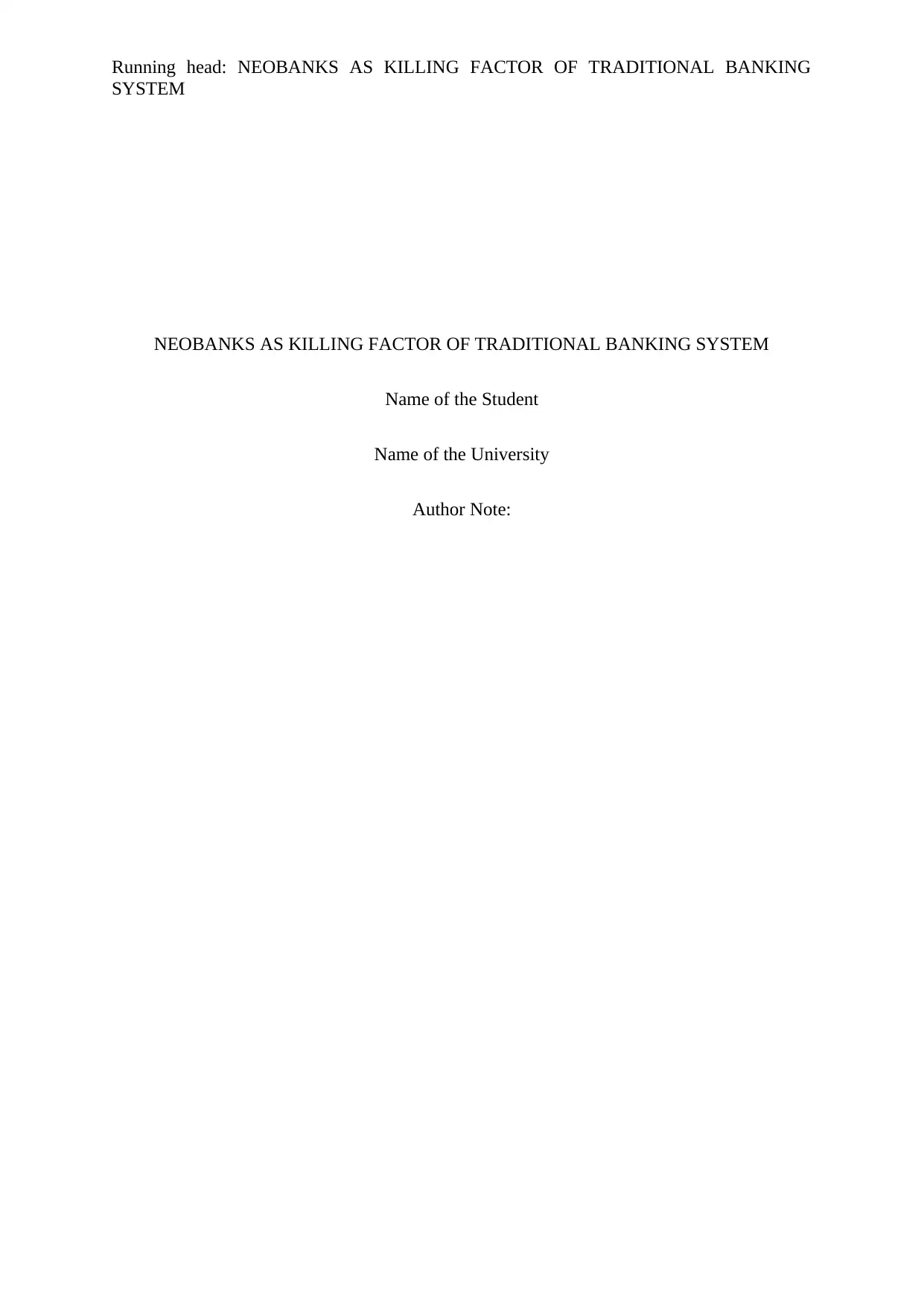
Running head: NEOBANKS AS KILLING FACTOR OF TRADITIONAL BANKING
SYSTEM
NEOBANKS AS KILLING FACTOR OF TRADITIONAL BANKING SYSTEM
Name of the Student
Name of the University
Author Note:
SYSTEM
NEOBANKS AS KILLING FACTOR OF TRADITIONAL BANKING SYSTEM
Name of the Student
Name of the University
Author Note:
Secure Best Marks with AI Grader
Need help grading? Try our AI Grader for instant feedback on your assignments.
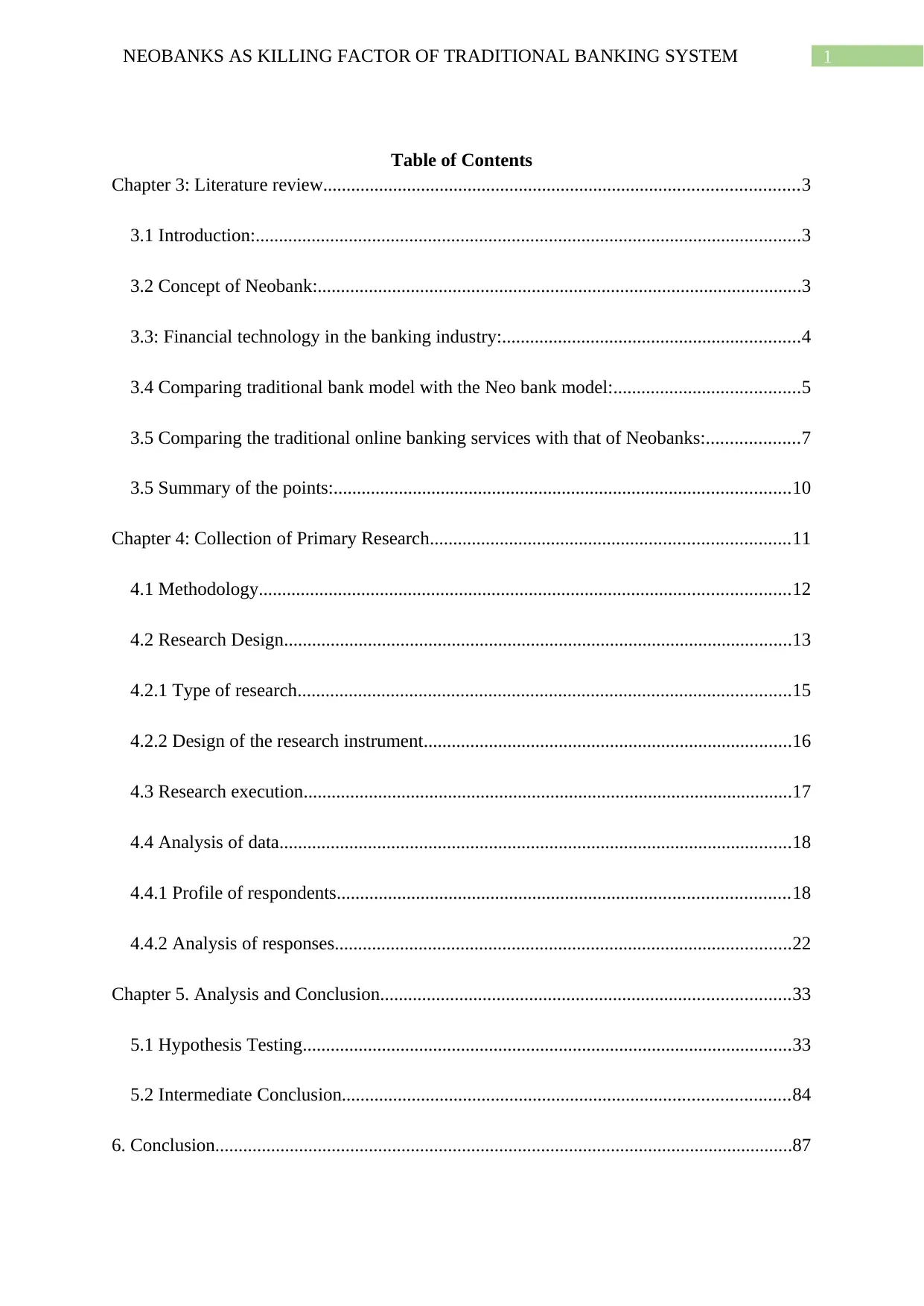
1NEOBANKS AS KILLING FACTOR OF TRADITIONAL BANKING SYSTEM
Table of Contents
Chapter 3: Literature review......................................................................................................3
3.1 Introduction:.....................................................................................................................3
3.2 Concept of Neobank:........................................................................................................3
3.3: Financial technology in the banking industry:................................................................4
3.4 Comparing traditional bank model with the Neo bank model:........................................5
3.5 Comparing the traditional online banking services with that of Neobanks:....................7
3.5 Summary of the points:..................................................................................................10
Chapter 4: Collection of Primary Research.............................................................................11
4.1 Methodology..................................................................................................................12
4.2 Research Design.............................................................................................................13
4.2.1 Type of research..........................................................................................................15
4.2.2 Design of the research instrument...............................................................................16
4.3 Research execution.........................................................................................................17
4.4 Analysis of data..............................................................................................................18
4.4.1 Profile of respondents.................................................................................................18
4.4.2 Analysis of responses..................................................................................................22
Chapter 5. Analysis and Conclusion........................................................................................33
5.1 Hypothesis Testing.........................................................................................................33
5.2 Intermediate Conclusion................................................................................................84
6. Conclusion............................................................................................................................87
Table of Contents
Chapter 3: Literature review......................................................................................................3
3.1 Introduction:.....................................................................................................................3
3.2 Concept of Neobank:........................................................................................................3
3.3: Financial technology in the banking industry:................................................................4
3.4 Comparing traditional bank model with the Neo bank model:........................................5
3.5 Comparing the traditional online banking services with that of Neobanks:....................7
3.5 Summary of the points:..................................................................................................10
Chapter 4: Collection of Primary Research.............................................................................11
4.1 Methodology..................................................................................................................12
4.2 Research Design.............................................................................................................13
4.2.1 Type of research..........................................................................................................15
4.2.2 Design of the research instrument...............................................................................16
4.3 Research execution.........................................................................................................17
4.4 Analysis of data..............................................................................................................18
4.4.1 Profile of respondents.................................................................................................18
4.4.2 Analysis of responses..................................................................................................22
Chapter 5. Analysis and Conclusion........................................................................................33
5.1 Hypothesis Testing.........................................................................................................33
5.2 Intermediate Conclusion................................................................................................84
6. Conclusion............................................................................................................................87
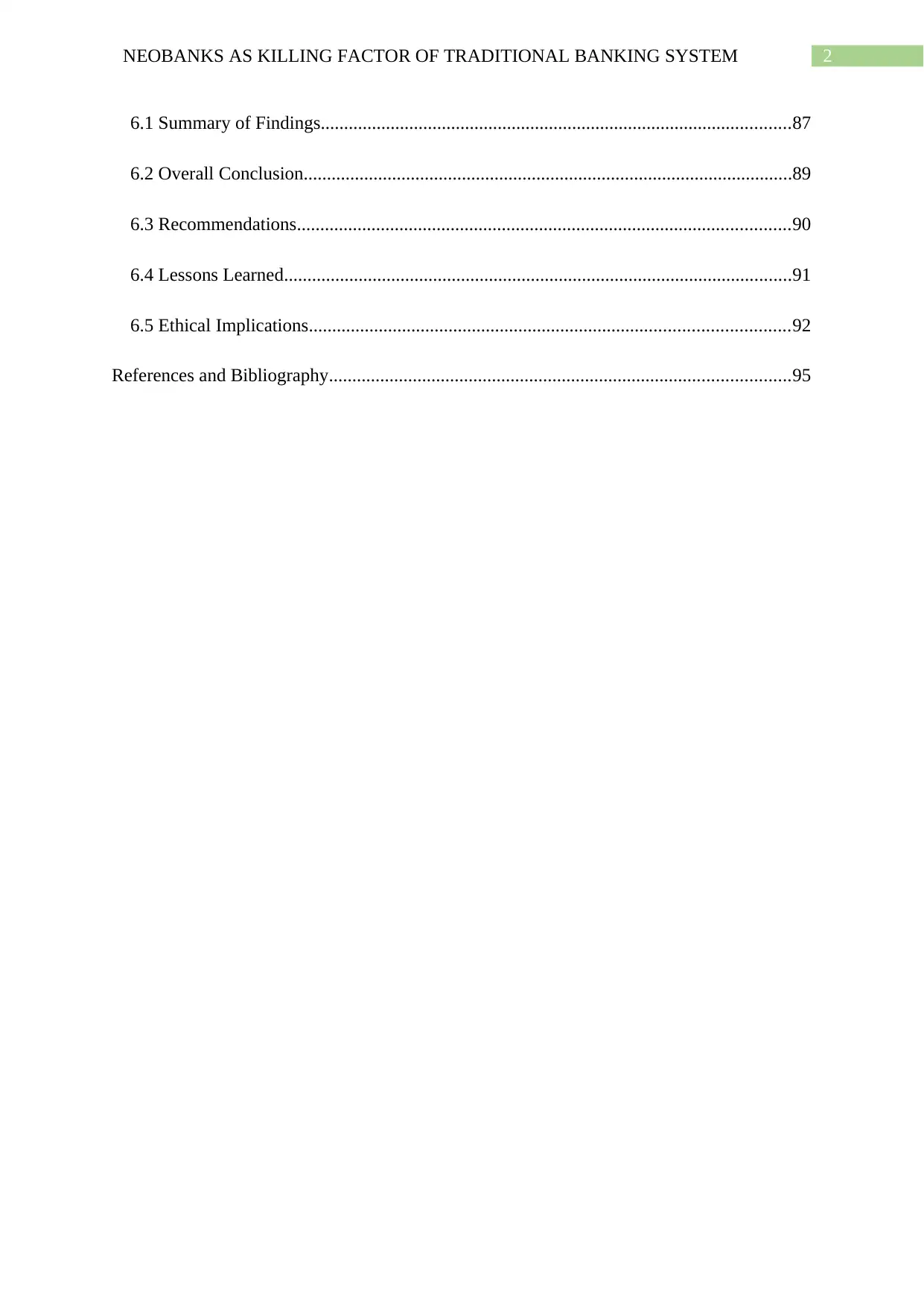
2NEOBANKS AS KILLING FACTOR OF TRADITIONAL BANKING SYSTEM
6.1 Summary of Findings.....................................................................................................87
6.2 Overall Conclusion.........................................................................................................89
6.3 Recommendations..........................................................................................................90
6.4 Lessons Learned.............................................................................................................91
6.5 Ethical Implications.......................................................................................................92
References and Bibliography...................................................................................................95
6.1 Summary of Findings.....................................................................................................87
6.2 Overall Conclusion.........................................................................................................89
6.3 Recommendations..........................................................................................................90
6.4 Lessons Learned.............................................................................................................91
6.5 Ethical Implications.......................................................................................................92
References and Bibliography...................................................................................................95
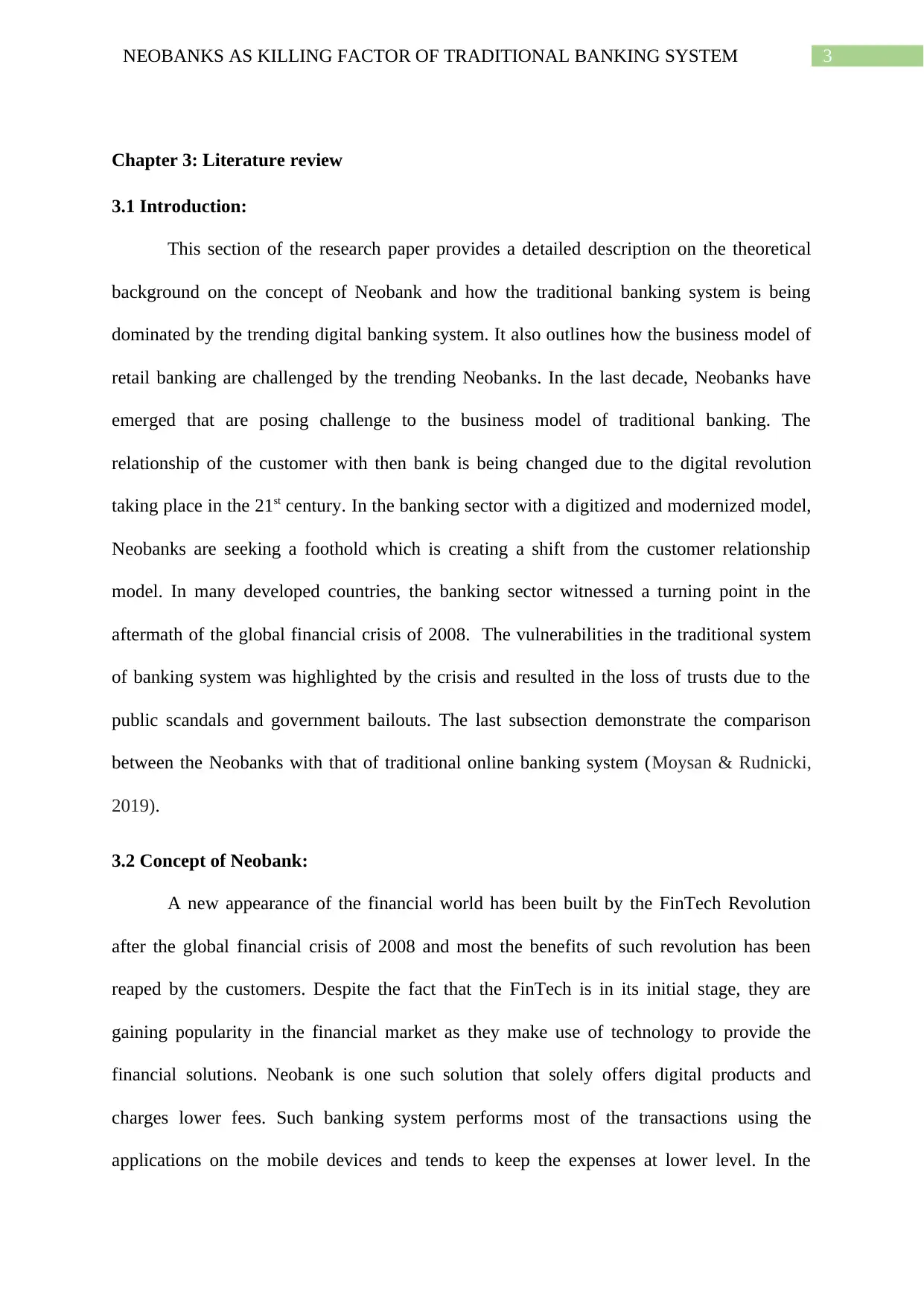
3NEOBANKS AS KILLING FACTOR OF TRADITIONAL BANKING SYSTEM
Chapter 3: Literature review
3.1 Introduction:
This section of the research paper provides a detailed description on the theoretical
background on the concept of Neobank and how the traditional banking system is being
dominated by the trending digital banking system. It also outlines how the business model of
retail banking are challenged by the trending Neobanks. In the last decade, Neobanks have
emerged that are posing challenge to the business model of traditional banking. The
relationship of the customer with then bank is being changed due to the digital revolution
taking place in the 21st century. In the banking sector with a digitized and modernized model,
Neobanks are seeking a foothold which is creating a shift from the customer relationship
model. In many developed countries, the banking sector witnessed a turning point in the
aftermath of the global financial crisis of 2008. The vulnerabilities in the traditional system
of banking system was highlighted by the crisis and resulted in the loss of trusts due to the
public scandals and government bailouts. The last subsection demonstrate the comparison
between the Neobanks with that of traditional online banking system (Moysan & Rudnicki,
2019).
3.2 Concept of Neobank:
A new appearance of the financial world has been built by the FinTech Revolution
after the global financial crisis of 2008 and most the benefits of such revolution has been
reaped by the customers. Despite the fact that the FinTech is in its initial stage, they are
gaining popularity in the financial market as they make use of technology to provide the
financial solutions. Neobank is one such solution that solely offers digital products and
charges lower fees. Such banking system performs most of the transactions using the
applications on the mobile devices and tends to keep the expenses at lower level. In the
Chapter 3: Literature review
3.1 Introduction:
This section of the research paper provides a detailed description on the theoretical
background on the concept of Neobank and how the traditional banking system is being
dominated by the trending digital banking system. It also outlines how the business model of
retail banking are challenged by the trending Neobanks. In the last decade, Neobanks have
emerged that are posing challenge to the business model of traditional banking. The
relationship of the customer with then bank is being changed due to the digital revolution
taking place in the 21st century. In the banking sector with a digitized and modernized model,
Neobanks are seeking a foothold which is creating a shift from the customer relationship
model. In many developed countries, the banking sector witnessed a turning point in the
aftermath of the global financial crisis of 2008. The vulnerabilities in the traditional system
of banking system was highlighted by the crisis and resulted in the loss of trusts due to the
public scandals and government bailouts. The last subsection demonstrate the comparison
between the Neobanks with that of traditional online banking system (Moysan & Rudnicki,
2019).
3.2 Concept of Neobank:
A new appearance of the financial world has been built by the FinTech Revolution
after the global financial crisis of 2008 and most the benefits of such revolution has been
reaped by the customers. Despite the fact that the FinTech is in its initial stage, they are
gaining popularity in the financial market as they make use of technology to provide the
financial solutions. Neobank is one such solution that solely offers digital products and
charges lower fees. Such banking system performs most of the transactions using the
applications on the mobile devices and tends to keep the expenses at lower level. In the
Secure Best Marks with AI Grader
Need help grading? Try our AI Grader for instant feedback on your assignments.
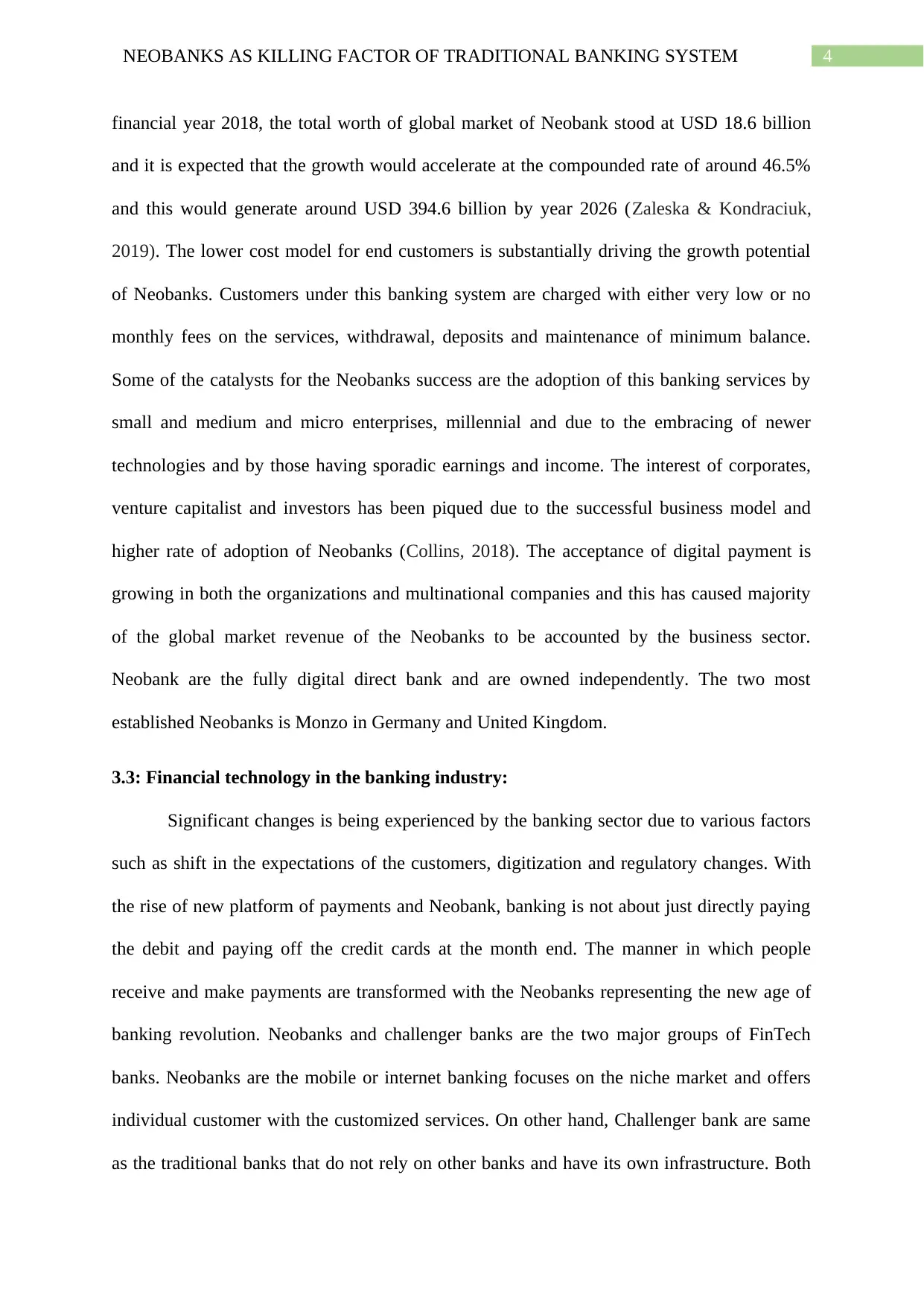
4NEOBANKS AS KILLING FACTOR OF TRADITIONAL BANKING SYSTEM
financial year 2018, the total worth of global market of Neobank stood at USD 18.6 billion
and it is expected that the growth would accelerate at the compounded rate of around 46.5%
and this would generate around USD 394.6 billion by year 2026 (Zaleska & Kondraciuk,
2019). The lower cost model for end customers is substantially driving the growth potential
of Neobanks. Customers under this banking system are charged with either very low or no
monthly fees on the services, withdrawal, deposits and maintenance of minimum balance.
Some of the catalysts for the Neobanks success are the adoption of this banking services by
small and medium and micro enterprises, millennial and due to the embracing of newer
technologies and by those having sporadic earnings and income. The interest of corporates,
venture capitalist and investors has been piqued due to the successful business model and
higher rate of adoption of Neobanks (Collins, 2018). The acceptance of digital payment is
growing in both the organizations and multinational companies and this has caused majority
of the global market revenue of the Neobanks to be accounted by the business sector.
Neobank are the fully digital direct bank and are owned independently. The two most
established Neobanks is Monzo in Germany and United Kingdom.
3.3: Financial technology in the banking industry:
Significant changes is being experienced by the banking sector due to various factors
such as shift in the expectations of the customers, digitization and regulatory changes. With
the rise of new platform of payments and Neobank, banking is not about just directly paying
the debit and paying off the credit cards at the month end. The manner in which people
receive and make payments are transformed with the Neobanks representing the new age of
banking revolution. Neobanks and challenger banks are the two major groups of FinTech
banks. Neobanks are the mobile or internet banking focuses on the niche market and offers
individual customer with the customized services. On other hand, Challenger bank are same
as the traditional banks that do not rely on other banks and have its own infrastructure. Both
financial year 2018, the total worth of global market of Neobank stood at USD 18.6 billion
and it is expected that the growth would accelerate at the compounded rate of around 46.5%
and this would generate around USD 394.6 billion by year 2026 (Zaleska & Kondraciuk,
2019). The lower cost model for end customers is substantially driving the growth potential
of Neobanks. Customers under this banking system are charged with either very low or no
monthly fees on the services, withdrawal, deposits and maintenance of minimum balance.
Some of the catalysts for the Neobanks success are the adoption of this banking services by
small and medium and micro enterprises, millennial and due to the embracing of newer
technologies and by those having sporadic earnings and income. The interest of corporates,
venture capitalist and investors has been piqued due to the successful business model and
higher rate of adoption of Neobanks (Collins, 2018). The acceptance of digital payment is
growing in both the organizations and multinational companies and this has caused majority
of the global market revenue of the Neobanks to be accounted by the business sector.
Neobank are the fully digital direct bank and are owned independently. The two most
established Neobanks is Monzo in Germany and United Kingdom.
3.3: Financial technology in the banking industry:
Significant changes is being experienced by the banking sector due to various factors
such as shift in the expectations of the customers, digitization and regulatory changes. With
the rise of new platform of payments and Neobank, banking is not about just directly paying
the debit and paying off the credit cards at the month end. The manner in which people
receive and make payments are transformed with the Neobanks representing the new age of
banking revolution. Neobanks and challenger banks are the two major groups of FinTech
banks. Neobanks are the mobile or internet banking focuses on the niche market and offers
individual customer with the customized services. On other hand, Challenger bank are same
as the traditional banks that do not rely on other banks and have its own infrastructure. Both
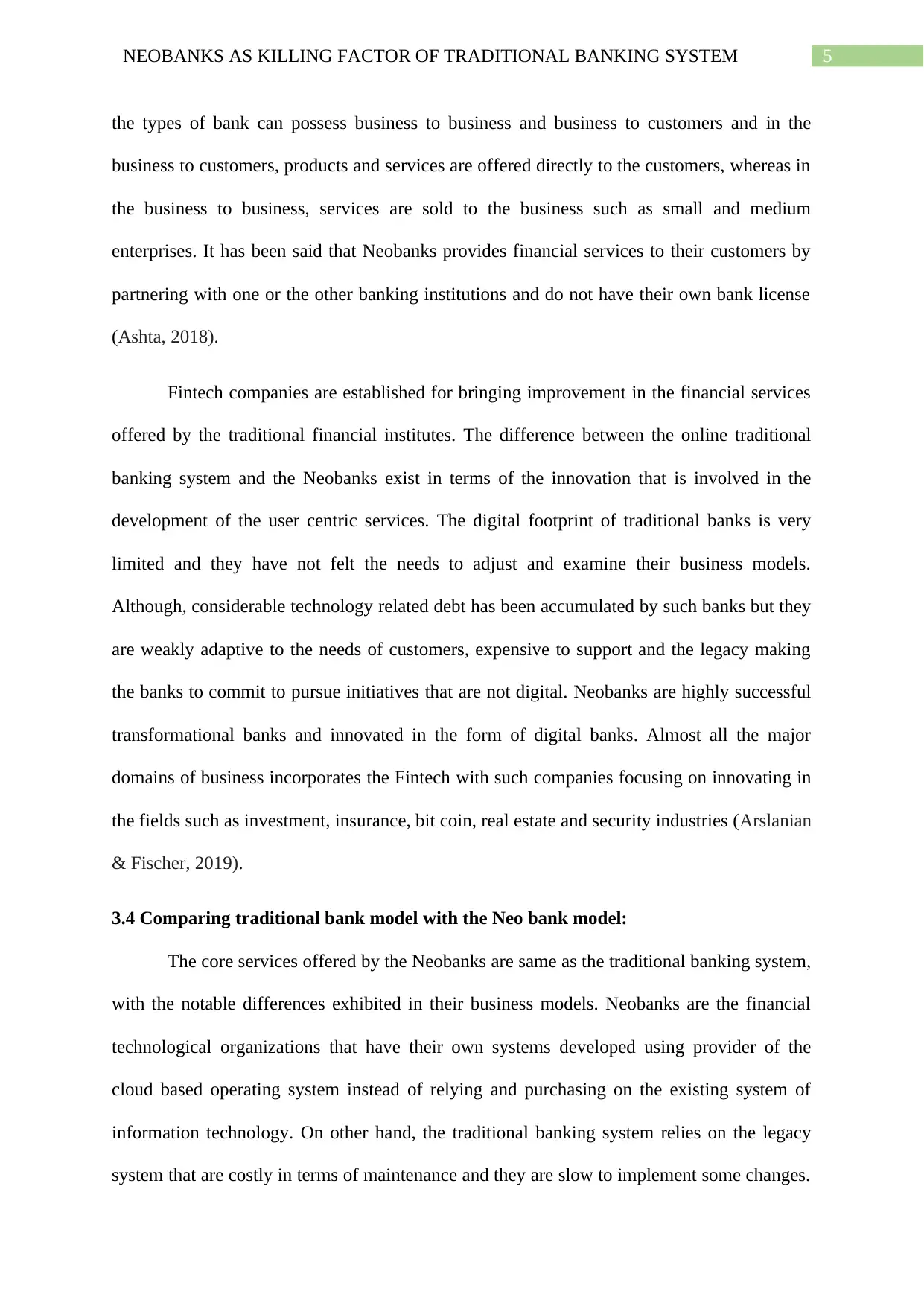
5NEOBANKS AS KILLING FACTOR OF TRADITIONAL BANKING SYSTEM
the types of bank can possess business to business and business to customers and in the
business to customers, products and services are offered directly to the customers, whereas in
the business to business, services are sold to the business such as small and medium
enterprises. It has been said that Neobanks provides financial services to their customers by
partnering with one or the other banking institutions and do not have their own bank license
(Ashta, 2018).
Fintech companies are established for bringing improvement in the financial services
offered by the traditional financial institutes. The difference between the online traditional
banking system and the Neobanks exist in terms of the innovation that is involved in the
development of the user centric services. The digital footprint of traditional banks is very
limited and they have not felt the needs to adjust and examine their business models.
Although, considerable technology related debt has been accumulated by such banks but they
are weakly adaptive to the needs of customers, expensive to support and the legacy making
the banks to commit to pursue initiatives that are not digital. Neobanks are highly successful
transformational banks and innovated in the form of digital banks. Almost all the major
domains of business incorporates the Fintech with such companies focusing on innovating in
the fields such as investment, insurance, bit coin, real estate and security industries (Arslanian
& Fischer, 2019).
3.4 Comparing traditional bank model with the Neo bank model:
The core services offered by the Neobanks are same as the traditional banking system,
with the notable differences exhibited in their business models. Neobanks are the financial
technological organizations that have their own systems developed using provider of the
cloud based operating system instead of relying and purchasing on the existing system of
information technology. On other hand, the traditional banking system relies on the legacy
system that are costly in terms of maintenance and they are slow to implement some changes.
the types of bank can possess business to business and business to customers and in the
business to customers, products and services are offered directly to the customers, whereas in
the business to business, services are sold to the business such as small and medium
enterprises. It has been said that Neobanks provides financial services to their customers by
partnering with one or the other banking institutions and do not have their own bank license
(Ashta, 2018).
Fintech companies are established for bringing improvement in the financial services
offered by the traditional financial institutes. The difference between the online traditional
banking system and the Neobanks exist in terms of the innovation that is involved in the
development of the user centric services. The digital footprint of traditional banks is very
limited and they have not felt the needs to adjust and examine their business models.
Although, considerable technology related debt has been accumulated by such banks but they
are weakly adaptive to the needs of customers, expensive to support and the legacy making
the banks to commit to pursue initiatives that are not digital. Neobanks are highly successful
transformational banks and innovated in the form of digital banks. Almost all the major
domains of business incorporates the Fintech with such companies focusing on innovating in
the fields such as investment, insurance, bit coin, real estate and security industries (Arslanian
& Fischer, 2019).
3.4 Comparing traditional bank model with the Neo bank model:
The core services offered by the Neobanks are same as the traditional banking system,
with the notable differences exhibited in their business models. Neobanks are the financial
technological organizations that have their own systems developed using provider of the
cloud based operating system instead of relying and purchasing on the existing system of
information technology. On other hand, the traditional banking system relies on the legacy
system that are costly in terms of maintenance and they are slow to implement some changes.
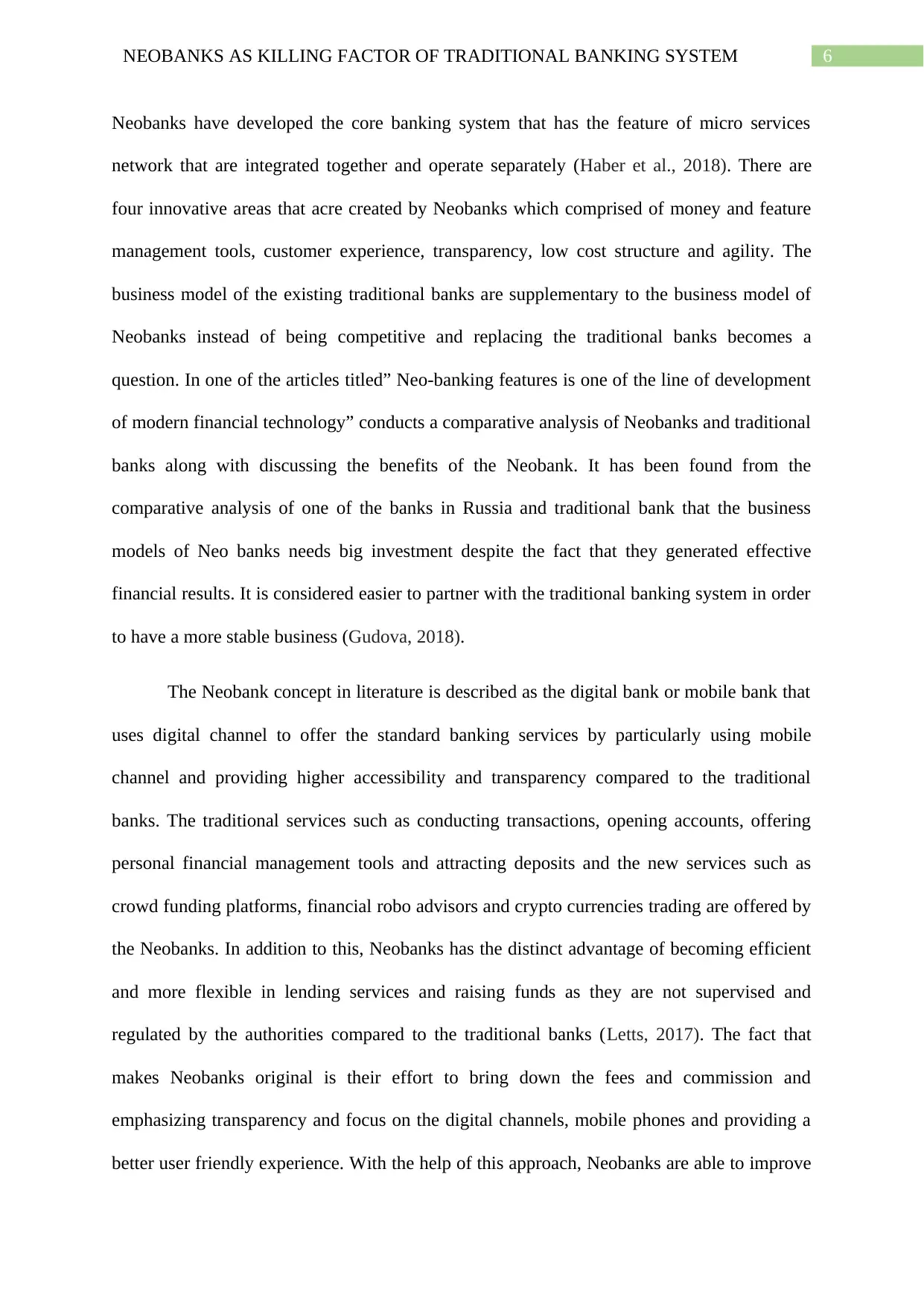
6NEOBANKS AS KILLING FACTOR OF TRADITIONAL BANKING SYSTEM
Neobanks have developed the core banking system that has the feature of micro services
network that are integrated together and operate separately (Haber et al., 2018). There are
four innovative areas that acre created by Neobanks which comprised of money and feature
management tools, customer experience, transparency, low cost structure and agility. The
business model of the existing traditional banks are supplementary to the business model of
Neobanks instead of being competitive and replacing the traditional banks becomes a
question. In one of the articles titled” Neo-banking features is one of the line of development
of modern financial technology” conducts a comparative analysis of Neobanks and traditional
banks along with discussing the benefits of the Neobank. It has been found from the
comparative analysis of one of the banks in Russia and traditional bank that the business
models of Neo banks needs big investment despite the fact that they generated effective
financial results. It is considered easier to partner with the traditional banking system in order
to have a more stable business (Gudova, 2018).
The Neobank concept in literature is described as the digital bank or mobile bank that
uses digital channel to offer the standard banking services by particularly using mobile
channel and providing higher accessibility and transparency compared to the traditional
banks. The traditional services such as conducting transactions, opening accounts, offering
personal financial management tools and attracting deposits and the new services such as
crowd funding platforms, financial robo advisors and crypto currencies trading are offered by
the Neobanks. In addition to this, Neobanks has the distinct advantage of becoming efficient
and more flexible in lending services and raising funds as they are not supervised and
regulated by the authorities compared to the traditional banks (Letts, 2017). The fact that
makes Neobanks original is their effort to bring down the fees and commission and
emphasizing transparency and focus on the digital channels, mobile phones and providing a
better user friendly experience. With the help of this approach, Neobanks are able to improve
Neobanks have developed the core banking system that has the feature of micro services
network that are integrated together and operate separately (Haber et al., 2018). There are
four innovative areas that acre created by Neobanks which comprised of money and feature
management tools, customer experience, transparency, low cost structure and agility. The
business model of the existing traditional banks are supplementary to the business model of
Neobanks instead of being competitive and replacing the traditional banks becomes a
question. In one of the articles titled” Neo-banking features is one of the line of development
of modern financial technology” conducts a comparative analysis of Neobanks and traditional
banks along with discussing the benefits of the Neobank. It has been found from the
comparative analysis of one of the banks in Russia and traditional bank that the business
models of Neo banks needs big investment despite the fact that they generated effective
financial results. It is considered easier to partner with the traditional banking system in order
to have a more stable business (Gudova, 2018).
The Neobank concept in literature is described as the digital bank or mobile bank that
uses digital channel to offer the standard banking services by particularly using mobile
channel and providing higher accessibility and transparency compared to the traditional
banks. The traditional services such as conducting transactions, opening accounts, offering
personal financial management tools and attracting deposits and the new services such as
crowd funding platforms, financial robo advisors and crypto currencies trading are offered by
the Neobanks. In addition to this, Neobanks has the distinct advantage of becoming efficient
and more flexible in lending services and raising funds as they are not supervised and
regulated by the authorities compared to the traditional banks (Letts, 2017). The fact that
makes Neobanks original is their effort to bring down the fees and commission and
emphasizing transparency and focus on the digital channels, mobile phones and providing a
better user friendly experience. With the help of this approach, Neobanks are able to improve
Paraphrase This Document
Need a fresh take? Get an instant paraphrase of this document with our AI Paraphraser
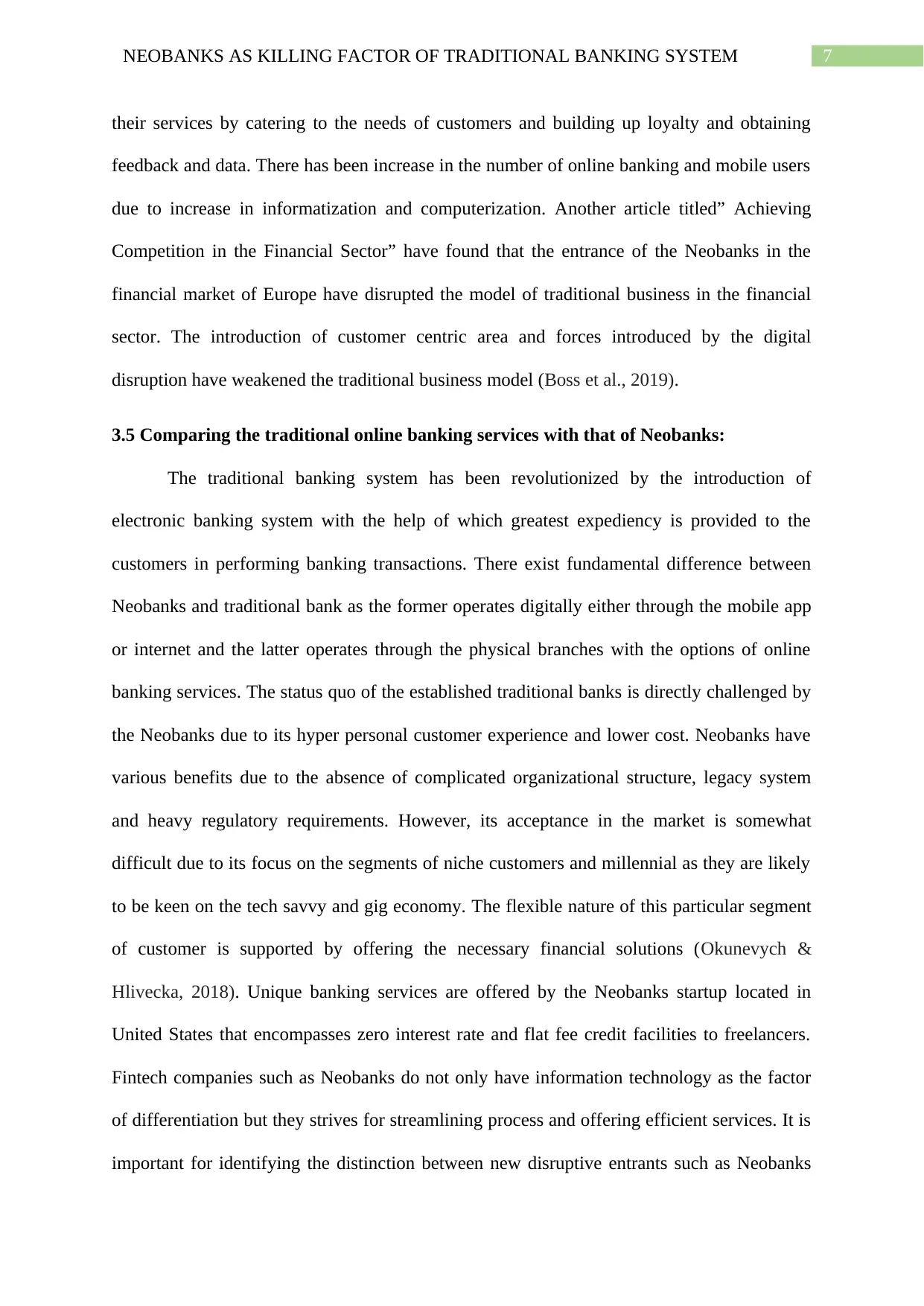
7NEOBANKS AS KILLING FACTOR OF TRADITIONAL BANKING SYSTEM
their services by catering to the needs of customers and building up loyalty and obtaining
feedback and data. There has been increase in the number of online banking and mobile users
due to increase in informatization and computerization. Another article titled” Achieving
Competition in the Financial Sector” have found that the entrance of the Neobanks in the
financial market of Europe have disrupted the model of traditional business in the financial
sector. The introduction of customer centric area and forces introduced by the digital
disruption have weakened the traditional business model (Boss et al., 2019).
3.5 Comparing the traditional online banking services with that of Neobanks:
The traditional banking system has been revolutionized by the introduction of
electronic banking system with the help of which greatest expediency is provided to the
customers in performing banking transactions. There exist fundamental difference between
Neobanks and traditional bank as the former operates digitally either through the mobile app
or internet and the latter operates through the physical branches with the options of online
banking services. The status quo of the established traditional banks is directly challenged by
the Neobanks due to its hyper personal customer experience and lower cost. Neobanks have
various benefits due to the absence of complicated organizational structure, legacy system
and heavy regulatory requirements. However, its acceptance in the market is somewhat
difficult due to its focus on the segments of niche customers and millennial as they are likely
to be keen on the tech savvy and gig economy. The flexible nature of this particular segment
of customer is supported by offering the necessary financial solutions (Okunevych &
Hlivecka, 2018). Unique banking services are offered by the Neobanks startup located in
United States that encompasses zero interest rate and flat fee credit facilities to freelancers.
Fintech companies such as Neobanks do not only have information technology as the factor
of differentiation but they strives for streamlining process and offering efficient services. It is
important for identifying the distinction between new disruptive entrants such as Neobanks
their services by catering to the needs of customers and building up loyalty and obtaining
feedback and data. There has been increase in the number of online banking and mobile users
due to increase in informatization and computerization. Another article titled” Achieving
Competition in the Financial Sector” have found that the entrance of the Neobanks in the
financial market of Europe have disrupted the model of traditional business in the financial
sector. The introduction of customer centric area and forces introduced by the digital
disruption have weakened the traditional business model (Boss et al., 2019).
3.5 Comparing the traditional online banking services with that of Neobanks:
The traditional banking system has been revolutionized by the introduction of
electronic banking system with the help of which greatest expediency is provided to the
customers in performing banking transactions. There exist fundamental difference between
Neobanks and traditional bank as the former operates digitally either through the mobile app
or internet and the latter operates through the physical branches with the options of online
banking services. The status quo of the established traditional banks is directly challenged by
the Neobanks due to its hyper personal customer experience and lower cost. Neobanks have
various benefits due to the absence of complicated organizational structure, legacy system
and heavy regulatory requirements. However, its acceptance in the market is somewhat
difficult due to its focus on the segments of niche customers and millennial as they are likely
to be keen on the tech savvy and gig economy. The flexible nature of this particular segment
of customer is supported by offering the necessary financial solutions (Okunevych &
Hlivecka, 2018). Unique banking services are offered by the Neobanks startup located in
United States that encompasses zero interest rate and flat fee credit facilities to freelancers.
Fintech companies such as Neobanks do not only have information technology as the factor
of differentiation but they strives for streamlining process and offering efficient services. It is
important for identifying the distinction between new disruptive entrants such as Neobanks
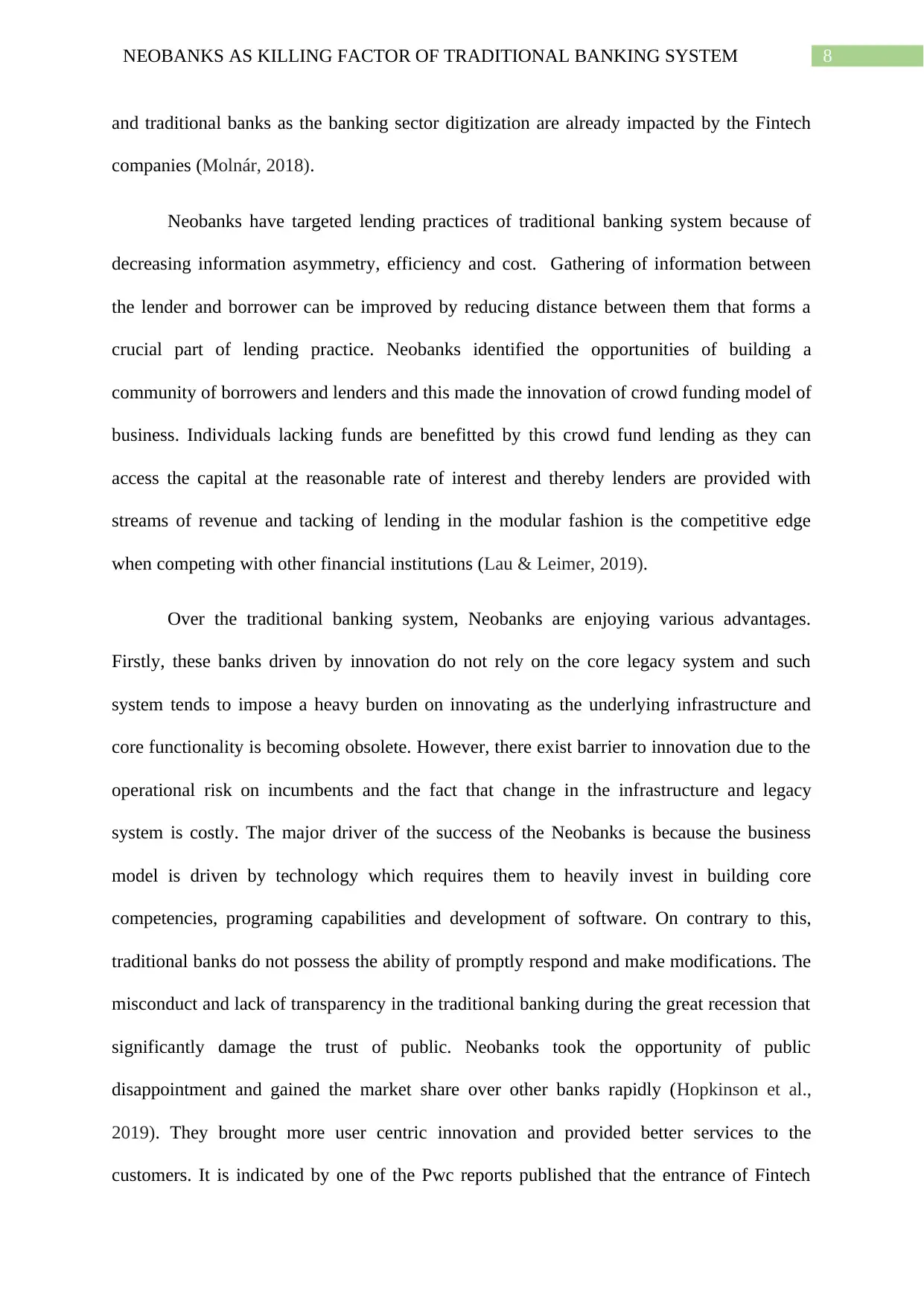
8NEOBANKS AS KILLING FACTOR OF TRADITIONAL BANKING SYSTEM
and traditional banks as the banking sector digitization are already impacted by the Fintech
companies (Molnár, 2018).
Neobanks have targeted lending practices of traditional banking system because of
decreasing information asymmetry, efficiency and cost. Gathering of information between
the lender and borrower can be improved by reducing distance between them that forms a
crucial part of lending practice. Neobanks identified the opportunities of building a
community of borrowers and lenders and this made the innovation of crowd funding model of
business. Individuals lacking funds are benefitted by this crowd fund lending as they can
access the capital at the reasonable rate of interest and thereby lenders are provided with
streams of revenue and tacking of lending in the modular fashion is the competitive edge
when competing with other financial institutions (Lau & Leimer, 2019).
Over the traditional banking system, Neobanks are enjoying various advantages.
Firstly, these banks driven by innovation do not rely on the core legacy system and such
system tends to impose a heavy burden on innovating as the underlying infrastructure and
core functionality is becoming obsolete. However, there exist barrier to innovation due to the
operational risk on incumbents and the fact that change in the infrastructure and legacy
system is costly. The major driver of the success of the Neobanks is because the business
model is driven by technology which requires them to heavily invest in building core
competencies, programing capabilities and development of software. On contrary to this,
traditional banks do not possess the ability of promptly respond and make modifications. The
misconduct and lack of transparency in the traditional banking during the great recession that
significantly damage the trust of public. Neobanks took the opportunity of public
disappointment and gained the market share over other banks rapidly (Hopkinson et al.,
2019). They brought more user centric innovation and provided better services to the
customers. It is indicated by one of the Pwc reports published that the entrance of Fintech
and traditional banks as the banking sector digitization are already impacted by the Fintech
companies (Molnár, 2018).
Neobanks have targeted lending practices of traditional banking system because of
decreasing information asymmetry, efficiency and cost. Gathering of information between
the lender and borrower can be improved by reducing distance between them that forms a
crucial part of lending practice. Neobanks identified the opportunities of building a
community of borrowers and lenders and this made the innovation of crowd funding model of
business. Individuals lacking funds are benefitted by this crowd fund lending as they can
access the capital at the reasonable rate of interest and thereby lenders are provided with
streams of revenue and tacking of lending in the modular fashion is the competitive edge
when competing with other financial institutions (Lau & Leimer, 2019).
Over the traditional banking system, Neobanks are enjoying various advantages.
Firstly, these banks driven by innovation do not rely on the core legacy system and such
system tends to impose a heavy burden on innovating as the underlying infrastructure and
core functionality is becoming obsolete. However, there exist barrier to innovation due to the
operational risk on incumbents and the fact that change in the infrastructure and legacy
system is costly. The major driver of the success of the Neobanks is because the business
model is driven by technology which requires them to heavily invest in building core
competencies, programing capabilities and development of software. On contrary to this,
traditional banks do not possess the ability of promptly respond and make modifications. The
misconduct and lack of transparency in the traditional banking during the great recession that
significantly damage the trust of public. Neobanks took the opportunity of public
disappointment and gained the market share over other banks rapidly (Hopkinson et al.,
2019). They brought more user centric innovation and provided better services to the
customers. It is indicated by one of the Pwc reports published that the entrance of Fintech

9NEOBANKS AS KILLING FACTOR OF TRADITIONAL BANKING SYSTEM
would pose a risk to the 20% of the revenue stream of incumbents by 2020. Other risky
aspects is related to revenue related to payment, banking and areas such as asset, insurance
and wealth management. The rapid growth of Neobanks is also attributable to superiority of
Fintech to the traditional banking system that is not well designed and has friction. In
addition to this, customers are offered with the point of purchase and personalized solutions
that is based on the extensive multi source data mining usage, analytics and pattern
recognition. Customers money are managed wisely with the help of tool of personal financial
management that offers services such as warning customer automatically in the event of
potential overspending. One key fact gaining traction is controlling the financial decisions of
the customers due to crowd source solutions. As against the traditional system of banking,
momentum was gained by Neobanks and their ability to predict the credit defaults accurately
using the risk models (Holmes & King, 2019).
It has been found from the in depth discussion on the Neobanks that they have been
able to gain market share over the other banks due to their business model that focuses on the
innovative centric products and lower cost. Traditional banks have responded by creating and
innovating their own digital brands, however, the operation of Neobanks have also been
challenged. Some banks such as Danske bank investing in the platform of open banking and
Royal bank of Scotland that launched its own digital bank. Neobanks are considered to be a
viable option for the tech savvy customers whose requirements include online convenience,
fast service and lower costs. They are faced with two major challenges in terms of creating
profitability and attracting customers. In addition to this, regulatory compliance is another
challenge faced by Neobank (Haber et al., 2018).
The model of Neobank has called for some stumbling blocks that questions of the
potentials of digital only model and have given credibility to the skeptics. Some of the
Neobanks such as Simple, Go bank and Moven have faced the issues relating to the
would pose a risk to the 20% of the revenue stream of incumbents by 2020. Other risky
aspects is related to revenue related to payment, banking and areas such as asset, insurance
and wealth management. The rapid growth of Neobanks is also attributable to superiority of
Fintech to the traditional banking system that is not well designed and has friction. In
addition to this, customers are offered with the point of purchase and personalized solutions
that is based on the extensive multi source data mining usage, analytics and pattern
recognition. Customers money are managed wisely with the help of tool of personal financial
management that offers services such as warning customer automatically in the event of
potential overspending. One key fact gaining traction is controlling the financial decisions of
the customers due to crowd source solutions. As against the traditional system of banking,
momentum was gained by Neobanks and their ability to predict the credit defaults accurately
using the risk models (Holmes & King, 2019).
It has been found from the in depth discussion on the Neobanks that they have been
able to gain market share over the other banks due to their business model that focuses on the
innovative centric products and lower cost. Traditional banks have responded by creating and
innovating their own digital brands, however, the operation of Neobanks have also been
challenged. Some banks such as Danske bank investing in the platform of open banking and
Royal bank of Scotland that launched its own digital bank. Neobanks are considered to be a
viable option for the tech savvy customers whose requirements include online convenience,
fast service and lower costs. They are faced with two major challenges in terms of creating
profitability and attracting customers. In addition to this, regulatory compliance is another
challenge faced by Neobank (Haber et al., 2018).
The model of Neobank has called for some stumbling blocks that questions of the
potentials of digital only model and have given credibility to the skeptics. Some of the
Neobanks such as Simple, Go bank and Moven have faced the issues relating to the
Secure Best Marks with AI Grader
Need help grading? Try our AI Grader for instant feedback on your assignments.

10NEOBANKS AS KILLING FACTOR OF TRADITIONAL BANKING SYSTEM
scheduling of payment, service outages and feature of safe to spend. These startups have
brought significant improvement in the experience of customers in the form of social media
integration, digital offerings and casual communication (Soulé, 2016). Nevertheless, such
recent issues encountered by the Neobanks have posed a reality check to the business model
of such banks.
3.5 Summary of the points:
The review gathered from the analysis of literature on Neobanks have identified that
the introduction of such banks with the development of Fintech has resulted in bringing
significant market disruption and have posed challenges to the traditional banking system.
Neobanks have witnessed a rapid increase in their effort to capture the market due to their
innovative business model. It has been found that there exist notable differences between the
business model of traditional banks and Neobanks. Neobanks are considered superior to the
traditional banks because of various advantages offered by such digital banking such as
reduced cost of operations and conducting transactions and convenience. Many traditional
banks have responded by introducing the online banking facility. In addition to this, the
services offered by Neobanks is targeted to particular segments such as millennial and those
who are more tech savvy (Varga, 2017). Moreover, Neobanks are facing various challenges
and is expected to bring significant distraction in market. Therefore, it can be inferred that
digitization has brought significant changes into the banking sector with Neobanks intending
to make the most of opportunities along with posing challenges to incumbents.
scheduling of payment, service outages and feature of safe to spend. These startups have
brought significant improvement in the experience of customers in the form of social media
integration, digital offerings and casual communication (Soulé, 2016). Nevertheless, such
recent issues encountered by the Neobanks have posed a reality check to the business model
of such banks.
3.5 Summary of the points:
The review gathered from the analysis of literature on Neobanks have identified that
the introduction of such banks with the development of Fintech has resulted in bringing
significant market disruption and have posed challenges to the traditional banking system.
Neobanks have witnessed a rapid increase in their effort to capture the market due to their
innovative business model. It has been found that there exist notable differences between the
business model of traditional banks and Neobanks. Neobanks are considered superior to the
traditional banks because of various advantages offered by such digital banking such as
reduced cost of operations and conducting transactions and convenience. Many traditional
banks have responded by introducing the online banking facility. In addition to this, the
services offered by Neobanks is targeted to particular segments such as millennial and those
who are more tech savvy (Varga, 2017). Moreover, Neobanks are facing various challenges
and is expected to bring significant distraction in market. Therefore, it can be inferred that
digitization has brought significant changes into the banking sector with Neobanks intending
to make the most of opportunities along with posing challenges to incumbents.
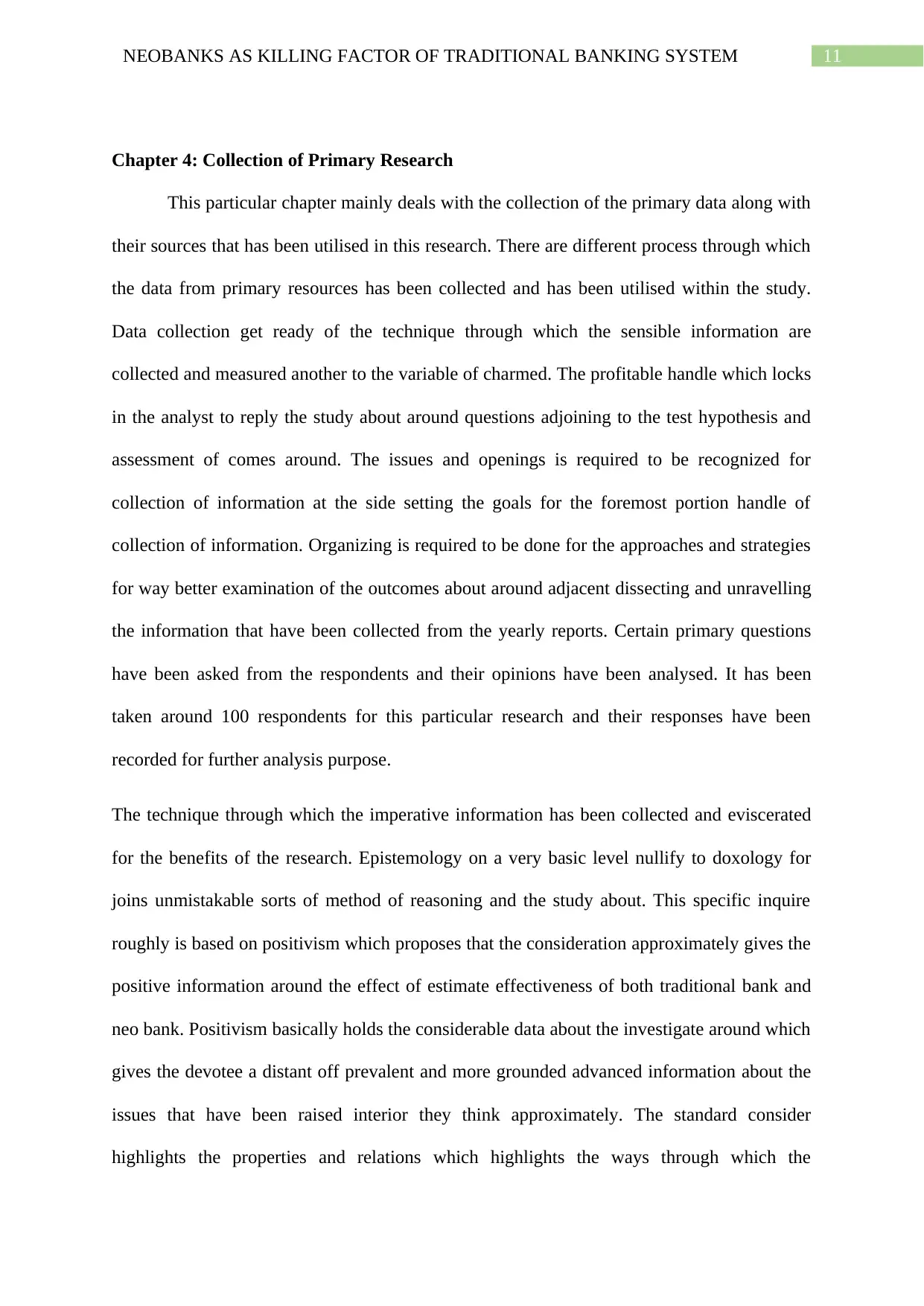
11NEOBANKS AS KILLING FACTOR OF TRADITIONAL BANKING SYSTEM
Chapter 4: Collection of Primary Research
This particular chapter mainly deals with the collection of the primary data along with
their sources that has been utilised in this research. There are different process through which
the data from primary resources has been collected and has been utilised within the study.
Data collection get ready of the technique through which the sensible information are
collected and measured another to the variable of charmed. The profitable handle which locks
in the analyst to reply the study about around questions adjoining to the test hypothesis and
assessment of comes around. The issues and openings is required to be recognized for
collection of information at the side setting the goals for the foremost portion handle of
collection of information. Organizing is required to be done for the approaches and strategies
for way better examination of the outcomes about around adjacent dissecting and unravelling
the information that have been collected from the yearly reports. Certain primary questions
have been asked from the respondents and their opinions have been analysed. It has been
taken around 100 respondents for this particular research and their responses have been
recorded for further analysis purpose.
The technique through which the imperative information has been collected and eviscerated
for the benefits of the research. Epistemology on a very basic level nullify to doxology for
joins unmistakable sorts of method of reasoning and the study about. This specific inquire
roughly is based on positivism which proposes that the consideration approximately gives the
positive information around the effect of estimate effectiveness of both traditional bank and
neo bank. Positivism basically holds the considerable data about the investigate around which
gives the devotee a distant off prevalent and more grounded advanced information about the
issues that have been raised interior they think approximately. The standard consider
highlights the properties and relations which highlights the ways through which the
Chapter 4: Collection of Primary Research
This particular chapter mainly deals with the collection of the primary data along with
their sources that has been utilised in this research. There are different process through which
the data from primary resources has been collected and has been utilised within the study.
Data collection get ready of the technique through which the sensible information are
collected and measured another to the variable of charmed. The profitable handle which locks
in the analyst to reply the study about around questions adjoining to the test hypothesis and
assessment of comes around. The issues and openings is required to be recognized for
collection of information at the side setting the goals for the foremost portion handle of
collection of information. Organizing is required to be done for the approaches and strategies
for way better examination of the outcomes about around adjacent dissecting and unravelling
the information that have been collected from the yearly reports. Certain primary questions
have been asked from the respondents and their opinions have been analysed. It has been
taken around 100 respondents for this particular research and their responses have been
recorded for further analysis purpose.
The technique through which the imperative information has been collected and eviscerated
for the benefits of the research. Epistemology on a very basic level nullify to doxology for
joins unmistakable sorts of method of reasoning and the study about. This specific inquire
roughly is based on positivism which proposes that the consideration approximately gives the
positive information around the effect of estimate effectiveness of both traditional bank and
neo bank. Positivism basically holds the considerable data about the investigate around which
gives the devotee a distant off prevalent and more grounded advanced information about the
issues that have been raised interior they think approximately. The standard consider
highlights the properties and relations which highlights the ways through which the
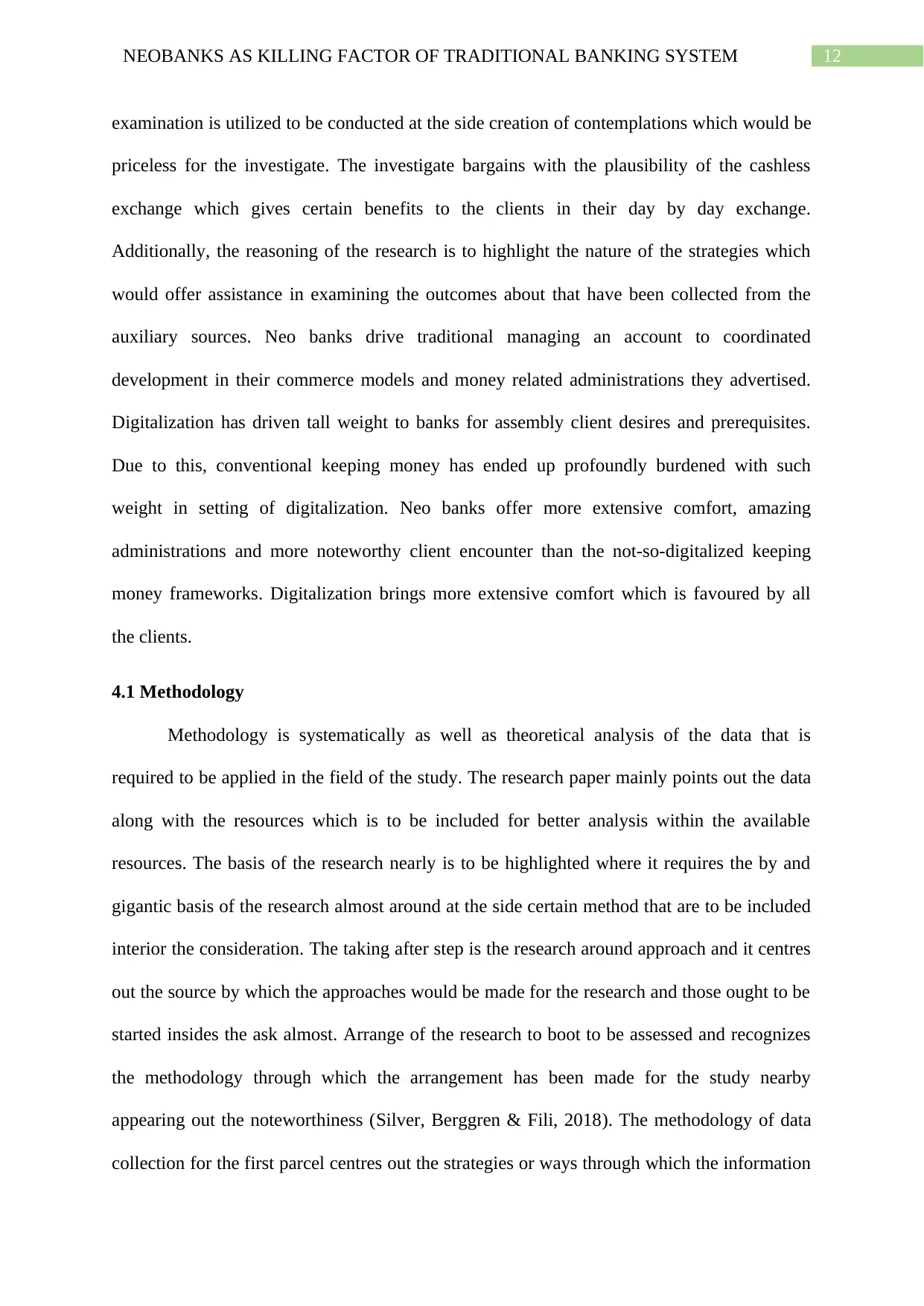
12NEOBANKS AS KILLING FACTOR OF TRADITIONAL BANKING SYSTEM
examination is utilized to be conducted at the side creation of contemplations which would be
priceless for the investigate. The investigate bargains with the plausibility of the cashless
exchange which gives certain benefits to the clients in their day by day exchange.
Additionally, the reasoning of the research is to highlight the nature of the strategies which
would offer assistance in examining the outcomes about that have been collected from the
auxiliary sources. Neo banks drive traditional managing an account to coordinated
development in their commerce models and money related administrations they advertised.
Digitalization has driven tall weight to banks for assembly client desires and prerequisites.
Due to this, conventional keeping money has ended up profoundly burdened with such
weight in setting of digitalization. Neo banks offer more extensive comfort, amazing
administrations and more noteworthy client encounter than the not-so-digitalized keeping
money frameworks. Digitalization brings more extensive comfort which is favoured by all
the clients.
4.1 Methodology
Methodology is systematically as well as theoretical analysis of the data that is
required to be applied in the field of the study. The research paper mainly points out the data
along with the resources which is to be included for better analysis within the available
resources. The basis of the research nearly is to be highlighted where it requires the by and
gigantic basis of the research almost around at the side certain method that are to be included
interior the consideration. The taking after step is the research around approach and it centres
out the source by which the approaches would be made for the research and those ought to be
started insides the ask almost. Arrange of the research to boot to be assessed and recognizes
the methodology through which the arrangement has been made for the study nearby
appearing out the noteworthiness (Silver, Berggren & Fili, 2018). The methodology of data
collection for the first parcel centres out the strategies or ways through which the information
examination is utilized to be conducted at the side creation of contemplations which would be
priceless for the investigate. The investigate bargains with the plausibility of the cashless
exchange which gives certain benefits to the clients in their day by day exchange.
Additionally, the reasoning of the research is to highlight the nature of the strategies which
would offer assistance in examining the outcomes about that have been collected from the
auxiliary sources. Neo banks drive traditional managing an account to coordinated
development in their commerce models and money related administrations they advertised.
Digitalization has driven tall weight to banks for assembly client desires and prerequisites.
Due to this, conventional keeping money has ended up profoundly burdened with such
weight in setting of digitalization. Neo banks offer more extensive comfort, amazing
administrations and more noteworthy client encounter than the not-so-digitalized keeping
money frameworks. Digitalization brings more extensive comfort which is favoured by all
the clients.
4.1 Methodology
Methodology is systematically as well as theoretical analysis of the data that is
required to be applied in the field of the study. The research paper mainly points out the data
along with the resources which is to be included for better analysis within the available
resources. The basis of the research nearly is to be highlighted where it requires the by and
gigantic basis of the research almost around at the side certain method that are to be included
interior the consideration. The taking after step is the research around approach and it centres
out the source by which the approaches would be made for the research and those ought to be
started insides the ask almost. Arrange of the research to boot to be assessed and recognizes
the methodology through which the arrangement has been made for the study nearby
appearing out the noteworthiness (Silver, Berggren & Fili, 2018). The methodology of data
collection for the first parcel centres out the strategies or ways through which the information
Paraphrase This Document
Need a fresh take? Get an instant paraphrase of this document with our AI Paraphraser
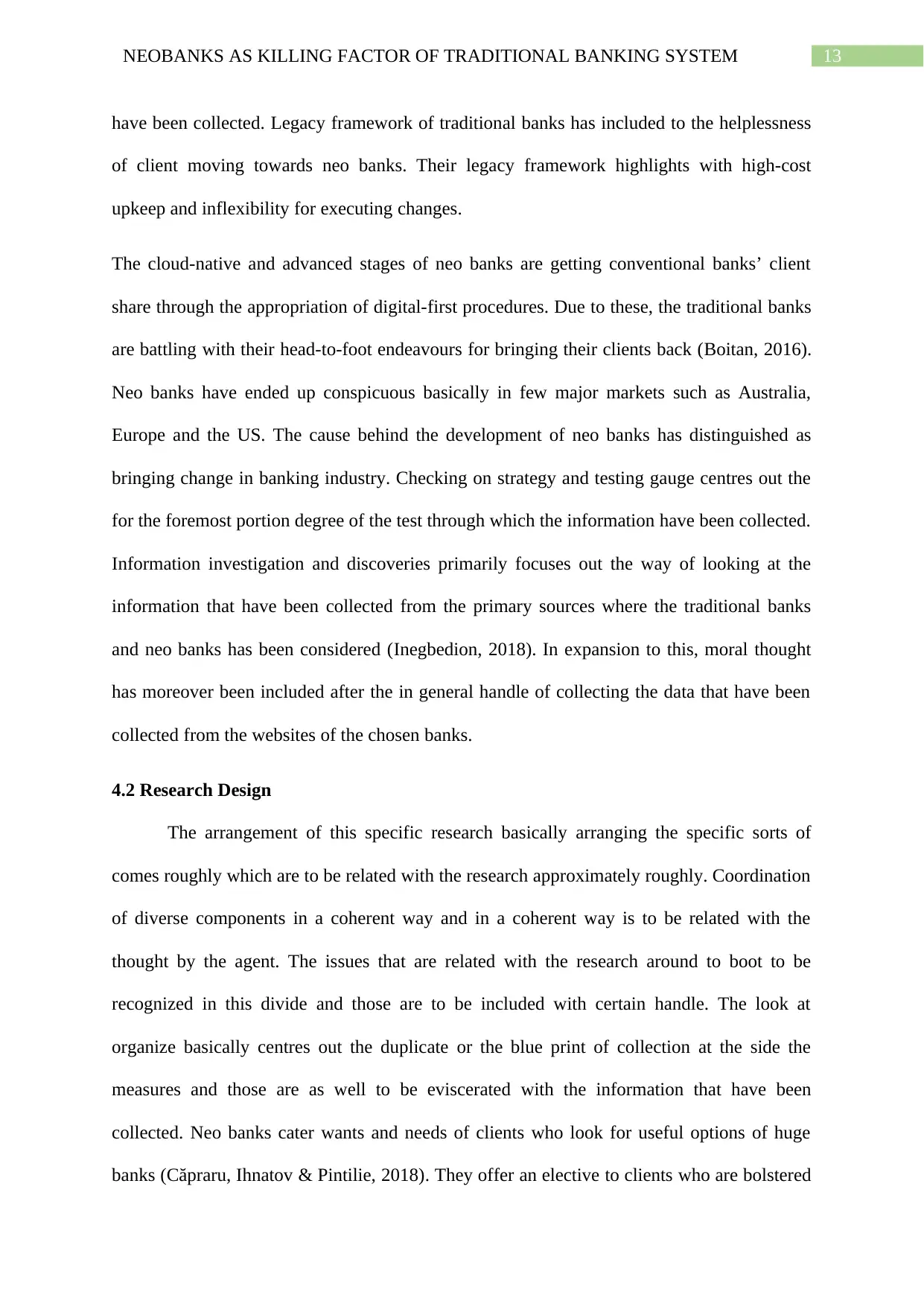
13NEOBANKS AS KILLING FACTOR OF TRADITIONAL BANKING SYSTEM
have been collected. Legacy framework of traditional banks has included to the helplessness
of client moving towards neo banks. Their legacy framework highlights with high-cost
upkeep and inflexibility for executing changes.
The cloud-native and advanced stages of neo banks are getting conventional banks’ client
share through the appropriation of digital-first procedures. Due to these, the traditional banks
are battling with their head-to-foot endeavours for bringing their clients back (Boitan, 2016).
Neo banks have ended up conspicuous basically in few major markets such as Australia,
Europe and the US. The cause behind the development of neo banks has distinguished as
bringing change in banking industry. Checking on strategy and testing gauge centres out the
for the foremost portion degree of the test through which the information have been collected.
Information investigation and discoveries primarily focuses out the way of looking at the
information that have been collected from the primary sources where the traditional banks
and neo banks has been considered (Inegbedion, 2018). In expansion to this, moral thought
has moreover been included after the in general handle of collecting the data that have been
collected from the websites of the chosen banks.
4.2 Research Design
The arrangement of this specific research basically arranging the specific sorts of
comes roughly which are to be related with the research approximately roughly. Coordination
of diverse components in a coherent way and in a coherent way is to be related with the
thought by the agent. The issues that are related with the research around to boot to be
recognized in this divide and those are to be included with certain handle. The look at
organize basically centres out the duplicate or the blue print of collection at the side the
measures and those are as well to be eviscerated with the information that have been
collected. Neo banks cater wants and needs of clients who look for useful options of huge
banks (Căpraru, Ihnatov & Pintilie, 2018). They offer an elective to clients who are bolstered
have been collected. Legacy framework of traditional banks has included to the helplessness
of client moving towards neo banks. Their legacy framework highlights with high-cost
upkeep and inflexibility for executing changes.
The cloud-native and advanced stages of neo banks are getting conventional banks’ client
share through the appropriation of digital-first procedures. Due to these, the traditional banks
are battling with their head-to-foot endeavours for bringing their clients back (Boitan, 2016).
Neo banks have ended up conspicuous basically in few major markets such as Australia,
Europe and the US. The cause behind the development of neo banks has distinguished as
bringing change in banking industry. Checking on strategy and testing gauge centres out the
for the foremost portion degree of the test through which the information have been collected.
Information investigation and discoveries primarily focuses out the way of looking at the
information that have been collected from the primary sources where the traditional banks
and neo banks has been considered (Inegbedion, 2018). In expansion to this, moral thought
has moreover been included after the in general handle of collecting the data that have been
collected from the websites of the chosen banks.
4.2 Research Design
The arrangement of this specific research basically arranging the specific sorts of
comes roughly which are to be related with the research approximately roughly. Coordination
of diverse components in a coherent way and in a coherent way is to be related with the
thought by the agent. The issues that are related with the research around to boot to be
recognized in this divide and those are to be included with certain handle. The look at
organize basically centres out the duplicate or the blue print of collection at the side the
measures and those are as well to be eviscerated with the information that have been
collected. Neo banks cater wants and needs of clients who look for useful options of huge
banks (Căpraru, Ihnatov & Pintilie, 2018). They offer an elective to clients who are bolstered
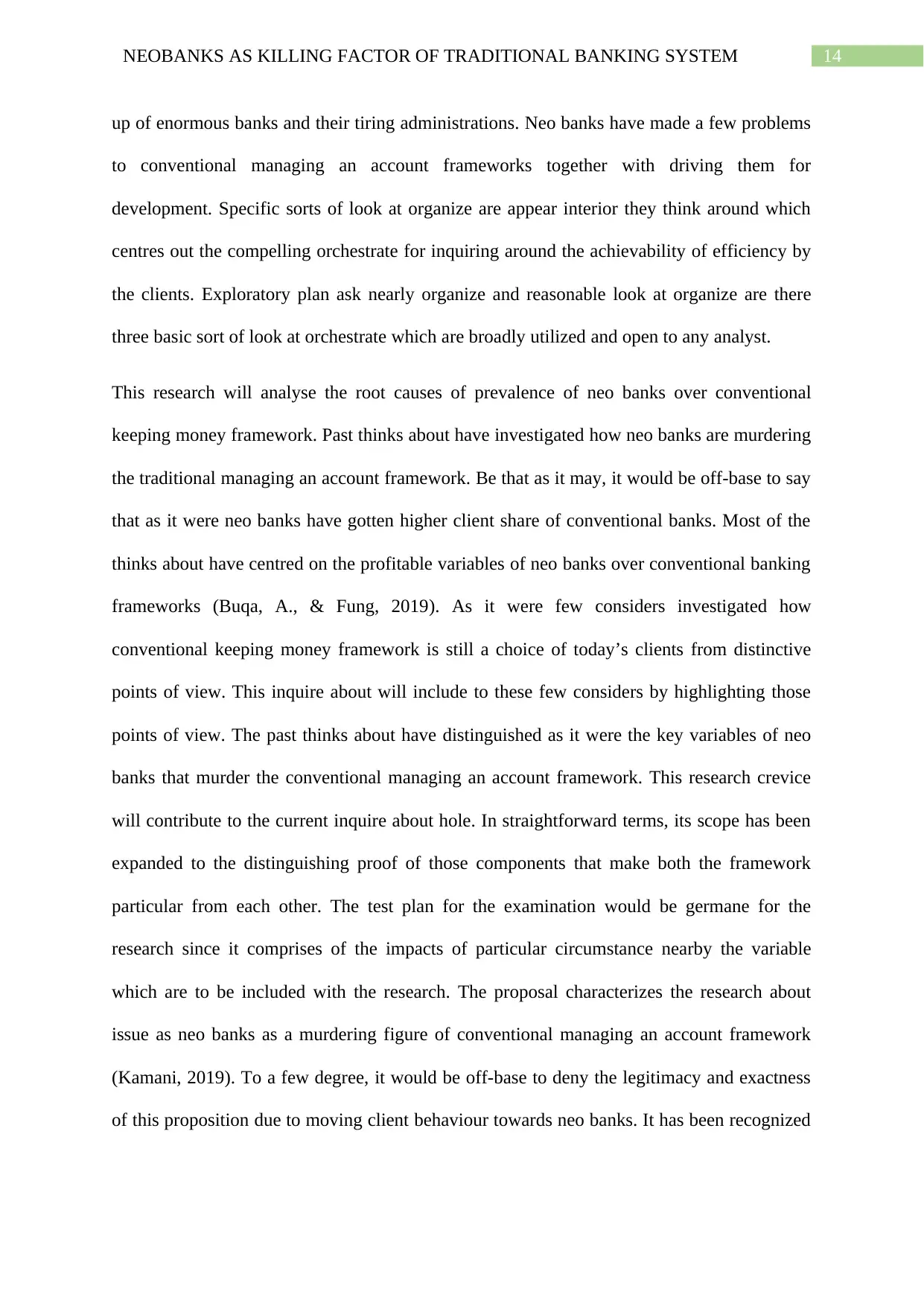
14NEOBANKS AS KILLING FACTOR OF TRADITIONAL BANKING SYSTEM
up of enormous banks and their tiring administrations. Neo banks have made a few problems
to conventional managing an account frameworks together with driving them for
development. Specific sorts of look at organize are appear interior they think around which
centres out the compelling orchestrate for inquiring around the achievability of efficiency by
the clients. Exploratory plan ask nearly organize and reasonable look at organize are there
three basic sort of look at orchestrate which are broadly utilized and open to any analyst.
This research will analyse the root causes of prevalence of neo banks over conventional
keeping money framework. Past thinks about have investigated how neo banks are murdering
the traditional managing an account framework. Be that as it may, it would be off-base to say
that as it were neo banks have gotten higher client share of conventional banks. Most of the
thinks about have centred on the profitable variables of neo banks over conventional banking
frameworks (Buqa, A., & Fung, 2019). As it were few considers investigated how
conventional keeping money framework is still a choice of today’s clients from distinctive
points of view. This inquire about will include to these few considers by highlighting those
points of view. The past thinks about have distinguished as it were the key variables of neo
banks that murder the conventional managing an account framework. This research crevice
will contribute to the current inquire about hole. In straightforward terms, its scope has been
expanded to the distinguishing proof of those components that make both the framework
particular from each other. The test plan for the examination would be germane for the
research since it comprises of the impacts of particular circumstance nearby the variable
which are to be included with the research. The proposal characterizes the research about
issue as neo banks as a murdering figure of conventional managing an account framework
(Kamani, 2019). To a few degree, it would be off-base to deny the legitimacy and exactness
of this proposition due to moving client behaviour towards neo banks. It has been recognized
up of enormous banks and their tiring administrations. Neo banks have made a few problems
to conventional managing an account frameworks together with driving them for
development. Specific sorts of look at organize are appear interior they think around which
centres out the compelling orchestrate for inquiring around the achievability of efficiency by
the clients. Exploratory plan ask nearly organize and reasonable look at organize are there
three basic sort of look at orchestrate which are broadly utilized and open to any analyst.
This research will analyse the root causes of prevalence of neo banks over conventional
keeping money framework. Past thinks about have investigated how neo banks are murdering
the traditional managing an account framework. Be that as it may, it would be off-base to say
that as it were neo banks have gotten higher client share of conventional banks. Most of the
thinks about have centred on the profitable variables of neo banks over conventional banking
frameworks (Buqa, A., & Fung, 2019). As it were few considers investigated how
conventional keeping money framework is still a choice of today’s clients from distinctive
points of view. This inquire about will include to these few considers by highlighting those
points of view. The past thinks about have distinguished as it were the key variables of neo
banks that murder the conventional managing an account framework. This research crevice
will contribute to the current inquire about hole. In straightforward terms, its scope has been
expanded to the distinguishing proof of those components that make both the framework
particular from each other. The test plan for the examination would be germane for the
research since it comprises of the impacts of particular circumstance nearby the variable
which are to be included with the research. The proposal characterizes the research about
issue as neo banks as a murdering figure of conventional managing an account framework
(Kamani, 2019). To a few degree, it would be off-base to deny the legitimacy and exactness
of this proposition due to moving client behaviour towards neo banks. It has been recognized

15NEOBANKS AS KILLING FACTOR OF TRADITIONAL BANKING SYSTEM
that the execution of conventional banks is influencing due to the significant development of
neo banks.
4.2.1 Type of research
The research consist of certain types which points out the descriptions, metaphors and
symbols of the things along with their measures. In this particular research, both qualitative
research as well as quantitative research is required to be considered where only one research
is to be used. In this particular research. Quantitative research is to be performed and it
consist of certain research instrument which has been used in the study. On the other hand,
qualitative data has been utilised which points out the effective certain methods such as
analysis of case study, keeping of record along with processing the observation of data (Dai,
2018). Focus group is also to be enhanced in this particular method and one on one interview
is also another method that points out the opinions of the respondents. As this particular
research is focused on the quantitative data so, the performance of statistical data is also to be
included in the study.
Quantitative data has been collected for the research where the certain question are provided
to the respondents as questionnaire along with performing, mathematical and computational
technique. This particular type of research collects the overall information of the existing as
well as potential customers which points out the methods of sampling. The understanding of
the numbers along with predicting the future products for making certain changes as per the
overall requirements. Primary quantitative research methods is mainly used for conducting
the market research which also points out the data that are being collected from the
respondents (Ford, 2017). The distinctive tracks is to be broken down with other distinctive
methods along with points out the quantitative data. This research also focuses on certain
variable that are associated with the research and likert scale has also been used in this
particular research. Moreover, the research is followed by the design of the research
that the execution of conventional banks is influencing due to the significant development of
neo banks.
4.2.1 Type of research
The research consist of certain types which points out the descriptions, metaphors and
symbols of the things along with their measures. In this particular research, both qualitative
research as well as quantitative research is required to be considered where only one research
is to be used. In this particular research. Quantitative research is to be performed and it
consist of certain research instrument which has been used in the study. On the other hand,
qualitative data has been utilised which points out the effective certain methods such as
analysis of case study, keeping of record along with processing the observation of data (Dai,
2018). Focus group is also to be enhanced in this particular method and one on one interview
is also another method that points out the opinions of the respondents. As this particular
research is focused on the quantitative data so, the performance of statistical data is also to be
included in the study.
Quantitative data has been collected for the research where the certain question are provided
to the respondents as questionnaire along with performing, mathematical and computational
technique. This particular type of research collects the overall information of the existing as
well as potential customers which points out the methods of sampling. The understanding of
the numbers along with predicting the future products for making certain changes as per the
overall requirements. Primary quantitative research methods is mainly used for conducting
the market research which also points out the data that are being collected from the
respondents (Ford, 2017). The distinctive tracks is to be broken down with other distinctive
methods along with points out the quantitative data. This research also focuses on certain
variable that are associated with the research and likert scale has also been used in this
particular research. Moreover, the research is followed by the design of the research
Secure Best Marks with AI Grader
Need help grading? Try our AI Grader for instant feedback on your assignments.
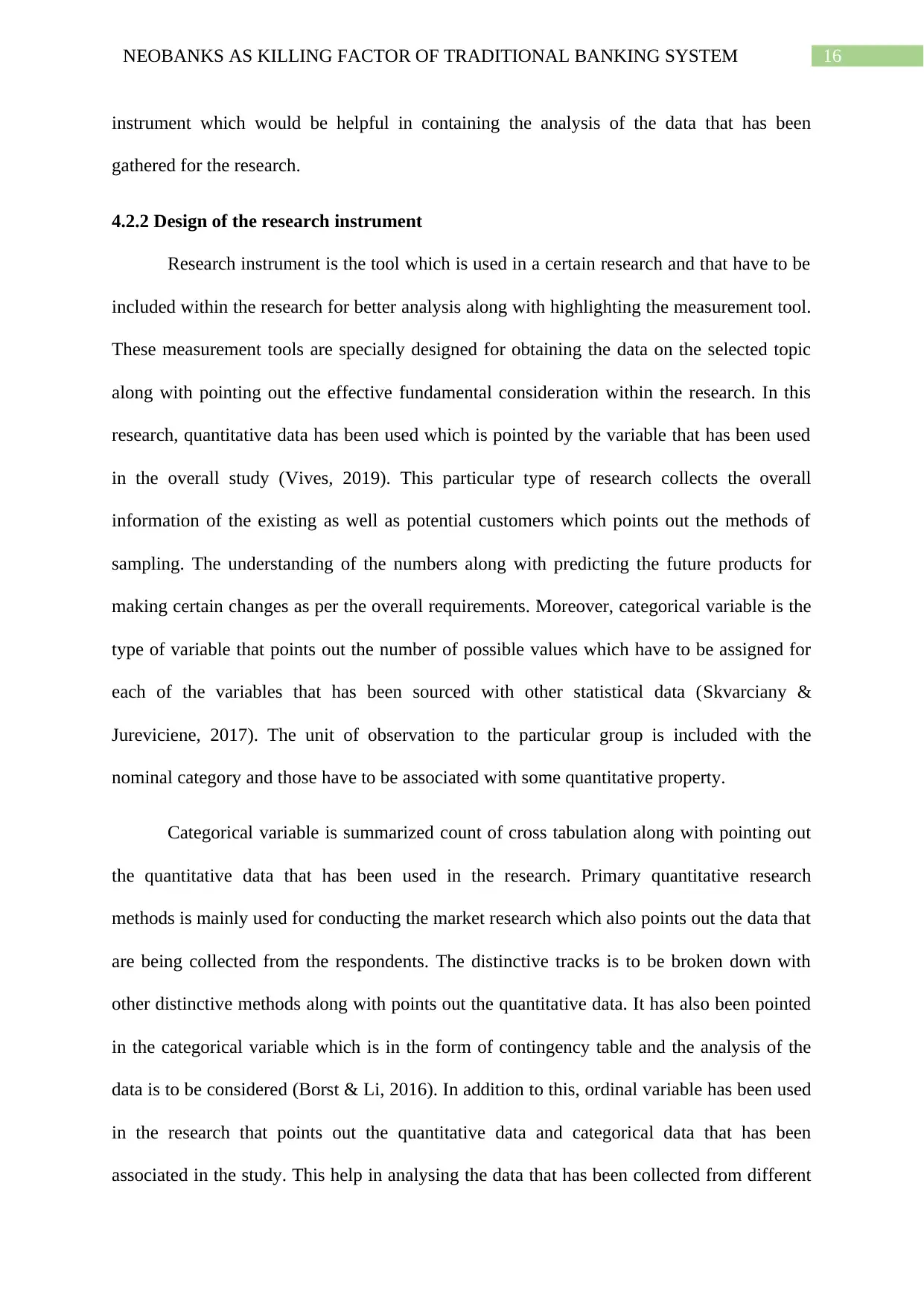
16NEOBANKS AS KILLING FACTOR OF TRADITIONAL BANKING SYSTEM
instrument which would be helpful in containing the analysis of the data that has been
gathered for the research.
4.2.2 Design of the research instrument
Research instrument is the tool which is used in a certain research and that have to be
included within the research for better analysis along with highlighting the measurement tool.
These measurement tools are specially designed for obtaining the data on the selected topic
along with pointing out the effective fundamental consideration within the research. In this
research, quantitative data has been used which is pointed by the variable that has been used
in the overall study (Vives, 2019). This particular type of research collects the overall
information of the existing as well as potential customers which points out the methods of
sampling. The understanding of the numbers along with predicting the future products for
making certain changes as per the overall requirements. Moreover, categorical variable is the
type of variable that points out the number of possible values which have to be assigned for
each of the variables that has been sourced with other statistical data (Skvarciany &
Jureviciene, 2017). The unit of observation to the particular group is included with the
nominal category and those have to be associated with some quantitative property.
Categorical variable is summarized count of cross tabulation along with pointing out
the quantitative data that has been used in the research. Primary quantitative research
methods is mainly used for conducting the market research which also points out the data that
are being collected from the respondents. The distinctive tracks is to be broken down with
other distinctive methods along with points out the quantitative data. It has also been pointed
in the categorical variable which is in the form of contingency table and the analysis of the
data is to be considered (Borst & Li, 2016). In addition to this, ordinal variable has been used
in the research that points out the quantitative data and categorical data that has been
associated in the study. This help in analysing the data that has been collected from different
instrument which would be helpful in containing the analysis of the data that has been
gathered for the research.
4.2.2 Design of the research instrument
Research instrument is the tool which is used in a certain research and that have to be
included within the research for better analysis along with highlighting the measurement tool.
These measurement tools are specially designed for obtaining the data on the selected topic
along with pointing out the effective fundamental consideration within the research. In this
research, quantitative data has been used which is pointed by the variable that has been used
in the overall study (Vives, 2019). This particular type of research collects the overall
information of the existing as well as potential customers which points out the methods of
sampling. The understanding of the numbers along with predicting the future products for
making certain changes as per the overall requirements. Moreover, categorical variable is the
type of variable that points out the number of possible values which have to be assigned for
each of the variables that has been sourced with other statistical data (Skvarciany &
Jureviciene, 2017). The unit of observation to the particular group is included with the
nominal category and those have to be associated with some quantitative property.
Categorical variable is summarized count of cross tabulation along with pointing out
the quantitative data that has been used in the research. Primary quantitative research
methods is mainly used for conducting the market research which also points out the data that
are being collected from the respondents. The distinctive tracks is to be broken down with
other distinctive methods along with points out the quantitative data. It has also been pointed
in the categorical variable which is in the form of contingency table and the analysis of the
data is to be considered (Borst & Li, 2016). In addition to this, ordinal variable has been used
in the research that points out the quantitative data and categorical data that has been
associated in the study. This help in analysing the data that has been collected from different
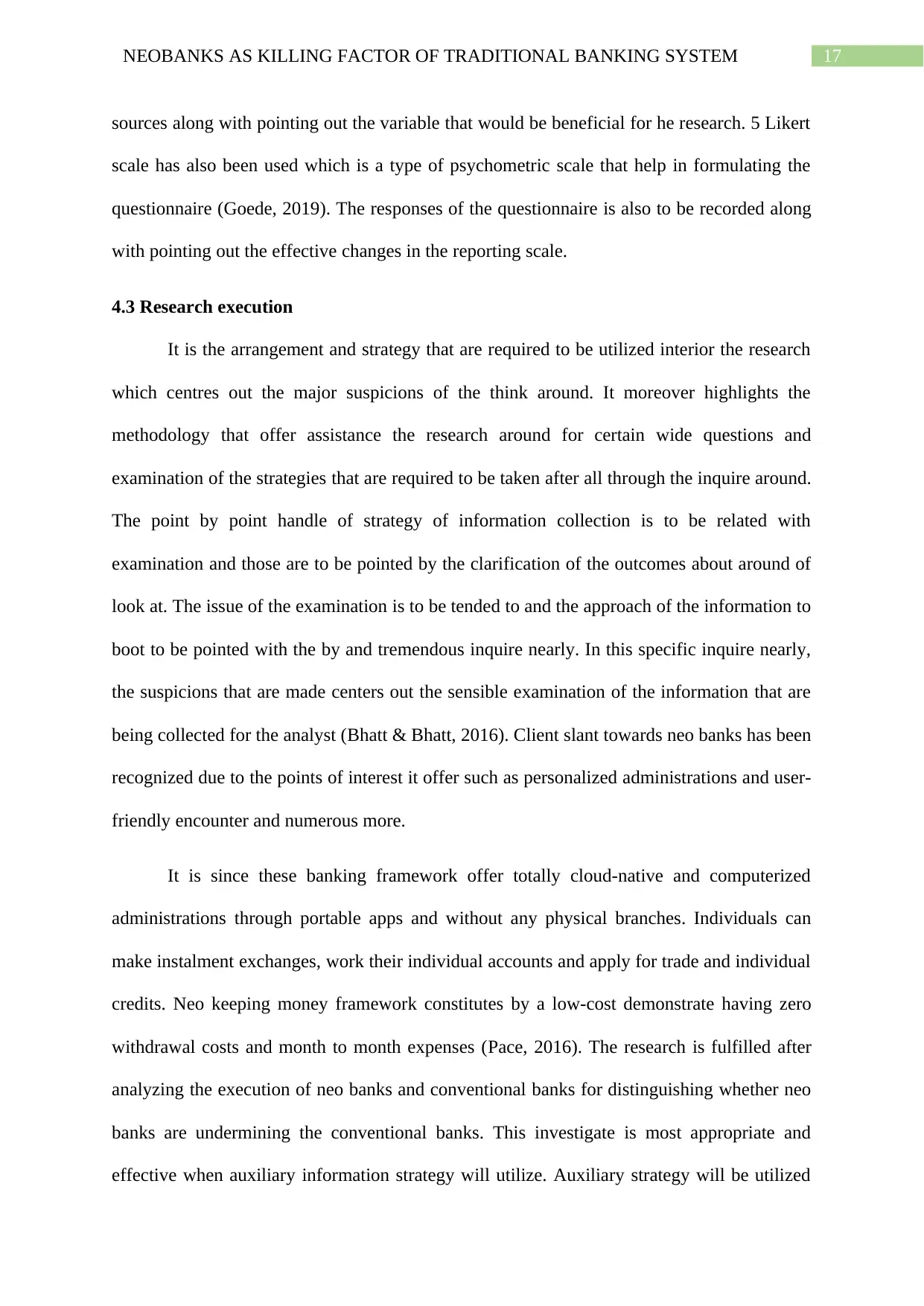
17NEOBANKS AS KILLING FACTOR OF TRADITIONAL BANKING SYSTEM
sources along with pointing out the variable that would be beneficial for he research. 5 Likert
scale has also been used which is a type of psychometric scale that help in formulating the
questionnaire (Goede, 2019). The responses of the questionnaire is also to be recorded along
with pointing out the effective changes in the reporting scale.
4.3 Research execution
It is the arrangement and strategy that are required to be utilized interior the research
which centres out the major suspicions of the think around. It moreover highlights the
methodology that offer assistance the research around for certain wide questions and
examination of the strategies that are required to be taken after all through the inquire around.
The point by point handle of strategy of information collection is to be related with
examination and those are to be pointed by the clarification of the outcomes about around of
look at. The issue of the examination is to be tended to and the approach of the information to
boot to be pointed with the by and tremendous inquire nearly. In this specific inquire nearly,
the suspicions that are made centers out the sensible examination of the information that are
being collected for the analyst (Bhatt & Bhatt, 2016). Client slant towards neo banks has been
recognized due to the points of interest it offer such as personalized administrations and user-
friendly encounter and numerous more.
It is since these banking framework offer totally cloud-native and computerized
administrations through portable apps and without any physical branches. Individuals can
make instalment exchanges, work their individual accounts and apply for trade and individual
credits. Neo keeping money framework constitutes by a low-cost demonstrate having zero
withdrawal costs and month to month expenses (Pace, 2016). The research is fulfilled after
analyzing the execution of neo banks and conventional banks for distinguishing whether neo
banks are undermining the conventional banks. This investigate is most appropriate and
effective when auxiliary information strategy will utilize. Auxiliary strategy will be utilized
sources along with pointing out the variable that would be beneficial for he research. 5 Likert
scale has also been used which is a type of psychometric scale that help in formulating the
questionnaire (Goede, 2019). The responses of the questionnaire is also to be recorded along
with pointing out the effective changes in the reporting scale.
4.3 Research execution
It is the arrangement and strategy that are required to be utilized interior the research
which centres out the major suspicions of the think around. It moreover highlights the
methodology that offer assistance the research around for certain wide questions and
examination of the strategies that are required to be taken after all through the inquire around.
The point by point handle of strategy of information collection is to be related with
examination and those are to be pointed by the clarification of the outcomes about around of
look at. The issue of the examination is to be tended to and the approach of the information to
boot to be pointed with the by and tremendous inquire nearly. In this specific inquire nearly,
the suspicions that are made centers out the sensible examination of the information that are
being collected for the analyst (Bhatt & Bhatt, 2016). Client slant towards neo banks has been
recognized due to the points of interest it offer such as personalized administrations and user-
friendly encounter and numerous more.
It is since these banking framework offer totally cloud-native and computerized
administrations through portable apps and without any physical branches. Individuals can
make instalment exchanges, work their individual accounts and apply for trade and individual
credits. Neo keeping money framework constitutes by a low-cost demonstrate having zero
withdrawal costs and month to month expenses (Pace, 2016). The research is fulfilled after
analyzing the execution of neo banks and conventional banks for distinguishing whether neo
banks are undermining the conventional banks. This investigate is most appropriate and
effective when auxiliary information strategy will utilize. Auxiliary strategy will be utilized

18NEOBANKS AS KILLING FACTOR OF TRADITIONAL BANKING SYSTEM
with the examination of quantitative and subjective inquire about information. The blended
investigate strategy (quantitative and subjective) will offer assistance in fulfilling research
destinations. Information will extricate from the monetary articulations and yearly reports of
the chosen companies for driving to the results.
4.4 Analysis of data
This paper has collected primary data and thus the questionnaires are developed in
order to get the answers of research questions. At the time of developing the questionnaires it
was taken into consideration that suitable statistical tools like data analysis can be done. Here,
the data is straight to the point that asks the suitable questions that represents the research
questions. Now, in the process of data analysis it is found that the data on each variable are
non-parametric which are tested and proved through Normality test of Shapiro-Wilk test.
Then the frequency tables are prepared and where the responses are represented through table
and charts and described in details. Then the non-parametric on sample chi-square test is
performed to get the significant differences in the sub-categories of a categorical variable
(Osman, 2016).
4.4.1 Profile of respondents
The profile of the respondents has been gathered from the responses which has been
included in the studies along with reported with their opinions in the following tables. The
frequency and the percentage of the each responses has been recorded in the studies which
have to be analysed in their respective way (Peter, 2015). The following tables and the figure
mainly highlights the responses of the respondents in this particular research.
Your gender
Frequency Percent Valid
Percent
Cumulative
Percent
with the examination of quantitative and subjective inquire about information. The blended
investigate strategy (quantitative and subjective) will offer assistance in fulfilling research
destinations. Information will extricate from the monetary articulations and yearly reports of
the chosen companies for driving to the results.
4.4 Analysis of data
This paper has collected primary data and thus the questionnaires are developed in
order to get the answers of research questions. At the time of developing the questionnaires it
was taken into consideration that suitable statistical tools like data analysis can be done. Here,
the data is straight to the point that asks the suitable questions that represents the research
questions. Now, in the process of data analysis it is found that the data on each variable are
non-parametric which are tested and proved through Normality test of Shapiro-Wilk test.
Then the frequency tables are prepared and where the responses are represented through table
and charts and described in details. Then the non-parametric on sample chi-square test is
performed to get the significant differences in the sub-categories of a categorical variable
(Osman, 2016).
4.4.1 Profile of respondents
The profile of the respondents has been gathered from the responses which has been
included in the studies along with reported with their opinions in the following tables. The
frequency and the percentage of the each responses has been recorded in the studies which
have to be analysed in their respective way (Peter, 2015). The following tables and the figure
mainly highlights the responses of the respondents in this particular research.
Your gender
Frequency Percent Valid
Percent
Cumulative
Percent
Paraphrase This Document
Need a fresh take? Get an instant paraphrase of this document with our AI Paraphraser
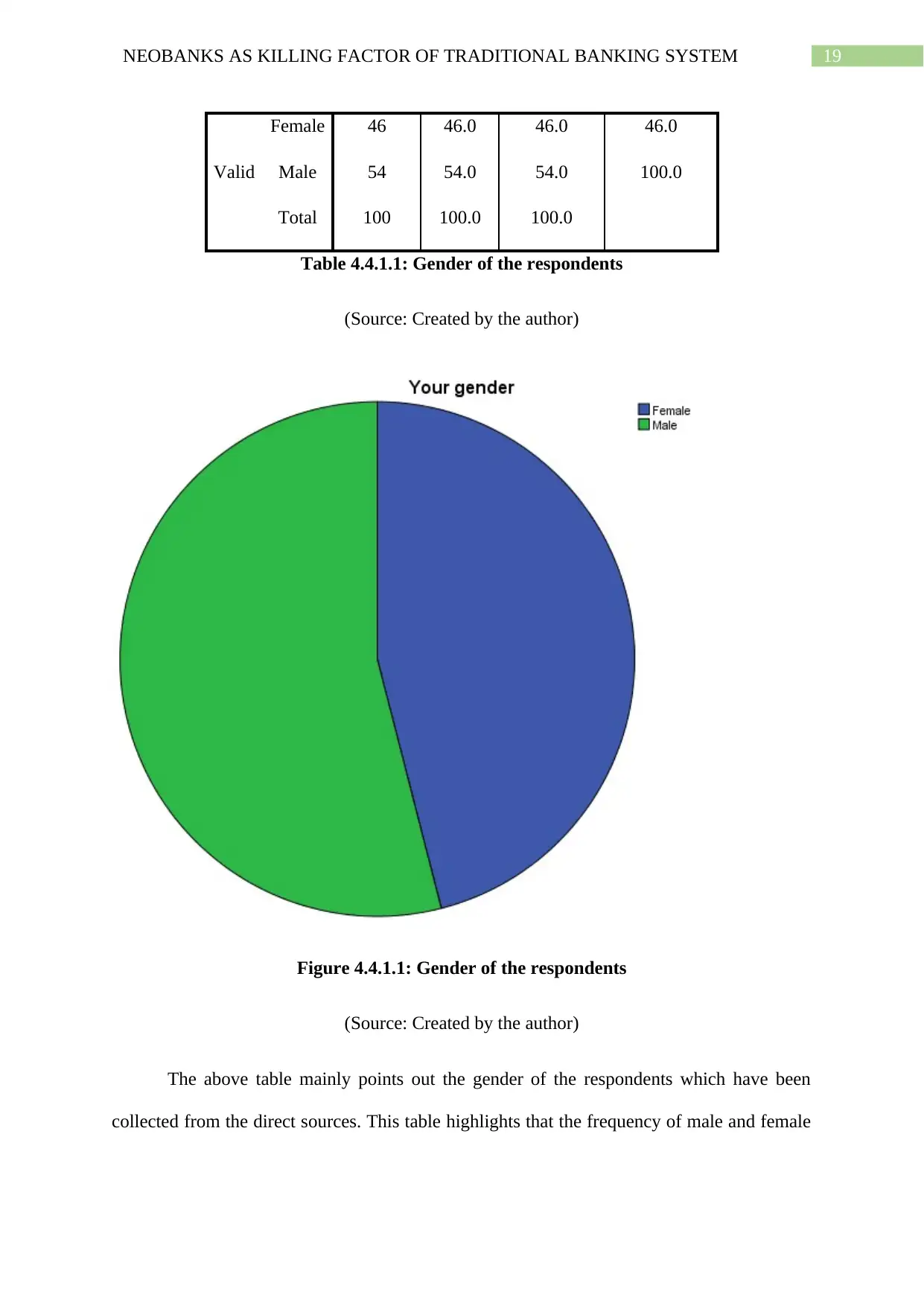
19NEOBANKS AS KILLING FACTOR OF TRADITIONAL BANKING SYSTEM
Valid
Female 46 46.0 46.0 46.0
Male 54 54.0 54.0 100.0
Total 100 100.0 100.0
Table 4.4.1.1: Gender of the respondents
(Source: Created by the author)
Figure 4.4.1.1: Gender of the respondents
(Source: Created by the author)
The above table mainly points out the gender of the respondents which have been
collected from the direct sources. This table highlights that the frequency of male and female
Valid
Female 46 46.0 46.0 46.0
Male 54 54.0 54.0 100.0
Total 100 100.0 100.0
Table 4.4.1.1: Gender of the respondents
(Source: Created by the author)
Figure 4.4.1.1: Gender of the respondents
(Source: Created by the author)
The above table mainly points out the gender of the respondents which have been
collected from the direct sources. This table highlights that the frequency of male and female
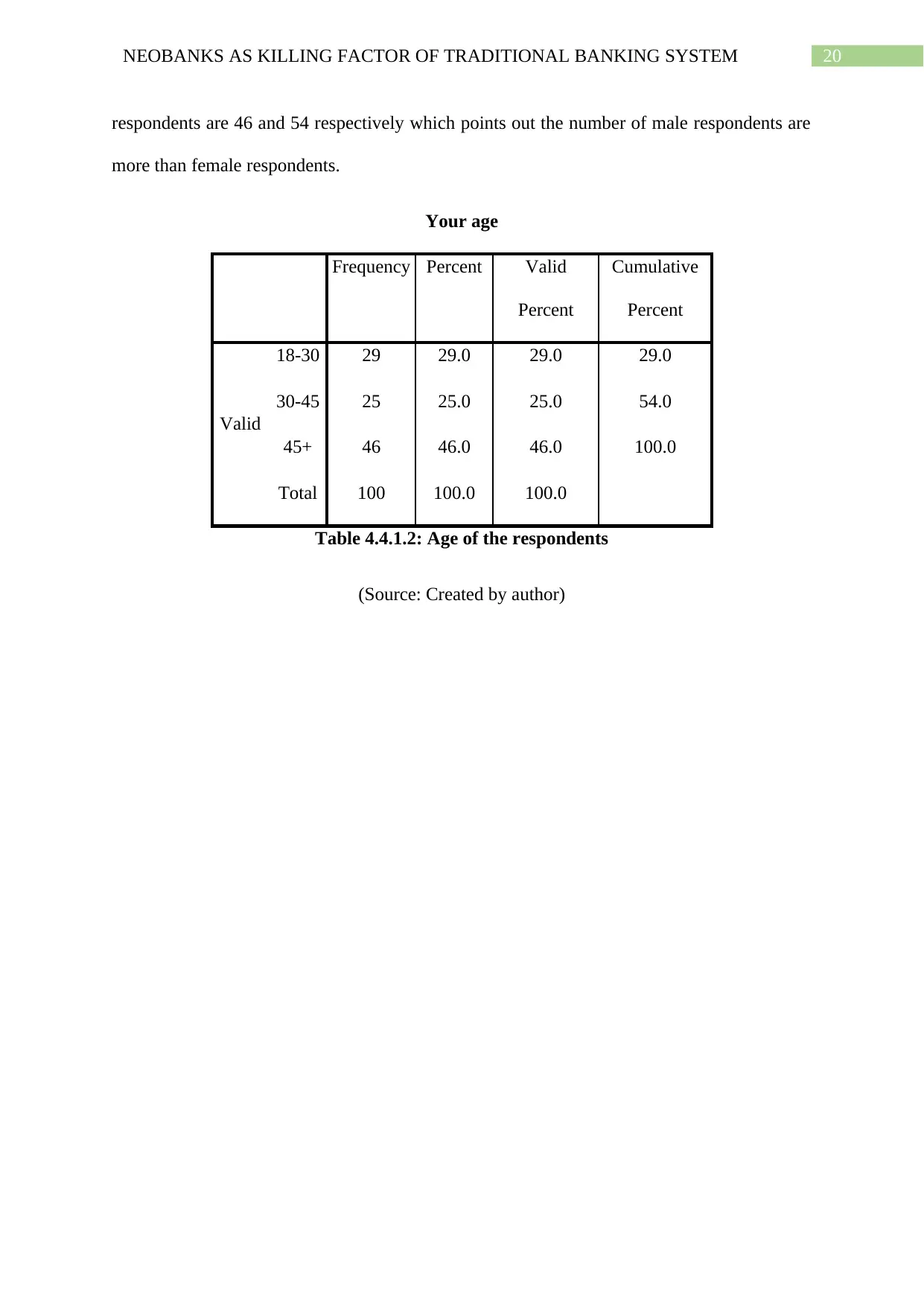
20NEOBANKS AS KILLING FACTOR OF TRADITIONAL BANKING SYSTEM
respondents are 46 and 54 respectively which points out the number of male respondents are
more than female respondents.
Your age
Frequency Percent Valid
Percent
Cumulative
Percent
Valid
18-30 29 29.0 29.0 29.0
30-45 25 25.0 25.0 54.0
45+ 46 46.0 46.0 100.0
Total 100 100.0 100.0
Table 4.4.1.2: Age of the respondents
(Source: Created by author)
respondents are 46 and 54 respectively which points out the number of male respondents are
more than female respondents.
Your age
Frequency Percent Valid
Percent
Cumulative
Percent
Valid
18-30 29 29.0 29.0 29.0
30-45 25 25.0 25.0 54.0
45+ 46 46.0 46.0 100.0
Total 100 100.0 100.0
Table 4.4.1.2: Age of the respondents
(Source: Created by author)
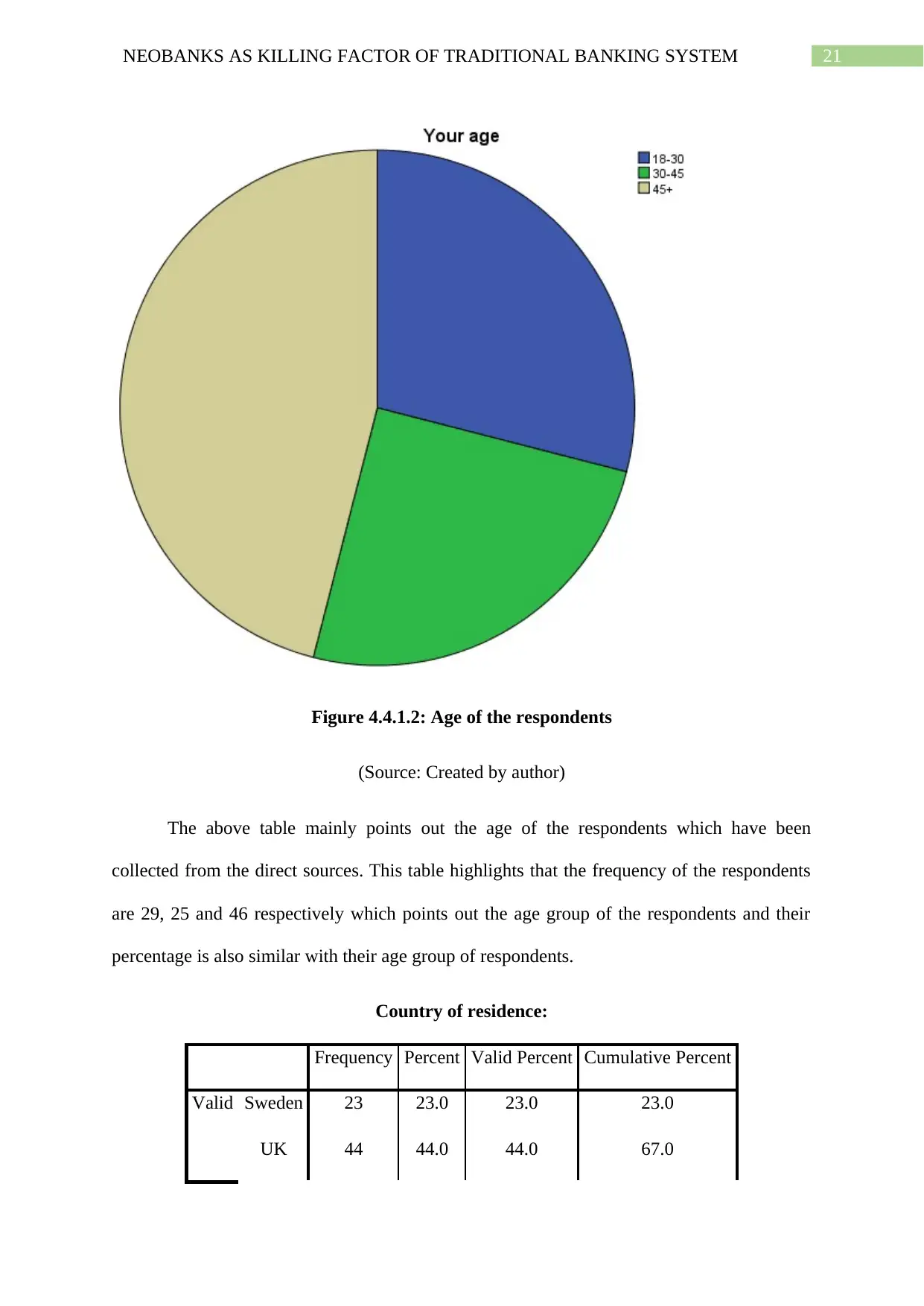
21NEOBANKS AS KILLING FACTOR OF TRADITIONAL BANKING SYSTEM
Figure 4.4.1.2: Age of the respondents
(Source: Created by author)
The above table mainly points out the age of the respondents which have been
collected from the direct sources. This table highlights that the frequency of the respondents
are 29, 25 and 46 respectively which points out the age group of the respondents and their
percentage is also similar with their age group of respondents.
Country of residence:
Frequency Percent Valid Percent Cumulative Percent
Valid Sweden 23 23.0 23.0 23.0
UK 44 44.0 44.0 67.0
Figure 4.4.1.2: Age of the respondents
(Source: Created by author)
The above table mainly points out the age of the respondents which have been
collected from the direct sources. This table highlights that the frequency of the respondents
are 29, 25 and 46 respectively which points out the age group of the respondents and their
percentage is also similar with their age group of respondents.
Country of residence:
Frequency Percent Valid Percent Cumulative Percent
Valid Sweden 23 23.0 23.0 23.0
UK 44 44.0 44.0 67.0
Secure Best Marks with AI Grader
Need help grading? Try our AI Grader for instant feedback on your assignments.
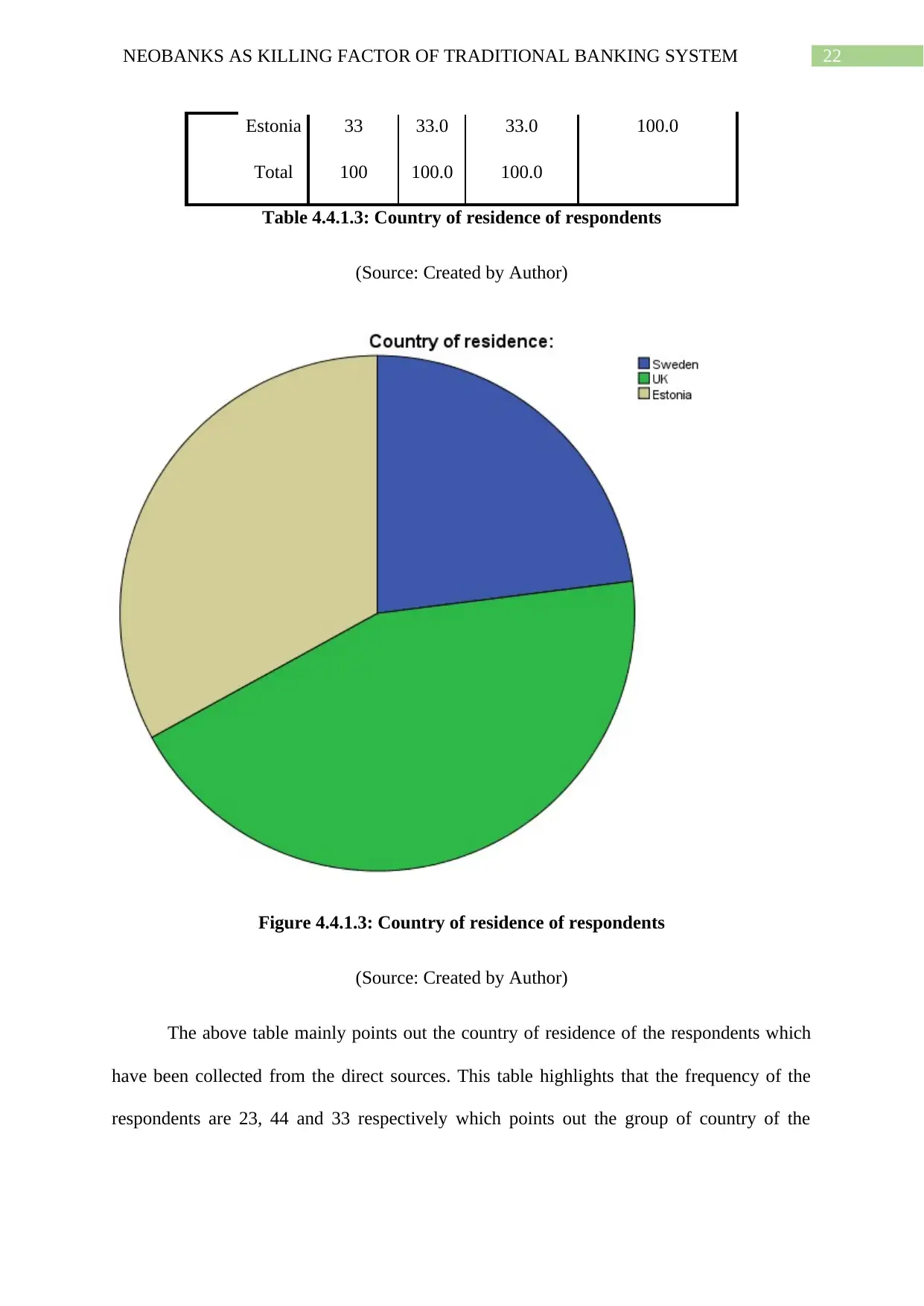
22NEOBANKS AS KILLING FACTOR OF TRADITIONAL BANKING SYSTEM
Estonia 33 33.0 33.0 100.0
Total 100 100.0 100.0
Table 4.4.1.3: Country of residence of respondents
(Source: Created by Author)
Figure 4.4.1.3: Country of residence of respondents
(Source: Created by Author)
The above table mainly points out the country of residence of the respondents which
have been collected from the direct sources. This table highlights that the frequency of the
respondents are 23, 44 and 33 respectively which points out the group of country of the
Estonia 33 33.0 33.0 100.0
Total 100 100.0 100.0
Table 4.4.1.3: Country of residence of respondents
(Source: Created by Author)
Figure 4.4.1.3: Country of residence of respondents
(Source: Created by Author)
The above table mainly points out the country of residence of the respondents which
have been collected from the direct sources. This table highlights that the frequency of the
respondents are 23, 44 and 33 respectively which points out the group of country of the
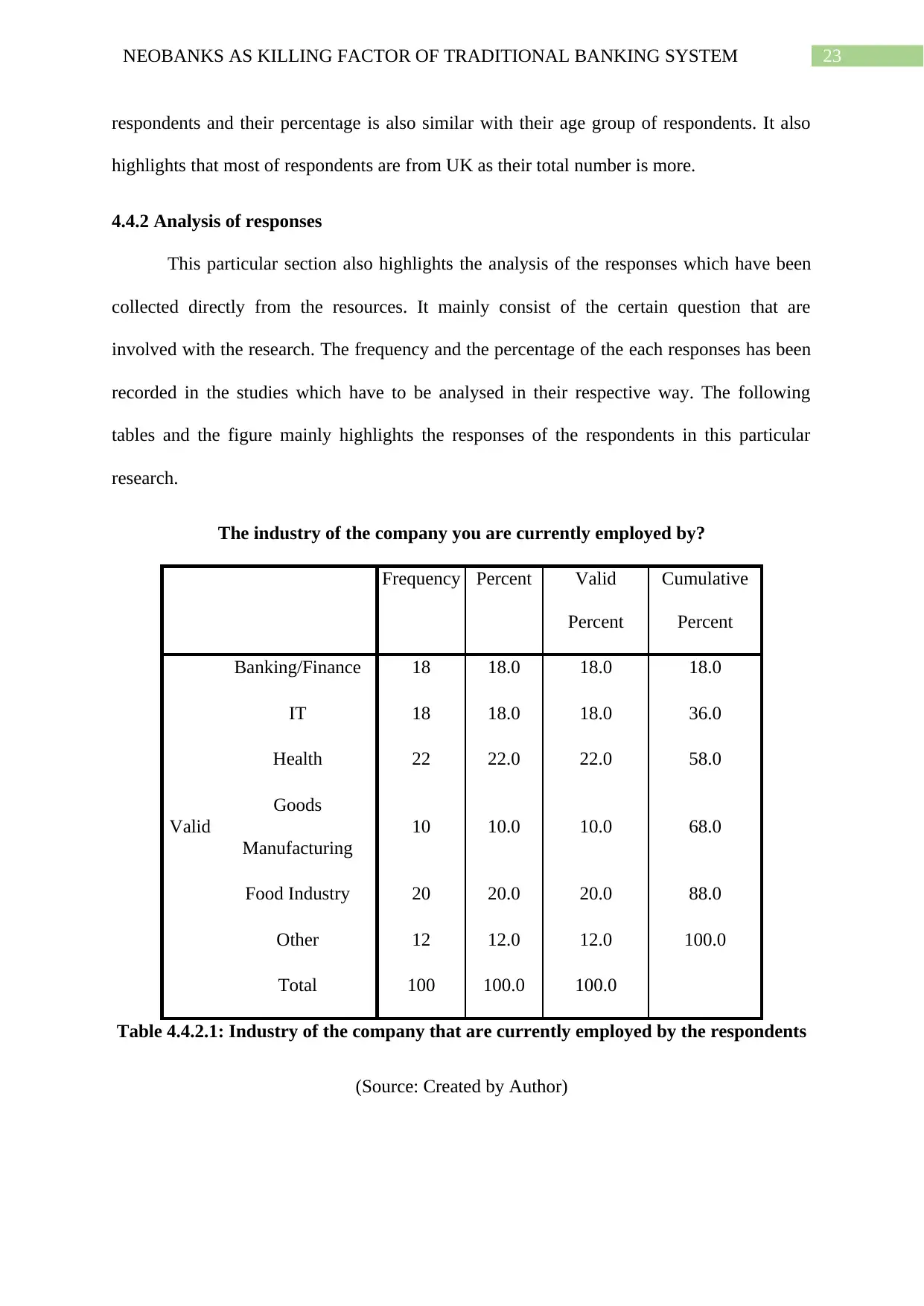
23NEOBANKS AS KILLING FACTOR OF TRADITIONAL BANKING SYSTEM
respondents and their percentage is also similar with their age group of respondents. It also
highlights that most of respondents are from UK as their total number is more.
4.4.2 Analysis of responses
This particular section also highlights the analysis of the responses which have been
collected directly from the resources. It mainly consist of the certain question that are
involved with the research. The frequency and the percentage of the each responses has been
recorded in the studies which have to be analysed in their respective way. The following
tables and the figure mainly highlights the responses of the respondents in this particular
research.
The industry of the company you are currently employed by?
Frequency Percent Valid
Percent
Cumulative
Percent
Valid
Banking/Finance 18 18.0 18.0 18.0
IT 18 18.0 18.0 36.0
Health 22 22.0 22.0 58.0
Goods
Manufacturing
10 10.0 10.0 68.0
Food Industry 20 20.0 20.0 88.0
Other 12 12.0 12.0 100.0
Total 100 100.0 100.0
Table 4.4.2.1: Industry of the company that are currently employed by the respondents
(Source: Created by Author)
respondents and their percentage is also similar with their age group of respondents. It also
highlights that most of respondents are from UK as their total number is more.
4.4.2 Analysis of responses
This particular section also highlights the analysis of the responses which have been
collected directly from the resources. It mainly consist of the certain question that are
involved with the research. The frequency and the percentage of the each responses has been
recorded in the studies which have to be analysed in their respective way. The following
tables and the figure mainly highlights the responses of the respondents in this particular
research.
The industry of the company you are currently employed by?
Frequency Percent Valid
Percent
Cumulative
Percent
Valid
Banking/Finance 18 18.0 18.0 18.0
IT 18 18.0 18.0 36.0
Health 22 22.0 22.0 58.0
Goods
Manufacturing
10 10.0 10.0 68.0
Food Industry 20 20.0 20.0 88.0
Other 12 12.0 12.0 100.0
Total 100 100.0 100.0
Table 4.4.2.1: Industry of the company that are currently employed by the respondents
(Source: Created by Author)
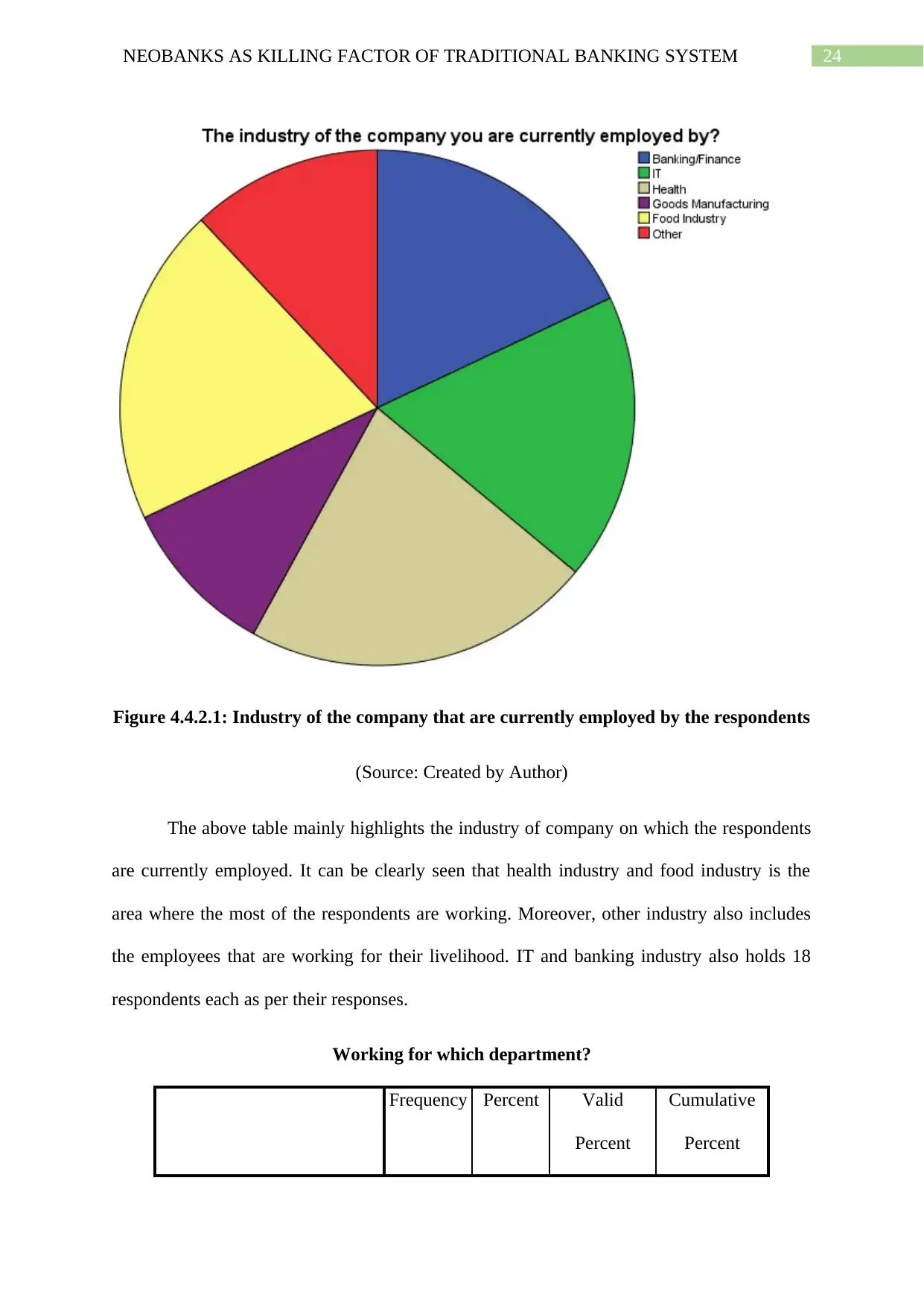
24NEOBANKS AS KILLING FACTOR OF TRADITIONAL BANKING SYSTEM
Figure 4.4.2.1: Industry of the company that are currently employed by the respondents
(Source: Created by Author)
The above table mainly highlights the industry of company on which the respondents
are currently employed. It can be clearly seen that health industry and food industry is the
area where the most of the respondents are working. Moreover, other industry also includes
the employees that are working for their livelihood. IT and banking industry also holds 18
respondents each as per their responses.
Working for which department?
Frequency Percent Valid
Percent
Cumulative
Percent
Figure 4.4.2.1: Industry of the company that are currently employed by the respondents
(Source: Created by Author)
The above table mainly highlights the industry of company on which the respondents
are currently employed. It can be clearly seen that health industry and food industry is the
area where the most of the respondents are working. Moreover, other industry also includes
the employees that are working for their livelihood. IT and banking industry also holds 18
respondents each as per their responses.
Working for which department?
Frequency Percent Valid
Percent
Cumulative
Percent
Paraphrase This Document
Need a fresh take? Get an instant paraphrase of this document with our AI Paraphraser
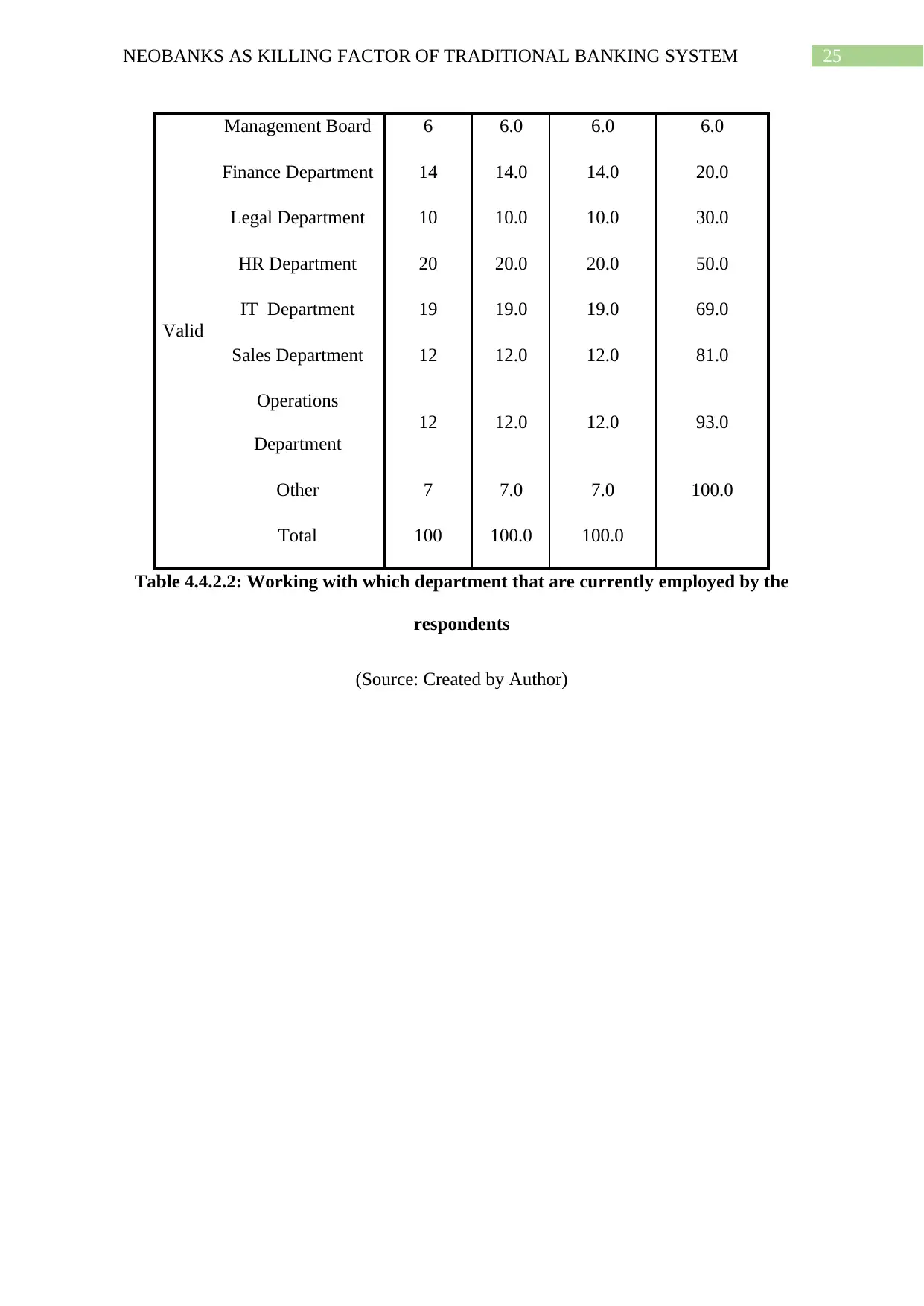
25NEOBANKS AS KILLING FACTOR OF TRADITIONAL BANKING SYSTEM
Valid
Management Board 6 6.0 6.0 6.0
Finance Department 14 14.0 14.0 20.0
Legal Department 10 10.0 10.0 30.0
HR Department 20 20.0 20.0 50.0
IT Department 19 19.0 19.0 69.0
Sales Department 12 12.0 12.0 81.0
Operations
Department
12 12.0 12.0 93.0
Other 7 7.0 7.0 100.0
Total 100 100.0 100.0
Table 4.4.2.2: Working with which department that are currently employed by the
respondents
(Source: Created by Author)
Valid
Management Board 6 6.0 6.0 6.0
Finance Department 14 14.0 14.0 20.0
Legal Department 10 10.0 10.0 30.0
HR Department 20 20.0 20.0 50.0
IT Department 19 19.0 19.0 69.0
Sales Department 12 12.0 12.0 81.0
Operations
Department
12 12.0 12.0 93.0
Other 7 7.0 7.0 100.0
Total 100 100.0 100.0
Table 4.4.2.2: Working with which department that are currently employed by the
respondents
(Source: Created by Author)
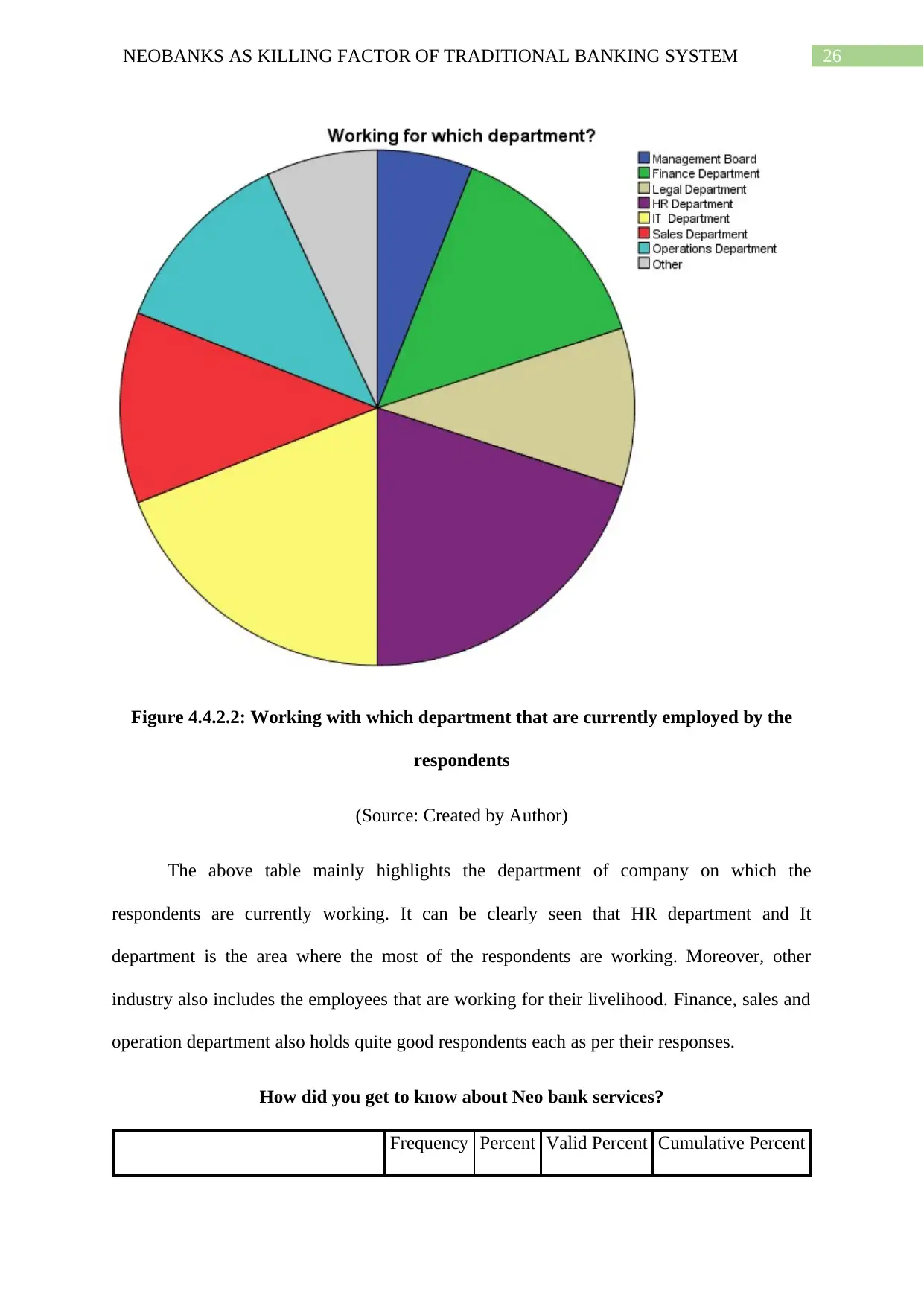
26NEOBANKS AS KILLING FACTOR OF TRADITIONAL BANKING SYSTEM
Figure 4.4.2.2: Working with which department that are currently employed by the
respondents
(Source: Created by Author)
The above table mainly highlights the department of company on which the
respondents are currently working. It can be clearly seen that HR department and It
department is the area where the most of the respondents are working. Moreover, other
industry also includes the employees that are working for their livelihood. Finance, sales and
operation department also holds quite good respondents each as per their responses.
How did you get to know about Neo bank services?
Frequency Percent Valid Percent Cumulative Percent
Figure 4.4.2.2: Working with which department that are currently employed by the
respondents
(Source: Created by Author)
The above table mainly highlights the department of company on which the
respondents are currently working. It can be clearly seen that HR department and It
department is the area where the most of the respondents are working. Moreover, other
industry also includes the employees that are working for their livelihood. Finance, sales and
operation department also holds quite good respondents each as per their responses.
How did you get to know about Neo bank services?
Frequency Percent Valid Percent Cumulative Percent
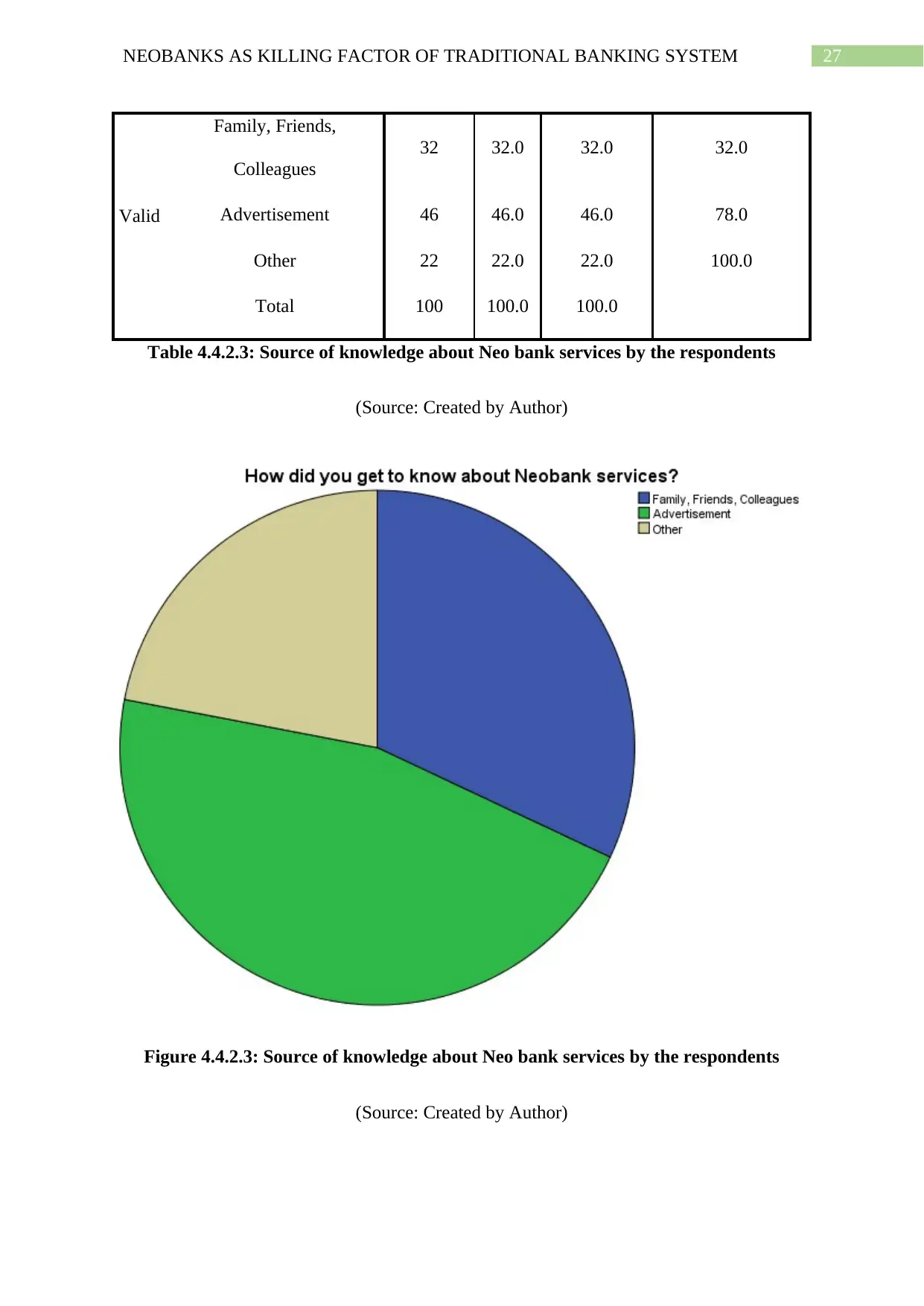
27NEOBANKS AS KILLING FACTOR OF TRADITIONAL BANKING SYSTEM
Valid
Family, Friends,
Colleagues
32 32.0 32.0 32.0
Advertisement 46 46.0 46.0 78.0
Other 22 22.0 22.0 100.0
Total 100 100.0 100.0
Table 4.4.2.3: Source of knowledge about Neo bank services by the respondents
(Source: Created by Author)
Figure 4.4.2.3: Source of knowledge about Neo bank services by the respondents
(Source: Created by Author)
Valid
Family, Friends,
Colleagues
32 32.0 32.0 32.0
Advertisement 46 46.0 46.0 78.0
Other 22 22.0 22.0 100.0
Total 100 100.0 100.0
Table 4.4.2.3: Source of knowledge about Neo bank services by the respondents
(Source: Created by Author)
Figure 4.4.2.3: Source of knowledge about Neo bank services by the respondents
(Source: Created by Author)
Secure Best Marks with AI Grader
Need help grading? Try our AI Grader for instant feedback on your assignments.
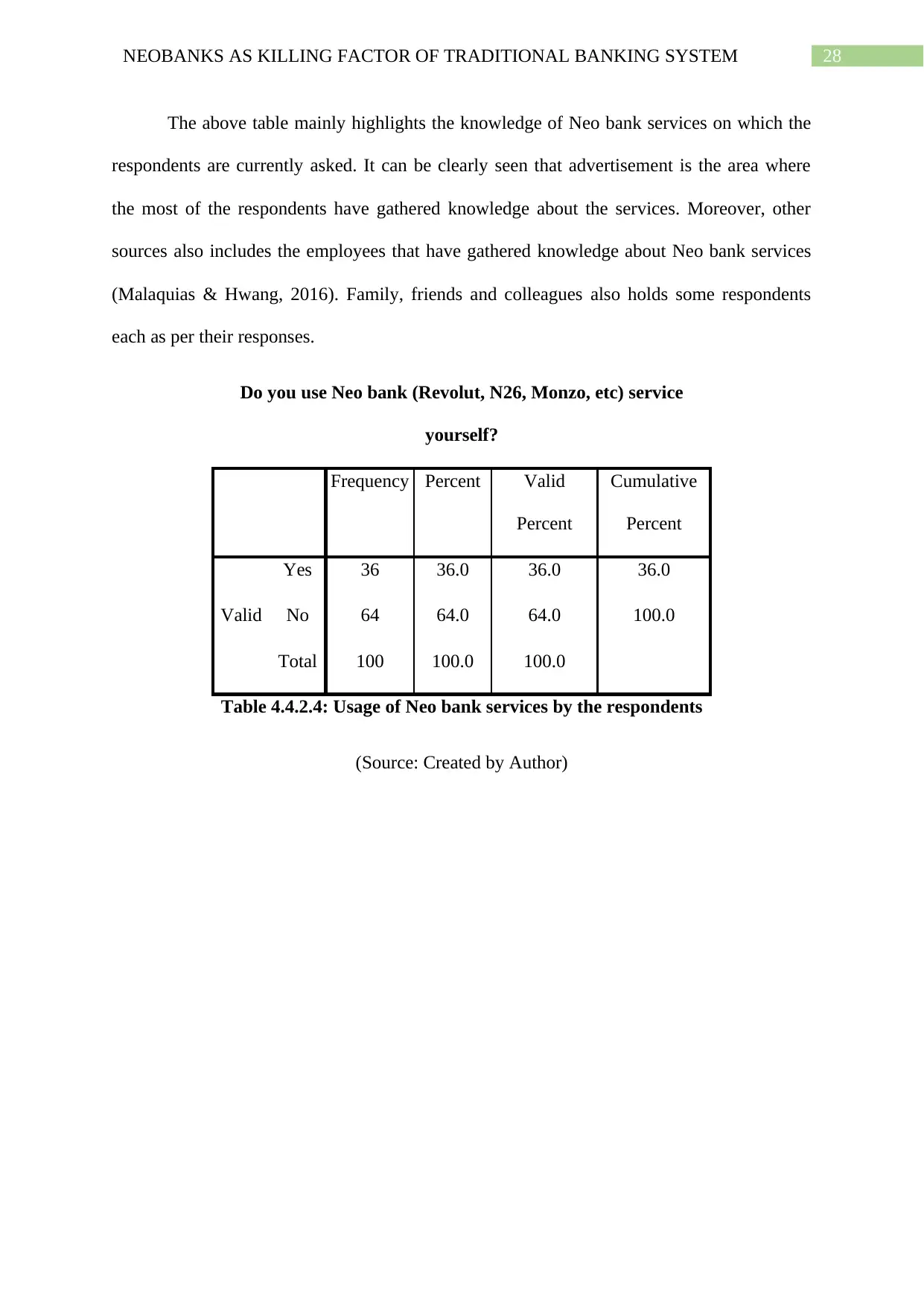
28NEOBANKS AS KILLING FACTOR OF TRADITIONAL BANKING SYSTEM
The above table mainly highlights the knowledge of Neo bank services on which the
respondents are currently asked. It can be clearly seen that advertisement is the area where
the most of the respondents have gathered knowledge about the services. Moreover, other
sources also includes the employees that have gathered knowledge about Neo bank services
(Malaquias & Hwang, 2016). Family, friends and colleagues also holds some respondents
each as per their responses.
Do you use Neo bank (Revolut, N26, Monzo, etc) service
yourself?
Frequency Percent Valid
Percent
Cumulative
Percent
Valid
Yes 36 36.0 36.0 36.0
No 64 64.0 64.0 100.0
Total 100 100.0 100.0
Table 4.4.2.4: Usage of Neo bank services by the respondents
(Source: Created by Author)
The above table mainly highlights the knowledge of Neo bank services on which the
respondents are currently asked. It can be clearly seen that advertisement is the area where
the most of the respondents have gathered knowledge about the services. Moreover, other
sources also includes the employees that have gathered knowledge about Neo bank services
(Malaquias & Hwang, 2016). Family, friends and colleagues also holds some respondents
each as per their responses.
Do you use Neo bank (Revolut, N26, Monzo, etc) service
yourself?
Frequency Percent Valid
Percent
Cumulative
Percent
Valid
Yes 36 36.0 36.0 36.0
No 64 64.0 64.0 100.0
Total 100 100.0 100.0
Table 4.4.2.4: Usage of Neo bank services by the respondents
(Source: Created by Author)

29NEOBANKS AS KILLING FACTOR OF TRADITIONAL BANKING SYSTEM
Figure 4.4.2.4: Usage of Neo bank services by the respondents
(Source: Created by Author)
The above table mainly highlights the usage of Neo bank services on which the
respondents are currently asked. It can be clearly seen that negative answers is the most of the
respondents have used about the services. Moreover, positive answers also includes the
respondents that have used Neo bank services.
What Neo bank do you use?
Frequency Percent Valid
Percent
Cumulative
Percent
Valid Revoult 15 15.0 15.0 15.0
Figure 4.4.2.4: Usage of Neo bank services by the respondents
(Source: Created by Author)
The above table mainly highlights the usage of Neo bank services on which the
respondents are currently asked. It can be clearly seen that negative answers is the most of the
respondents have used about the services. Moreover, positive answers also includes the
respondents that have used Neo bank services.
What Neo bank do you use?
Frequency Percent Valid
Percent
Cumulative
Percent
Valid Revoult 15 15.0 15.0 15.0

30NEOBANKS AS KILLING FACTOR OF TRADITIONAL BANKING SYSTEM
N26 12 12.0 12.0 27.0
Monzo 12 12.0 12.0 39.0
Tinkoff 18 18.0 18.0 57.0
Bung 24 24.0 24.0 81.0
Other 19 19.0 19.0 100.0
Total 100 100.0 100.0
Table 4.4.2.5: Usage of different Neo bank services by the respondents
(Source: Created by Author)
Figure 4.4.2.5: Usage of different Neo bank services by the respondents
(Source: Created by Author)
N26 12 12.0 12.0 27.0
Monzo 12 12.0 12.0 39.0
Tinkoff 18 18.0 18.0 57.0
Bung 24 24.0 24.0 81.0
Other 19 19.0 19.0 100.0
Total 100 100.0 100.0
Table 4.4.2.5: Usage of different Neo bank services by the respondents
(Source: Created by Author)
Figure 4.4.2.5: Usage of different Neo bank services by the respondents
(Source: Created by Author)
Paraphrase This Document
Need a fresh take? Get an instant paraphrase of this document with our AI Paraphraser
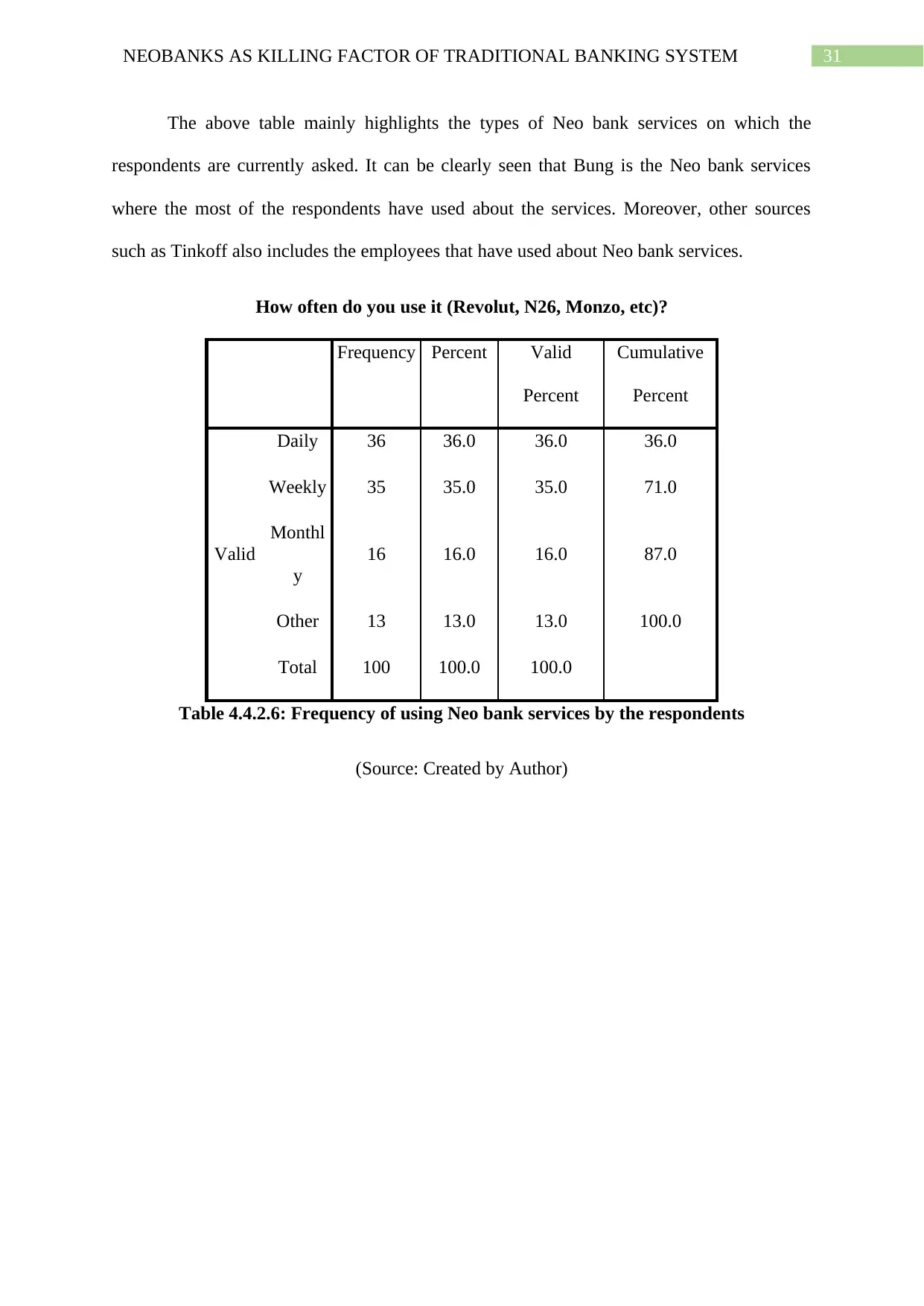
31NEOBANKS AS KILLING FACTOR OF TRADITIONAL BANKING SYSTEM
The above table mainly highlights the types of Neo bank services on which the
respondents are currently asked. It can be clearly seen that Bung is the Neo bank services
where the most of the respondents have used about the services. Moreover, other sources
such as Tinkoff also includes the employees that have used about Neo bank services.
How often do you use it (Revolut, N26, Monzo, etc)?
Frequency Percent Valid
Percent
Cumulative
Percent
Valid
Daily 36 36.0 36.0 36.0
Weekly 35 35.0 35.0 71.0
Monthl
y
16 16.0 16.0 87.0
Other 13 13.0 13.0 100.0
Total 100 100.0 100.0
Table 4.4.2.6: Frequency of using Neo bank services by the respondents
(Source: Created by Author)
The above table mainly highlights the types of Neo bank services on which the
respondents are currently asked. It can be clearly seen that Bung is the Neo bank services
where the most of the respondents have used about the services. Moreover, other sources
such as Tinkoff also includes the employees that have used about Neo bank services.
How often do you use it (Revolut, N26, Monzo, etc)?
Frequency Percent Valid
Percent
Cumulative
Percent
Valid
Daily 36 36.0 36.0 36.0
Weekly 35 35.0 35.0 71.0
Monthl
y
16 16.0 16.0 87.0
Other 13 13.0 13.0 100.0
Total 100 100.0 100.0
Table 4.4.2.6: Frequency of using Neo bank services by the respondents
(Source: Created by Author)
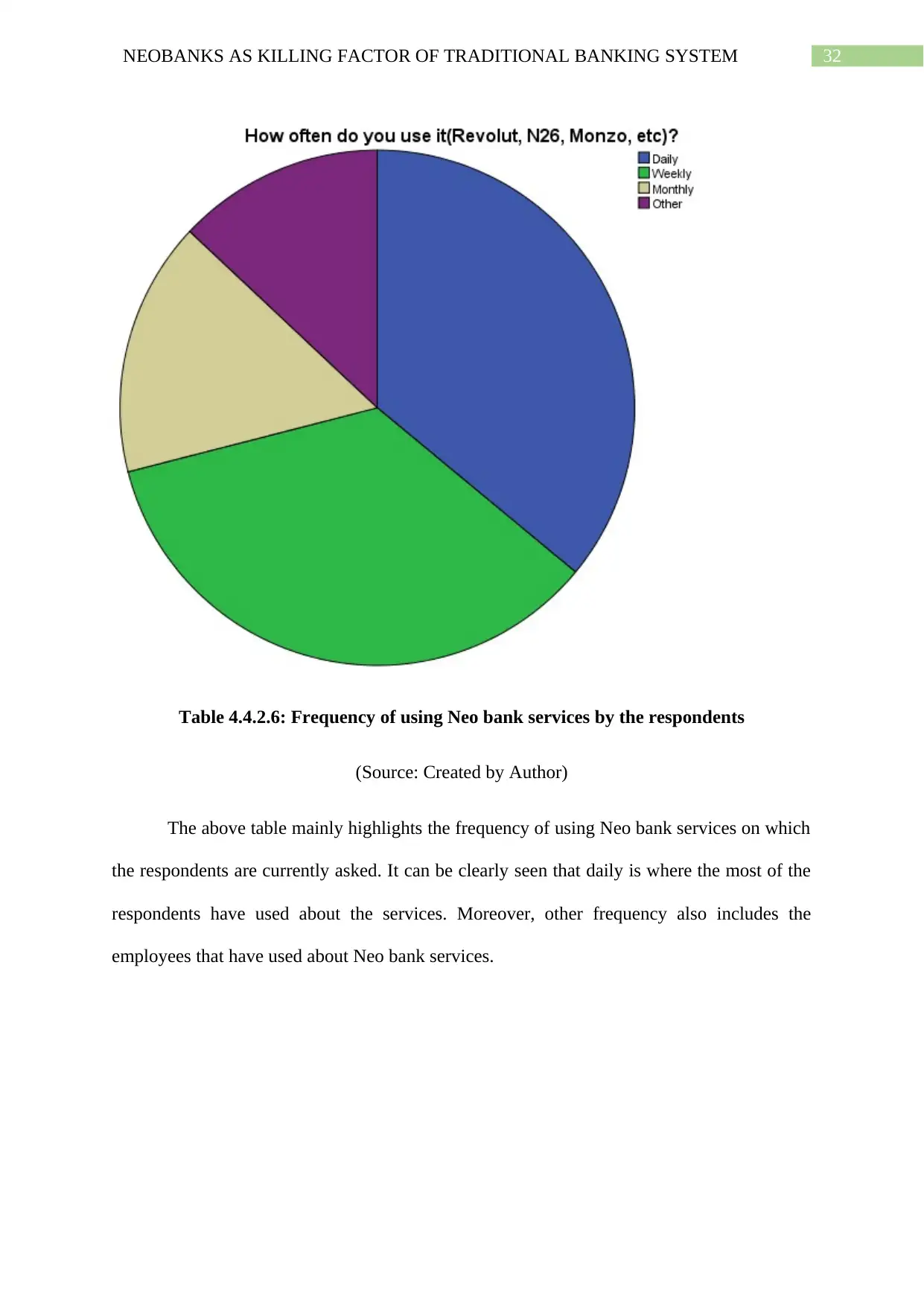
32NEOBANKS AS KILLING FACTOR OF TRADITIONAL BANKING SYSTEM
Table 4.4.2.6: Frequency of using Neo bank services by the respondents
(Source: Created by Author)
The above table mainly highlights the frequency of using Neo bank services on which
the respondents are currently asked. It can be clearly seen that daily is where the most of the
respondents have used about the services. Moreover, other frequency also includes the
employees that have used about Neo bank services.
Table 4.4.2.6: Frequency of using Neo bank services by the respondents
(Source: Created by Author)
The above table mainly highlights the frequency of using Neo bank services on which
the respondents are currently asked. It can be clearly seen that daily is where the most of the
respondents have used about the services. Moreover, other frequency also includes the
employees that have used about Neo bank services.

33NEOBANKS AS KILLING FACTOR OF TRADITIONAL BANKING SYSTEM
Chapter 5. Analysis and Conclusion
5.1 Hypothesis Testing
The hypothesis which needs to be tested which answers the research question of the
research study. The hypothesis is presented below:
Null Hypothesis, H0: Trend of Neo banks has not yet influenced the performance of
traditional banking system
Alternative Hypothesis, H1: Neo Banks have been integrated with digitalization providing
more convenience to people and support to money preservation.
The above research hypothesis is developed in order to find the statistical evidences
that leads to the conclusion of whether the trend of Neo banks has influenced the
performance of traditional banking system due to the integration with digitalization providing
more convenience to people and support to money preservation. However, to support this
hypothesis a number of tests are performed depending on the nature of the data which are
found to be non-parametric (Dimyati & Subagio, 2018). This means the data is not normally
distributed. In the below section the normality test is performed and presented. The below
table is the summary result of normality tests
Table A: Test of Normality.
Tests of Normality
Kolmogorov-
Smirnova Shapiro-Wilk
Statistic df Sig. Statistic df Sig.
For your banking daily operations What
kind of method is more likely to be used
by you? 0.426 99 0 0.595 99 0
Are you satisfied with your current
traditional online banking service? 0.26 99 0 0.878 99 0
What kind of services is more preferred by
you at the time of offline
banking/application? 0.141 99 0 0.921 99 0
Chapter 5. Analysis and Conclusion
5.1 Hypothesis Testing
The hypothesis which needs to be tested which answers the research question of the
research study. The hypothesis is presented below:
Null Hypothesis, H0: Trend of Neo banks has not yet influenced the performance of
traditional banking system
Alternative Hypothesis, H1: Neo Banks have been integrated with digitalization providing
more convenience to people and support to money preservation.
The above research hypothesis is developed in order to find the statistical evidences
that leads to the conclusion of whether the trend of Neo banks has influenced the
performance of traditional banking system due to the integration with digitalization providing
more convenience to people and support to money preservation. However, to support this
hypothesis a number of tests are performed depending on the nature of the data which are
found to be non-parametric (Dimyati & Subagio, 2018). This means the data is not normally
distributed. In the below section the normality test is performed and presented. The below
table is the summary result of normality tests
Table A: Test of Normality.
Tests of Normality
Kolmogorov-
Smirnova Shapiro-Wilk
Statistic df Sig. Statistic df Sig.
For your banking daily operations What
kind of method is more likely to be used
by you? 0.426 99 0 0.595 99 0
Are you satisfied with your current
traditional online banking service? 0.26 99 0 0.878 99 0
What kind of services is more preferred by
you at the time of offline
banking/application? 0.141 99 0 0.921 99 0
Secure Best Marks with AI Grader
Need help grading? Try our AI Grader for instant feedback on your assignments.
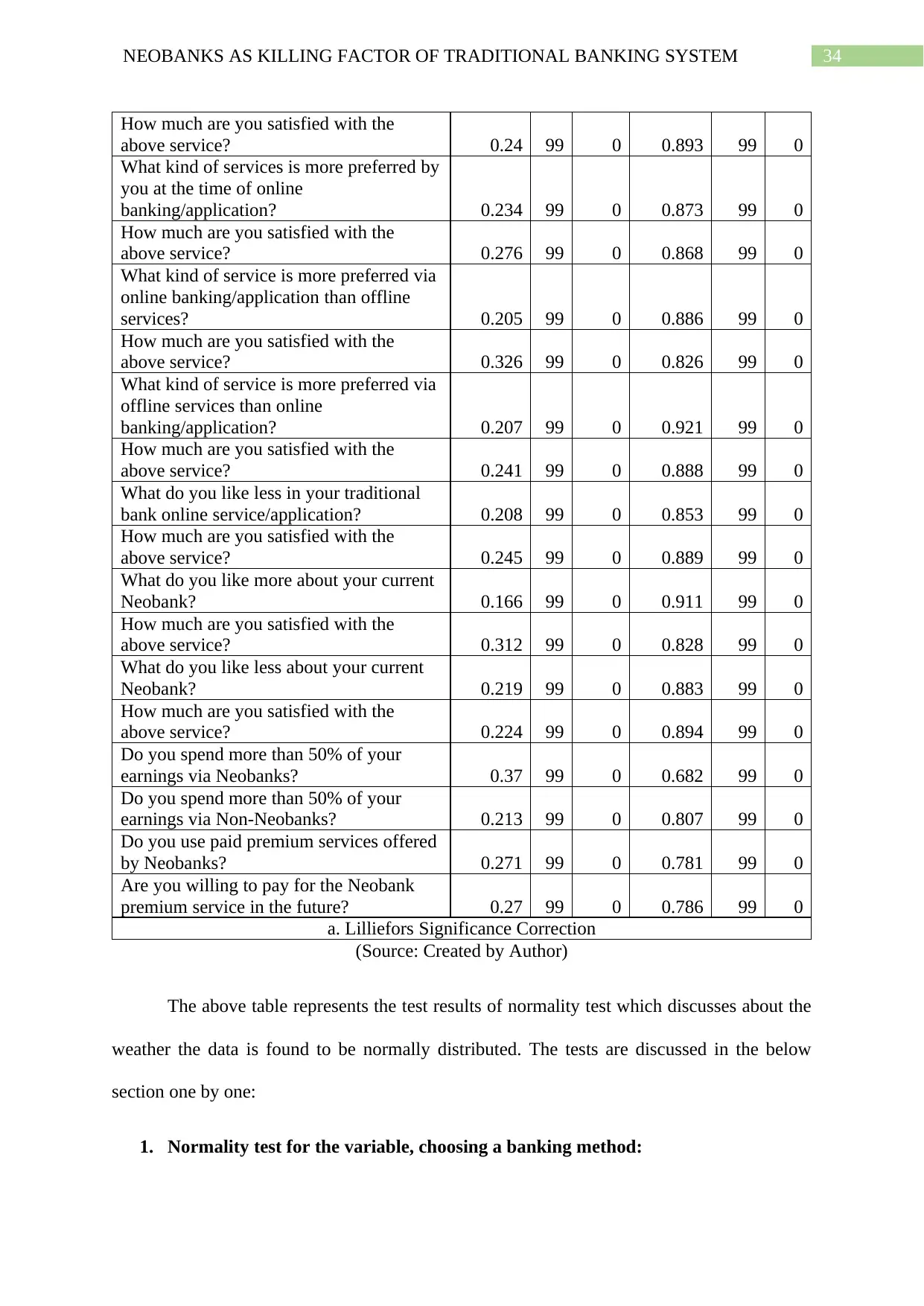
34NEOBANKS AS KILLING FACTOR OF TRADITIONAL BANKING SYSTEM
How much are you satisfied with the
above service? 0.24 99 0 0.893 99 0
What kind of services is more preferred by
you at the time of online
banking/application? 0.234 99 0 0.873 99 0
How much are you satisfied with the
above service? 0.276 99 0 0.868 99 0
What kind of service is more preferred via
online banking/application than offline
services? 0.205 99 0 0.886 99 0
How much are you satisfied with the
above service? 0.326 99 0 0.826 99 0
What kind of service is more preferred via
offline services than online
banking/application? 0.207 99 0 0.921 99 0
How much are you satisfied with the
above service? 0.241 99 0 0.888 99 0
What do you like less in your traditional
bank online service/application? 0.208 99 0 0.853 99 0
How much are you satisfied with the
above service? 0.245 99 0 0.889 99 0
What do you like more about your current
Neobank? 0.166 99 0 0.911 99 0
How much are you satisfied with the
above service? 0.312 99 0 0.828 99 0
What do you like less about your current
Neobank? 0.219 99 0 0.883 99 0
How much are you satisfied with the
above service? 0.224 99 0 0.894 99 0
Do you spend more than 50% of your
earnings via Neobanks? 0.37 99 0 0.682 99 0
Do you spend more than 50% of your
earnings via Non-Neobanks? 0.213 99 0 0.807 99 0
Do you use paid premium services offered
by Neobanks? 0.271 99 0 0.781 99 0
Are you willing to pay for the Neobank
premium service in the future? 0.27 99 0 0.786 99 0
a. Lilliefors Significance Correction
(Source: Created by Author)
The above table represents the test results of normality test which discusses about the
weather the data is found to be normally distributed. The tests are discussed in the below
section one by one:
1. Normality test for the variable, choosing a banking method:
How much are you satisfied with the
above service? 0.24 99 0 0.893 99 0
What kind of services is more preferred by
you at the time of online
banking/application? 0.234 99 0 0.873 99 0
How much are you satisfied with the
above service? 0.276 99 0 0.868 99 0
What kind of service is more preferred via
online banking/application than offline
services? 0.205 99 0 0.886 99 0
How much are you satisfied with the
above service? 0.326 99 0 0.826 99 0
What kind of service is more preferred via
offline services than online
banking/application? 0.207 99 0 0.921 99 0
How much are you satisfied with the
above service? 0.241 99 0 0.888 99 0
What do you like less in your traditional
bank online service/application? 0.208 99 0 0.853 99 0
How much are you satisfied with the
above service? 0.245 99 0 0.889 99 0
What do you like more about your current
Neobank? 0.166 99 0 0.911 99 0
How much are you satisfied with the
above service? 0.312 99 0 0.828 99 0
What do you like less about your current
Neobank? 0.219 99 0 0.883 99 0
How much are you satisfied with the
above service? 0.224 99 0 0.894 99 0
Do you spend more than 50% of your
earnings via Neobanks? 0.37 99 0 0.682 99 0
Do you spend more than 50% of your
earnings via Non-Neobanks? 0.213 99 0 0.807 99 0
Do you use paid premium services offered
by Neobanks? 0.271 99 0 0.781 99 0
Are you willing to pay for the Neobank
premium service in the future? 0.27 99 0 0.786 99 0
a. Lilliefors Significance Correction
(Source: Created by Author)
The above table represents the test results of normality test which discusses about the
weather the data is found to be normally distributed. The tests are discussed in the below
section one by one:
1. Normality test for the variable, choosing a banking method:
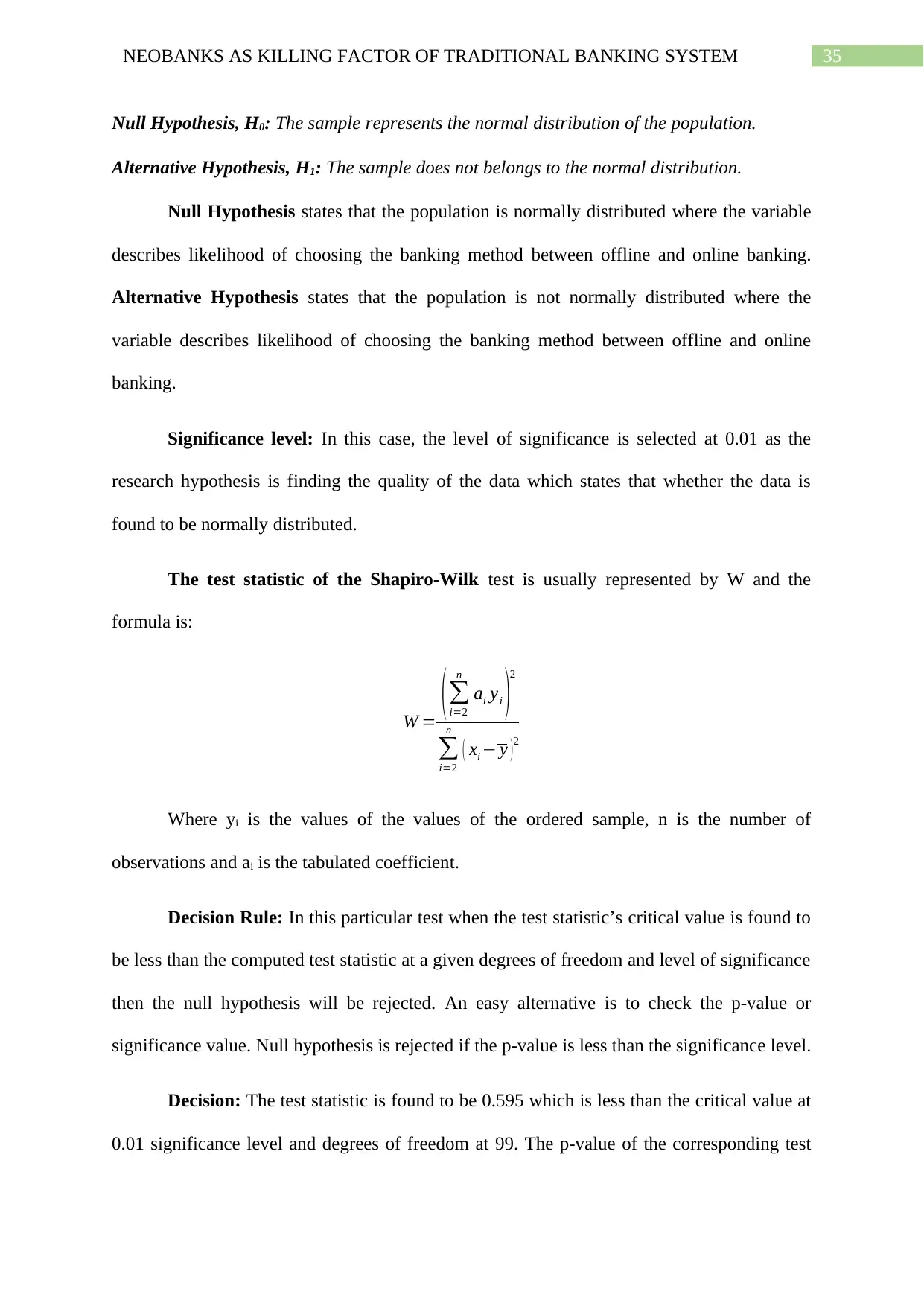
35NEOBANKS AS KILLING FACTOR OF TRADITIONAL BANKING SYSTEM
Null Hypothesis, H0: The sample represents the normal distribution of the population.
Alternative Hypothesis, H1: The sample does not belongs to the normal distribution.
Null Hypothesis states that the population is normally distributed where the variable
describes likelihood of choosing the banking method between offline and online banking.
Alternative Hypothesis states that the population is not normally distributed where the
variable describes likelihood of choosing the banking method between offline and online
banking.
Significance level: In this case, the level of significance is selected at 0.01 as the
research hypothesis is finding the quality of the data which states that whether the data is
found to be normally distributed.
The test statistic of the Shapiro-Wilk test is usually represented by W and the
formula is:
W =
(∑
i=2
n
ai yi )2
∑
i=2
n
( xi − y )2
Where yi is the values of the values of the ordered sample, n is the number of
observations and ai is the tabulated coefficient.
Decision Rule: In this particular test when the test statistic’s critical value is found to
be less than the computed test statistic at a given degrees of freedom and level of significance
then the null hypothesis will be rejected. An easy alternative is to check the p-value or
significance value. Null hypothesis is rejected if the p-value is less than the significance level.
Decision: The test statistic is found to be 0.595 which is less than the critical value at
0.01 significance level and degrees of freedom at 99. The p-value of the corresponding test
Null Hypothesis, H0: The sample represents the normal distribution of the population.
Alternative Hypothesis, H1: The sample does not belongs to the normal distribution.
Null Hypothesis states that the population is normally distributed where the variable
describes likelihood of choosing the banking method between offline and online banking.
Alternative Hypothesis states that the population is not normally distributed where the
variable describes likelihood of choosing the banking method between offline and online
banking.
Significance level: In this case, the level of significance is selected at 0.01 as the
research hypothesis is finding the quality of the data which states that whether the data is
found to be normally distributed.
The test statistic of the Shapiro-Wilk test is usually represented by W and the
formula is:
W =
(∑
i=2
n
ai yi )2
∑
i=2
n
( xi − y )2
Where yi is the values of the values of the ordered sample, n is the number of
observations and ai is the tabulated coefficient.
Decision Rule: In this particular test when the test statistic’s critical value is found to
be less than the computed test statistic at a given degrees of freedom and level of significance
then the null hypothesis will be rejected. An easy alternative is to check the p-value or
significance value. Null hypothesis is rejected if the p-value is less than the significance level.
Decision: The test statistic is found to be 0.595 which is less than the critical value at
0.01 significance level and degrees of freedom at 99. The p-value of the corresponding test
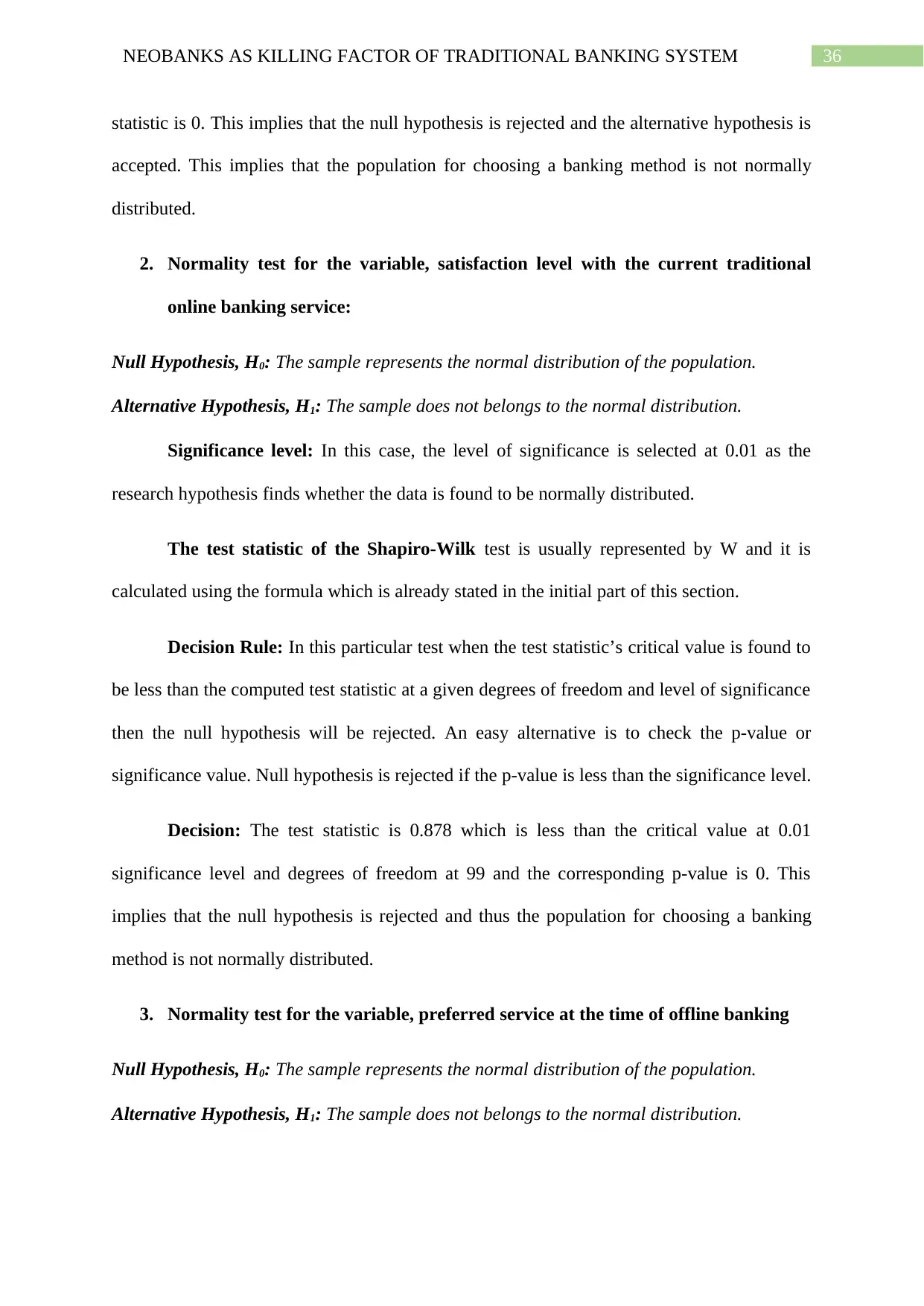
36NEOBANKS AS KILLING FACTOR OF TRADITIONAL BANKING SYSTEM
statistic is 0. This implies that the null hypothesis is rejected and the alternative hypothesis is
accepted. This implies that the population for choosing a banking method is not normally
distributed.
2. Normality test for the variable, satisfaction level with the current traditional
online banking service:
Null Hypothesis, H0: The sample represents the normal distribution of the population.
Alternative Hypothesis, H1: The sample does not belongs to the normal distribution.
Significance level: In this case, the level of significance is selected at 0.01 as the
research hypothesis finds whether the data is found to be normally distributed.
The test statistic of the Shapiro-Wilk test is usually represented by W and it is
calculated using the formula which is already stated in the initial part of this section.
Decision Rule: In this particular test when the test statistic’s critical value is found to
be less than the computed test statistic at a given degrees of freedom and level of significance
then the null hypothesis will be rejected. An easy alternative is to check the p-value or
significance value. Null hypothesis is rejected if the p-value is less than the significance level.
Decision: The test statistic is 0.878 which is less than the critical value at 0.01
significance level and degrees of freedom at 99 and the corresponding p-value is 0. This
implies that the null hypothesis is rejected and thus the population for choosing a banking
method is not normally distributed.
3. Normality test for the variable, preferred service at the time of offline banking
Null Hypothesis, H0: The sample represents the normal distribution of the population.
Alternative Hypothesis, H1: The sample does not belongs to the normal distribution.
statistic is 0. This implies that the null hypothesis is rejected and the alternative hypothesis is
accepted. This implies that the population for choosing a banking method is not normally
distributed.
2. Normality test for the variable, satisfaction level with the current traditional
online banking service:
Null Hypothesis, H0: The sample represents the normal distribution of the population.
Alternative Hypothesis, H1: The sample does not belongs to the normal distribution.
Significance level: In this case, the level of significance is selected at 0.01 as the
research hypothesis finds whether the data is found to be normally distributed.
The test statistic of the Shapiro-Wilk test is usually represented by W and it is
calculated using the formula which is already stated in the initial part of this section.
Decision Rule: In this particular test when the test statistic’s critical value is found to
be less than the computed test statistic at a given degrees of freedom and level of significance
then the null hypothesis will be rejected. An easy alternative is to check the p-value or
significance value. Null hypothesis is rejected if the p-value is less than the significance level.
Decision: The test statistic is 0.878 which is less than the critical value at 0.01
significance level and degrees of freedom at 99 and the corresponding p-value is 0. This
implies that the null hypothesis is rejected and thus the population for choosing a banking
method is not normally distributed.
3. Normality test for the variable, preferred service at the time of offline banking
Null Hypothesis, H0: The sample represents the normal distribution of the population.
Alternative Hypothesis, H1: The sample does not belongs to the normal distribution.
Paraphrase This Document
Need a fresh take? Get an instant paraphrase of this document with our AI Paraphraser
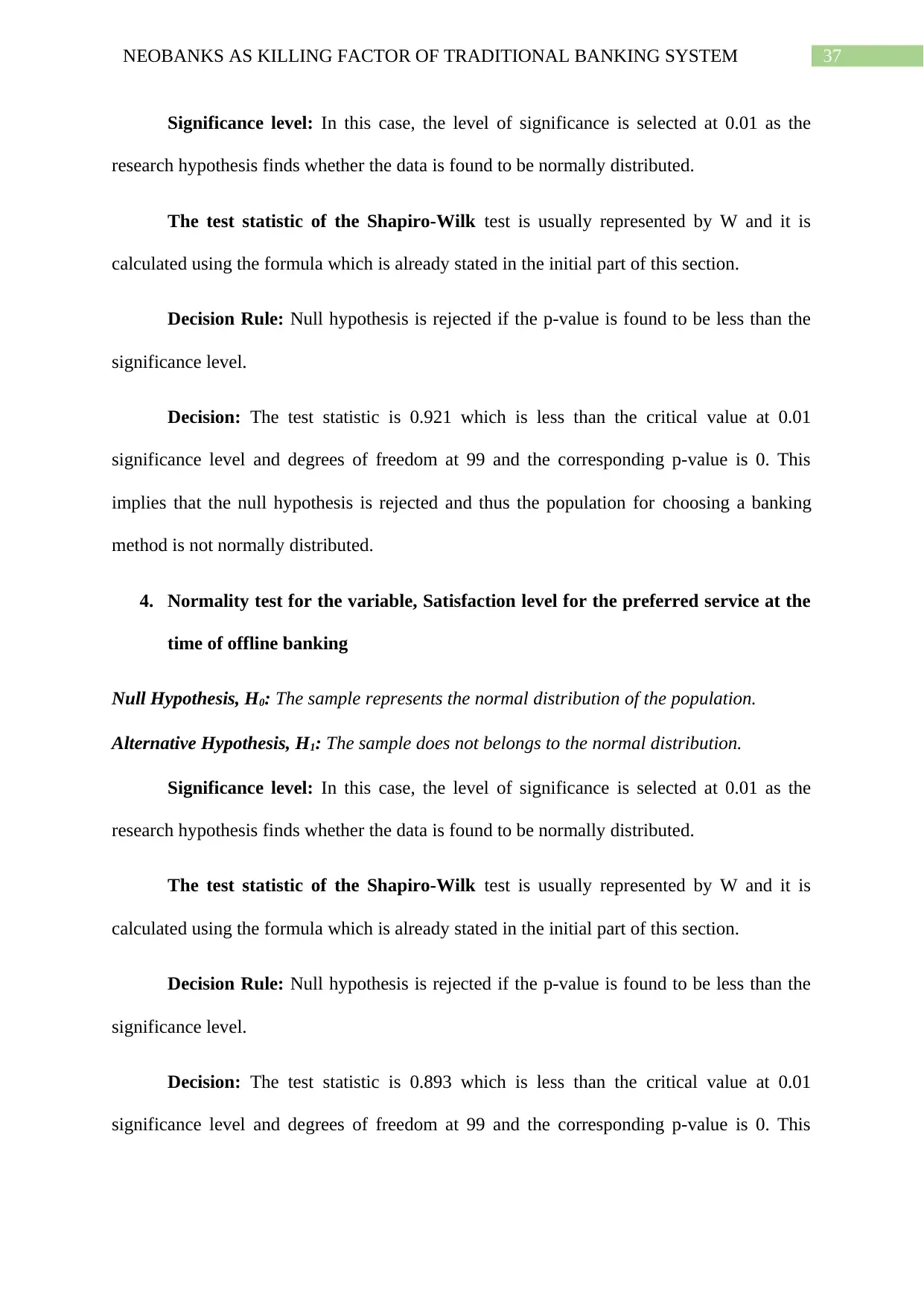
37NEOBANKS AS KILLING FACTOR OF TRADITIONAL BANKING SYSTEM
Significance level: In this case, the level of significance is selected at 0.01 as the
research hypothesis finds whether the data is found to be normally distributed.
The test statistic of the Shapiro-Wilk test is usually represented by W and it is
calculated using the formula which is already stated in the initial part of this section.
Decision Rule: Null hypothesis is rejected if the p-value is found to be less than the
significance level.
Decision: The test statistic is 0.921 which is less than the critical value at 0.01
significance level and degrees of freedom at 99 and the corresponding p-value is 0. This
implies that the null hypothesis is rejected and thus the population for choosing a banking
method is not normally distributed.
4. Normality test for the variable, Satisfaction level for the preferred service at the
time of offline banking
Null Hypothesis, H0: The sample represents the normal distribution of the population.
Alternative Hypothesis, H1: The sample does not belongs to the normal distribution.
Significance level: In this case, the level of significance is selected at 0.01 as the
research hypothesis finds whether the data is found to be normally distributed.
The test statistic of the Shapiro-Wilk test is usually represented by W and it is
calculated using the formula which is already stated in the initial part of this section.
Decision Rule: Null hypothesis is rejected if the p-value is found to be less than the
significance level.
Decision: The test statistic is 0.893 which is less than the critical value at 0.01
significance level and degrees of freedom at 99 and the corresponding p-value is 0. This
Significance level: In this case, the level of significance is selected at 0.01 as the
research hypothesis finds whether the data is found to be normally distributed.
The test statistic of the Shapiro-Wilk test is usually represented by W and it is
calculated using the formula which is already stated in the initial part of this section.
Decision Rule: Null hypothesis is rejected if the p-value is found to be less than the
significance level.
Decision: The test statistic is 0.921 which is less than the critical value at 0.01
significance level and degrees of freedom at 99 and the corresponding p-value is 0. This
implies that the null hypothesis is rejected and thus the population for choosing a banking
method is not normally distributed.
4. Normality test for the variable, Satisfaction level for the preferred service at the
time of offline banking
Null Hypothesis, H0: The sample represents the normal distribution of the population.
Alternative Hypothesis, H1: The sample does not belongs to the normal distribution.
Significance level: In this case, the level of significance is selected at 0.01 as the
research hypothesis finds whether the data is found to be normally distributed.
The test statistic of the Shapiro-Wilk test is usually represented by W and it is
calculated using the formula which is already stated in the initial part of this section.
Decision Rule: Null hypothesis is rejected if the p-value is found to be less than the
significance level.
Decision: The test statistic is 0.893 which is less than the critical value at 0.01
significance level and degrees of freedom at 99 and the corresponding p-value is 0. This
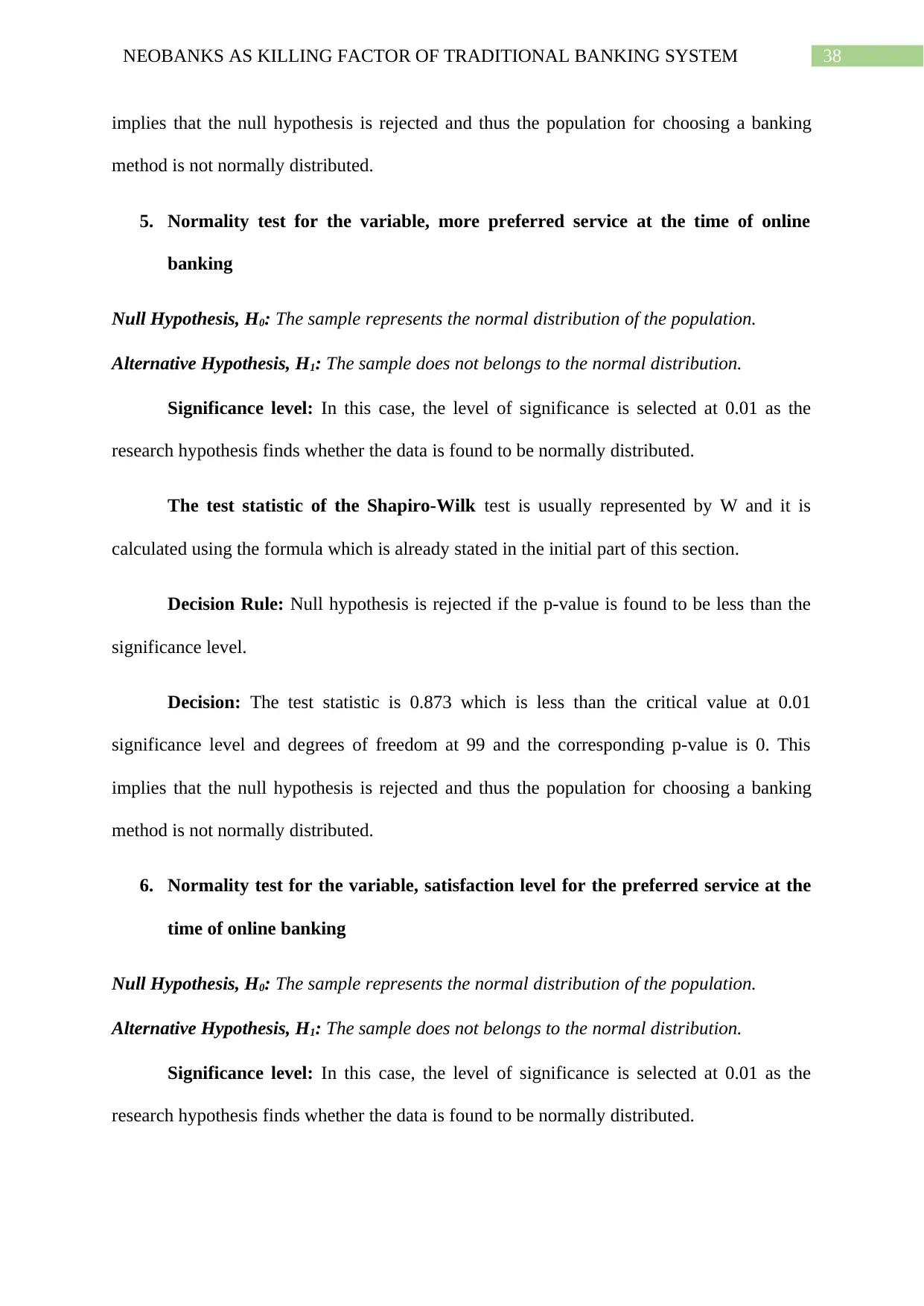
38NEOBANKS AS KILLING FACTOR OF TRADITIONAL BANKING SYSTEM
implies that the null hypothesis is rejected and thus the population for choosing a banking
method is not normally distributed.
5. Normality test for the variable, more preferred service at the time of online
banking
Null Hypothesis, H0: The sample represents the normal distribution of the population.
Alternative Hypothesis, H1: The sample does not belongs to the normal distribution.
Significance level: In this case, the level of significance is selected at 0.01 as the
research hypothesis finds whether the data is found to be normally distributed.
The test statistic of the Shapiro-Wilk test is usually represented by W and it is
calculated using the formula which is already stated in the initial part of this section.
Decision Rule: Null hypothesis is rejected if the p-value is found to be less than the
significance level.
Decision: The test statistic is 0.873 which is less than the critical value at 0.01
significance level and degrees of freedom at 99 and the corresponding p-value is 0. This
implies that the null hypothesis is rejected and thus the population for choosing a banking
method is not normally distributed.
6. Normality test for the variable, satisfaction level for the preferred service at the
time of online banking
Null Hypothesis, H0: The sample represents the normal distribution of the population.
Alternative Hypothesis, H1: The sample does not belongs to the normal distribution.
Significance level: In this case, the level of significance is selected at 0.01 as the
research hypothesis finds whether the data is found to be normally distributed.
implies that the null hypothesis is rejected and thus the population for choosing a banking
method is not normally distributed.
5. Normality test for the variable, more preferred service at the time of online
banking
Null Hypothesis, H0: The sample represents the normal distribution of the population.
Alternative Hypothesis, H1: The sample does not belongs to the normal distribution.
Significance level: In this case, the level of significance is selected at 0.01 as the
research hypothesis finds whether the data is found to be normally distributed.
The test statistic of the Shapiro-Wilk test is usually represented by W and it is
calculated using the formula which is already stated in the initial part of this section.
Decision Rule: Null hypothesis is rejected if the p-value is found to be less than the
significance level.
Decision: The test statistic is 0.873 which is less than the critical value at 0.01
significance level and degrees of freedom at 99 and the corresponding p-value is 0. This
implies that the null hypothesis is rejected and thus the population for choosing a banking
method is not normally distributed.
6. Normality test for the variable, satisfaction level for the preferred service at the
time of online banking
Null Hypothesis, H0: The sample represents the normal distribution of the population.
Alternative Hypothesis, H1: The sample does not belongs to the normal distribution.
Significance level: In this case, the level of significance is selected at 0.01 as the
research hypothesis finds whether the data is found to be normally distributed.
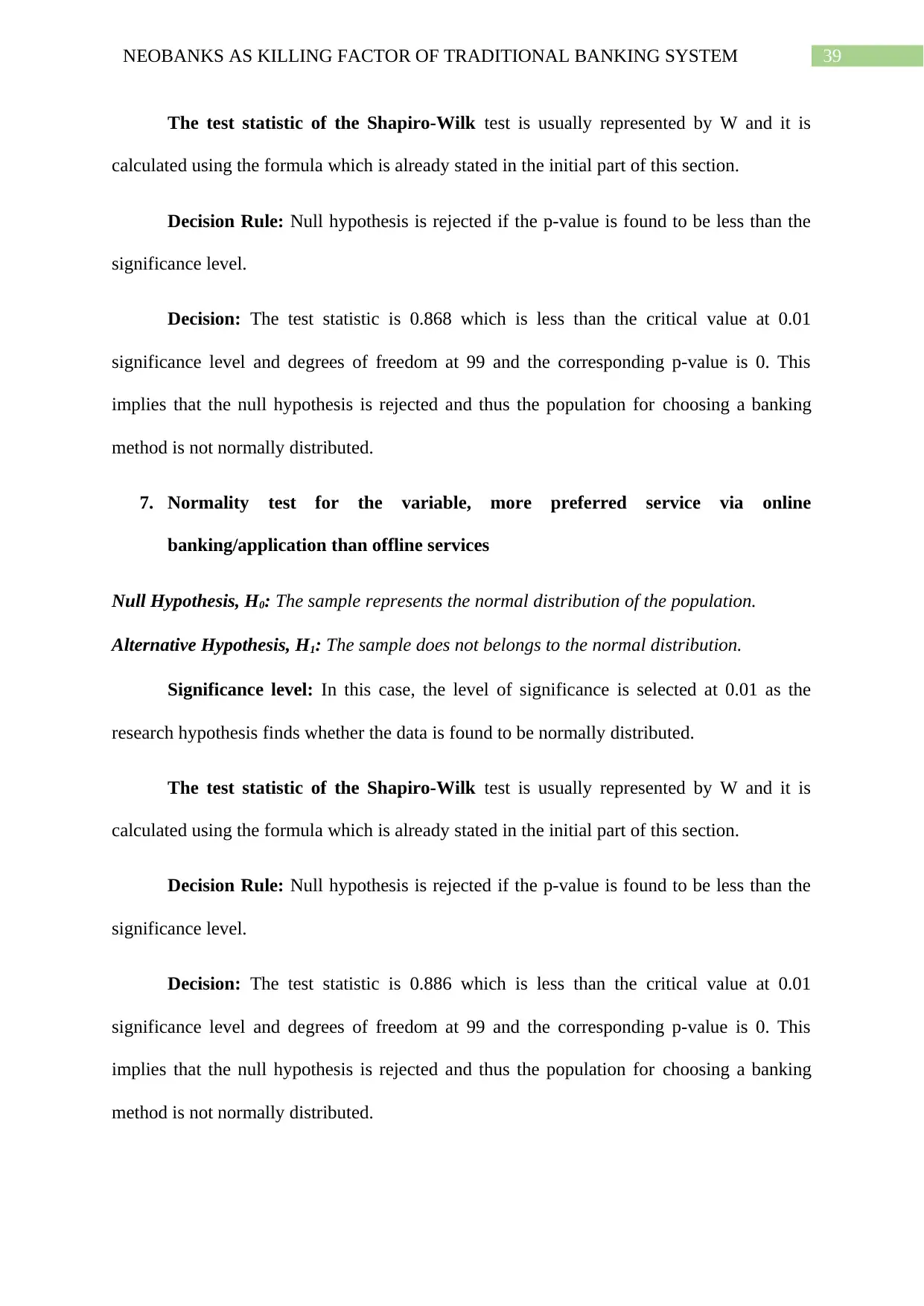
39NEOBANKS AS KILLING FACTOR OF TRADITIONAL BANKING SYSTEM
The test statistic of the Shapiro-Wilk test is usually represented by W and it is
calculated using the formula which is already stated in the initial part of this section.
Decision Rule: Null hypothesis is rejected if the p-value is found to be less than the
significance level.
Decision: The test statistic is 0.868 which is less than the critical value at 0.01
significance level and degrees of freedom at 99 and the corresponding p-value is 0. This
implies that the null hypothesis is rejected and thus the population for choosing a banking
method is not normally distributed.
7. Normality test for the variable, more preferred service via online
banking/application than offline services
Null Hypothesis, H0: The sample represents the normal distribution of the population.
Alternative Hypothesis, H1: The sample does not belongs to the normal distribution.
Significance level: In this case, the level of significance is selected at 0.01 as the
research hypothesis finds whether the data is found to be normally distributed.
The test statistic of the Shapiro-Wilk test is usually represented by W and it is
calculated using the formula which is already stated in the initial part of this section.
Decision Rule: Null hypothesis is rejected if the p-value is found to be less than the
significance level.
Decision: The test statistic is 0.886 which is less than the critical value at 0.01
significance level and degrees of freedom at 99 and the corresponding p-value is 0. This
implies that the null hypothesis is rejected and thus the population for choosing a banking
method is not normally distributed.
The test statistic of the Shapiro-Wilk test is usually represented by W and it is
calculated using the formula which is already stated in the initial part of this section.
Decision Rule: Null hypothesis is rejected if the p-value is found to be less than the
significance level.
Decision: The test statistic is 0.868 which is less than the critical value at 0.01
significance level and degrees of freedom at 99 and the corresponding p-value is 0. This
implies that the null hypothesis is rejected and thus the population for choosing a banking
method is not normally distributed.
7. Normality test for the variable, more preferred service via online
banking/application than offline services
Null Hypothesis, H0: The sample represents the normal distribution of the population.
Alternative Hypothesis, H1: The sample does not belongs to the normal distribution.
Significance level: In this case, the level of significance is selected at 0.01 as the
research hypothesis finds whether the data is found to be normally distributed.
The test statistic of the Shapiro-Wilk test is usually represented by W and it is
calculated using the formula which is already stated in the initial part of this section.
Decision Rule: Null hypothesis is rejected if the p-value is found to be less than the
significance level.
Decision: The test statistic is 0.886 which is less than the critical value at 0.01
significance level and degrees of freedom at 99 and the corresponding p-value is 0. This
implies that the null hypothesis is rejected and thus the population for choosing a banking
method is not normally distributed.
Secure Best Marks with AI Grader
Need help grading? Try our AI Grader for instant feedback on your assignments.
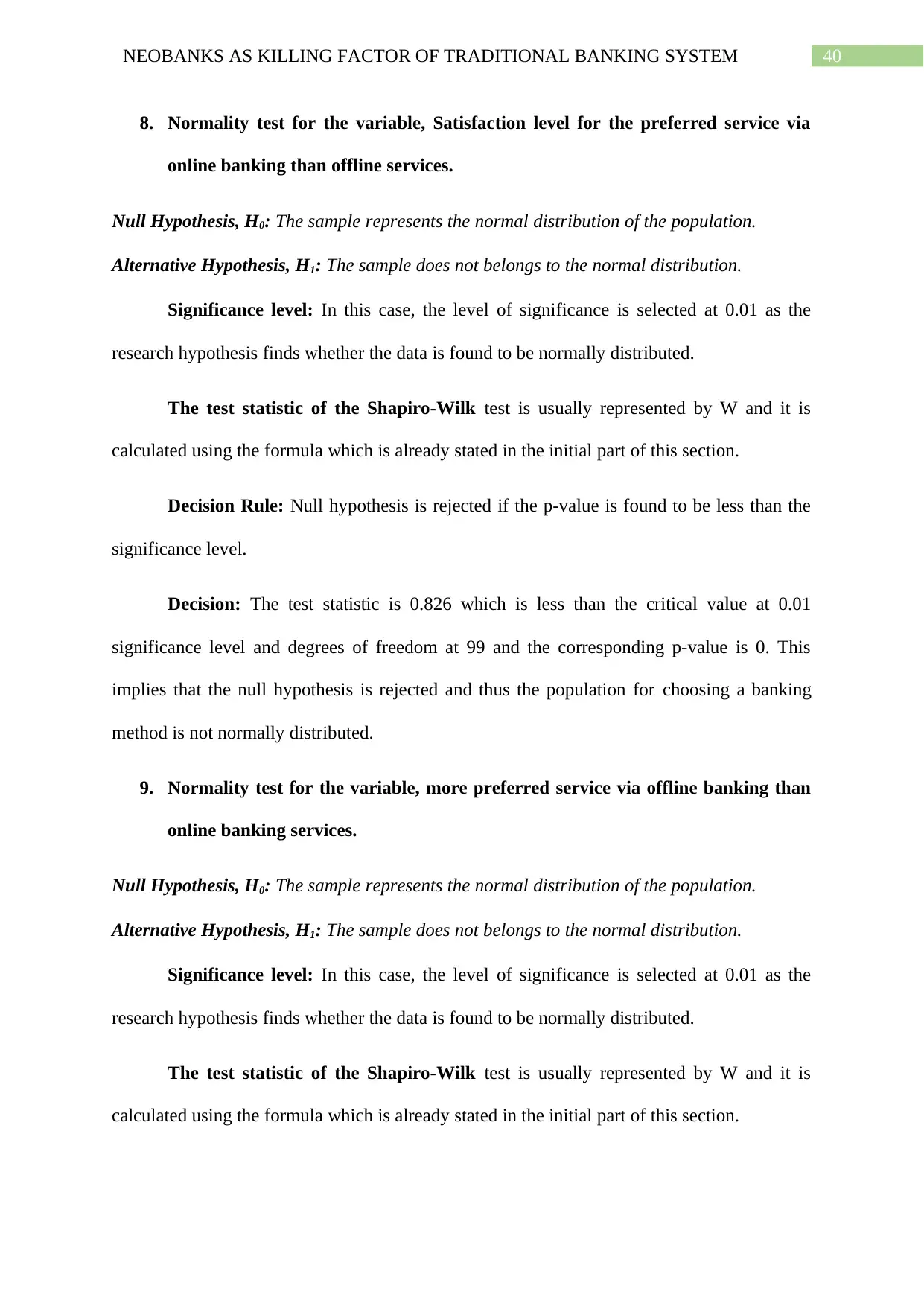
40NEOBANKS AS KILLING FACTOR OF TRADITIONAL BANKING SYSTEM
8. Normality test for the variable, Satisfaction level for the preferred service via
online banking than offline services.
Null Hypothesis, H0: The sample represents the normal distribution of the population.
Alternative Hypothesis, H1: The sample does not belongs to the normal distribution.
Significance level: In this case, the level of significance is selected at 0.01 as the
research hypothesis finds whether the data is found to be normally distributed.
The test statistic of the Shapiro-Wilk test is usually represented by W and it is
calculated using the formula which is already stated in the initial part of this section.
Decision Rule: Null hypothesis is rejected if the p-value is found to be less than the
significance level.
Decision: The test statistic is 0.826 which is less than the critical value at 0.01
significance level and degrees of freedom at 99 and the corresponding p-value is 0. This
implies that the null hypothesis is rejected and thus the population for choosing a banking
method is not normally distributed.
9. Normality test for the variable, more preferred service via offline banking than
online banking services.
Null Hypothesis, H0: The sample represents the normal distribution of the population.
Alternative Hypothesis, H1: The sample does not belongs to the normal distribution.
Significance level: In this case, the level of significance is selected at 0.01 as the
research hypothesis finds whether the data is found to be normally distributed.
The test statistic of the Shapiro-Wilk test is usually represented by W and it is
calculated using the formula which is already stated in the initial part of this section.
8. Normality test for the variable, Satisfaction level for the preferred service via
online banking than offline services.
Null Hypothesis, H0: The sample represents the normal distribution of the population.
Alternative Hypothesis, H1: The sample does not belongs to the normal distribution.
Significance level: In this case, the level of significance is selected at 0.01 as the
research hypothesis finds whether the data is found to be normally distributed.
The test statistic of the Shapiro-Wilk test is usually represented by W and it is
calculated using the formula which is already stated in the initial part of this section.
Decision Rule: Null hypothesis is rejected if the p-value is found to be less than the
significance level.
Decision: The test statistic is 0.826 which is less than the critical value at 0.01
significance level and degrees of freedom at 99 and the corresponding p-value is 0. This
implies that the null hypothesis is rejected and thus the population for choosing a banking
method is not normally distributed.
9. Normality test for the variable, more preferred service via offline banking than
online banking services.
Null Hypothesis, H0: The sample represents the normal distribution of the population.
Alternative Hypothesis, H1: The sample does not belongs to the normal distribution.
Significance level: In this case, the level of significance is selected at 0.01 as the
research hypothesis finds whether the data is found to be normally distributed.
The test statistic of the Shapiro-Wilk test is usually represented by W and it is
calculated using the formula which is already stated in the initial part of this section.
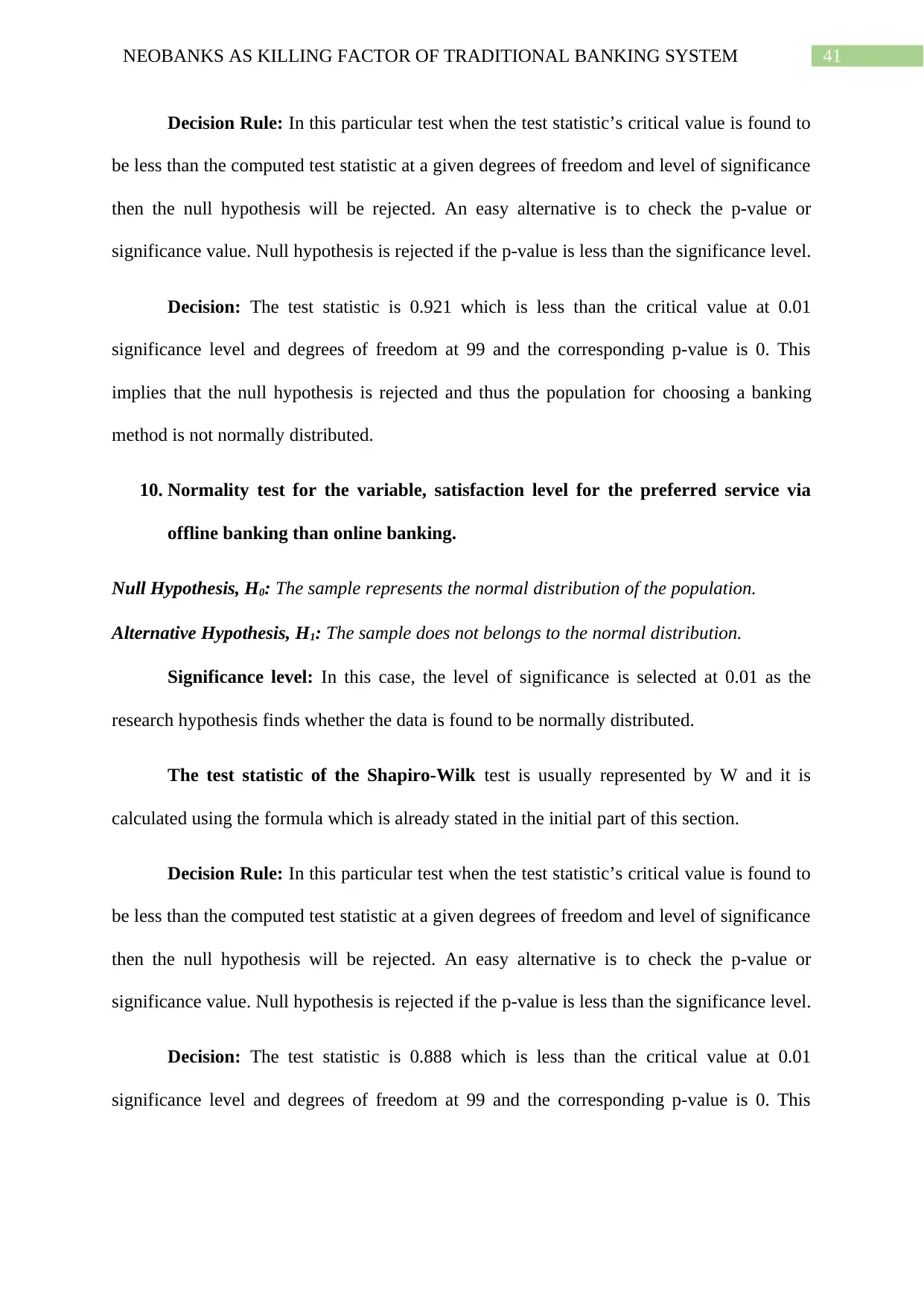
41NEOBANKS AS KILLING FACTOR OF TRADITIONAL BANKING SYSTEM
Decision Rule: In this particular test when the test statistic’s critical value is found to
be less than the computed test statistic at a given degrees of freedom and level of significance
then the null hypothesis will be rejected. An easy alternative is to check the p-value or
significance value. Null hypothesis is rejected if the p-value is less than the significance level.
Decision: The test statistic is 0.921 which is less than the critical value at 0.01
significance level and degrees of freedom at 99 and the corresponding p-value is 0. This
implies that the null hypothesis is rejected and thus the population for choosing a banking
method is not normally distributed.
10. Normality test for the variable, satisfaction level for the preferred service via
offline banking than online banking.
Null Hypothesis, H0: The sample represents the normal distribution of the population.
Alternative Hypothesis, H1: The sample does not belongs to the normal distribution.
Significance level: In this case, the level of significance is selected at 0.01 as the
research hypothesis finds whether the data is found to be normally distributed.
The test statistic of the Shapiro-Wilk test is usually represented by W and it is
calculated using the formula which is already stated in the initial part of this section.
Decision Rule: In this particular test when the test statistic’s critical value is found to
be less than the computed test statistic at a given degrees of freedom and level of significance
then the null hypothesis will be rejected. An easy alternative is to check the p-value or
significance value. Null hypothesis is rejected if the p-value is less than the significance level.
Decision: The test statistic is 0.888 which is less than the critical value at 0.01
significance level and degrees of freedom at 99 and the corresponding p-value is 0. This
Decision Rule: In this particular test when the test statistic’s critical value is found to
be less than the computed test statistic at a given degrees of freedom and level of significance
then the null hypothesis will be rejected. An easy alternative is to check the p-value or
significance value. Null hypothesis is rejected if the p-value is less than the significance level.
Decision: The test statistic is 0.921 which is less than the critical value at 0.01
significance level and degrees of freedom at 99 and the corresponding p-value is 0. This
implies that the null hypothesis is rejected and thus the population for choosing a banking
method is not normally distributed.
10. Normality test for the variable, satisfaction level for the preferred service via
offline banking than online banking.
Null Hypothesis, H0: The sample represents the normal distribution of the population.
Alternative Hypothesis, H1: The sample does not belongs to the normal distribution.
Significance level: In this case, the level of significance is selected at 0.01 as the
research hypothesis finds whether the data is found to be normally distributed.
The test statistic of the Shapiro-Wilk test is usually represented by W and it is
calculated using the formula which is already stated in the initial part of this section.
Decision Rule: In this particular test when the test statistic’s critical value is found to
be less than the computed test statistic at a given degrees of freedom and level of significance
then the null hypothesis will be rejected. An easy alternative is to check the p-value or
significance value. Null hypothesis is rejected if the p-value is less than the significance level.
Decision: The test statistic is 0.888 which is less than the critical value at 0.01
significance level and degrees of freedom at 99 and the corresponding p-value is 0. This
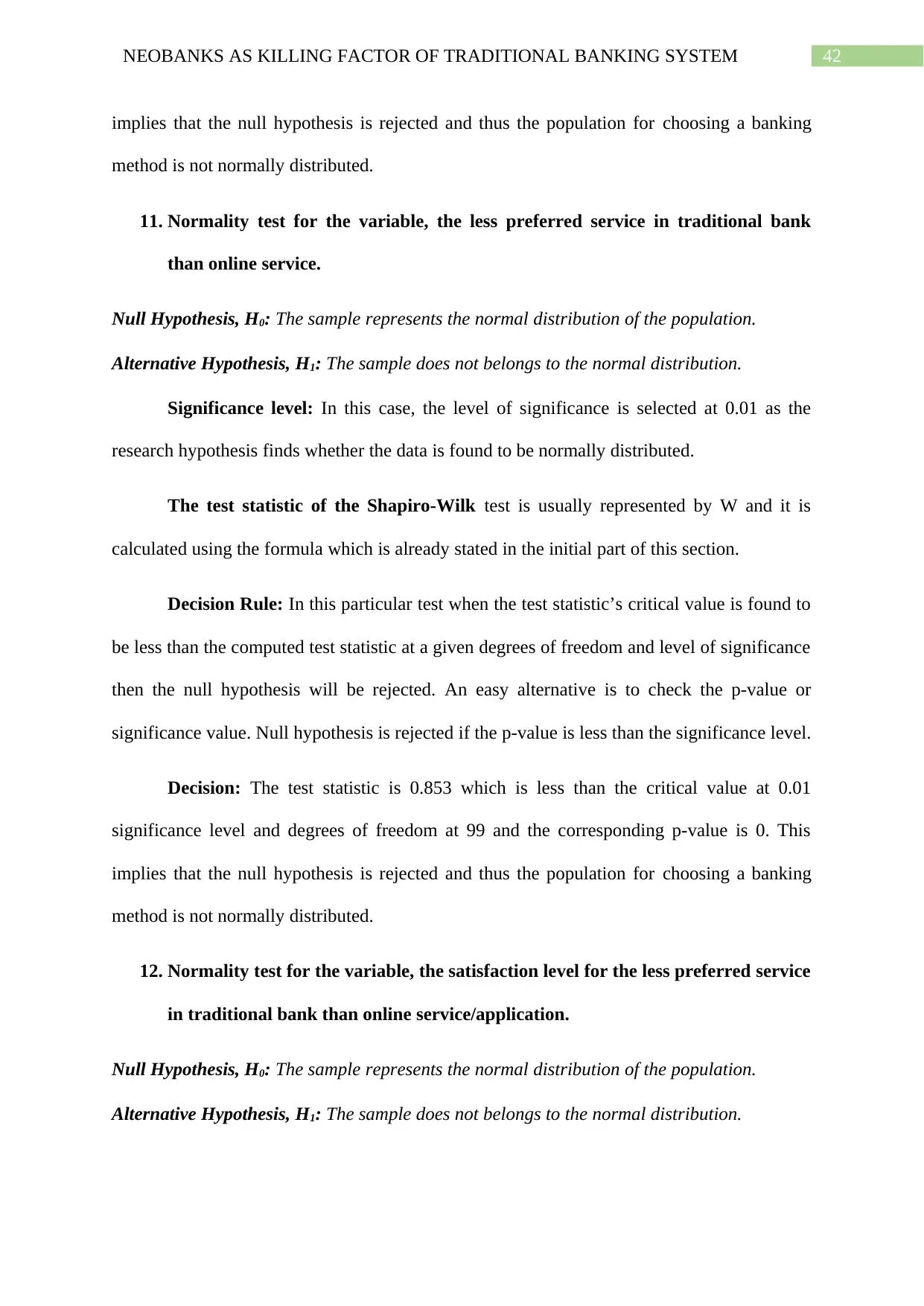
42NEOBANKS AS KILLING FACTOR OF TRADITIONAL BANKING SYSTEM
implies that the null hypothesis is rejected and thus the population for choosing a banking
method is not normally distributed.
11. Normality test for the variable, the less preferred service in traditional bank
than online service.
Null Hypothesis, H0: The sample represents the normal distribution of the population.
Alternative Hypothesis, H1: The sample does not belongs to the normal distribution.
Significance level: In this case, the level of significance is selected at 0.01 as the
research hypothesis finds whether the data is found to be normally distributed.
The test statistic of the Shapiro-Wilk test is usually represented by W and it is
calculated using the formula which is already stated in the initial part of this section.
Decision Rule: In this particular test when the test statistic’s critical value is found to
be less than the computed test statistic at a given degrees of freedom and level of significance
then the null hypothesis will be rejected. An easy alternative is to check the p-value or
significance value. Null hypothesis is rejected if the p-value is less than the significance level.
Decision: The test statistic is 0.853 which is less than the critical value at 0.01
significance level and degrees of freedom at 99 and the corresponding p-value is 0. This
implies that the null hypothesis is rejected and thus the population for choosing a banking
method is not normally distributed.
12. Normality test for the variable, the satisfaction level for the less preferred service
in traditional bank than online service/application.
Null Hypothesis, H0: The sample represents the normal distribution of the population.
Alternative Hypothesis, H1: The sample does not belongs to the normal distribution.
implies that the null hypothesis is rejected and thus the population for choosing a banking
method is not normally distributed.
11. Normality test for the variable, the less preferred service in traditional bank
than online service.
Null Hypothesis, H0: The sample represents the normal distribution of the population.
Alternative Hypothesis, H1: The sample does not belongs to the normal distribution.
Significance level: In this case, the level of significance is selected at 0.01 as the
research hypothesis finds whether the data is found to be normally distributed.
The test statistic of the Shapiro-Wilk test is usually represented by W and it is
calculated using the formula which is already stated in the initial part of this section.
Decision Rule: In this particular test when the test statistic’s critical value is found to
be less than the computed test statistic at a given degrees of freedom and level of significance
then the null hypothesis will be rejected. An easy alternative is to check the p-value or
significance value. Null hypothesis is rejected if the p-value is less than the significance level.
Decision: The test statistic is 0.853 which is less than the critical value at 0.01
significance level and degrees of freedom at 99 and the corresponding p-value is 0. This
implies that the null hypothesis is rejected and thus the population for choosing a banking
method is not normally distributed.
12. Normality test for the variable, the satisfaction level for the less preferred service
in traditional bank than online service/application.
Null Hypothesis, H0: The sample represents the normal distribution of the population.
Alternative Hypothesis, H1: The sample does not belongs to the normal distribution.
Paraphrase This Document
Need a fresh take? Get an instant paraphrase of this document with our AI Paraphraser

43NEOBANKS AS KILLING FACTOR OF TRADITIONAL BANKING SYSTEM
Significance level: In this case, the level of significance is selected at 0.01 as the
research hypothesis finds whether the data is found to be normally distributed.
The test statistic of the Shapiro-Wilk test is usually represented by W and it is
calculated using the formula which is already stated in the initial part of this section.
Decision Rule: In this particular test when the test statistic’s critical value is found to
be less than the computed test statistic at a given degrees of freedom and level of significance
then the null hypothesis will be rejected. An easy alternative is to check the p-value or
significance value. Null hypothesis is rejected if the p-value is less than the significance level.
Decision: The test statistic is 0.889 which is less than the critical value at 0.01
significance level and degrees of freedom at 99 and the corresponding p-value is 0. This
implies that the null hypothesis is rejected and thus the population for choosing a banking
method is not normally distributed.
13. Normality test for the variable, the more liked service in the current Neobank
Null Hypothesis, H0: The sample represents the normal distribution of the population.
Alternative Hypothesis, H1: The sample does not belongs to the normal distribution.
Significance level: In this case, the level of significance is selected at 0.01 as the
research hypothesis finds whether the data is found to be normally distributed.
The test statistic of the Shapiro-Wilk test is usually represented by W and it is
calculated using the formula which is already stated in the initial part of this section.
Decision Rule: Null hypothesis is rejected if the p-value is found to be less than the
significance level.
Decision: The test statistic is 0.911 which is less than the critical value at 0.01
significance level and degrees of freedom at 99 and the corresponding p-value is 0. This
Significance level: In this case, the level of significance is selected at 0.01 as the
research hypothesis finds whether the data is found to be normally distributed.
The test statistic of the Shapiro-Wilk test is usually represented by W and it is
calculated using the formula which is already stated in the initial part of this section.
Decision Rule: In this particular test when the test statistic’s critical value is found to
be less than the computed test statistic at a given degrees of freedom and level of significance
then the null hypothesis will be rejected. An easy alternative is to check the p-value or
significance value. Null hypothesis is rejected if the p-value is less than the significance level.
Decision: The test statistic is 0.889 which is less than the critical value at 0.01
significance level and degrees of freedom at 99 and the corresponding p-value is 0. This
implies that the null hypothesis is rejected and thus the population for choosing a banking
method is not normally distributed.
13. Normality test for the variable, the more liked service in the current Neobank
Null Hypothesis, H0: The sample represents the normal distribution of the population.
Alternative Hypothesis, H1: The sample does not belongs to the normal distribution.
Significance level: In this case, the level of significance is selected at 0.01 as the
research hypothesis finds whether the data is found to be normally distributed.
The test statistic of the Shapiro-Wilk test is usually represented by W and it is
calculated using the formula which is already stated in the initial part of this section.
Decision Rule: Null hypothesis is rejected if the p-value is found to be less than the
significance level.
Decision: The test statistic is 0.911 which is less than the critical value at 0.01
significance level and degrees of freedom at 99 and the corresponding p-value is 0. This
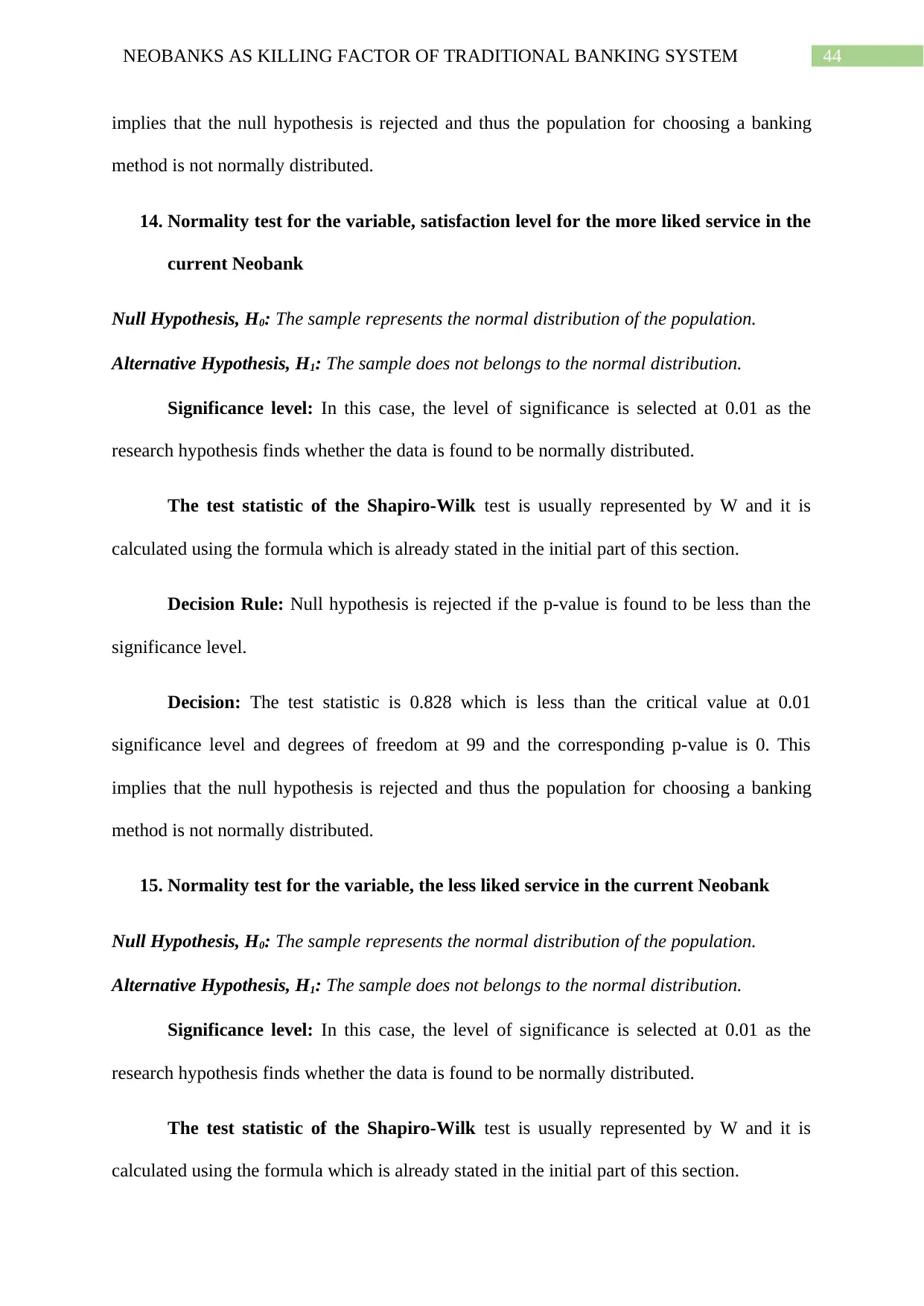
44NEOBANKS AS KILLING FACTOR OF TRADITIONAL BANKING SYSTEM
implies that the null hypothesis is rejected and thus the population for choosing a banking
method is not normally distributed.
14. Normality test for the variable, satisfaction level for the more liked service in the
current Neobank
Null Hypothesis, H0: The sample represents the normal distribution of the population.
Alternative Hypothesis, H1: The sample does not belongs to the normal distribution.
Significance level: In this case, the level of significance is selected at 0.01 as the
research hypothesis finds whether the data is found to be normally distributed.
The test statistic of the Shapiro-Wilk test is usually represented by W and it is
calculated using the formula which is already stated in the initial part of this section.
Decision Rule: Null hypothesis is rejected if the p-value is found to be less than the
significance level.
Decision: The test statistic is 0.828 which is less than the critical value at 0.01
significance level and degrees of freedom at 99 and the corresponding p-value is 0. This
implies that the null hypothesis is rejected and thus the population for choosing a banking
method is not normally distributed.
15. Normality test for the variable, the less liked service in the current Neobank
Null Hypothesis, H0: The sample represents the normal distribution of the population.
Alternative Hypothesis, H1: The sample does not belongs to the normal distribution.
Significance level: In this case, the level of significance is selected at 0.01 as the
research hypothesis finds whether the data is found to be normally distributed.
The test statistic of the Shapiro-Wilk test is usually represented by W and it is
calculated using the formula which is already stated in the initial part of this section.
implies that the null hypothesis is rejected and thus the population for choosing a banking
method is not normally distributed.
14. Normality test for the variable, satisfaction level for the more liked service in the
current Neobank
Null Hypothesis, H0: The sample represents the normal distribution of the population.
Alternative Hypothesis, H1: The sample does not belongs to the normal distribution.
Significance level: In this case, the level of significance is selected at 0.01 as the
research hypothesis finds whether the data is found to be normally distributed.
The test statistic of the Shapiro-Wilk test is usually represented by W and it is
calculated using the formula which is already stated in the initial part of this section.
Decision Rule: Null hypothesis is rejected if the p-value is found to be less than the
significance level.
Decision: The test statistic is 0.828 which is less than the critical value at 0.01
significance level and degrees of freedom at 99 and the corresponding p-value is 0. This
implies that the null hypothesis is rejected and thus the population for choosing a banking
method is not normally distributed.
15. Normality test for the variable, the less liked service in the current Neobank
Null Hypothesis, H0: The sample represents the normal distribution of the population.
Alternative Hypothesis, H1: The sample does not belongs to the normal distribution.
Significance level: In this case, the level of significance is selected at 0.01 as the
research hypothesis finds whether the data is found to be normally distributed.
The test statistic of the Shapiro-Wilk test is usually represented by W and it is
calculated using the formula which is already stated in the initial part of this section.
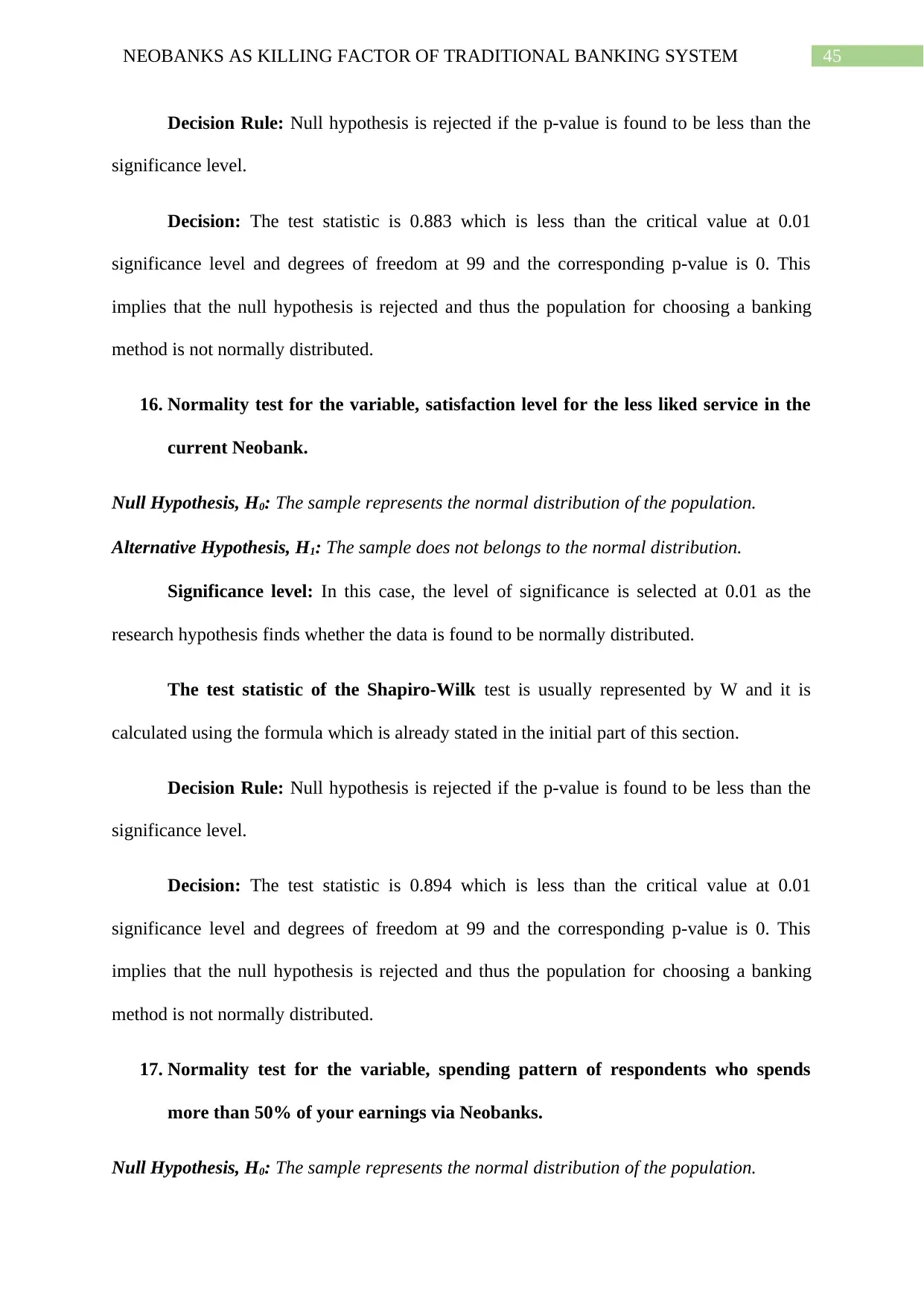
45NEOBANKS AS KILLING FACTOR OF TRADITIONAL BANKING SYSTEM
Decision Rule: Null hypothesis is rejected if the p-value is found to be less than the
significance level.
Decision: The test statistic is 0.883 which is less than the critical value at 0.01
significance level and degrees of freedom at 99 and the corresponding p-value is 0. This
implies that the null hypothesis is rejected and thus the population for choosing a banking
method is not normally distributed.
16. Normality test for the variable, satisfaction level for the less liked service in the
current Neobank.
Null Hypothesis, H0: The sample represents the normal distribution of the population.
Alternative Hypothesis, H1: The sample does not belongs to the normal distribution.
Significance level: In this case, the level of significance is selected at 0.01 as the
research hypothesis finds whether the data is found to be normally distributed.
The test statistic of the Shapiro-Wilk test is usually represented by W and it is
calculated using the formula which is already stated in the initial part of this section.
Decision Rule: Null hypothesis is rejected if the p-value is found to be less than the
significance level.
Decision: The test statistic is 0.894 which is less than the critical value at 0.01
significance level and degrees of freedom at 99 and the corresponding p-value is 0. This
implies that the null hypothesis is rejected and thus the population for choosing a banking
method is not normally distributed.
17. Normality test for the variable, spending pattern of respondents who spends
more than 50% of your earnings via Neobanks.
Null Hypothesis, H0: The sample represents the normal distribution of the population.
Decision Rule: Null hypothesis is rejected if the p-value is found to be less than the
significance level.
Decision: The test statistic is 0.883 which is less than the critical value at 0.01
significance level and degrees of freedom at 99 and the corresponding p-value is 0. This
implies that the null hypothesis is rejected and thus the population for choosing a banking
method is not normally distributed.
16. Normality test for the variable, satisfaction level for the less liked service in the
current Neobank.
Null Hypothesis, H0: The sample represents the normal distribution of the population.
Alternative Hypothesis, H1: The sample does not belongs to the normal distribution.
Significance level: In this case, the level of significance is selected at 0.01 as the
research hypothesis finds whether the data is found to be normally distributed.
The test statistic of the Shapiro-Wilk test is usually represented by W and it is
calculated using the formula which is already stated in the initial part of this section.
Decision Rule: Null hypothesis is rejected if the p-value is found to be less than the
significance level.
Decision: The test statistic is 0.894 which is less than the critical value at 0.01
significance level and degrees of freedom at 99 and the corresponding p-value is 0. This
implies that the null hypothesis is rejected and thus the population for choosing a banking
method is not normally distributed.
17. Normality test for the variable, spending pattern of respondents who spends
more than 50% of your earnings via Neobanks.
Null Hypothesis, H0: The sample represents the normal distribution of the population.
Secure Best Marks with AI Grader
Need help grading? Try our AI Grader for instant feedback on your assignments.
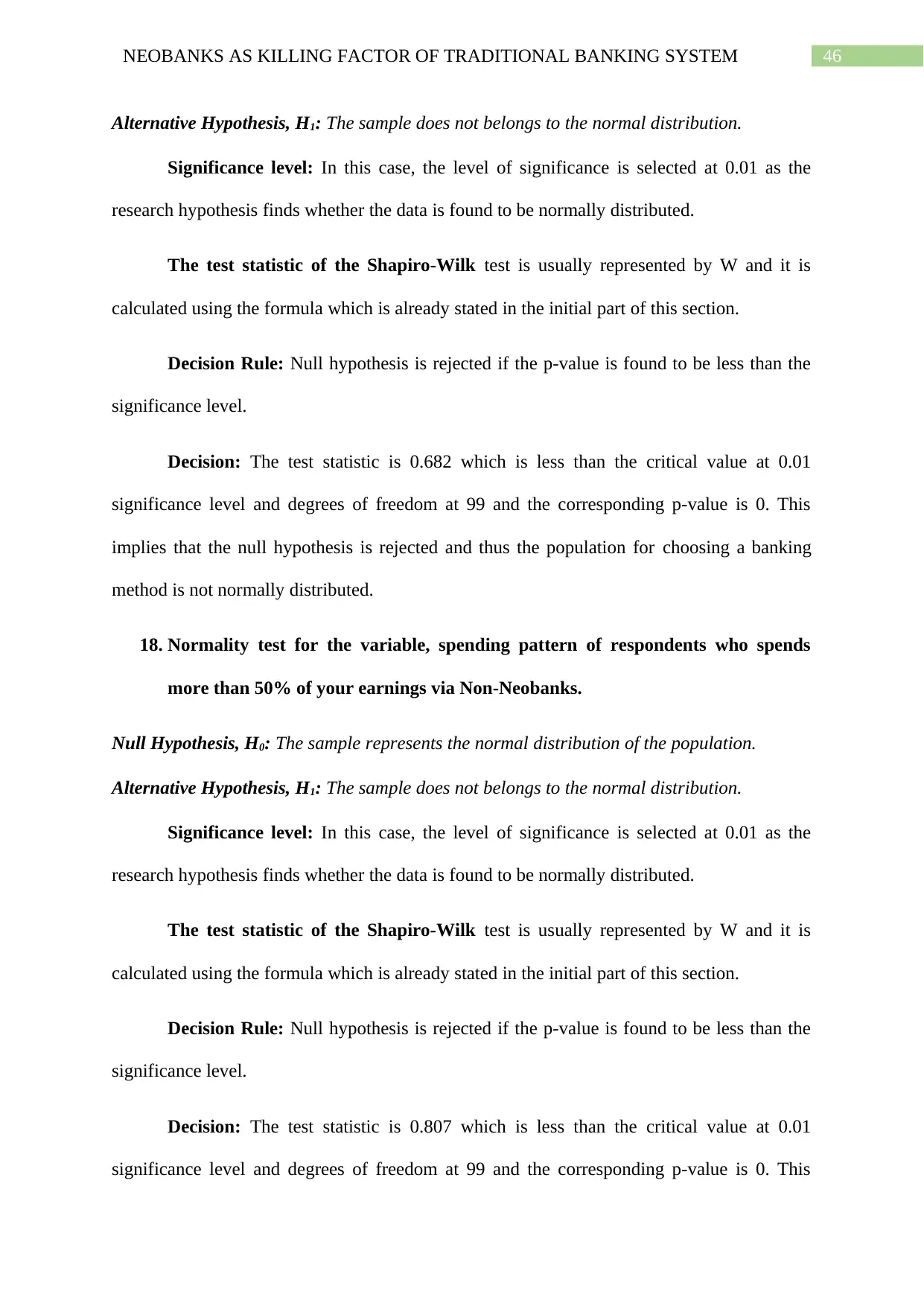
46NEOBANKS AS KILLING FACTOR OF TRADITIONAL BANKING SYSTEM
Alternative Hypothesis, H1: The sample does not belongs to the normal distribution.
Significance level: In this case, the level of significance is selected at 0.01 as the
research hypothesis finds whether the data is found to be normally distributed.
The test statistic of the Shapiro-Wilk test is usually represented by W and it is
calculated using the formula which is already stated in the initial part of this section.
Decision Rule: Null hypothesis is rejected if the p-value is found to be less than the
significance level.
Decision: The test statistic is 0.682 which is less than the critical value at 0.01
significance level and degrees of freedom at 99 and the corresponding p-value is 0. This
implies that the null hypothesis is rejected and thus the population for choosing a banking
method is not normally distributed.
18. Normality test for the variable, spending pattern of respondents who spends
more than 50% of your earnings via Non-Neobanks.
Null Hypothesis, H0: The sample represents the normal distribution of the population.
Alternative Hypothesis, H1: The sample does not belongs to the normal distribution.
Significance level: In this case, the level of significance is selected at 0.01 as the
research hypothesis finds whether the data is found to be normally distributed.
The test statistic of the Shapiro-Wilk test is usually represented by W and it is
calculated using the formula which is already stated in the initial part of this section.
Decision Rule: Null hypothesis is rejected if the p-value is found to be less than the
significance level.
Decision: The test statistic is 0.807 which is less than the critical value at 0.01
significance level and degrees of freedom at 99 and the corresponding p-value is 0. This
Alternative Hypothesis, H1: The sample does not belongs to the normal distribution.
Significance level: In this case, the level of significance is selected at 0.01 as the
research hypothesis finds whether the data is found to be normally distributed.
The test statistic of the Shapiro-Wilk test is usually represented by W and it is
calculated using the formula which is already stated in the initial part of this section.
Decision Rule: Null hypothesis is rejected if the p-value is found to be less than the
significance level.
Decision: The test statistic is 0.682 which is less than the critical value at 0.01
significance level and degrees of freedom at 99 and the corresponding p-value is 0. This
implies that the null hypothesis is rejected and thus the population for choosing a banking
method is not normally distributed.
18. Normality test for the variable, spending pattern of respondents who spends
more than 50% of your earnings via Non-Neobanks.
Null Hypothesis, H0: The sample represents the normal distribution of the population.
Alternative Hypothesis, H1: The sample does not belongs to the normal distribution.
Significance level: In this case, the level of significance is selected at 0.01 as the
research hypothesis finds whether the data is found to be normally distributed.
The test statistic of the Shapiro-Wilk test is usually represented by W and it is
calculated using the formula which is already stated in the initial part of this section.
Decision Rule: Null hypothesis is rejected if the p-value is found to be less than the
significance level.
Decision: The test statistic is 0.807 which is less than the critical value at 0.01
significance level and degrees of freedom at 99 and the corresponding p-value is 0. This

47NEOBANKS AS KILLING FACTOR OF TRADITIONAL BANKING SYSTEM
implies that the null hypothesis is rejected and thus the population for choosing a banking
method is not normally distributed.
19. Normality test for the variable, use of paid premium services offered by
Neobanks.
Null Hypothesis, H0: The sample represents the normal distribution of the population.
Alternative Hypothesis, H1: The sample does not belongs to the normal distribution.
Significance level: In this case, the level of significance is selected at 0.01 as the
research hypothesis finds whether the data is found to be normally distributed.
The test statistic of the Shapiro-Wilk test is usually represented by W and it is
calculated using the formula which is already stated in the initial part of this section.
Decision Rule: Null hypothesis is rejected if the p-value is found to be less than the
significance level.
Decision: The test statistic is 0.781 which is less than the critical value at 0.01
significance level and degrees of freedom at 99 and the corresponding p-value is 0. This
implies that the null hypothesis is rejected and thus the population for choosing a banking
method is not normally distributed.
20. Normality test for the variable, willingness to pay for the Neobank premium
service in the future.
Null Hypothesis, H0: The sample represents the normal distribution of the population.
Alternative Hypothesis, H1: The sample does not belongs to the normal distribution.
Significance level: In this case, the level of significance is selected at 0.01 as the
research hypothesis finds whether the data is found to be normally distributed.
implies that the null hypothesis is rejected and thus the population for choosing a banking
method is not normally distributed.
19. Normality test for the variable, use of paid premium services offered by
Neobanks.
Null Hypothesis, H0: The sample represents the normal distribution of the population.
Alternative Hypothesis, H1: The sample does not belongs to the normal distribution.
Significance level: In this case, the level of significance is selected at 0.01 as the
research hypothesis finds whether the data is found to be normally distributed.
The test statistic of the Shapiro-Wilk test is usually represented by W and it is
calculated using the formula which is already stated in the initial part of this section.
Decision Rule: Null hypothesis is rejected if the p-value is found to be less than the
significance level.
Decision: The test statistic is 0.781 which is less than the critical value at 0.01
significance level and degrees of freedom at 99 and the corresponding p-value is 0. This
implies that the null hypothesis is rejected and thus the population for choosing a banking
method is not normally distributed.
20. Normality test for the variable, willingness to pay for the Neobank premium
service in the future.
Null Hypothesis, H0: The sample represents the normal distribution of the population.
Alternative Hypothesis, H1: The sample does not belongs to the normal distribution.
Significance level: In this case, the level of significance is selected at 0.01 as the
research hypothesis finds whether the data is found to be normally distributed.
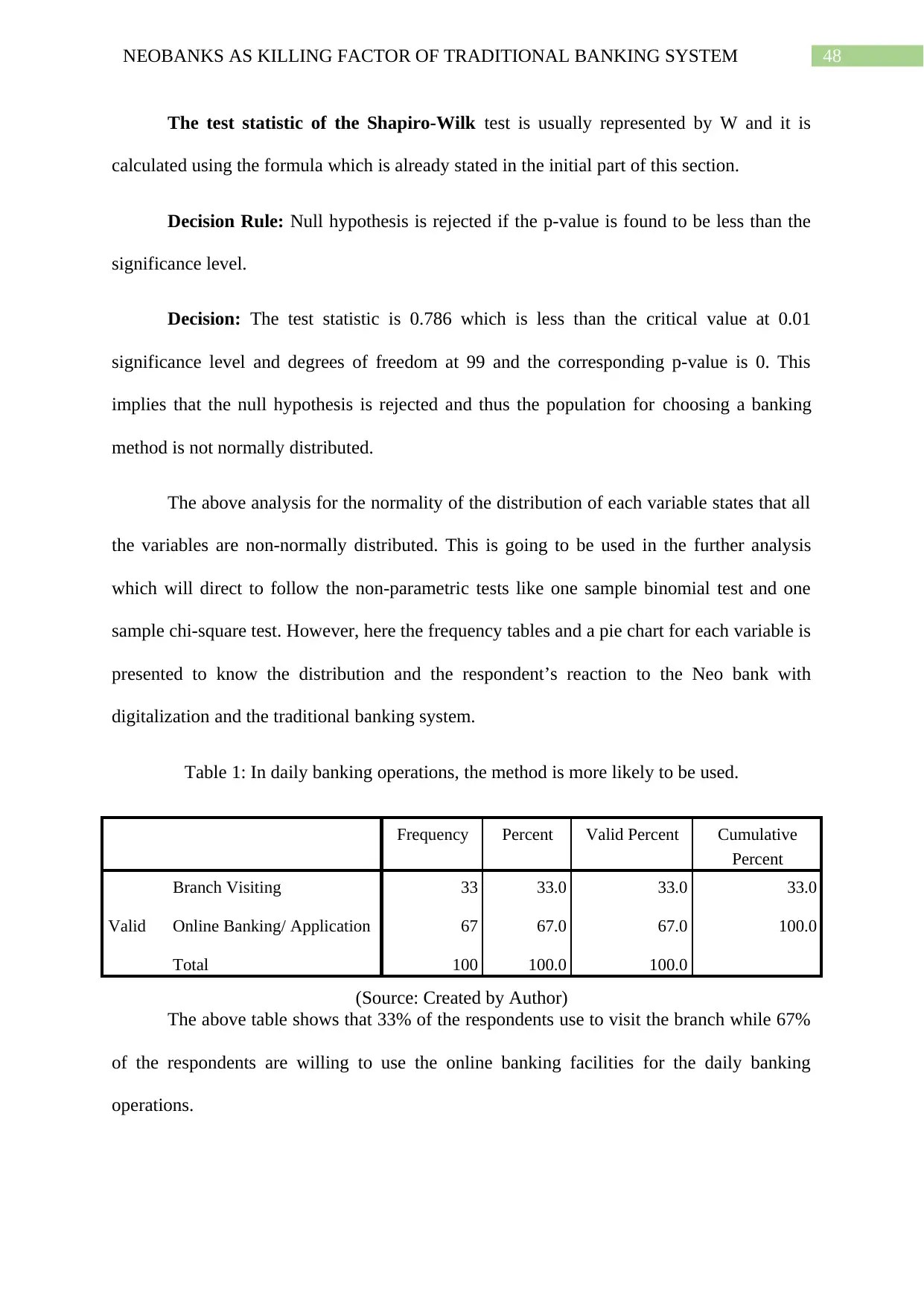
48NEOBANKS AS KILLING FACTOR OF TRADITIONAL BANKING SYSTEM
The test statistic of the Shapiro-Wilk test is usually represented by W and it is
calculated using the formula which is already stated in the initial part of this section.
Decision Rule: Null hypothesis is rejected if the p-value is found to be less than the
significance level.
Decision: The test statistic is 0.786 which is less than the critical value at 0.01
significance level and degrees of freedom at 99 and the corresponding p-value is 0. This
implies that the null hypothesis is rejected and thus the population for choosing a banking
method is not normally distributed.
The above analysis for the normality of the distribution of each variable states that all
the variables are non-normally distributed. This is going to be used in the further analysis
which will direct to follow the non-parametric tests like one sample binomial test and one
sample chi-square test. However, here the frequency tables and a pie chart for each variable is
presented to know the distribution and the respondent’s reaction to the Neo bank with
digitalization and the traditional banking system.
Table 1: In daily banking operations, the method is more likely to be used.
Frequency Percent Valid Percent Cumulative
Percent
Valid
Branch Visiting 33 33.0 33.0 33.0
Online Banking/ Application 67 67.0 67.0 100.0
Total 100 100.0 100.0
(Source: Created by Author)
The above table shows that 33% of the respondents use to visit the branch while 67%
of the respondents are willing to use the online banking facilities for the daily banking
operations.
The test statistic of the Shapiro-Wilk test is usually represented by W and it is
calculated using the formula which is already stated in the initial part of this section.
Decision Rule: Null hypothesis is rejected if the p-value is found to be less than the
significance level.
Decision: The test statistic is 0.786 which is less than the critical value at 0.01
significance level and degrees of freedom at 99 and the corresponding p-value is 0. This
implies that the null hypothesis is rejected and thus the population for choosing a banking
method is not normally distributed.
The above analysis for the normality of the distribution of each variable states that all
the variables are non-normally distributed. This is going to be used in the further analysis
which will direct to follow the non-parametric tests like one sample binomial test and one
sample chi-square test. However, here the frequency tables and a pie chart for each variable is
presented to know the distribution and the respondent’s reaction to the Neo bank with
digitalization and the traditional banking system.
Table 1: In daily banking operations, the method is more likely to be used.
Frequency Percent Valid Percent Cumulative
Percent
Valid
Branch Visiting 33 33.0 33.0 33.0
Online Banking/ Application 67 67.0 67.0 100.0
Total 100 100.0 100.0
(Source: Created by Author)
The above table shows that 33% of the respondents use to visit the branch while 67%
of the respondents are willing to use the online banking facilities for the daily banking
operations.
Paraphrase This Document
Need a fresh take? Get an instant paraphrase of this document with our AI Paraphraser
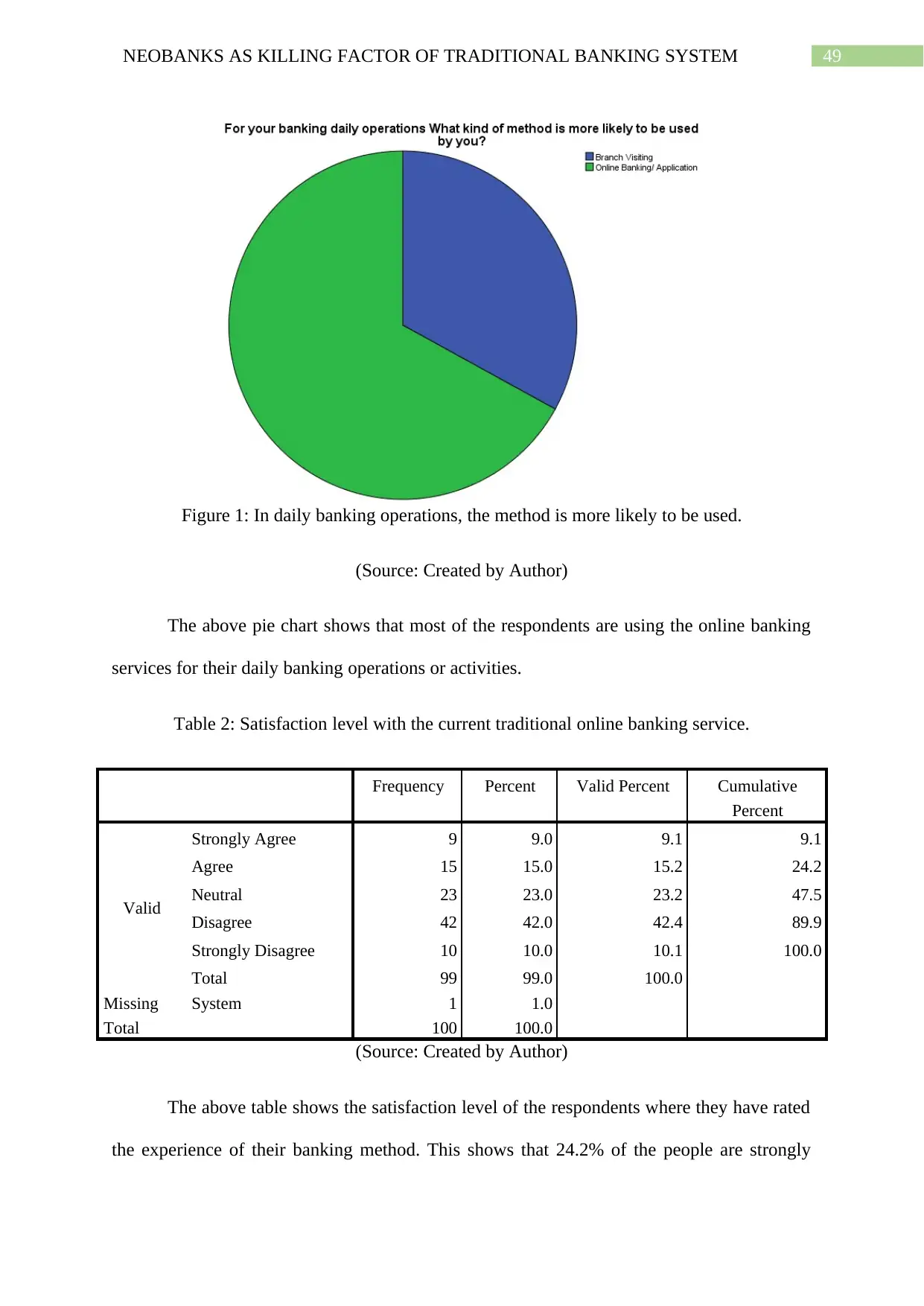
49NEOBANKS AS KILLING FACTOR OF TRADITIONAL BANKING SYSTEM
Figure 1: In daily banking operations, the method is more likely to be used.
(Source: Created by Author)
The above pie chart shows that most of the respondents are using the online banking
services for their daily banking operations or activities.
Table 2: Satisfaction level with the current traditional online banking service.
Frequency Percent Valid Percent Cumulative
Percent
Valid
Strongly Agree 9 9.0 9.1 9.1
Agree 15 15.0 15.2 24.2
Neutral 23 23.0 23.2 47.5
Disagree 42 42.0 42.4 89.9
Strongly Disagree 10 10.0 10.1 100.0
Total 99 99.0 100.0
Missing System 1 1.0
Total 100 100.0
(Source: Created by Author)
The above table shows the satisfaction level of the respondents where they have rated
the experience of their banking method. This shows that 24.2% of the people are strongly
Figure 1: In daily banking operations, the method is more likely to be used.
(Source: Created by Author)
The above pie chart shows that most of the respondents are using the online banking
services for their daily banking operations or activities.
Table 2: Satisfaction level with the current traditional online banking service.
Frequency Percent Valid Percent Cumulative
Percent
Valid
Strongly Agree 9 9.0 9.1 9.1
Agree 15 15.0 15.2 24.2
Neutral 23 23.0 23.2 47.5
Disagree 42 42.0 42.4 89.9
Strongly Disagree 10 10.0 10.1 100.0
Total 99 99.0 100.0
Missing System 1 1.0
Total 100 100.0
(Source: Created by Author)
The above table shows the satisfaction level of the respondents where they have rated
the experience of their banking method. This shows that 24.2% of the people are strongly
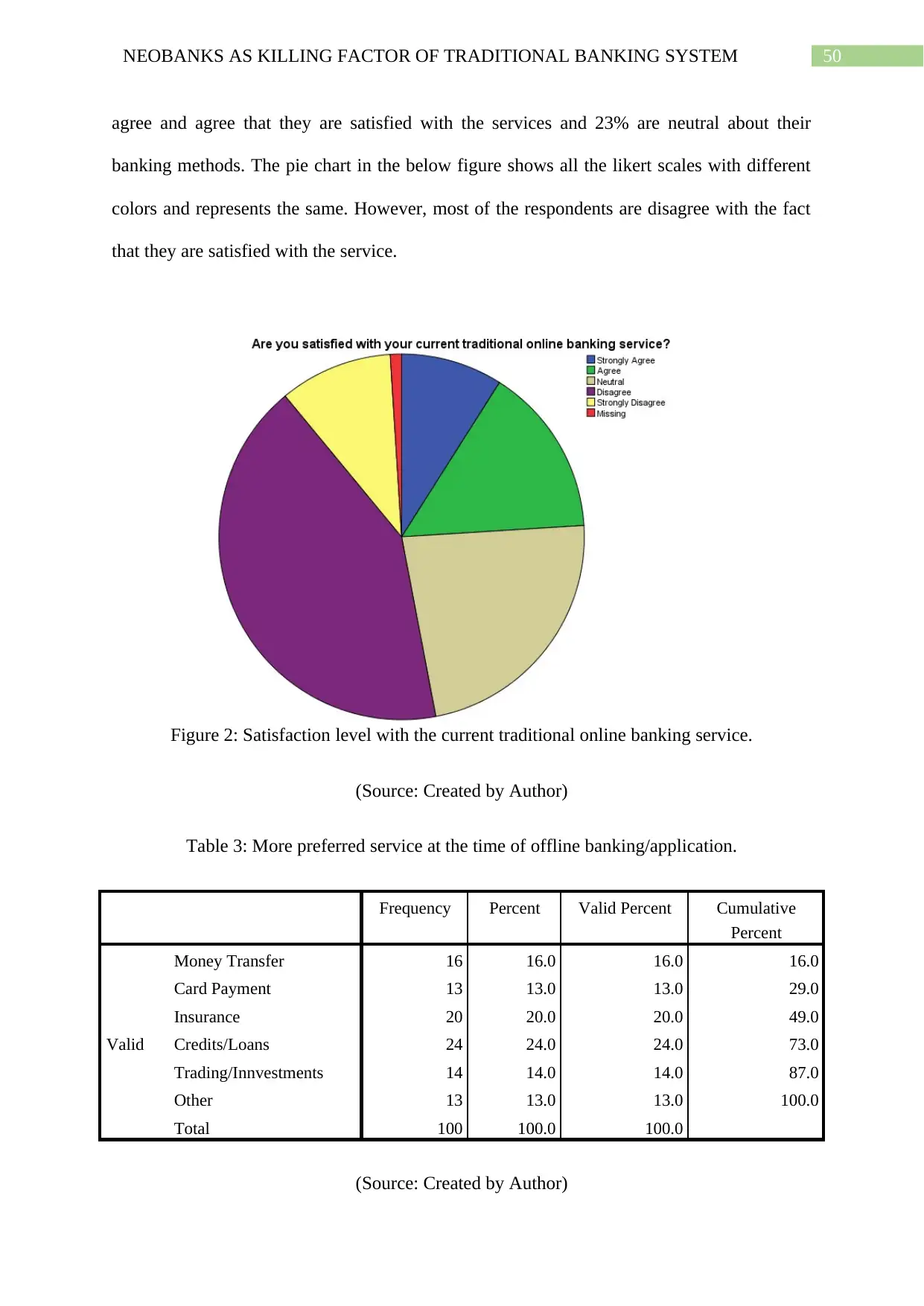
50NEOBANKS AS KILLING FACTOR OF TRADITIONAL BANKING SYSTEM
agree and agree that they are satisfied with the services and 23% are neutral about their
banking methods. The pie chart in the below figure shows all the likert scales with different
colors and represents the same. However, most of the respondents are disagree with the fact
that they are satisfied with the service.
Figure 2: Satisfaction level with the current traditional online banking service.
(Source: Created by Author)
Table 3: More preferred service at the time of offline banking/application.
Frequency Percent Valid Percent Cumulative
Percent
Valid
Money Transfer 16 16.0 16.0 16.0
Card Payment 13 13.0 13.0 29.0
Insurance 20 20.0 20.0 49.0
Credits/Loans 24 24.0 24.0 73.0
Trading/Innvestments 14 14.0 14.0 87.0
Other 13 13.0 13.0 100.0
Total 100 100.0 100.0
(Source: Created by Author)
agree and agree that they are satisfied with the services and 23% are neutral about their
banking methods. The pie chart in the below figure shows all the likert scales with different
colors and represents the same. However, most of the respondents are disagree with the fact
that they are satisfied with the service.
Figure 2: Satisfaction level with the current traditional online banking service.
(Source: Created by Author)
Table 3: More preferred service at the time of offline banking/application.
Frequency Percent Valid Percent Cumulative
Percent
Valid
Money Transfer 16 16.0 16.0 16.0
Card Payment 13 13.0 13.0 29.0
Insurance 20 20.0 20.0 49.0
Credits/Loans 24 24.0 24.0 73.0
Trading/Innvestments 14 14.0 14.0 87.0
Other 13 13.0 13.0 100.0
Total 100 100.0 100.0
(Source: Created by Author)
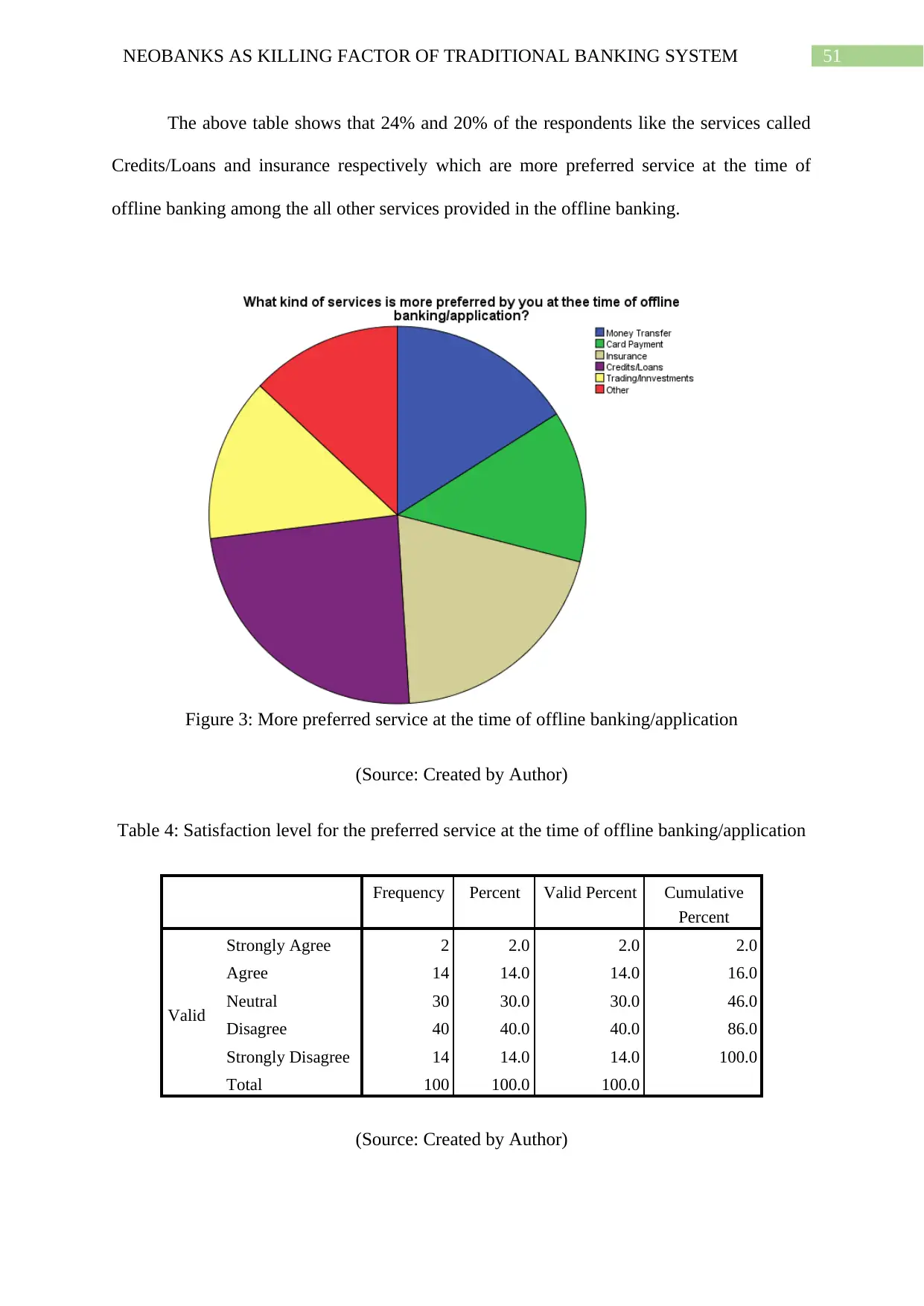
51NEOBANKS AS KILLING FACTOR OF TRADITIONAL BANKING SYSTEM
The above table shows that 24% and 20% of the respondents like the services called
Credits/Loans and insurance respectively which are more preferred service at the time of
offline banking among the all other services provided in the offline banking.
Figure 3: More preferred service at the time of offline banking/application
(Source: Created by Author)
Table 4: Satisfaction level for the preferred service at the time of offline banking/application
Frequency Percent Valid Percent Cumulative
Percent
Valid
Strongly Agree 2 2.0 2.0 2.0
Agree 14 14.0 14.0 16.0
Neutral 30 30.0 30.0 46.0
Disagree 40 40.0 40.0 86.0
Strongly Disagree 14 14.0 14.0 100.0
Total 100 100.0 100.0
(Source: Created by Author)
The above table shows that 24% and 20% of the respondents like the services called
Credits/Loans and insurance respectively which are more preferred service at the time of
offline banking among the all other services provided in the offline banking.
Figure 3: More preferred service at the time of offline banking/application
(Source: Created by Author)
Table 4: Satisfaction level for the preferred service at the time of offline banking/application
Frequency Percent Valid Percent Cumulative
Percent
Valid
Strongly Agree 2 2.0 2.0 2.0
Agree 14 14.0 14.0 16.0
Neutral 30 30.0 30.0 46.0
Disagree 40 40.0 40.0 86.0
Strongly Disagree 14 14.0 14.0 100.0
Total 100 100.0 100.0
(Source: Created by Author)
Secure Best Marks with AI Grader
Need help grading? Try our AI Grader for instant feedback on your assignments.
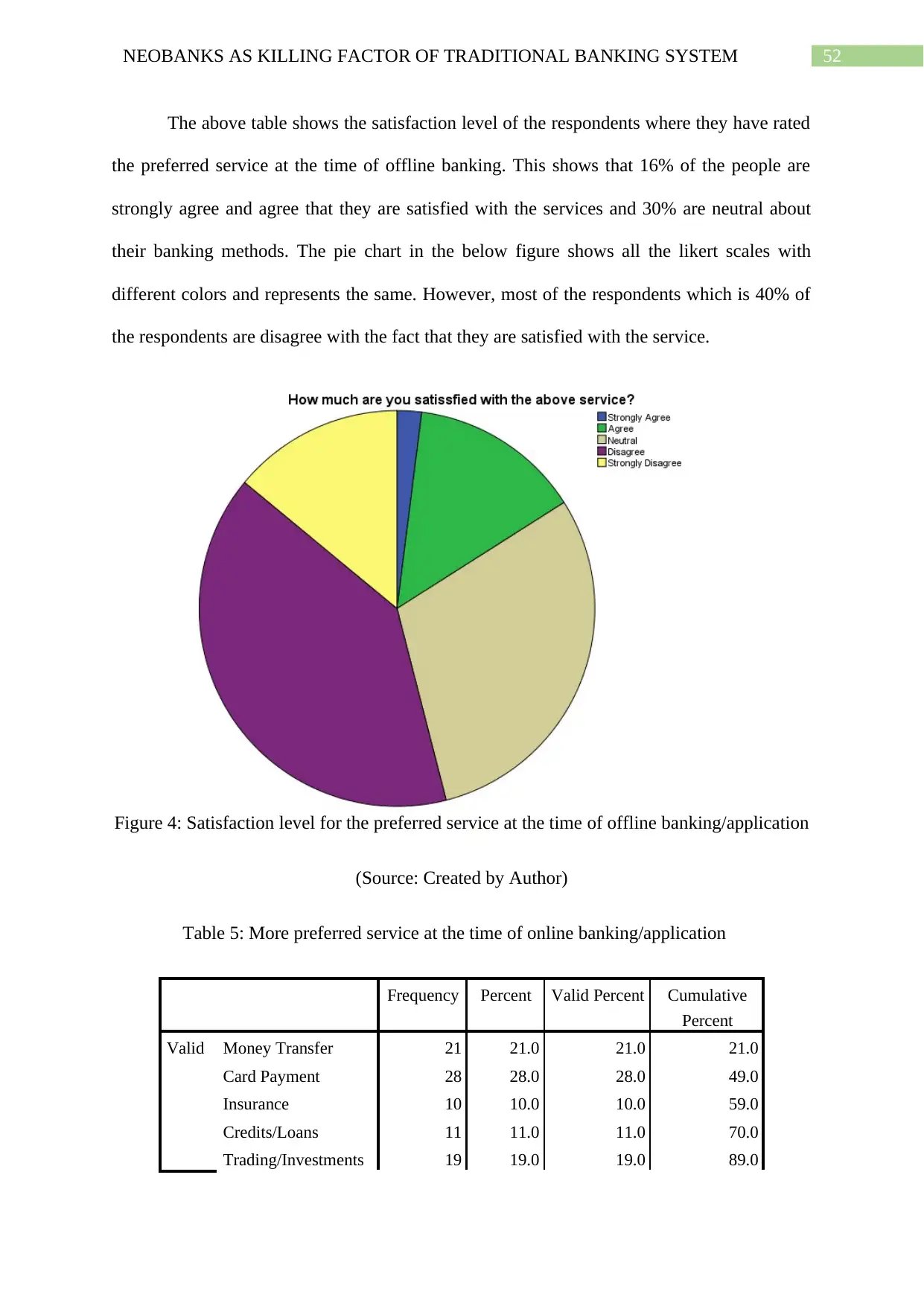
52NEOBANKS AS KILLING FACTOR OF TRADITIONAL BANKING SYSTEM
The above table shows the satisfaction level of the respondents where they have rated
the preferred service at the time of offline banking. This shows that 16% of the people are
strongly agree and agree that they are satisfied with the services and 30% are neutral about
their banking methods. The pie chart in the below figure shows all the likert scales with
different colors and represents the same. However, most of the respondents which is 40% of
the respondents are disagree with the fact that they are satisfied with the service.
Figure 4: Satisfaction level for the preferred service at the time of offline banking/application
(Source: Created by Author)
Table 5: More preferred service at the time of online banking/application
Frequency Percent Valid Percent Cumulative
Percent
Valid Money Transfer 21 21.0 21.0 21.0
Card Payment 28 28.0 28.0 49.0
Insurance 10 10.0 10.0 59.0
Credits/Loans 11 11.0 11.0 70.0
Trading/Investments 19 19.0 19.0 89.0
The above table shows the satisfaction level of the respondents where they have rated
the preferred service at the time of offline banking. This shows that 16% of the people are
strongly agree and agree that they are satisfied with the services and 30% are neutral about
their banking methods. The pie chart in the below figure shows all the likert scales with
different colors and represents the same. However, most of the respondents which is 40% of
the respondents are disagree with the fact that they are satisfied with the service.
Figure 4: Satisfaction level for the preferred service at the time of offline banking/application
(Source: Created by Author)
Table 5: More preferred service at the time of online banking/application
Frequency Percent Valid Percent Cumulative
Percent
Valid Money Transfer 21 21.0 21.0 21.0
Card Payment 28 28.0 28.0 49.0
Insurance 10 10.0 10.0 59.0
Credits/Loans 11 11.0 11.0 70.0
Trading/Investments 19 19.0 19.0 89.0
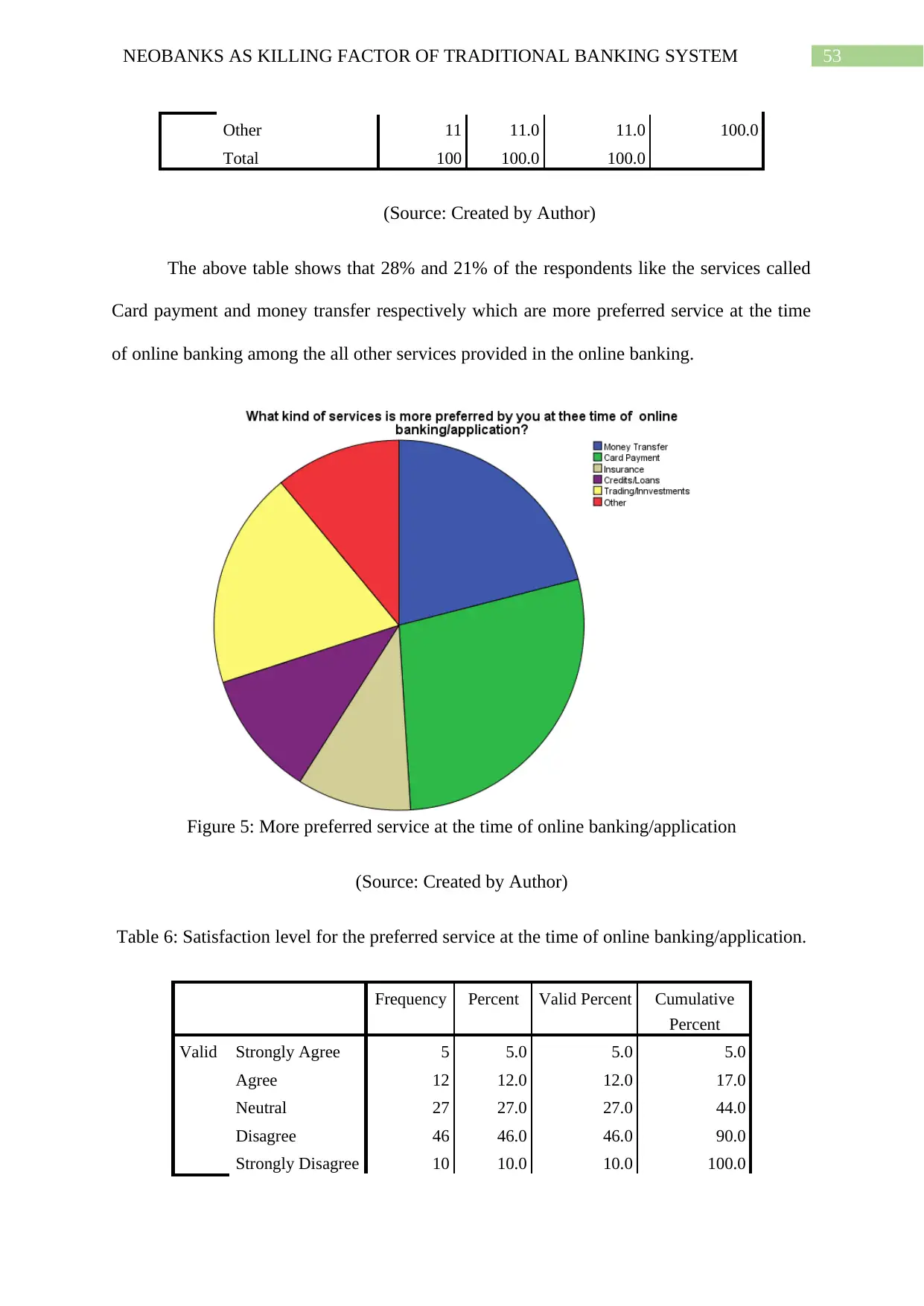
53NEOBANKS AS KILLING FACTOR OF TRADITIONAL BANKING SYSTEM
Other 11 11.0 11.0 100.0
Total 100 100.0 100.0
(Source: Created by Author)
The above table shows that 28% and 21% of the respondents like the services called
Card payment and money transfer respectively which are more preferred service at the time
of online banking among the all other services provided in the online banking.
Figure 5: More preferred service at the time of online banking/application
(Source: Created by Author)
Table 6: Satisfaction level for the preferred service at the time of online banking/application.
Frequency Percent Valid Percent Cumulative
Percent
Valid Strongly Agree 5 5.0 5.0 5.0
Agree 12 12.0 12.0 17.0
Neutral 27 27.0 27.0 44.0
Disagree 46 46.0 46.0 90.0
Strongly Disagree 10 10.0 10.0 100.0
Other 11 11.0 11.0 100.0
Total 100 100.0 100.0
(Source: Created by Author)
The above table shows that 28% and 21% of the respondents like the services called
Card payment and money transfer respectively which are more preferred service at the time
of online banking among the all other services provided in the online banking.
Figure 5: More preferred service at the time of online banking/application
(Source: Created by Author)
Table 6: Satisfaction level for the preferred service at the time of online banking/application.
Frequency Percent Valid Percent Cumulative
Percent
Valid Strongly Agree 5 5.0 5.0 5.0
Agree 12 12.0 12.0 17.0
Neutral 27 27.0 27.0 44.0
Disagree 46 46.0 46.0 90.0
Strongly Disagree 10 10.0 10.0 100.0
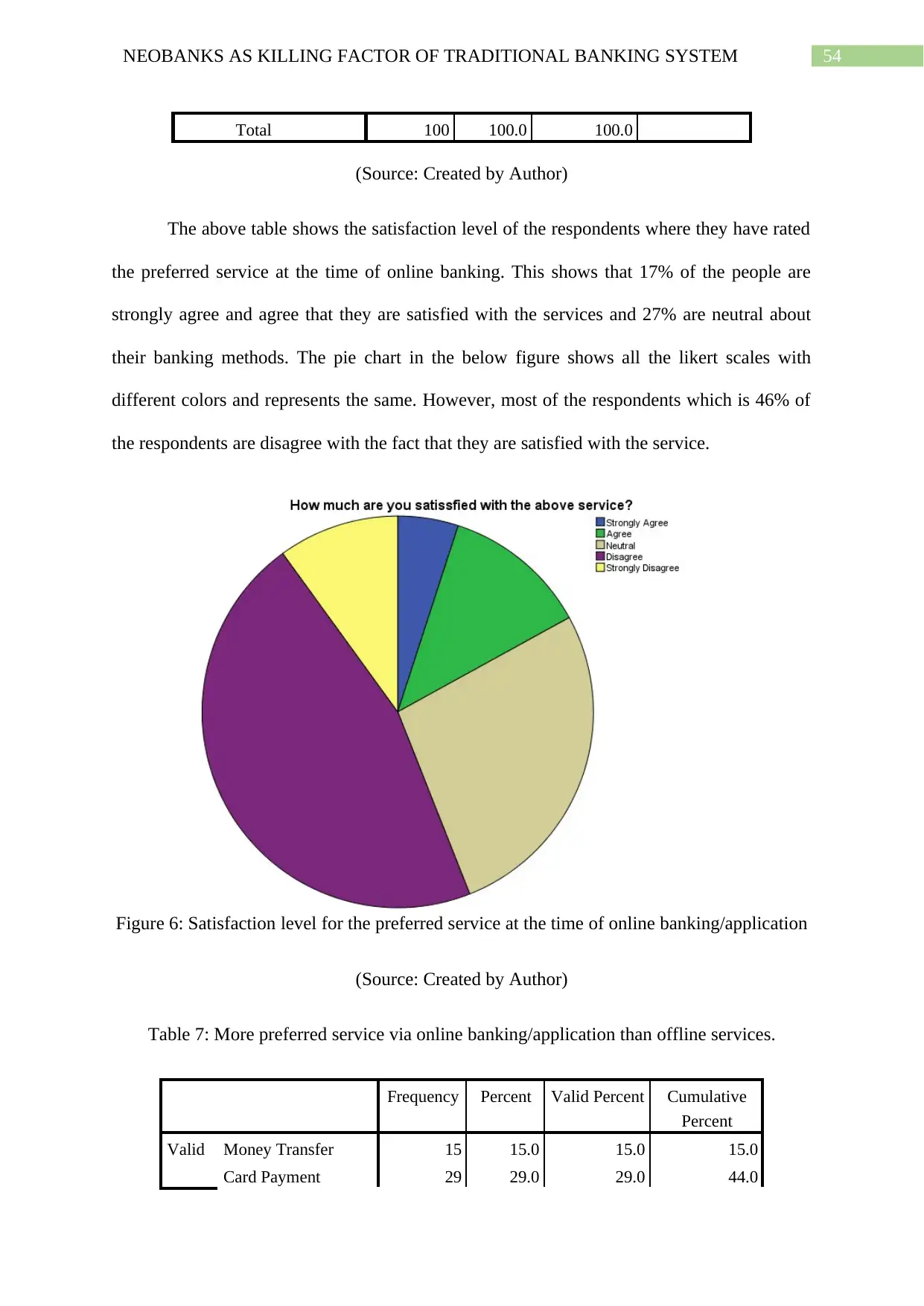
54NEOBANKS AS KILLING FACTOR OF TRADITIONAL BANKING SYSTEM
Total 100 100.0 100.0
(Source: Created by Author)
The above table shows the satisfaction level of the respondents where they have rated
the preferred service at the time of online banking. This shows that 17% of the people are
strongly agree and agree that they are satisfied with the services and 27% are neutral about
their banking methods. The pie chart in the below figure shows all the likert scales with
different colors and represents the same. However, most of the respondents which is 46% of
the respondents are disagree with the fact that they are satisfied with the service.
Figure 6: Satisfaction level for the preferred service at the time of online banking/application
(Source: Created by Author)
Table 7: More preferred service via online banking/application than offline services.
Frequency Percent Valid Percent Cumulative
Percent
Valid Money Transfer 15 15.0 15.0 15.0
Card Payment 29 29.0 29.0 44.0
Total 100 100.0 100.0
(Source: Created by Author)
The above table shows the satisfaction level of the respondents where they have rated
the preferred service at the time of online banking. This shows that 17% of the people are
strongly agree and agree that they are satisfied with the services and 27% are neutral about
their banking methods. The pie chart in the below figure shows all the likert scales with
different colors and represents the same. However, most of the respondents which is 46% of
the respondents are disagree with the fact that they are satisfied with the service.
Figure 6: Satisfaction level for the preferred service at the time of online banking/application
(Source: Created by Author)
Table 7: More preferred service via online banking/application than offline services.
Frequency Percent Valid Percent Cumulative
Percent
Valid Money Transfer 15 15.0 15.0 15.0
Card Payment 29 29.0 29.0 44.0
Paraphrase This Document
Need a fresh take? Get an instant paraphrase of this document with our AI Paraphraser
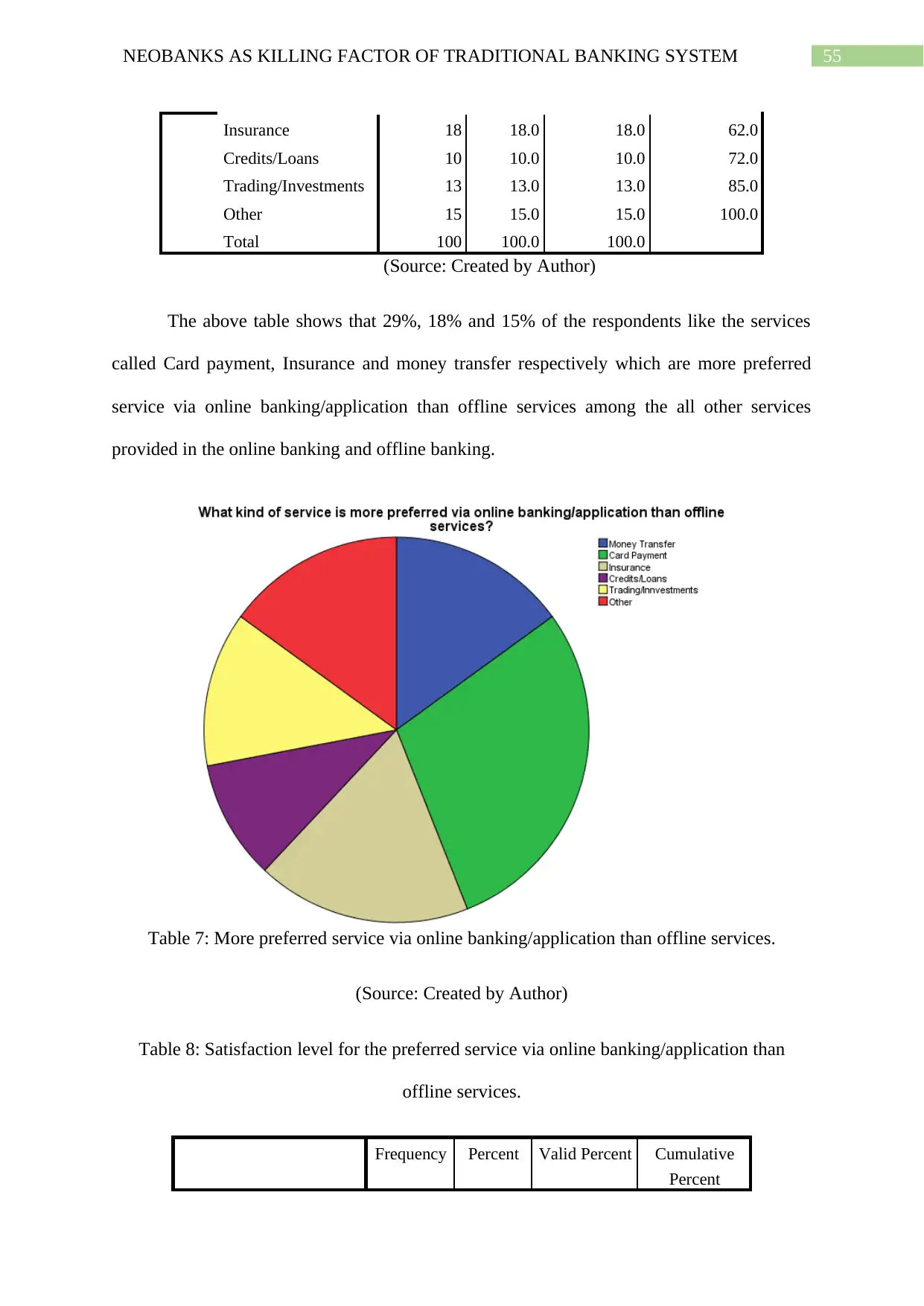
55NEOBANKS AS KILLING FACTOR OF TRADITIONAL BANKING SYSTEM
Insurance 18 18.0 18.0 62.0
Credits/Loans 10 10.0 10.0 72.0
Trading/Investments 13 13.0 13.0 85.0
Other 15 15.0 15.0 100.0
Total 100 100.0 100.0
(Source: Created by Author)
The above table shows that 29%, 18% and 15% of the respondents like the services
called Card payment, Insurance and money transfer respectively which are more preferred
service via online banking/application than offline services among the all other services
provided in the online banking and offline banking.
Table 7: More preferred service via online banking/application than offline services.
(Source: Created by Author)
Table 8: Satisfaction level for the preferred service via online banking/application than
offline services.
Frequency Percent Valid Percent Cumulative
Percent
Insurance 18 18.0 18.0 62.0
Credits/Loans 10 10.0 10.0 72.0
Trading/Investments 13 13.0 13.0 85.0
Other 15 15.0 15.0 100.0
Total 100 100.0 100.0
(Source: Created by Author)
The above table shows that 29%, 18% and 15% of the respondents like the services
called Card payment, Insurance and money transfer respectively which are more preferred
service via online banking/application than offline services among the all other services
provided in the online banking and offline banking.
Table 7: More preferred service via online banking/application than offline services.
(Source: Created by Author)
Table 8: Satisfaction level for the preferred service via online banking/application than
offline services.
Frequency Percent Valid Percent Cumulative
Percent
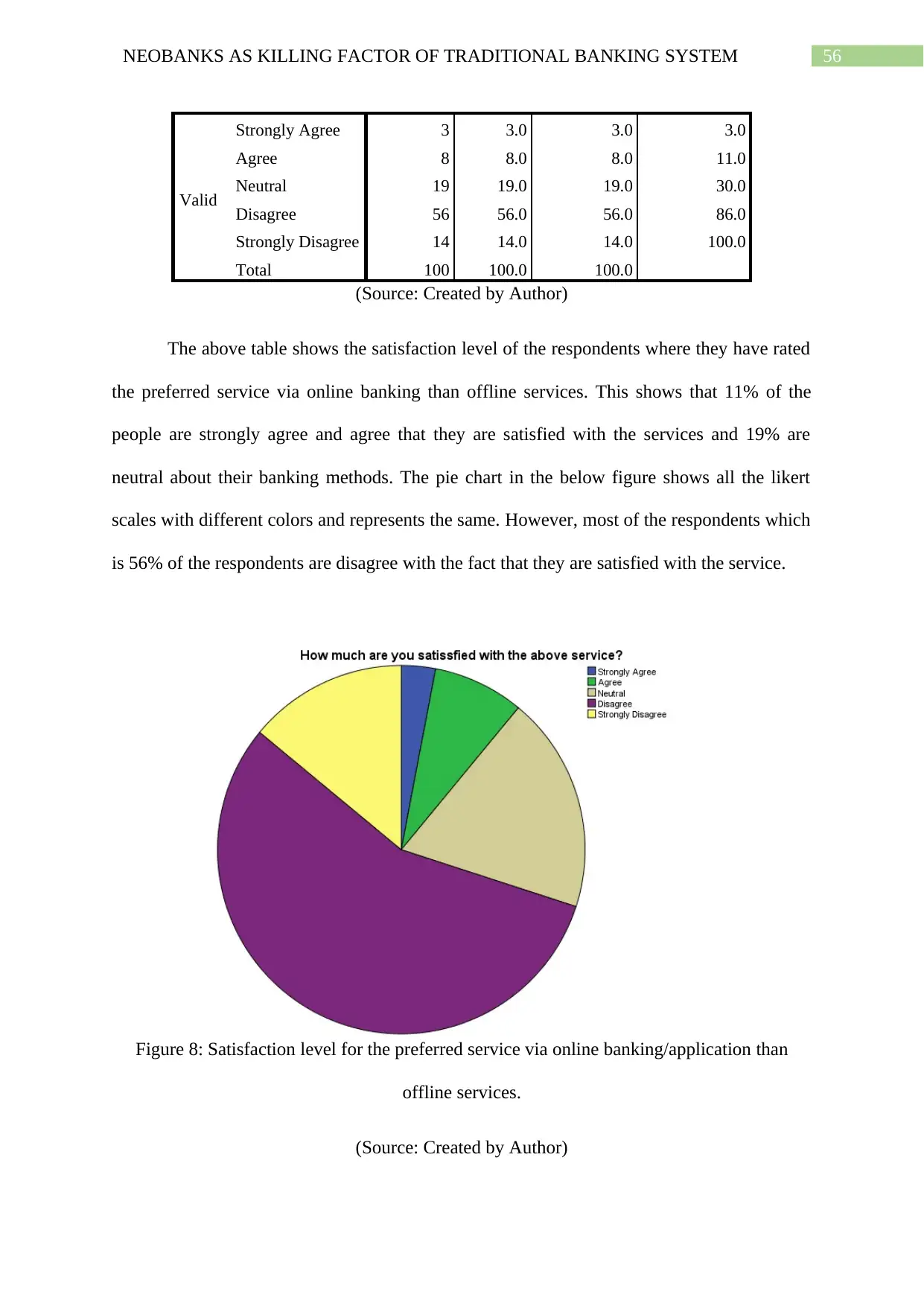
56NEOBANKS AS KILLING FACTOR OF TRADITIONAL BANKING SYSTEM
Valid
Strongly Agree 3 3.0 3.0 3.0
Agree 8 8.0 8.0 11.0
Neutral 19 19.0 19.0 30.0
Disagree 56 56.0 56.0 86.0
Strongly Disagree 14 14.0 14.0 100.0
Total 100 100.0 100.0
(Source: Created by Author)
The above table shows the satisfaction level of the respondents where they have rated
the preferred service via online banking than offline services. This shows that 11% of the
people are strongly agree and agree that they are satisfied with the services and 19% are
neutral about their banking methods. The pie chart in the below figure shows all the likert
scales with different colors and represents the same. However, most of the respondents which
is 56% of the respondents are disagree with the fact that they are satisfied with the service.
Figure 8: Satisfaction level for the preferred service via online banking/application than
offline services.
(Source: Created by Author)
Valid
Strongly Agree 3 3.0 3.0 3.0
Agree 8 8.0 8.0 11.0
Neutral 19 19.0 19.0 30.0
Disagree 56 56.0 56.0 86.0
Strongly Disagree 14 14.0 14.0 100.0
Total 100 100.0 100.0
(Source: Created by Author)
The above table shows the satisfaction level of the respondents where they have rated
the preferred service via online banking than offline services. This shows that 11% of the
people are strongly agree and agree that they are satisfied with the services and 19% are
neutral about their banking methods. The pie chart in the below figure shows all the likert
scales with different colors and represents the same. However, most of the respondents which
is 56% of the respondents are disagree with the fact that they are satisfied with the service.
Figure 8: Satisfaction level for the preferred service via online banking/application than
offline services.
(Source: Created by Author)
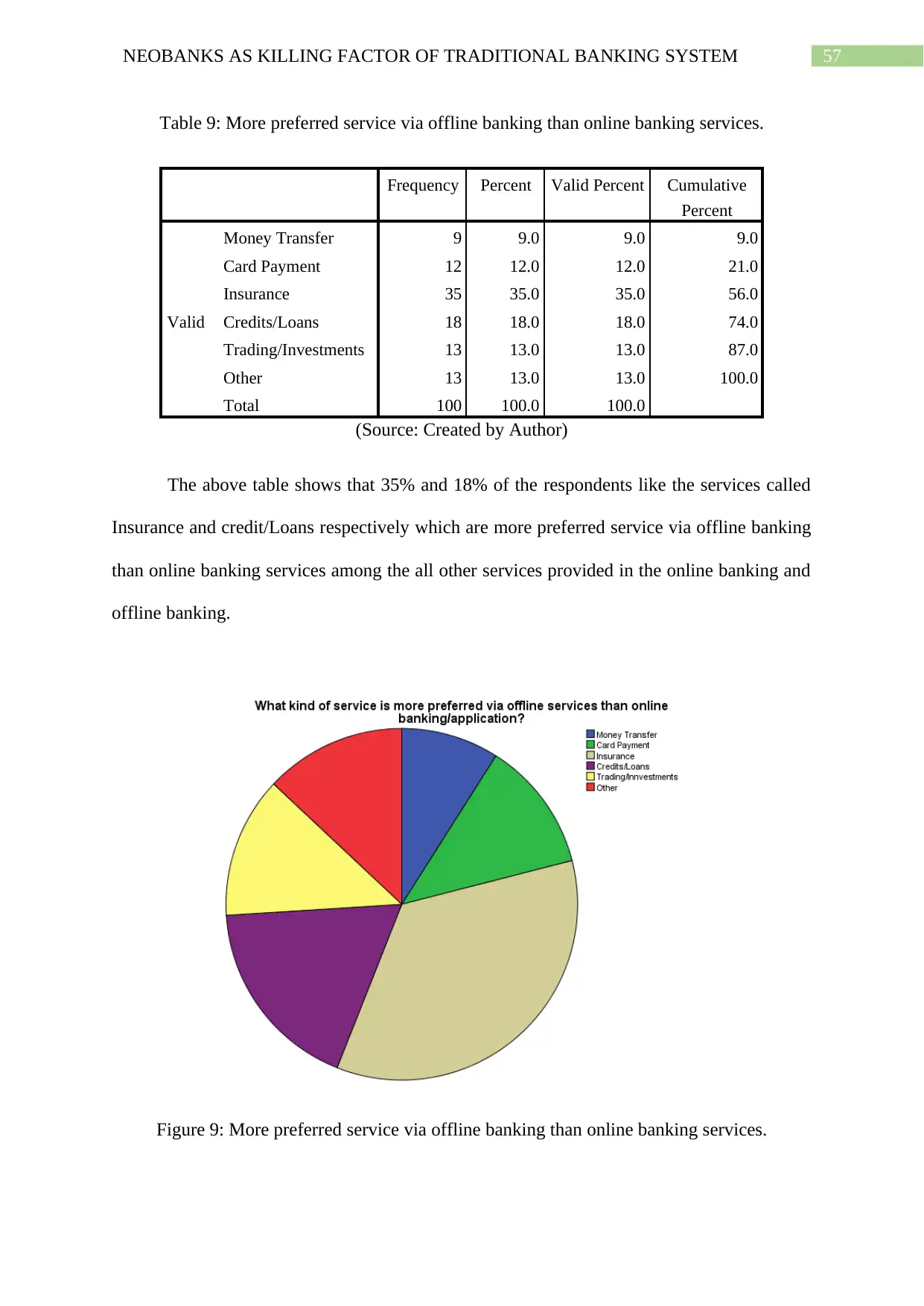
57NEOBANKS AS KILLING FACTOR OF TRADITIONAL BANKING SYSTEM
Table 9: More preferred service via offline banking than online banking services.
Frequency Percent Valid Percent Cumulative
Percent
Valid
Money Transfer 9 9.0 9.0 9.0
Card Payment 12 12.0 12.0 21.0
Insurance 35 35.0 35.0 56.0
Credits/Loans 18 18.0 18.0 74.0
Trading/Investments 13 13.0 13.0 87.0
Other 13 13.0 13.0 100.0
Total 100 100.0 100.0
(Source: Created by Author)
The above table shows that 35% and 18% of the respondents like the services called
Insurance and credit/Loans respectively which are more preferred service via offline banking
than online banking services among the all other services provided in the online banking and
offline banking.
Figure 9: More preferred service via offline banking than online banking services.
Table 9: More preferred service via offline banking than online banking services.
Frequency Percent Valid Percent Cumulative
Percent
Valid
Money Transfer 9 9.0 9.0 9.0
Card Payment 12 12.0 12.0 21.0
Insurance 35 35.0 35.0 56.0
Credits/Loans 18 18.0 18.0 74.0
Trading/Investments 13 13.0 13.0 87.0
Other 13 13.0 13.0 100.0
Total 100 100.0 100.0
(Source: Created by Author)
The above table shows that 35% and 18% of the respondents like the services called
Insurance and credit/Loans respectively which are more preferred service via offline banking
than online banking services among the all other services provided in the online banking and
offline banking.
Figure 9: More preferred service via offline banking than online banking services.
Secure Best Marks with AI Grader
Need help grading? Try our AI Grader for instant feedback on your assignments.
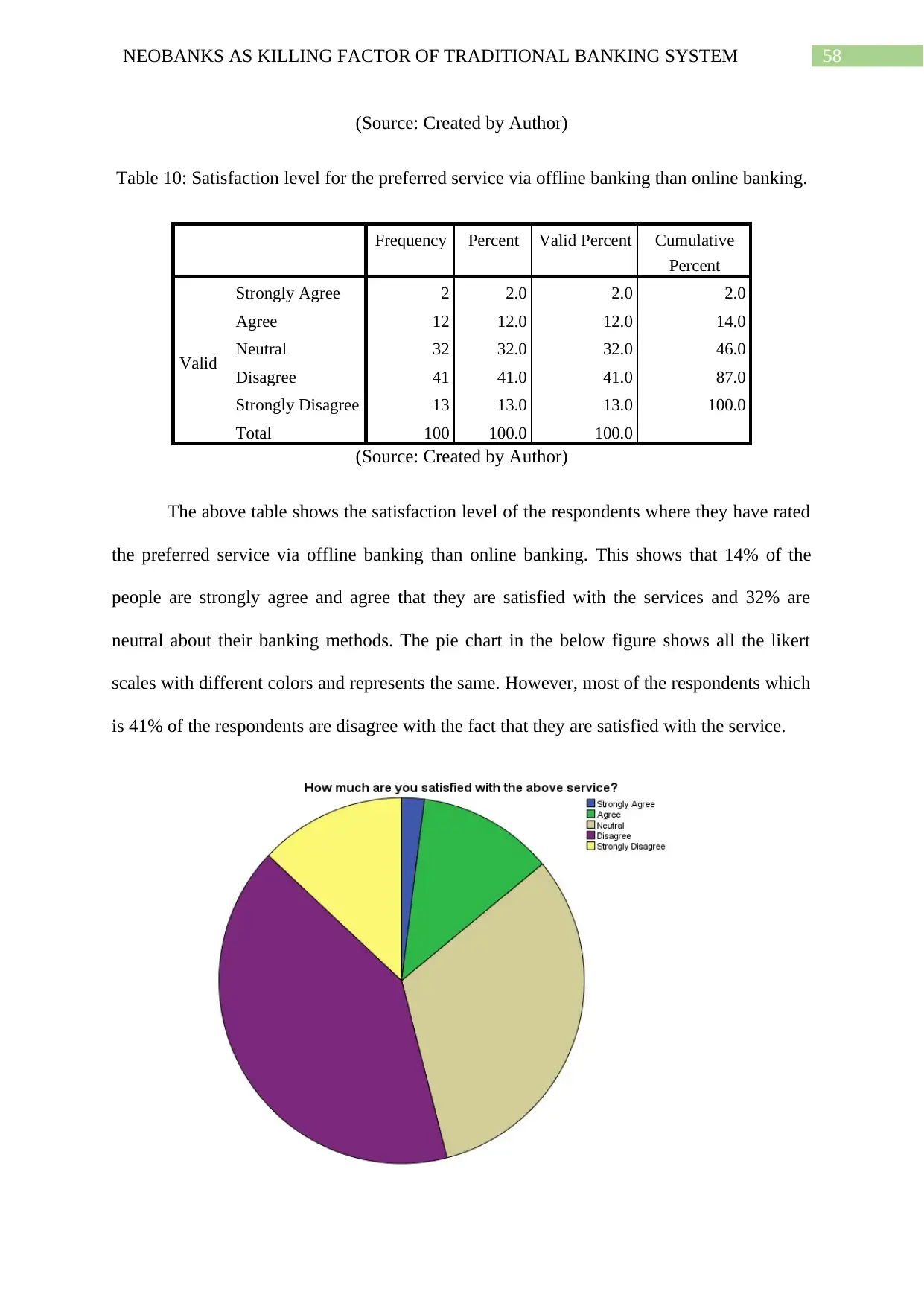
58NEOBANKS AS KILLING FACTOR OF TRADITIONAL BANKING SYSTEM
(Source: Created by Author)
Table 10: Satisfaction level for the preferred service via offline banking than online banking.
Frequency Percent Valid Percent Cumulative
Percent
Valid
Strongly Agree 2 2.0 2.0 2.0
Agree 12 12.0 12.0 14.0
Neutral 32 32.0 32.0 46.0
Disagree 41 41.0 41.0 87.0
Strongly Disagree 13 13.0 13.0 100.0
Total 100 100.0 100.0
(Source: Created by Author)
The above table shows the satisfaction level of the respondents where they have rated
the preferred service via offline banking than online banking. This shows that 14% of the
people are strongly agree and agree that they are satisfied with the services and 32% are
neutral about their banking methods. The pie chart in the below figure shows all the likert
scales with different colors and represents the same. However, most of the respondents which
is 41% of the respondents are disagree with the fact that they are satisfied with the service.
(Source: Created by Author)
Table 10: Satisfaction level for the preferred service via offline banking than online banking.
Frequency Percent Valid Percent Cumulative
Percent
Valid
Strongly Agree 2 2.0 2.0 2.0
Agree 12 12.0 12.0 14.0
Neutral 32 32.0 32.0 46.0
Disagree 41 41.0 41.0 87.0
Strongly Disagree 13 13.0 13.0 100.0
Total 100 100.0 100.0
(Source: Created by Author)
The above table shows the satisfaction level of the respondents where they have rated
the preferred service via offline banking than online banking. This shows that 14% of the
people are strongly agree and agree that they are satisfied with the services and 32% are
neutral about their banking methods. The pie chart in the below figure shows all the likert
scales with different colors and represents the same. However, most of the respondents which
is 41% of the respondents are disagree with the fact that they are satisfied with the service.
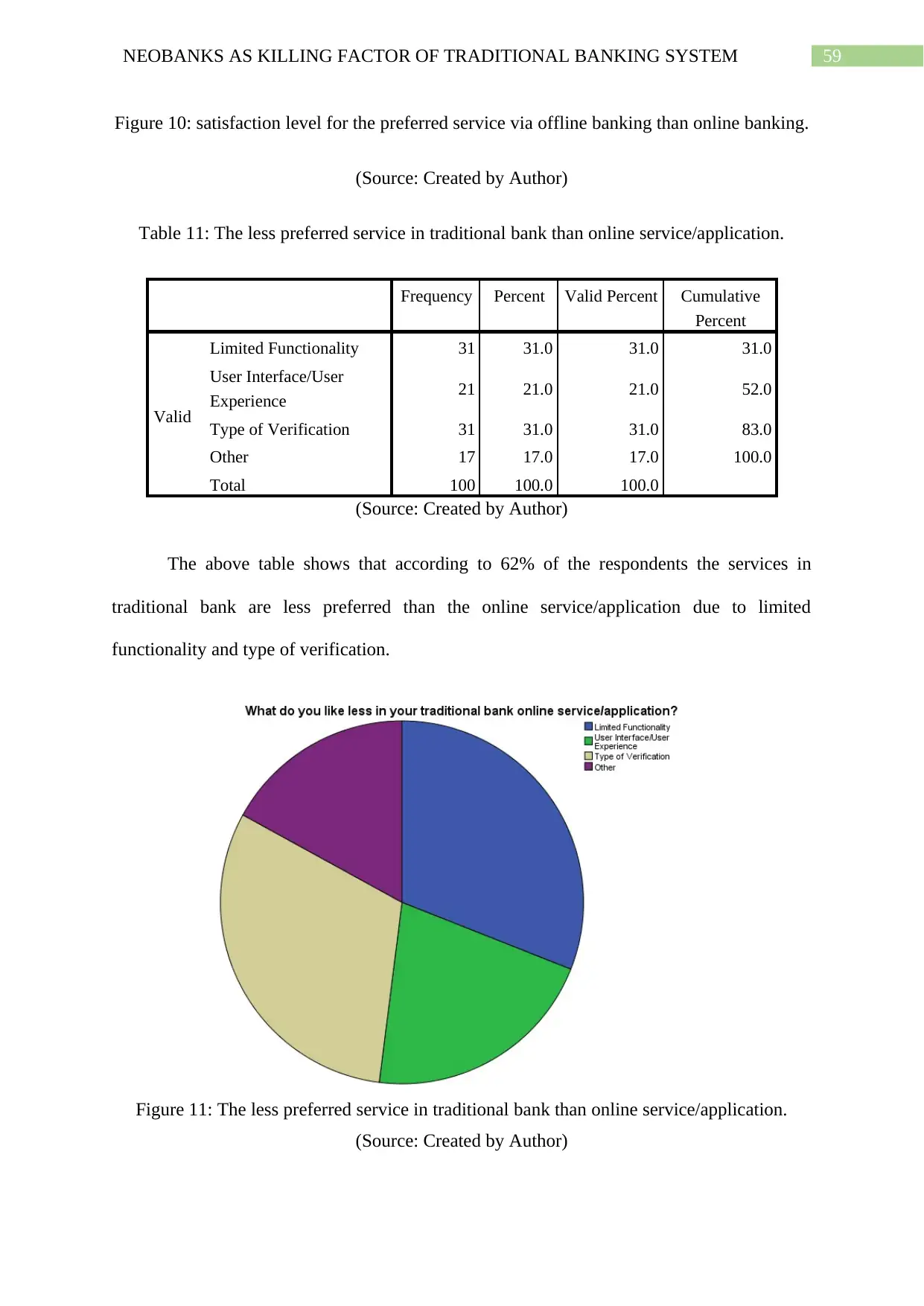
59NEOBANKS AS KILLING FACTOR OF TRADITIONAL BANKING SYSTEM
Figure 10: satisfaction level for the preferred service via offline banking than online banking.
(Source: Created by Author)
Table 11: The less preferred service in traditional bank than online service/application.
Frequency Percent Valid Percent Cumulative
Percent
Valid
Limited Functionality 31 31.0 31.0 31.0
User Interface/User
Experience 21 21.0 21.0 52.0
Type of Verification 31 31.0 31.0 83.0
Other 17 17.0 17.0 100.0
Total 100 100.0 100.0
(Source: Created by Author)
The above table shows that according to 62% of the respondents the services in
traditional bank are less preferred than the online service/application due to limited
functionality and type of verification.
Figure 11: The less preferred service in traditional bank than online service/application.
(Source: Created by Author)
Figure 10: satisfaction level for the preferred service via offline banking than online banking.
(Source: Created by Author)
Table 11: The less preferred service in traditional bank than online service/application.
Frequency Percent Valid Percent Cumulative
Percent
Valid
Limited Functionality 31 31.0 31.0 31.0
User Interface/User
Experience 21 21.0 21.0 52.0
Type of Verification 31 31.0 31.0 83.0
Other 17 17.0 17.0 100.0
Total 100 100.0 100.0
(Source: Created by Author)
The above table shows that according to 62% of the respondents the services in
traditional bank are less preferred than the online service/application due to limited
functionality and type of verification.
Figure 11: The less preferred service in traditional bank than online service/application.
(Source: Created by Author)
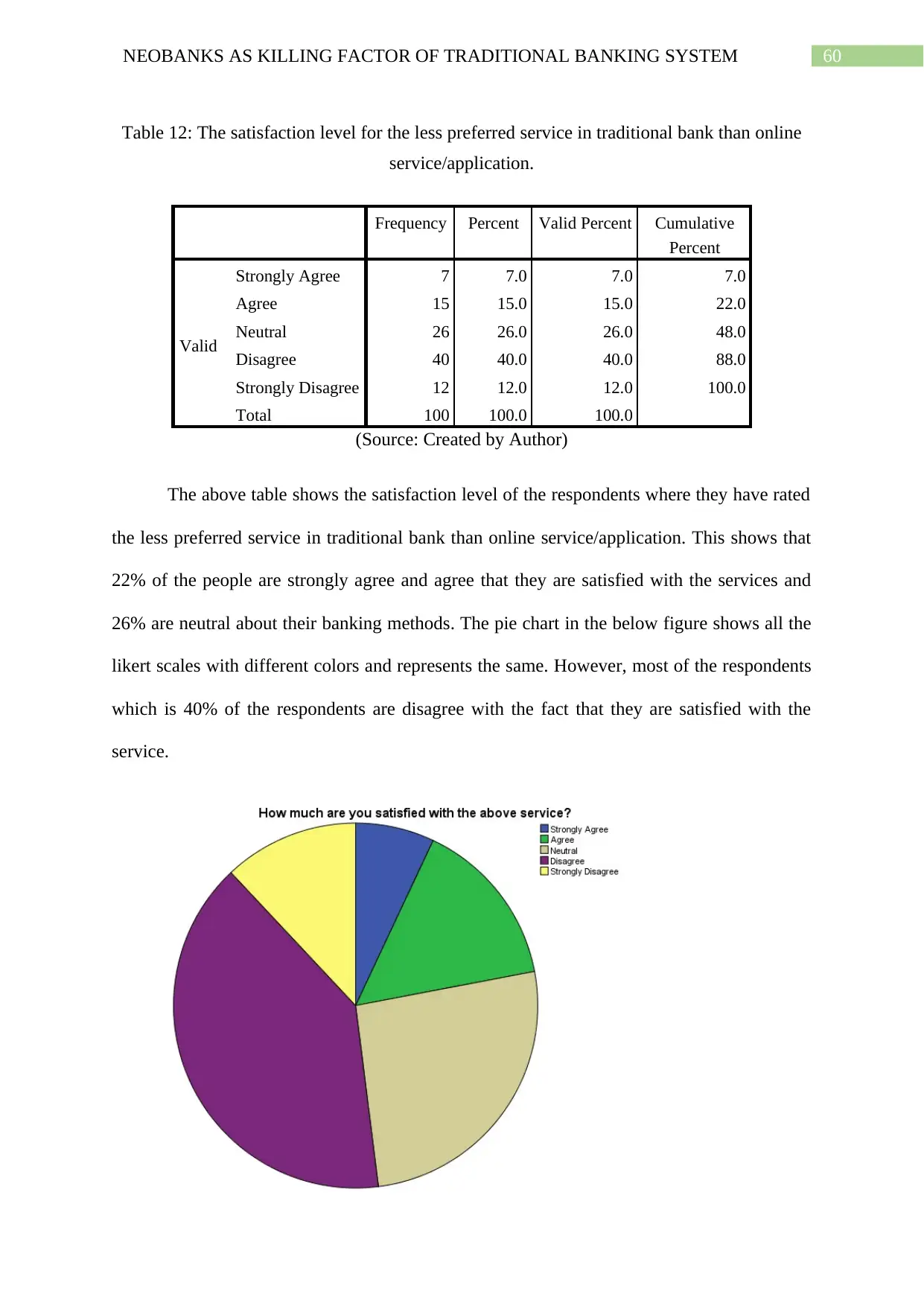
60NEOBANKS AS KILLING FACTOR OF TRADITIONAL BANKING SYSTEM
Table 12: The satisfaction level for the less preferred service in traditional bank than online
service/application.
Frequency Percent Valid Percent Cumulative
Percent
Valid
Strongly Agree 7 7.0 7.0 7.0
Agree 15 15.0 15.0 22.0
Neutral 26 26.0 26.0 48.0
Disagree 40 40.0 40.0 88.0
Strongly Disagree 12 12.0 12.0 100.0
Total 100 100.0 100.0
(Source: Created by Author)
The above table shows the satisfaction level of the respondents where they have rated
the less preferred service in traditional bank than online service/application. This shows that
22% of the people are strongly agree and agree that they are satisfied with the services and
26% are neutral about their banking methods. The pie chart in the below figure shows all the
likert scales with different colors and represents the same. However, most of the respondents
which is 40% of the respondents are disagree with the fact that they are satisfied with the
service.
Table 12: The satisfaction level for the less preferred service in traditional bank than online
service/application.
Frequency Percent Valid Percent Cumulative
Percent
Valid
Strongly Agree 7 7.0 7.0 7.0
Agree 15 15.0 15.0 22.0
Neutral 26 26.0 26.0 48.0
Disagree 40 40.0 40.0 88.0
Strongly Disagree 12 12.0 12.0 100.0
Total 100 100.0 100.0
(Source: Created by Author)
The above table shows the satisfaction level of the respondents where they have rated
the less preferred service in traditional bank than online service/application. This shows that
22% of the people are strongly agree and agree that they are satisfied with the services and
26% are neutral about their banking methods. The pie chart in the below figure shows all the
likert scales with different colors and represents the same. However, most of the respondents
which is 40% of the respondents are disagree with the fact that they are satisfied with the
service.
Paraphrase This Document
Need a fresh take? Get an instant paraphrase of this document with our AI Paraphraser
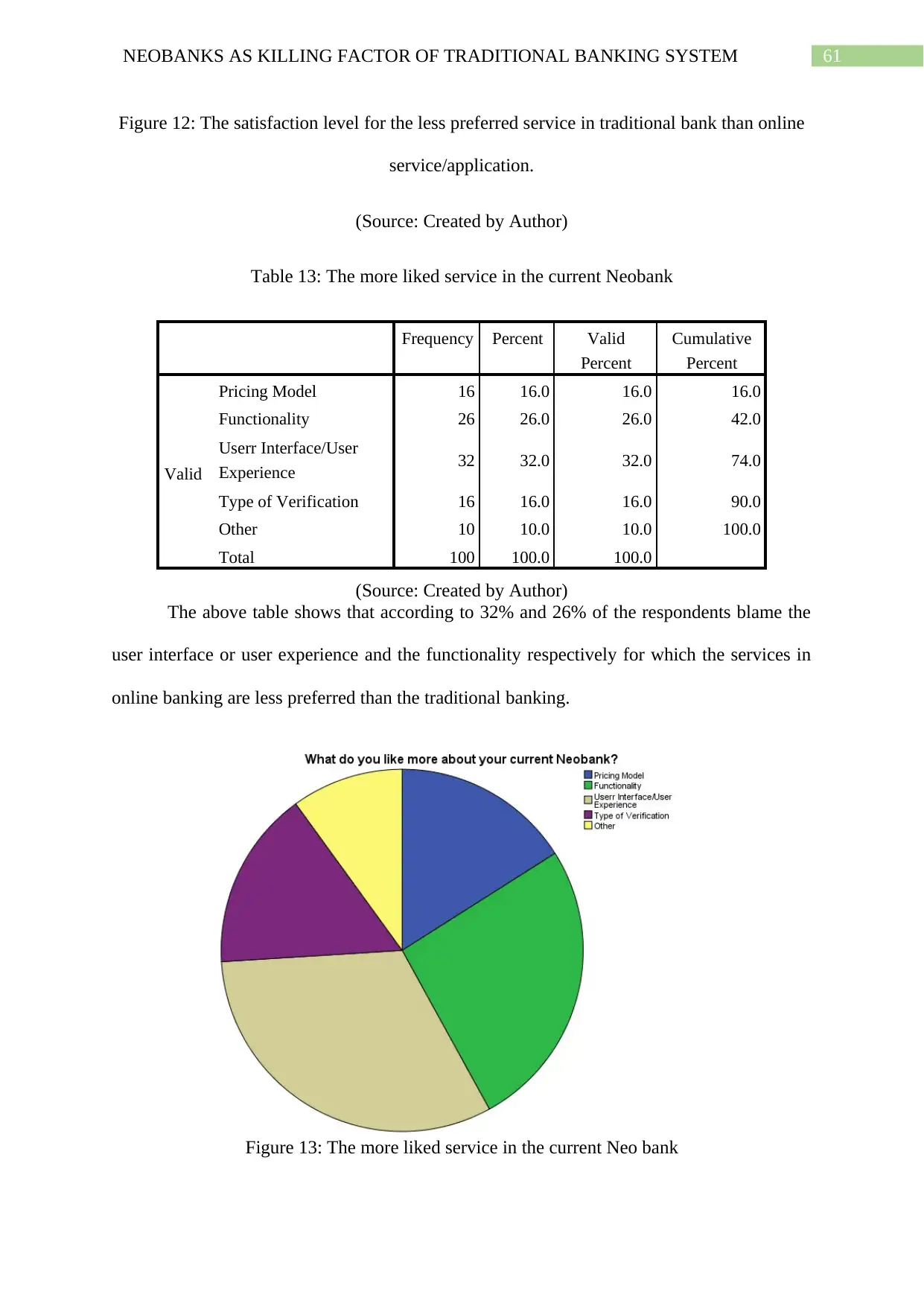
61NEOBANKS AS KILLING FACTOR OF TRADITIONAL BANKING SYSTEM
Figure 12: The satisfaction level for the less preferred service in traditional bank than online
service/application.
(Source: Created by Author)
Table 13: The more liked service in the current Neobank
Frequency Percent Valid
Percent
Cumulative
Percent
Valid
Pricing Model 16 16.0 16.0 16.0
Functionality 26 26.0 26.0 42.0
Userr Interface/User
Experience 32 32.0 32.0 74.0
Type of Verification 16 16.0 16.0 90.0
Other 10 10.0 10.0 100.0
Total 100 100.0 100.0
(Source: Created by Author)
The above table shows that according to 32% and 26% of the respondents blame the
user interface or user experience and the functionality respectively for which the services in
online banking are less preferred than the traditional banking.
Figure 13: The more liked service in the current Neo bank
Figure 12: The satisfaction level for the less preferred service in traditional bank than online
service/application.
(Source: Created by Author)
Table 13: The more liked service in the current Neobank
Frequency Percent Valid
Percent
Cumulative
Percent
Valid
Pricing Model 16 16.0 16.0 16.0
Functionality 26 26.0 26.0 42.0
Userr Interface/User
Experience 32 32.0 32.0 74.0
Type of Verification 16 16.0 16.0 90.0
Other 10 10.0 10.0 100.0
Total 100 100.0 100.0
(Source: Created by Author)
The above table shows that according to 32% and 26% of the respondents blame the
user interface or user experience and the functionality respectively for which the services in
online banking are less preferred than the traditional banking.
Figure 13: The more liked service in the current Neo bank
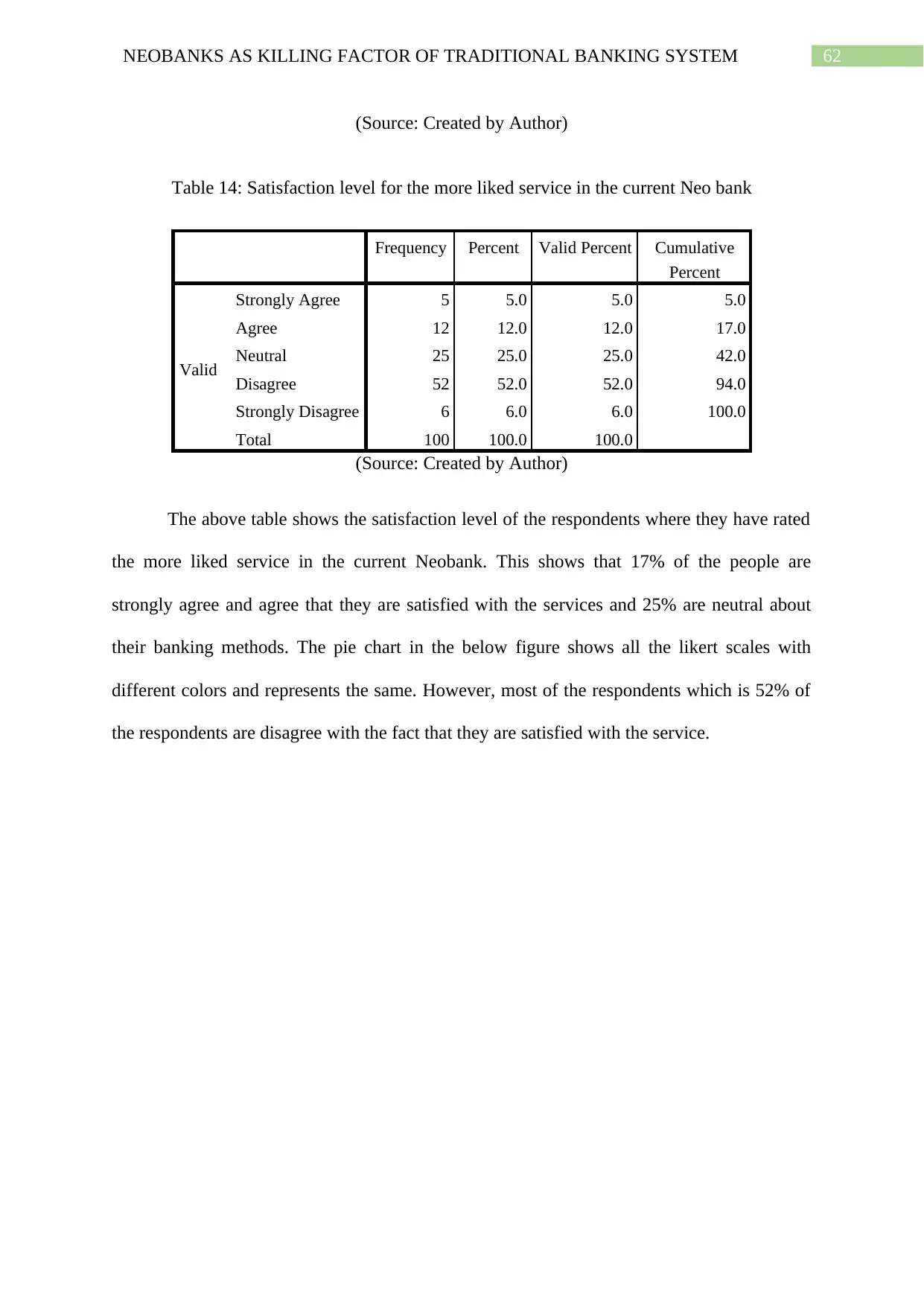
62NEOBANKS AS KILLING FACTOR OF TRADITIONAL BANKING SYSTEM
(Source: Created by Author)
Table 14: Satisfaction level for the more liked service in the current Neo bank
Frequency Percent Valid Percent Cumulative
Percent
Valid
Strongly Agree 5 5.0 5.0 5.0
Agree 12 12.0 12.0 17.0
Neutral 25 25.0 25.0 42.0
Disagree 52 52.0 52.0 94.0
Strongly Disagree 6 6.0 6.0 100.0
Total 100 100.0 100.0
(Source: Created by Author)
The above table shows the satisfaction level of the respondents where they have rated
the more liked service in the current Neobank. This shows that 17% of the people are
strongly agree and agree that they are satisfied with the services and 25% are neutral about
their banking methods. The pie chart in the below figure shows all the likert scales with
different colors and represents the same. However, most of the respondents which is 52% of
the respondents are disagree with the fact that they are satisfied with the service.
(Source: Created by Author)
Table 14: Satisfaction level for the more liked service in the current Neo bank
Frequency Percent Valid Percent Cumulative
Percent
Valid
Strongly Agree 5 5.0 5.0 5.0
Agree 12 12.0 12.0 17.0
Neutral 25 25.0 25.0 42.0
Disagree 52 52.0 52.0 94.0
Strongly Disagree 6 6.0 6.0 100.0
Total 100 100.0 100.0
(Source: Created by Author)
The above table shows the satisfaction level of the respondents where they have rated
the more liked service in the current Neobank. This shows that 17% of the people are
strongly agree and agree that they are satisfied with the services and 25% are neutral about
their banking methods. The pie chart in the below figure shows all the likert scales with
different colors and represents the same. However, most of the respondents which is 52% of
the respondents are disagree with the fact that they are satisfied with the service.
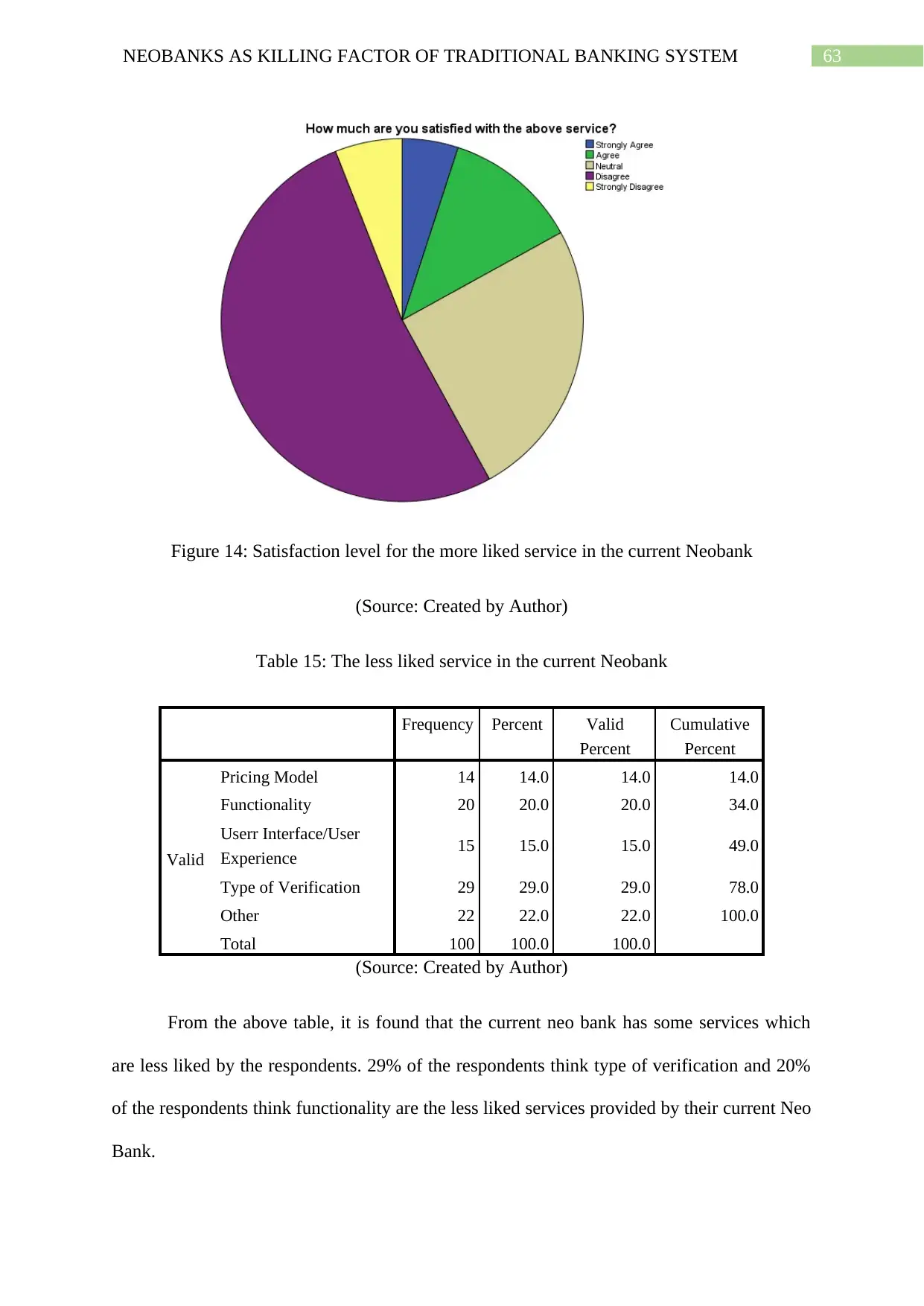
63NEOBANKS AS KILLING FACTOR OF TRADITIONAL BANKING SYSTEM
Figure 14: Satisfaction level for the more liked service in the current Neobank
(Source: Created by Author)
Table 15: The less liked service in the current Neobank
Frequency Percent Valid
Percent
Cumulative
Percent
Valid
Pricing Model 14 14.0 14.0 14.0
Functionality 20 20.0 20.0 34.0
Userr Interface/User
Experience 15 15.0 15.0 49.0
Type of Verification 29 29.0 29.0 78.0
Other 22 22.0 22.0 100.0
Total 100 100.0 100.0
(Source: Created by Author)
From the above table, it is found that the current neo bank has some services which
are less liked by the respondents. 29% of the respondents think type of verification and 20%
of the respondents think functionality are the less liked services provided by their current Neo
Bank.
Figure 14: Satisfaction level for the more liked service in the current Neobank
(Source: Created by Author)
Table 15: The less liked service in the current Neobank
Frequency Percent Valid
Percent
Cumulative
Percent
Valid
Pricing Model 14 14.0 14.0 14.0
Functionality 20 20.0 20.0 34.0
Userr Interface/User
Experience 15 15.0 15.0 49.0
Type of Verification 29 29.0 29.0 78.0
Other 22 22.0 22.0 100.0
Total 100 100.0 100.0
(Source: Created by Author)
From the above table, it is found that the current neo bank has some services which
are less liked by the respondents. 29% of the respondents think type of verification and 20%
of the respondents think functionality are the less liked services provided by their current Neo
Bank.
Secure Best Marks with AI Grader
Need help grading? Try our AI Grader for instant feedback on your assignments.

64NEOBANKS AS KILLING FACTOR OF TRADITIONAL BANKING SYSTEM
Figure 15: The less liked service in the current Neobank.
(Source: Created by Author)
Table 16: Satisfaction level for the less liked service in the current Neobank.
Frequency Percent Valid Percent Cumulative
Percent
Valid
Strongly Agree 3 3.0 3.0 3.0
Agree 13 13.0 13.0 16.0
Neutral 36 36.0 36.0 52.0
Disagree 38 38.0 38.0 90.0
Strongly Disagree 10 10.0 10.0 100.0
Total 100 100.0 100.0
(Source: Created by Author)
The above table shows the satisfaction level of the respondents where they have rated
the more liked service in the current Neobank. This shows that 16% of the people are
strongly agree and agree that they are satisfied with the services and 36% are neutral about
their banking methods. The pie chart in the below figure shows all the likert scales with
different colors and represents the same. However, most of the respondents which is 38% of
the respondents are disagree with the fact that they are satisfied with the service.
Figure 15: The less liked service in the current Neobank.
(Source: Created by Author)
Table 16: Satisfaction level for the less liked service in the current Neobank.
Frequency Percent Valid Percent Cumulative
Percent
Valid
Strongly Agree 3 3.0 3.0 3.0
Agree 13 13.0 13.0 16.0
Neutral 36 36.0 36.0 52.0
Disagree 38 38.0 38.0 90.0
Strongly Disagree 10 10.0 10.0 100.0
Total 100 100.0 100.0
(Source: Created by Author)
The above table shows the satisfaction level of the respondents where they have rated
the more liked service in the current Neobank. This shows that 16% of the people are
strongly agree and agree that they are satisfied with the services and 36% are neutral about
their banking methods. The pie chart in the below figure shows all the likert scales with
different colors and represents the same. However, most of the respondents which is 38% of
the respondents are disagree with the fact that they are satisfied with the service.
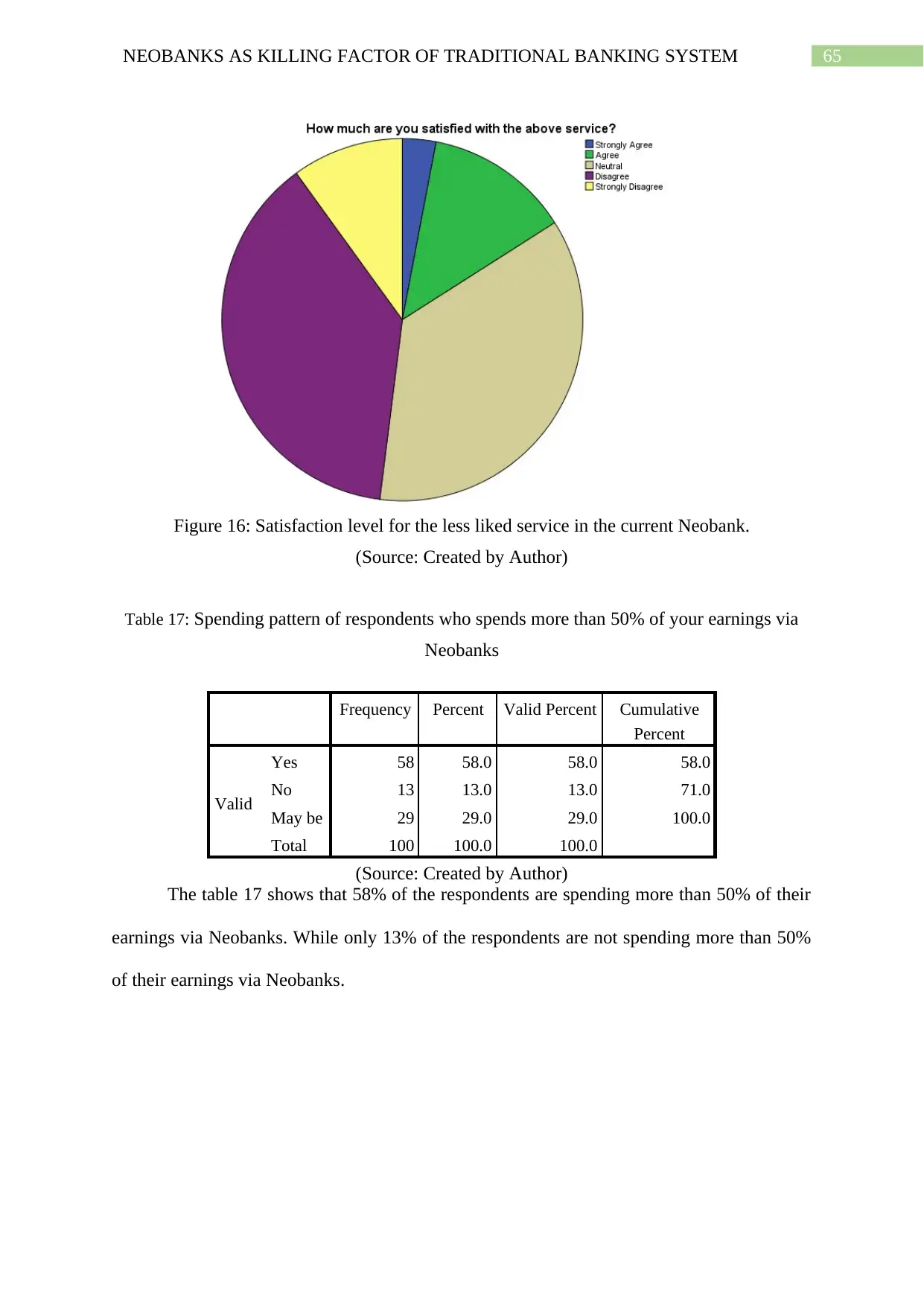
65NEOBANKS AS KILLING FACTOR OF TRADITIONAL BANKING SYSTEM
Figure 16: Satisfaction level for the less liked service in the current Neobank.
(Source: Created by Author)
Table 17: Spending pattern of respondents who spends more than 50% of your earnings via
Neobanks
Frequency Percent Valid Percent Cumulative
Percent
Valid
Yes 58 58.0 58.0 58.0
No 13 13.0 13.0 71.0
May be 29 29.0 29.0 100.0
Total 100 100.0 100.0
(Source: Created by Author)
The table 17 shows that 58% of the respondents are spending more than 50% of their
earnings via Neobanks. While only 13% of the respondents are not spending more than 50%
of their earnings via Neobanks.
Figure 16: Satisfaction level for the less liked service in the current Neobank.
(Source: Created by Author)
Table 17: Spending pattern of respondents who spends more than 50% of your earnings via
Neobanks
Frequency Percent Valid Percent Cumulative
Percent
Valid
Yes 58 58.0 58.0 58.0
No 13 13.0 13.0 71.0
May be 29 29.0 29.0 100.0
Total 100 100.0 100.0
(Source: Created by Author)
The table 17 shows that 58% of the respondents are spending more than 50% of their
earnings via Neobanks. While only 13% of the respondents are not spending more than 50%
of their earnings via Neobanks.
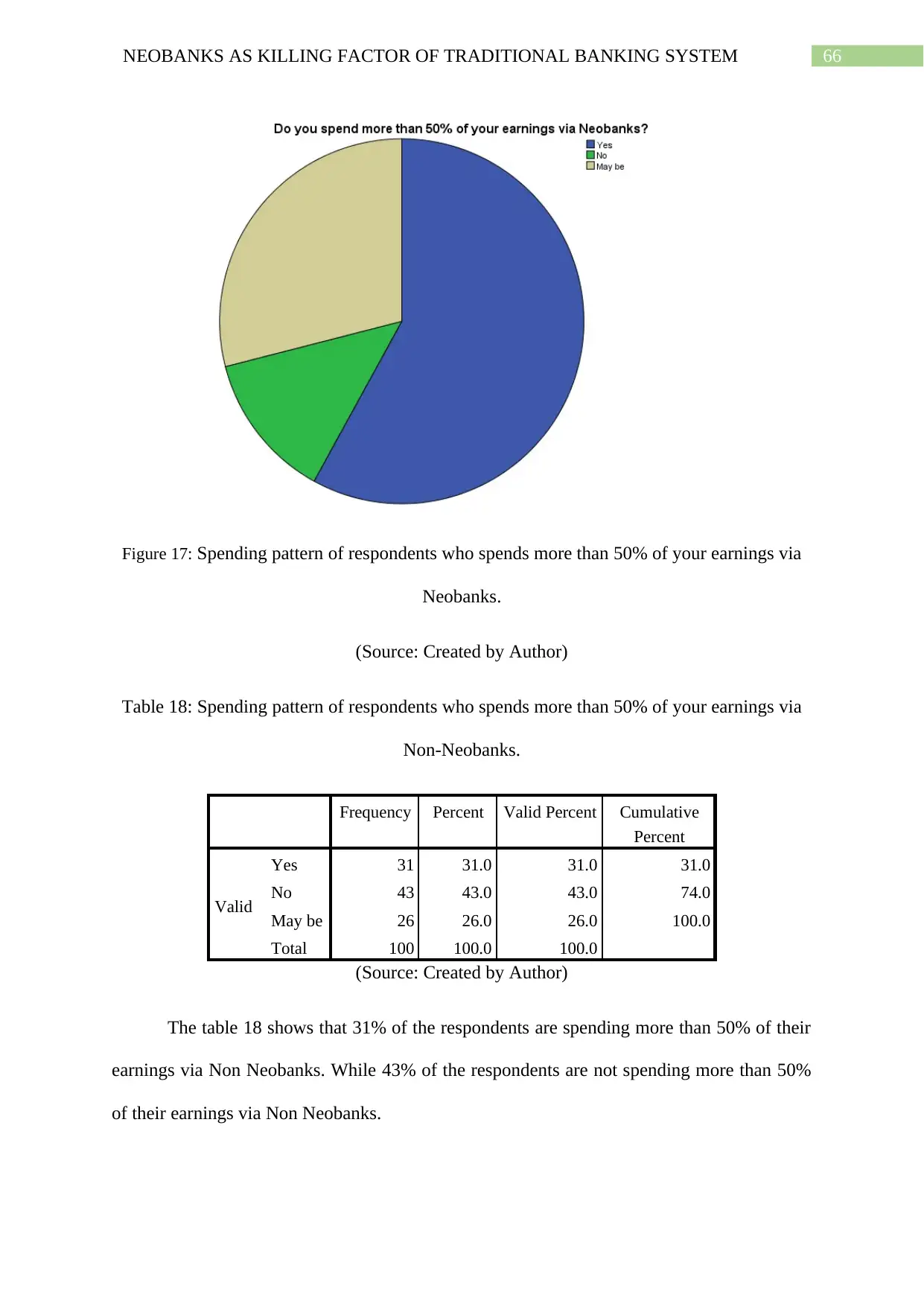
66NEOBANKS AS KILLING FACTOR OF TRADITIONAL BANKING SYSTEM
Figure 17: Spending pattern of respondents who spends more than 50% of your earnings via
Neobanks.
(Source: Created by Author)
Table 18: Spending pattern of respondents who spends more than 50% of your earnings via
Non-Neobanks.
Frequency Percent Valid Percent Cumulative
Percent
Valid
Yes 31 31.0 31.0 31.0
No 43 43.0 43.0 74.0
May be 26 26.0 26.0 100.0
Total 100 100.0 100.0
(Source: Created by Author)
The table 18 shows that 31% of the respondents are spending more than 50% of their
earnings via Non Neobanks. While 43% of the respondents are not spending more than 50%
of their earnings via Non Neobanks.
Figure 17: Spending pattern of respondents who spends more than 50% of your earnings via
Neobanks.
(Source: Created by Author)
Table 18: Spending pattern of respondents who spends more than 50% of your earnings via
Non-Neobanks.
Frequency Percent Valid Percent Cumulative
Percent
Valid
Yes 31 31.0 31.0 31.0
No 43 43.0 43.0 74.0
May be 26 26.0 26.0 100.0
Total 100 100.0 100.0
(Source: Created by Author)
The table 18 shows that 31% of the respondents are spending more than 50% of their
earnings via Non Neobanks. While 43% of the respondents are not spending more than 50%
of their earnings via Non Neobanks.
Paraphrase This Document
Need a fresh take? Get an instant paraphrase of this document with our AI Paraphraser
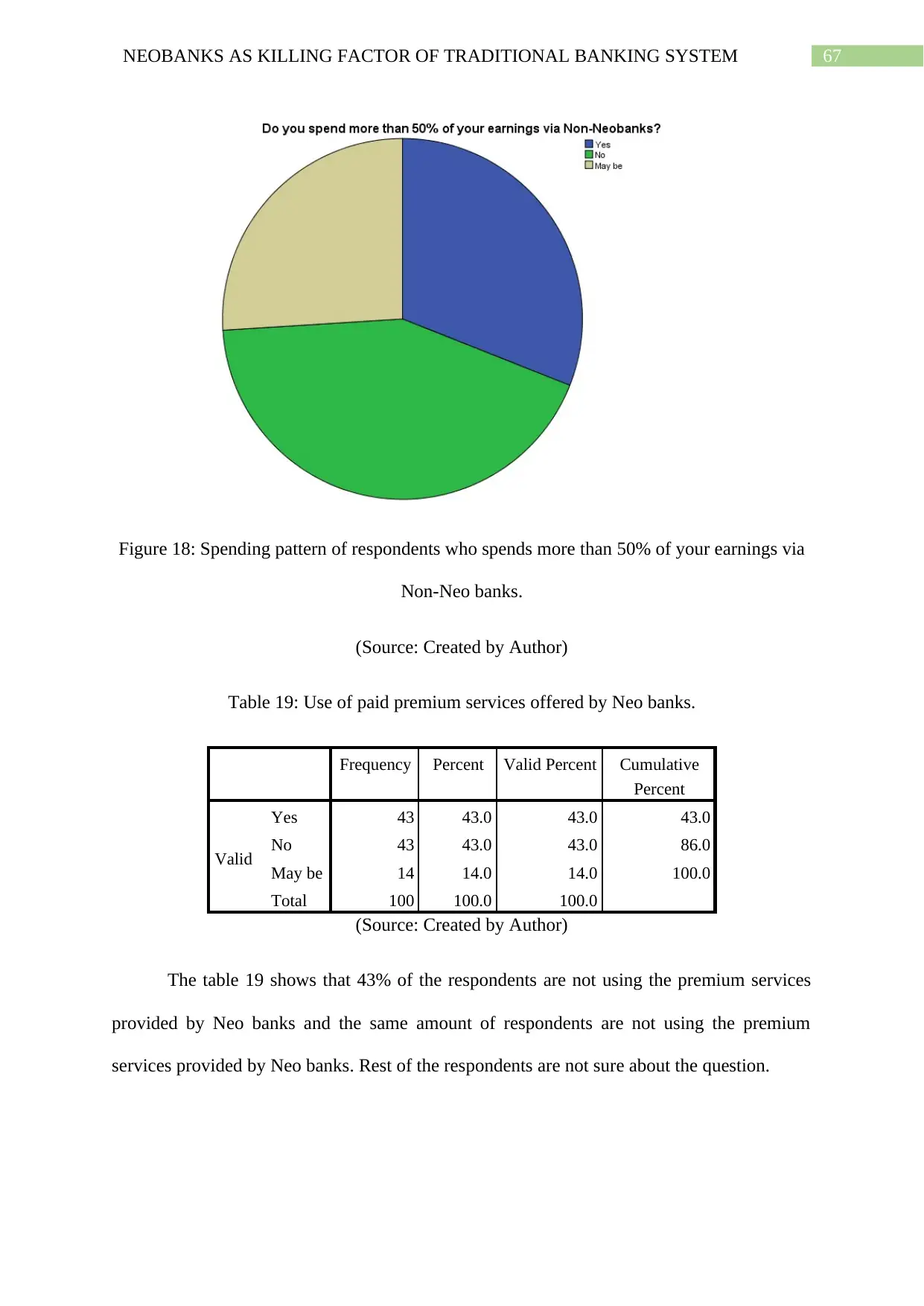
67NEOBANKS AS KILLING FACTOR OF TRADITIONAL BANKING SYSTEM
Figure 18: Spending pattern of respondents who spends more than 50% of your earnings via
Non-Neo banks.
(Source: Created by Author)
Table 19: Use of paid premium services offered by Neo banks.
Frequency Percent Valid Percent Cumulative
Percent
Valid
Yes 43 43.0 43.0 43.0
No 43 43.0 43.0 86.0
May be 14 14.0 14.0 100.0
Total 100 100.0 100.0
(Source: Created by Author)
The table 19 shows that 43% of the respondents are not using the premium services
provided by Neo banks and the same amount of respondents are not using the premium
services provided by Neo banks. Rest of the respondents are not sure about the question.
Figure 18: Spending pattern of respondents who spends more than 50% of your earnings via
Non-Neo banks.
(Source: Created by Author)
Table 19: Use of paid premium services offered by Neo banks.
Frequency Percent Valid Percent Cumulative
Percent
Valid
Yes 43 43.0 43.0 43.0
No 43 43.0 43.0 86.0
May be 14 14.0 14.0 100.0
Total 100 100.0 100.0
(Source: Created by Author)
The table 19 shows that 43% of the respondents are not using the premium services
provided by Neo banks and the same amount of respondents are not using the premium
services provided by Neo banks. Rest of the respondents are not sure about the question.
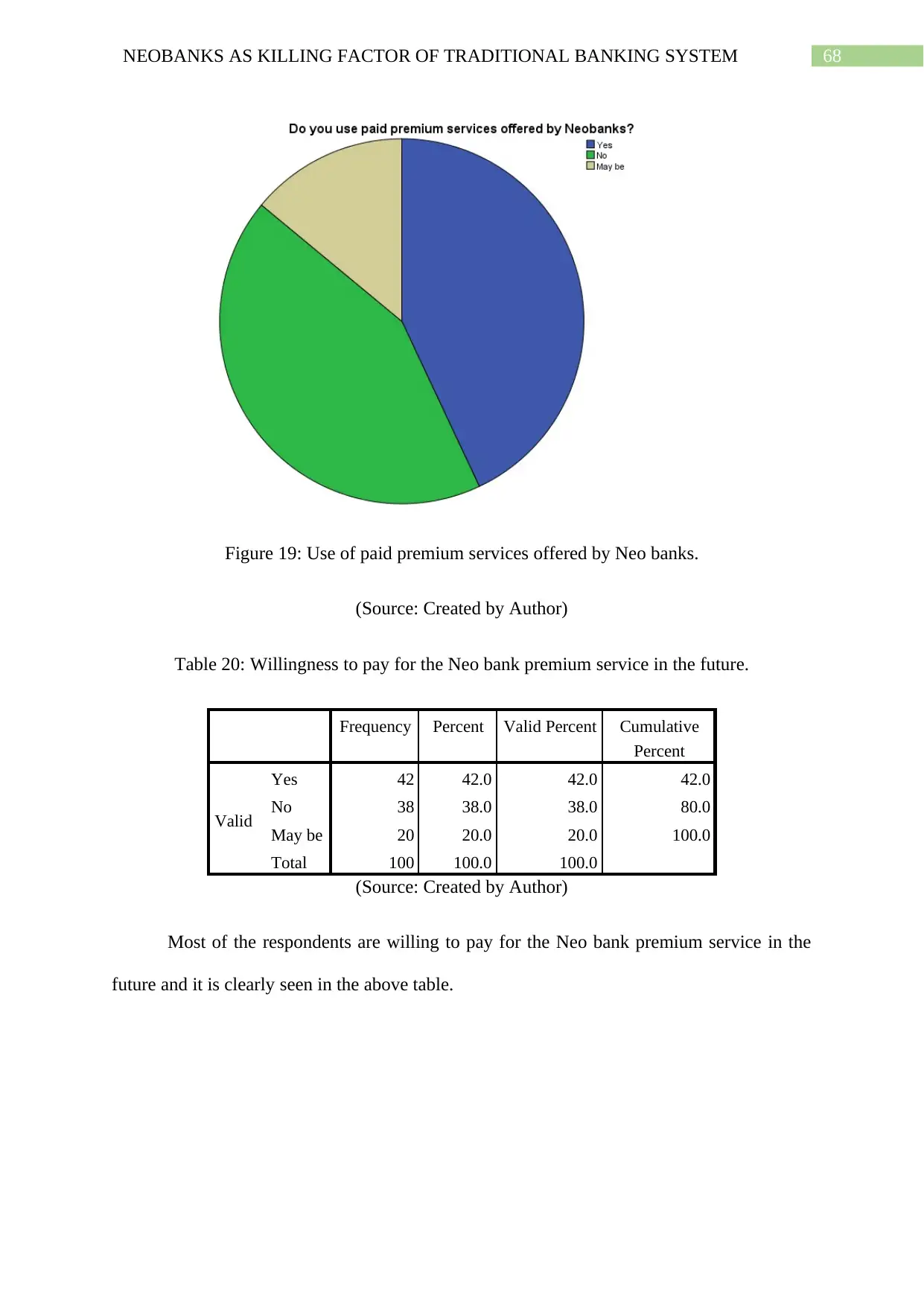
68NEOBANKS AS KILLING FACTOR OF TRADITIONAL BANKING SYSTEM
Figure 19: Use of paid premium services offered by Neo banks.
(Source: Created by Author)
Table 20: Willingness to pay for the Neo bank premium service in the future.
Frequency Percent Valid Percent Cumulative
Percent
Valid
Yes 42 42.0 42.0 42.0
No 38 38.0 38.0 80.0
May be 20 20.0 20.0 100.0
Total 100 100.0 100.0
(Source: Created by Author)
Most of the respondents are willing to pay for the Neo bank premium service in the
future and it is clearly seen in the above table.
Figure 19: Use of paid premium services offered by Neo banks.
(Source: Created by Author)
Table 20: Willingness to pay for the Neo bank premium service in the future.
Frequency Percent Valid Percent Cumulative
Percent
Valid
Yes 42 42.0 42.0 42.0
No 38 38.0 38.0 80.0
May be 20 20.0 20.0 100.0
Total 100 100.0 100.0
(Source: Created by Author)
Most of the respondents are willing to pay for the Neo bank premium service in the
future and it is clearly seen in the above table.

69NEOBANKS AS KILLING FACTOR OF TRADITIONAL BANKING SYSTEM
Figure 20: Willingness to pay for the Neobank premium service in the future.
(Source: Created by Author)
Now, the tests that are conducted to support the answers of the major research
questions, are conducted to find the most appropriate answers. These tests are associated with
the responses that are collected from the survey on the basis of the questionnaire. Here, the
hypothesis is developed to know the statistical significance of the responses that whatever the
response is recorded from the participants are significant. Thus, it can be said that there is a
significant difference among the choices and have certain level of statistical significance. The
results will be helpful to answer the research questions. Now, the hypothesis on which the
tests are conducted, are discussed one by one and the test results are also presented along
with the tests:
Table B: Summary of test results.
Test Statistics Chi-
Square df
Asymp.
Sig.
What kind of services is more preferred by you at the
time of offline banking/application? 5.960a 5 0.3101
How much are you satisfied with the above service? 44.800b 4 0.0000
Figure 20: Willingness to pay for the Neobank premium service in the future.
(Source: Created by Author)
Now, the tests that are conducted to support the answers of the major research
questions, are conducted to find the most appropriate answers. These tests are associated with
the responses that are collected from the survey on the basis of the questionnaire. Here, the
hypothesis is developed to know the statistical significance of the responses that whatever the
response is recorded from the participants are significant. Thus, it can be said that there is a
significant difference among the choices and have certain level of statistical significance. The
results will be helpful to answer the research questions. Now, the hypothesis on which the
tests are conducted, are discussed one by one and the test results are also presented along
with the tests:
Table B: Summary of test results.
Test Statistics Chi-
Square df
Asymp.
Sig.
What kind of services is more preferred by you at the
time of offline banking/application? 5.960a 5 0.3101
How much are you satisfied with the above service? 44.800b 4 0.0000
Secure Best Marks with AI Grader
Need help grading? Try our AI Grader for instant feedback on your assignments.

70NEOBANKS AS KILLING FACTOR OF TRADITIONAL BANKING SYSTEM
What kind of services is more preferred by you at the
time of online banking/application? 15.680a 5 0.0078
How much are you satisfied with the above service? 55.700b 4 0.0000
What kind of service is more preferred via online
banking/application than offline services? 13.040a 5 0.0230
How much are you satisfied with the above service? 88.300b 4 0.0000
What kind of service is more preferred via offline
services than online banking/application? 26.720a 5 0.0001
How much are you satisfied with the above service? 51.100b 4 0.0000
What do you like less in your traditional bank online
service/application? 6.080c 3 0.1078
How much are you satisfied with the above service? 34.700b 4 0.0000
What do you like more about your current Neobank? 15.600b 4 0.0036
How much are you satisfied with the above service? 76.700b 4 0.0000
What do you like less about your current Neobank? 7.300b 4 0.1209
How much are you satisfied with the above service? 50.900b 4 0.0000
Do you spend more than 50% of your earnings via
Neobanks? 31.220d 2 0.0000
Do you spend more than 50% of your earnings via Non-
Neobanks? 4.580d 2 0.1013
Do you use paid premium services offered by
Neobanks? 16.820d 2 0.0002
Are you willing to pay for the Neobank premium service
in the future? 8.240d 2 0.0162
a. 0 cells (0.0%) have expected frequencies less than 5. The minimum expected cell
frequency is 16.7.
b. 0 cells (0.0%) have expected frequencies less than 5. The minimum expected cell
frequency is 20.0.
c. 0 cells (0.0%) have expected frequencies less than 5. The minimum expected cell
frequency is 25.0.
d. 0 cells (0.0%) have expected frequencies less than 5. The minimum expected cell
frequency is 33.3.
(Source: Created by Author)
1. Test for preferred service at the time of offline banking
Null Hypothesis, H0: The services at the time of offline banking are equally used or
preferred.
Alternative Hypothesis, H1: The services at the time of offline banking are not equally used
or preferred.
Significance level: In this case, the level of significance is selected at 0.05 as the
research hypothesis wants to know the probability of choosing the banking method.
What kind of services is more preferred by you at the
time of online banking/application? 15.680a 5 0.0078
How much are you satisfied with the above service? 55.700b 4 0.0000
What kind of service is more preferred via online
banking/application than offline services? 13.040a 5 0.0230
How much are you satisfied with the above service? 88.300b 4 0.0000
What kind of service is more preferred via offline
services than online banking/application? 26.720a 5 0.0001
How much are you satisfied with the above service? 51.100b 4 0.0000
What do you like less in your traditional bank online
service/application? 6.080c 3 0.1078
How much are you satisfied with the above service? 34.700b 4 0.0000
What do you like more about your current Neobank? 15.600b 4 0.0036
How much are you satisfied with the above service? 76.700b 4 0.0000
What do you like less about your current Neobank? 7.300b 4 0.1209
How much are you satisfied with the above service? 50.900b 4 0.0000
Do you spend more than 50% of your earnings via
Neobanks? 31.220d 2 0.0000
Do you spend more than 50% of your earnings via Non-
Neobanks? 4.580d 2 0.1013
Do you use paid premium services offered by
Neobanks? 16.820d 2 0.0002
Are you willing to pay for the Neobank premium service
in the future? 8.240d 2 0.0162
a. 0 cells (0.0%) have expected frequencies less than 5. The minimum expected cell
frequency is 16.7.
b. 0 cells (0.0%) have expected frequencies less than 5. The minimum expected cell
frequency is 20.0.
c. 0 cells (0.0%) have expected frequencies less than 5. The minimum expected cell
frequency is 25.0.
d. 0 cells (0.0%) have expected frequencies less than 5. The minimum expected cell
frequency is 33.3.
(Source: Created by Author)
1. Test for preferred service at the time of offline banking
Null Hypothesis, H0: The services at the time of offline banking are equally used or
preferred.
Alternative Hypothesis, H1: The services at the time of offline banking are not equally used
or preferred.
Significance level: In this case, the level of significance is selected at 0.05 as the
research hypothesis wants to know the probability of choosing the banking method.
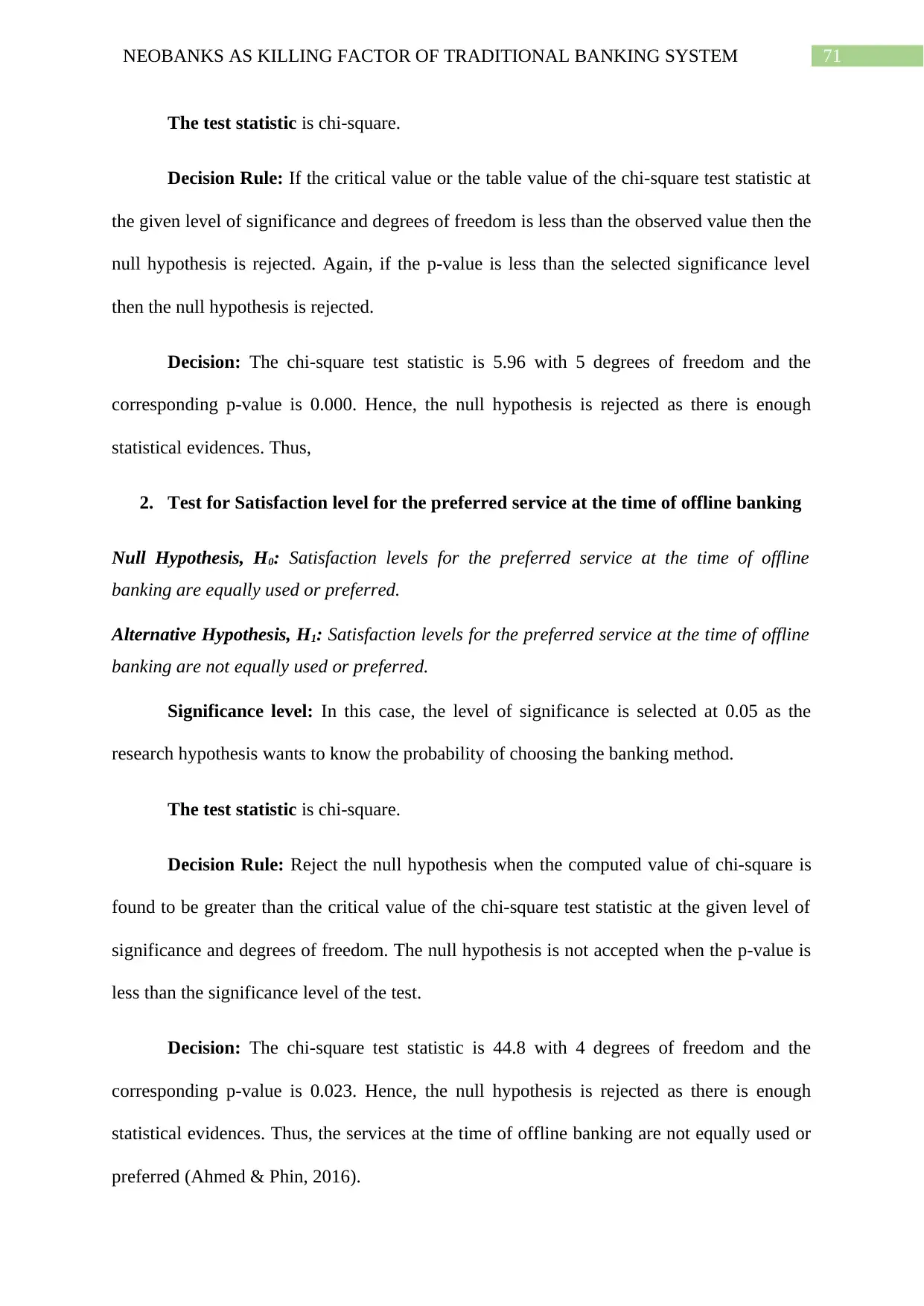
71NEOBANKS AS KILLING FACTOR OF TRADITIONAL BANKING SYSTEM
The test statistic is chi-square.
Decision Rule: If the critical value or the table value of the chi-square test statistic at
the given level of significance and degrees of freedom is less than the observed value then the
null hypothesis is rejected. Again, if the p-value is less than the selected significance level
then the null hypothesis is rejected.
Decision: The chi-square test statistic is 5.96 with 5 degrees of freedom and the
corresponding p-value is 0.000. Hence, the null hypothesis is rejected as there is enough
statistical evidences. Thus,
2. Test for Satisfaction level for the preferred service at the time of offline banking
Null Hypothesis, H0: Satisfaction levels for the preferred service at the time of offline
banking are equally used or preferred.
Alternative Hypothesis, H1: Satisfaction levels for the preferred service at the time of offline
banking are not equally used or preferred.
Significance level: In this case, the level of significance is selected at 0.05 as the
research hypothesis wants to know the probability of choosing the banking method.
The test statistic is chi-square.
Decision Rule: Reject the null hypothesis when the computed value of chi-square is
found to be greater than the critical value of the chi-square test statistic at the given level of
significance and degrees of freedom. The null hypothesis is not accepted when the p-value is
less than the significance level of the test.
Decision: The chi-square test statistic is 44.8 with 4 degrees of freedom and the
corresponding p-value is 0.023. Hence, the null hypothesis is rejected as there is enough
statistical evidences. Thus, the services at the time of offline banking are not equally used or
preferred (Ahmed & Phin, 2016).
The test statistic is chi-square.
Decision Rule: If the critical value or the table value of the chi-square test statistic at
the given level of significance and degrees of freedom is less than the observed value then the
null hypothesis is rejected. Again, if the p-value is less than the selected significance level
then the null hypothesis is rejected.
Decision: The chi-square test statistic is 5.96 with 5 degrees of freedom and the
corresponding p-value is 0.000. Hence, the null hypothesis is rejected as there is enough
statistical evidences. Thus,
2. Test for Satisfaction level for the preferred service at the time of offline banking
Null Hypothesis, H0: Satisfaction levels for the preferred service at the time of offline
banking are equally used or preferred.
Alternative Hypothesis, H1: Satisfaction levels for the preferred service at the time of offline
banking are not equally used or preferred.
Significance level: In this case, the level of significance is selected at 0.05 as the
research hypothesis wants to know the probability of choosing the banking method.
The test statistic is chi-square.
Decision Rule: Reject the null hypothesis when the computed value of chi-square is
found to be greater than the critical value of the chi-square test statistic at the given level of
significance and degrees of freedom. The null hypothesis is not accepted when the p-value is
less than the significance level of the test.
Decision: The chi-square test statistic is 44.8 with 4 degrees of freedom and the
corresponding p-value is 0.023. Hence, the null hypothesis is rejected as there is enough
statistical evidences. Thus, the services at the time of offline banking are not equally used or
preferred (Ahmed & Phin, 2016).
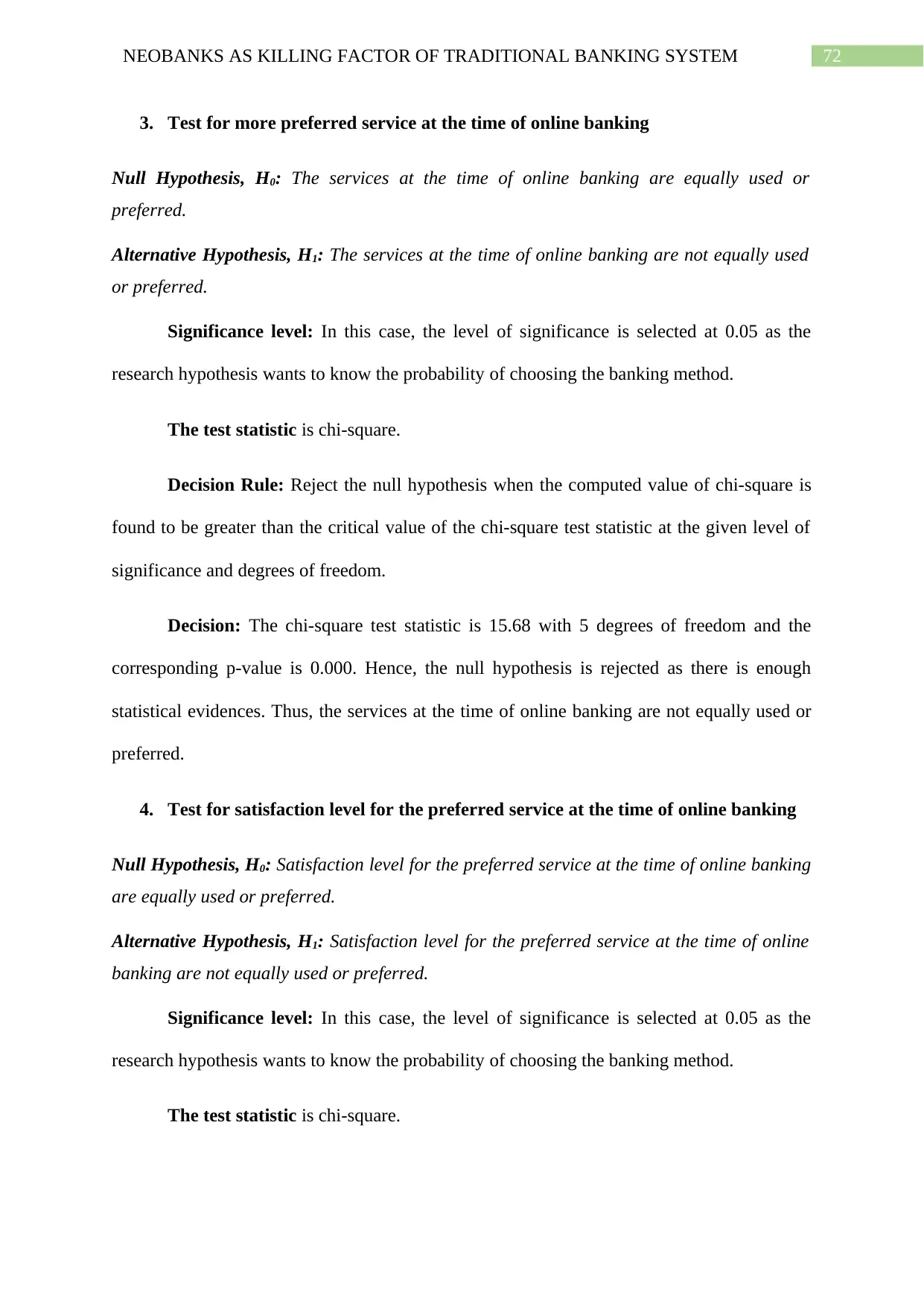
72NEOBANKS AS KILLING FACTOR OF TRADITIONAL BANKING SYSTEM
3. Test for more preferred service at the time of online banking
Null Hypothesis, H0: The services at the time of online banking are equally used or
preferred.
Alternative Hypothesis, H1: The services at the time of online banking are not equally used
or preferred.
Significance level: In this case, the level of significance is selected at 0.05 as the
research hypothesis wants to know the probability of choosing the banking method.
The test statistic is chi-square.
Decision Rule: Reject the null hypothesis when the computed value of chi-square is
found to be greater than the critical value of the chi-square test statistic at the given level of
significance and degrees of freedom.
Decision: The chi-square test statistic is 15.68 with 5 degrees of freedom and the
corresponding p-value is 0.000. Hence, the null hypothesis is rejected as there is enough
statistical evidences. Thus, the services at the time of online banking are not equally used or
preferred.
4. Test for satisfaction level for the preferred service at the time of online banking
Null Hypothesis, H0: Satisfaction level for the preferred service at the time of online banking
are equally used or preferred.
Alternative Hypothesis, H1: Satisfaction level for the preferred service at the time of online
banking are not equally used or preferred.
Significance level: In this case, the level of significance is selected at 0.05 as the
research hypothesis wants to know the probability of choosing the banking method.
The test statistic is chi-square.
3. Test for more preferred service at the time of online banking
Null Hypothesis, H0: The services at the time of online banking are equally used or
preferred.
Alternative Hypothesis, H1: The services at the time of online banking are not equally used
or preferred.
Significance level: In this case, the level of significance is selected at 0.05 as the
research hypothesis wants to know the probability of choosing the banking method.
The test statistic is chi-square.
Decision Rule: Reject the null hypothesis when the computed value of chi-square is
found to be greater than the critical value of the chi-square test statistic at the given level of
significance and degrees of freedom.
Decision: The chi-square test statistic is 15.68 with 5 degrees of freedom and the
corresponding p-value is 0.000. Hence, the null hypothesis is rejected as there is enough
statistical evidences. Thus, the services at the time of online banking are not equally used or
preferred.
4. Test for satisfaction level for the preferred service at the time of online banking
Null Hypothesis, H0: Satisfaction level for the preferred service at the time of online banking
are equally used or preferred.
Alternative Hypothesis, H1: Satisfaction level for the preferred service at the time of online
banking are not equally used or preferred.
Significance level: In this case, the level of significance is selected at 0.05 as the
research hypothesis wants to know the probability of choosing the banking method.
The test statistic is chi-square.
Paraphrase This Document
Need a fresh take? Get an instant paraphrase of this document with our AI Paraphraser
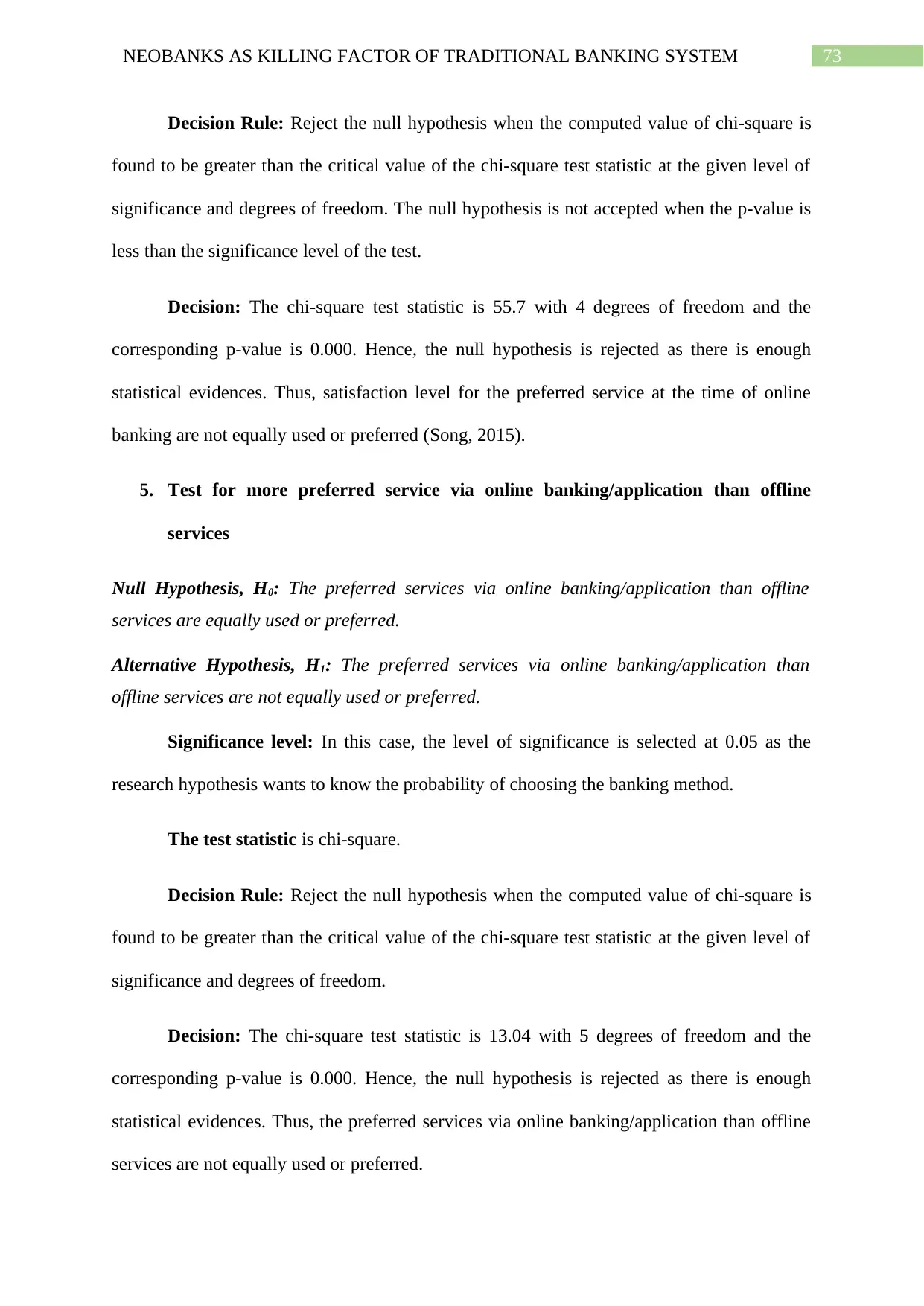
73NEOBANKS AS KILLING FACTOR OF TRADITIONAL BANKING SYSTEM
Decision Rule: Reject the null hypothesis when the computed value of chi-square is
found to be greater than the critical value of the chi-square test statistic at the given level of
significance and degrees of freedom. The null hypothesis is not accepted when the p-value is
less than the significance level of the test.
Decision: The chi-square test statistic is 55.7 with 4 degrees of freedom and the
corresponding p-value is 0.000. Hence, the null hypothesis is rejected as there is enough
statistical evidences. Thus, satisfaction level for the preferred service at the time of online
banking are not equally used or preferred (Song, 2015).
5. Test for more preferred service via online banking/application than offline
services
Null Hypothesis, H0: The preferred services via online banking/application than offline
services are equally used or preferred.
Alternative Hypothesis, H1: The preferred services via online banking/application than
offline services are not equally used or preferred.
Significance level: In this case, the level of significance is selected at 0.05 as the
research hypothesis wants to know the probability of choosing the banking method.
The test statistic is chi-square.
Decision Rule: Reject the null hypothesis when the computed value of chi-square is
found to be greater than the critical value of the chi-square test statistic at the given level of
significance and degrees of freedom.
Decision: The chi-square test statistic is 13.04 with 5 degrees of freedom and the
corresponding p-value is 0.000. Hence, the null hypothesis is rejected as there is enough
statistical evidences. Thus, the preferred services via online banking/application than offline
services are not equally used or preferred.
Decision Rule: Reject the null hypothesis when the computed value of chi-square is
found to be greater than the critical value of the chi-square test statistic at the given level of
significance and degrees of freedom. The null hypothesis is not accepted when the p-value is
less than the significance level of the test.
Decision: The chi-square test statistic is 55.7 with 4 degrees of freedom and the
corresponding p-value is 0.000. Hence, the null hypothesis is rejected as there is enough
statistical evidences. Thus, satisfaction level for the preferred service at the time of online
banking are not equally used or preferred (Song, 2015).
5. Test for more preferred service via online banking/application than offline
services
Null Hypothesis, H0: The preferred services via online banking/application than offline
services are equally used or preferred.
Alternative Hypothesis, H1: The preferred services via online banking/application than
offline services are not equally used or preferred.
Significance level: In this case, the level of significance is selected at 0.05 as the
research hypothesis wants to know the probability of choosing the banking method.
The test statistic is chi-square.
Decision Rule: Reject the null hypothesis when the computed value of chi-square is
found to be greater than the critical value of the chi-square test statistic at the given level of
significance and degrees of freedom.
Decision: The chi-square test statistic is 13.04 with 5 degrees of freedom and the
corresponding p-value is 0.000. Hence, the null hypothesis is rejected as there is enough
statistical evidences. Thus, the preferred services via online banking/application than offline
services are not equally used or preferred.
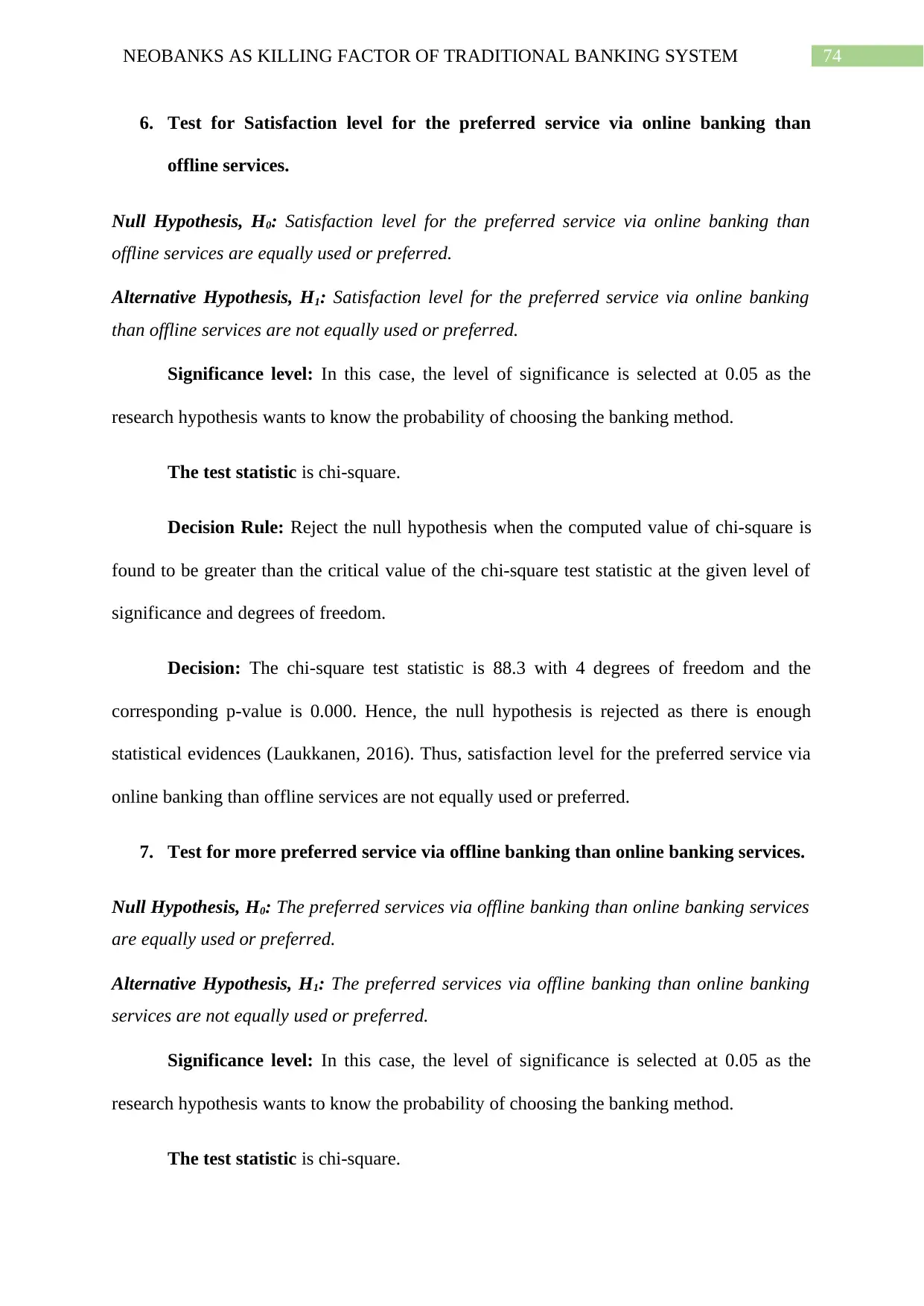
74NEOBANKS AS KILLING FACTOR OF TRADITIONAL BANKING SYSTEM
6. Test for Satisfaction level for the preferred service via online banking than
offline services.
Null Hypothesis, H0: Satisfaction level for the preferred service via online banking than
offline services are equally used or preferred.
Alternative Hypothesis, H1: Satisfaction level for the preferred service via online banking
than offline services are not equally used or preferred.
Significance level: In this case, the level of significance is selected at 0.05 as the
research hypothesis wants to know the probability of choosing the banking method.
The test statistic is chi-square.
Decision Rule: Reject the null hypothesis when the computed value of chi-square is
found to be greater than the critical value of the chi-square test statistic at the given level of
significance and degrees of freedom.
Decision: The chi-square test statistic is 88.3 with 4 degrees of freedom and the
corresponding p-value is 0.000. Hence, the null hypothesis is rejected as there is enough
statistical evidences (Laukkanen, 2016). Thus, satisfaction level for the preferred service via
online banking than offline services are not equally used or preferred.
7. Test for more preferred service via offline banking than online banking services.
Null Hypothesis, H0: The preferred services via offline banking than online banking services
are equally used or preferred.
Alternative Hypothesis, H1: The preferred services via offline banking than online banking
services are not equally used or preferred.
Significance level: In this case, the level of significance is selected at 0.05 as the
research hypothesis wants to know the probability of choosing the banking method.
The test statistic is chi-square.
6. Test for Satisfaction level for the preferred service via online banking than
offline services.
Null Hypothesis, H0: Satisfaction level for the preferred service via online banking than
offline services are equally used or preferred.
Alternative Hypothesis, H1: Satisfaction level for the preferred service via online banking
than offline services are not equally used or preferred.
Significance level: In this case, the level of significance is selected at 0.05 as the
research hypothesis wants to know the probability of choosing the banking method.
The test statistic is chi-square.
Decision Rule: Reject the null hypothesis when the computed value of chi-square is
found to be greater than the critical value of the chi-square test statistic at the given level of
significance and degrees of freedom.
Decision: The chi-square test statistic is 88.3 with 4 degrees of freedom and the
corresponding p-value is 0.000. Hence, the null hypothesis is rejected as there is enough
statistical evidences (Laukkanen, 2016). Thus, satisfaction level for the preferred service via
online banking than offline services are not equally used or preferred.
7. Test for more preferred service via offline banking than online banking services.
Null Hypothesis, H0: The preferred services via offline banking than online banking services
are equally used or preferred.
Alternative Hypothesis, H1: The preferred services via offline banking than online banking
services are not equally used or preferred.
Significance level: In this case, the level of significance is selected at 0.05 as the
research hypothesis wants to know the probability of choosing the banking method.
The test statistic is chi-square.

75NEOBANKS AS KILLING FACTOR OF TRADITIONAL BANKING SYSTEM
Decision Rule: The null hypothesis is not accepted when the p-value is less than the
significance level of the test.
Decision: The chi-square test statistic is 26.72 with 5 degrees of freedom and the
corresponding p-value is 0.000. Hence, the null hypothesis is rejected as there is enough
statistical evidences. Thus, preferred services via offline banking than online banking
services are equally used or preferred.
8. Test for satisfaction level for the preferred service via offline banking than online
banking.
Null Hypothesis, H0: Satisfaction levels for the preferred service via offline banking than
online banking are equally used or preferred.
Alternative Hypothesis, H1: Satisfaction levels for the preferred service via offline banking
than online banking are not equally used or preferred.
Significance level: In this case, the level of significance is selected at 0.05 as the
research hypothesis wants to know the probability of choosing the banking method.
The test statistic is chi-square.
Decision Rule: The null hypothesis is not accepted when the p-value is less than the
significance level of the test.
Decision: The chi-square test statistic is 51.1 with 4 degrees of freedom and the
corresponding p-value is 0.000. Hence, the null hypothesis is rejected as there is enough
statistical evidences. Thus, satisfaction levels for the preferred service via offline banking
than online banking are not equally used or preferred.
9. Test for the less preferred service in traditional bank than online service.
Null Hypothesis, H0: The less preferred service offered by traditional bank than online
service are equally less preferred.
Decision Rule: The null hypothesis is not accepted when the p-value is less than the
significance level of the test.
Decision: The chi-square test statistic is 26.72 with 5 degrees of freedom and the
corresponding p-value is 0.000. Hence, the null hypothesis is rejected as there is enough
statistical evidences. Thus, preferred services via offline banking than online banking
services are equally used or preferred.
8. Test for satisfaction level for the preferred service via offline banking than online
banking.
Null Hypothesis, H0: Satisfaction levels for the preferred service via offline banking than
online banking are equally used or preferred.
Alternative Hypothesis, H1: Satisfaction levels for the preferred service via offline banking
than online banking are not equally used or preferred.
Significance level: In this case, the level of significance is selected at 0.05 as the
research hypothesis wants to know the probability of choosing the banking method.
The test statistic is chi-square.
Decision Rule: The null hypothesis is not accepted when the p-value is less than the
significance level of the test.
Decision: The chi-square test statistic is 51.1 with 4 degrees of freedom and the
corresponding p-value is 0.000. Hence, the null hypothesis is rejected as there is enough
statistical evidences. Thus, satisfaction levels for the preferred service via offline banking
than online banking are not equally used or preferred.
9. Test for the less preferred service in traditional bank than online service.
Null Hypothesis, H0: The less preferred service offered by traditional bank than online
service are equally less preferred.
Secure Best Marks with AI Grader
Need help grading? Try our AI Grader for instant feedback on your assignments.
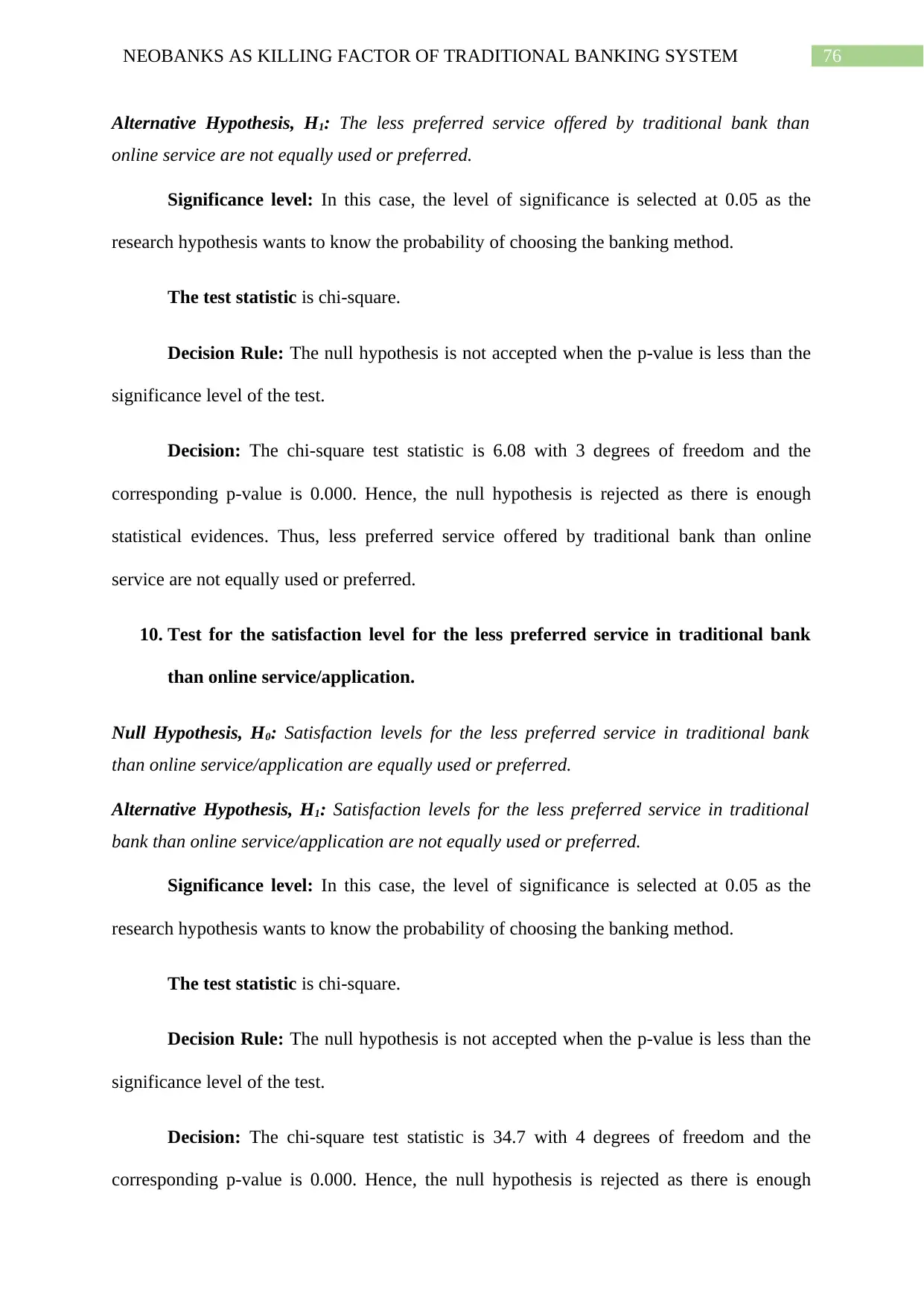
76NEOBANKS AS KILLING FACTOR OF TRADITIONAL BANKING SYSTEM
Alternative Hypothesis, H1: The less preferred service offered by traditional bank than
online service are not equally used or preferred.
Significance level: In this case, the level of significance is selected at 0.05 as the
research hypothesis wants to know the probability of choosing the banking method.
The test statistic is chi-square.
Decision Rule: The null hypothesis is not accepted when the p-value is less than the
significance level of the test.
Decision: The chi-square test statistic is 6.08 with 3 degrees of freedom and the
corresponding p-value is 0.000. Hence, the null hypothesis is rejected as there is enough
statistical evidences. Thus, less preferred service offered by traditional bank than online
service are not equally used or preferred.
10. Test for the satisfaction level for the less preferred service in traditional bank
than online service/application.
Null Hypothesis, H0: Satisfaction levels for the less preferred service in traditional bank
than online service/application are equally used or preferred.
Alternative Hypothesis, H1: Satisfaction levels for the less preferred service in traditional
bank than online service/application are not equally used or preferred.
Significance level: In this case, the level of significance is selected at 0.05 as the
research hypothesis wants to know the probability of choosing the banking method.
The test statistic is chi-square.
Decision Rule: The null hypothesis is not accepted when the p-value is less than the
significance level of the test.
Decision: The chi-square test statistic is 34.7 with 4 degrees of freedom and the
corresponding p-value is 0.000. Hence, the null hypothesis is rejected as there is enough
Alternative Hypothesis, H1: The less preferred service offered by traditional bank than
online service are not equally used or preferred.
Significance level: In this case, the level of significance is selected at 0.05 as the
research hypothesis wants to know the probability of choosing the banking method.
The test statistic is chi-square.
Decision Rule: The null hypothesis is not accepted when the p-value is less than the
significance level of the test.
Decision: The chi-square test statistic is 6.08 with 3 degrees of freedom and the
corresponding p-value is 0.000. Hence, the null hypothesis is rejected as there is enough
statistical evidences. Thus, less preferred service offered by traditional bank than online
service are not equally used or preferred.
10. Test for the satisfaction level for the less preferred service in traditional bank
than online service/application.
Null Hypothesis, H0: Satisfaction levels for the less preferred service in traditional bank
than online service/application are equally used or preferred.
Alternative Hypothesis, H1: Satisfaction levels for the less preferred service in traditional
bank than online service/application are not equally used or preferred.
Significance level: In this case, the level of significance is selected at 0.05 as the
research hypothesis wants to know the probability of choosing the banking method.
The test statistic is chi-square.
Decision Rule: The null hypothesis is not accepted when the p-value is less than the
significance level of the test.
Decision: The chi-square test statistic is 34.7 with 4 degrees of freedom and the
corresponding p-value is 0.000. Hence, the null hypothesis is rejected as there is enough
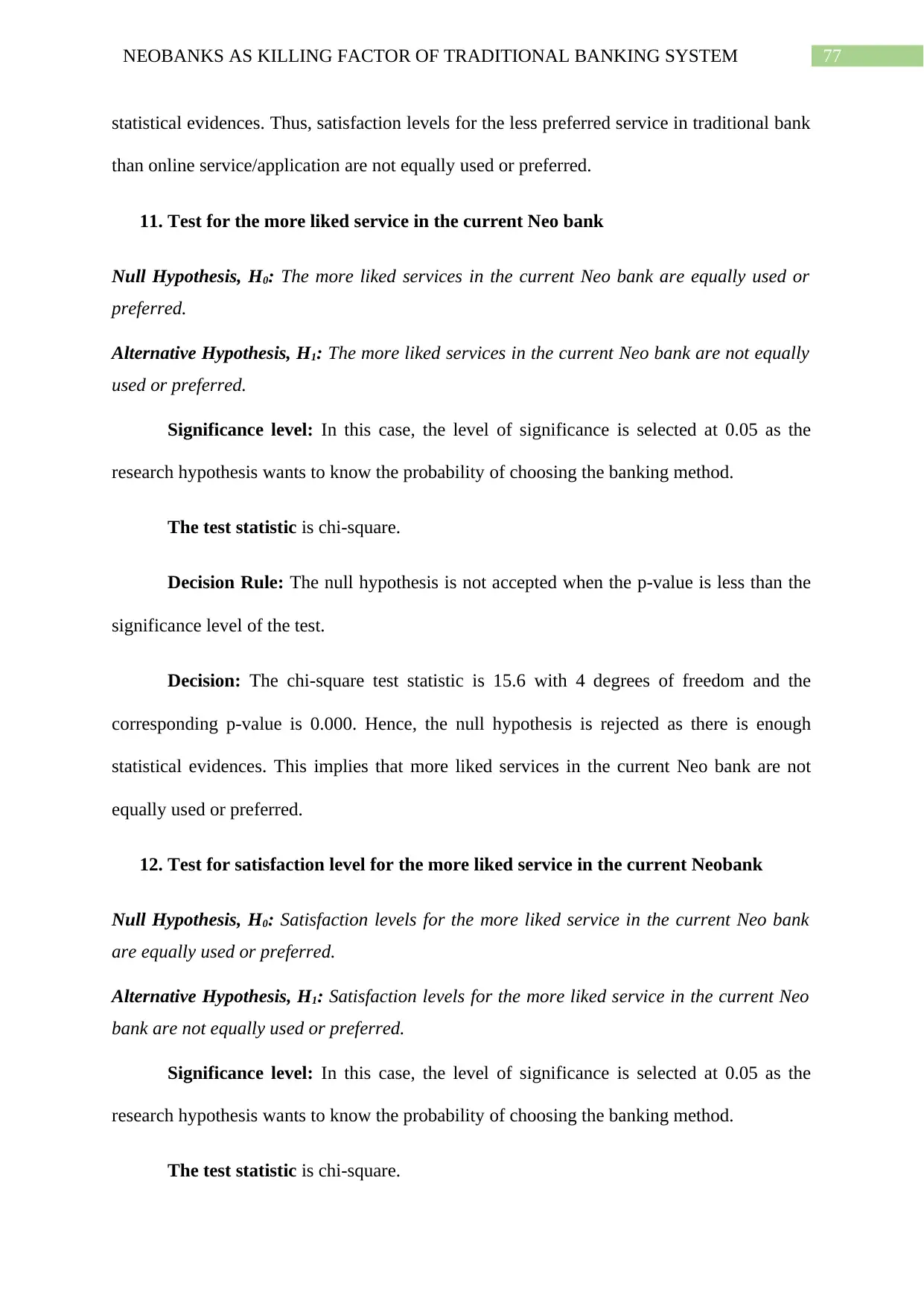
77NEOBANKS AS KILLING FACTOR OF TRADITIONAL BANKING SYSTEM
statistical evidences. Thus, satisfaction levels for the less preferred service in traditional bank
than online service/application are not equally used or preferred.
11. Test for the more liked service in the current Neo bank
Null Hypothesis, H0: The more liked services in the current Neo bank are equally used or
preferred.
Alternative Hypothesis, H1: The more liked services in the current Neo bank are not equally
used or preferred.
Significance level: In this case, the level of significance is selected at 0.05 as the
research hypothesis wants to know the probability of choosing the banking method.
The test statistic is chi-square.
Decision Rule: The null hypothesis is not accepted when the p-value is less than the
significance level of the test.
Decision: The chi-square test statistic is 15.6 with 4 degrees of freedom and the
corresponding p-value is 0.000. Hence, the null hypothesis is rejected as there is enough
statistical evidences. This implies that more liked services in the current Neo bank are not
equally used or preferred.
12. Test for satisfaction level for the more liked service in the current Neobank
Null Hypothesis, H0: Satisfaction levels for the more liked service in the current Neo bank
are equally used or preferred.
Alternative Hypothesis, H1: Satisfaction levels for the more liked service in the current Neo
bank are not equally used or preferred.
Significance level: In this case, the level of significance is selected at 0.05 as the
research hypothesis wants to know the probability of choosing the banking method.
The test statistic is chi-square.
statistical evidences. Thus, satisfaction levels for the less preferred service in traditional bank
than online service/application are not equally used or preferred.
11. Test for the more liked service in the current Neo bank
Null Hypothesis, H0: The more liked services in the current Neo bank are equally used or
preferred.
Alternative Hypothesis, H1: The more liked services in the current Neo bank are not equally
used or preferred.
Significance level: In this case, the level of significance is selected at 0.05 as the
research hypothesis wants to know the probability of choosing the banking method.
The test statistic is chi-square.
Decision Rule: The null hypothesis is not accepted when the p-value is less than the
significance level of the test.
Decision: The chi-square test statistic is 15.6 with 4 degrees of freedom and the
corresponding p-value is 0.000. Hence, the null hypothesis is rejected as there is enough
statistical evidences. This implies that more liked services in the current Neo bank are not
equally used or preferred.
12. Test for satisfaction level for the more liked service in the current Neobank
Null Hypothesis, H0: Satisfaction levels for the more liked service in the current Neo bank
are equally used or preferred.
Alternative Hypothesis, H1: Satisfaction levels for the more liked service in the current Neo
bank are not equally used or preferred.
Significance level: In this case, the level of significance is selected at 0.05 as the
research hypothesis wants to know the probability of choosing the banking method.
The test statistic is chi-square.

78NEOBANKS AS KILLING FACTOR OF TRADITIONAL BANKING SYSTEM
Decision Rule: The null hypothesis is not accepted when the p-value is less than the
significance level of the test.
Decision: The chi-square test statistic is 76.7 with 4 degrees of freedom and the
corresponding p-value is 0.000. Hence, the null hypothesis is rejected as there is enough
statistical evidences. This means that satisfaction levels for the more liked service in the
current Neo bank are not equally used or preferred.
13. Test for the less liked service in the current Neo bank
Null Hypothesis, H0: The less liked service in the current Neo bank are equally used or
preferred.
Alternative Hypothesis, H1: The less liked service in the current Neo bank are not equally
used or preferred.
Significance level: In this case, the level of significance is selected at 0.05 as the
research hypothesis wants to know the probability of choosing the banking method.
The test statistic is chi-square.
Decision Rule: The null hypothesis is not accepted when the p-value is less than the
significance level of the test.
Decision: The chi-square test statistic is 7.3 with 4 degrees of freedom and the
corresponding p-value is 0.000. Hence, the null hypothesis is rejected as there is enough
statistical evidences. This implies that the less liked service in the current Neo bank are not
equally used or preferred.
14. Test for satisfaction level for the less liked service in the current Neobank.
Null Hypothesis, H0: Satisfaction level for the less liked service in the current Neo bank are
equally used or preferred.
Decision Rule: The null hypothesis is not accepted when the p-value is less than the
significance level of the test.
Decision: The chi-square test statistic is 76.7 with 4 degrees of freedom and the
corresponding p-value is 0.000. Hence, the null hypothesis is rejected as there is enough
statistical evidences. This means that satisfaction levels for the more liked service in the
current Neo bank are not equally used or preferred.
13. Test for the less liked service in the current Neo bank
Null Hypothesis, H0: The less liked service in the current Neo bank are equally used or
preferred.
Alternative Hypothesis, H1: The less liked service in the current Neo bank are not equally
used or preferred.
Significance level: In this case, the level of significance is selected at 0.05 as the
research hypothesis wants to know the probability of choosing the banking method.
The test statistic is chi-square.
Decision Rule: The null hypothesis is not accepted when the p-value is less than the
significance level of the test.
Decision: The chi-square test statistic is 7.3 with 4 degrees of freedom and the
corresponding p-value is 0.000. Hence, the null hypothesis is rejected as there is enough
statistical evidences. This implies that the less liked service in the current Neo bank are not
equally used or preferred.
14. Test for satisfaction level for the less liked service in the current Neobank.
Null Hypothesis, H0: Satisfaction level for the less liked service in the current Neo bank are
equally used or preferred.
Paraphrase This Document
Need a fresh take? Get an instant paraphrase of this document with our AI Paraphraser
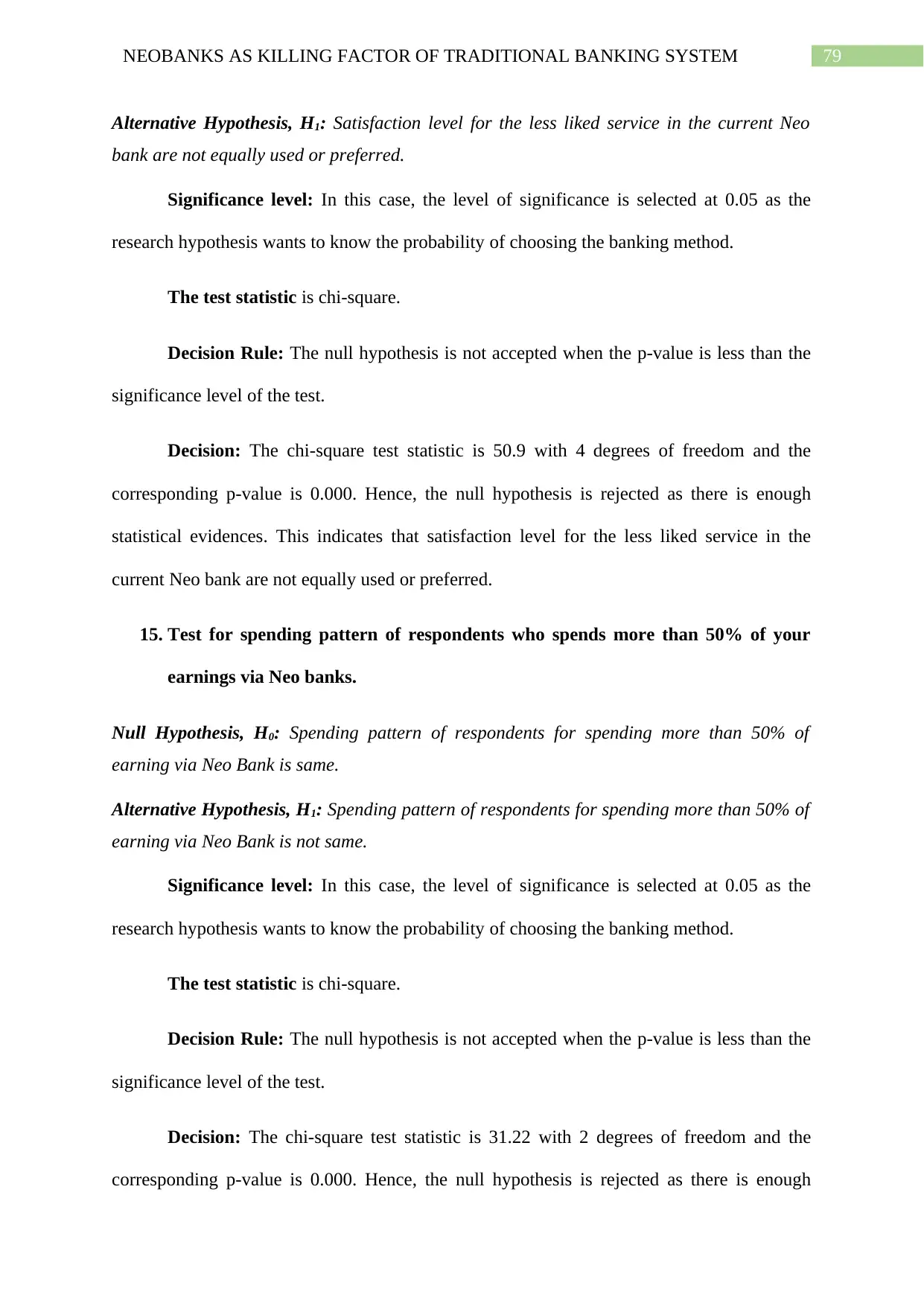
79NEOBANKS AS KILLING FACTOR OF TRADITIONAL BANKING SYSTEM
Alternative Hypothesis, H1: Satisfaction level for the less liked service in the current Neo
bank are not equally used or preferred.
Significance level: In this case, the level of significance is selected at 0.05 as the
research hypothesis wants to know the probability of choosing the banking method.
The test statistic is chi-square.
Decision Rule: The null hypothesis is not accepted when the p-value is less than the
significance level of the test.
Decision: The chi-square test statistic is 50.9 with 4 degrees of freedom and the
corresponding p-value is 0.000. Hence, the null hypothesis is rejected as there is enough
statistical evidences. This indicates that satisfaction level for the less liked service in the
current Neo bank are not equally used or preferred.
15. Test for spending pattern of respondents who spends more than 50% of your
earnings via Neo banks.
Null Hypothesis, H0: Spending pattern of respondents for spending more than 50% of
earning via Neo Bank is same.
Alternative Hypothesis, H1: Spending pattern of respondents for spending more than 50% of
earning via Neo Bank is not same.
Significance level: In this case, the level of significance is selected at 0.05 as the
research hypothesis wants to know the probability of choosing the banking method.
The test statistic is chi-square.
Decision Rule: The null hypothesis is not accepted when the p-value is less than the
significance level of the test.
Decision: The chi-square test statistic is 31.22 with 2 degrees of freedom and the
corresponding p-value is 0.000. Hence, the null hypothesis is rejected as there is enough
Alternative Hypothesis, H1: Satisfaction level for the less liked service in the current Neo
bank are not equally used or preferred.
Significance level: In this case, the level of significance is selected at 0.05 as the
research hypothesis wants to know the probability of choosing the banking method.
The test statistic is chi-square.
Decision Rule: The null hypothesis is not accepted when the p-value is less than the
significance level of the test.
Decision: The chi-square test statistic is 50.9 with 4 degrees of freedom and the
corresponding p-value is 0.000. Hence, the null hypothesis is rejected as there is enough
statistical evidences. This indicates that satisfaction level for the less liked service in the
current Neo bank are not equally used or preferred.
15. Test for spending pattern of respondents who spends more than 50% of your
earnings via Neo banks.
Null Hypothesis, H0: Spending pattern of respondents for spending more than 50% of
earning via Neo Bank is same.
Alternative Hypothesis, H1: Spending pattern of respondents for spending more than 50% of
earning via Neo Bank is not same.
Significance level: In this case, the level of significance is selected at 0.05 as the
research hypothesis wants to know the probability of choosing the banking method.
The test statistic is chi-square.
Decision Rule: The null hypothesis is not accepted when the p-value is less than the
significance level of the test.
Decision: The chi-square test statistic is 31.22 with 2 degrees of freedom and the
corresponding p-value is 0.000. Hence, the null hypothesis is rejected as there is enough
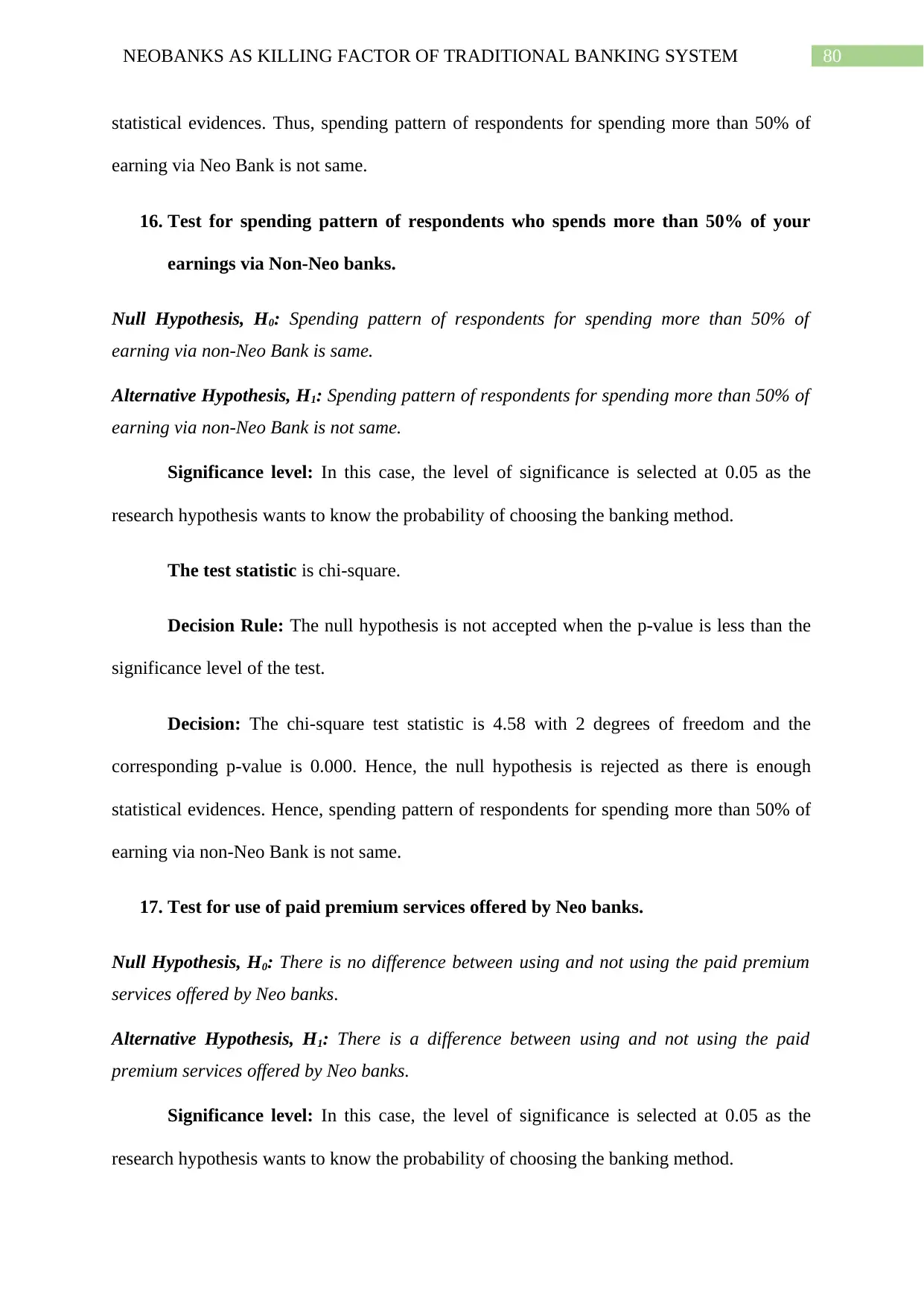
80NEOBANKS AS KILLING FACTOR OF TRADITIONAL BANKING SYSTEM
statistical evidences. Thus, spending pattern of respondents for spending more than 50% of
earning via Neo Bank is not same.
16. Test for spending pattern of respondents who spends more than 50% of your
earnings via Non-Neo banks.
Null Hypothesis, H0: Spending pattern of respondents for spending more than 50% of
earning via non-Neo Bank is same.
Alternative Hypothesis, H1: Spending pattern of respondents for spending more than 50% of
earning via non-Neo Bank is not same.
Significance level: In this case, the level of significance is selected at 0.05 as the
research hypothesis wants to know the probability of choosing the banking method.
The test statistic is chi-square.
Decision Rule: The null hypothesis is not accepted when the p-value is less than the
significance level of the test.
Decision: The chi-square test statistic is 4.58 with 2 degrees of freedom and the
corresponding p-value is 0.000. Hence, the null hypothesis is rejected as there is enough
statistical evidences. Hence, spending pattern of respondents for spending more than 50% of
earning via non-Neo Bank is not same.
17. Test for use of paid premium services offered by Neo banks.
Null Hypothesis, H0: There is no difference between using and not using the paid premium
services offered by Neo banks.
Alternative Hypothesis, H1: There is a difference between using and not using the paid
premium services offered by Neo banks.
Significance level: In this case, the level of significance is selected at 0.05 as the
research hypothesis wants to know the probability of choosing the banking method.
statistical evidences. Thus, spending pattern of respondents for spending more than 50% of
earning via Neo Bank is not same.
16. Test for spending pattern of respondents who spends more than 50% of your
earnings via Non-Neo banks.
Null Hypothesis, H0: Spending pattern of respondents for spending more than 50% of
earning via non-Neo Bank is same.
Alternative Hypothesis, H1: Spending pattern of respondents for spending more than 50% of
earning via non-Neo Bank is not same.
Significance level: In this case, the level of significance is selected at 0.05 as the
research hypothesis wants to know the probability of choosing the banking method.
The test statistic is chi-square.
Decision Rule: The null hypothesis is not accepted when the p-value is less than the
significance level of the test.
Decision: The chi-square test statistic is 4.58 with 2 degrees of freedom and the
corresponding p-value is 0.000. Hence, the null hypothesis is rejected as there is enough
statistical evidences. Hence, spending pattern of respondents for spending more than 50% of
earning via non-Neo Bank is not same.
17. Test for use of paid premium services offered by Neo banks.
Null Hypothesis, H0: There is no difference between using and not using the paid premium
services offered by Neo banks.
Alternative Hypothesis, H1: There is a difference between using and not using the paid
premium services offered by Neo banks.
Significance level: In this case, the level of significance is selected at 0.05 as the
research hypothesis wants to know the probability of choosing the banking method.
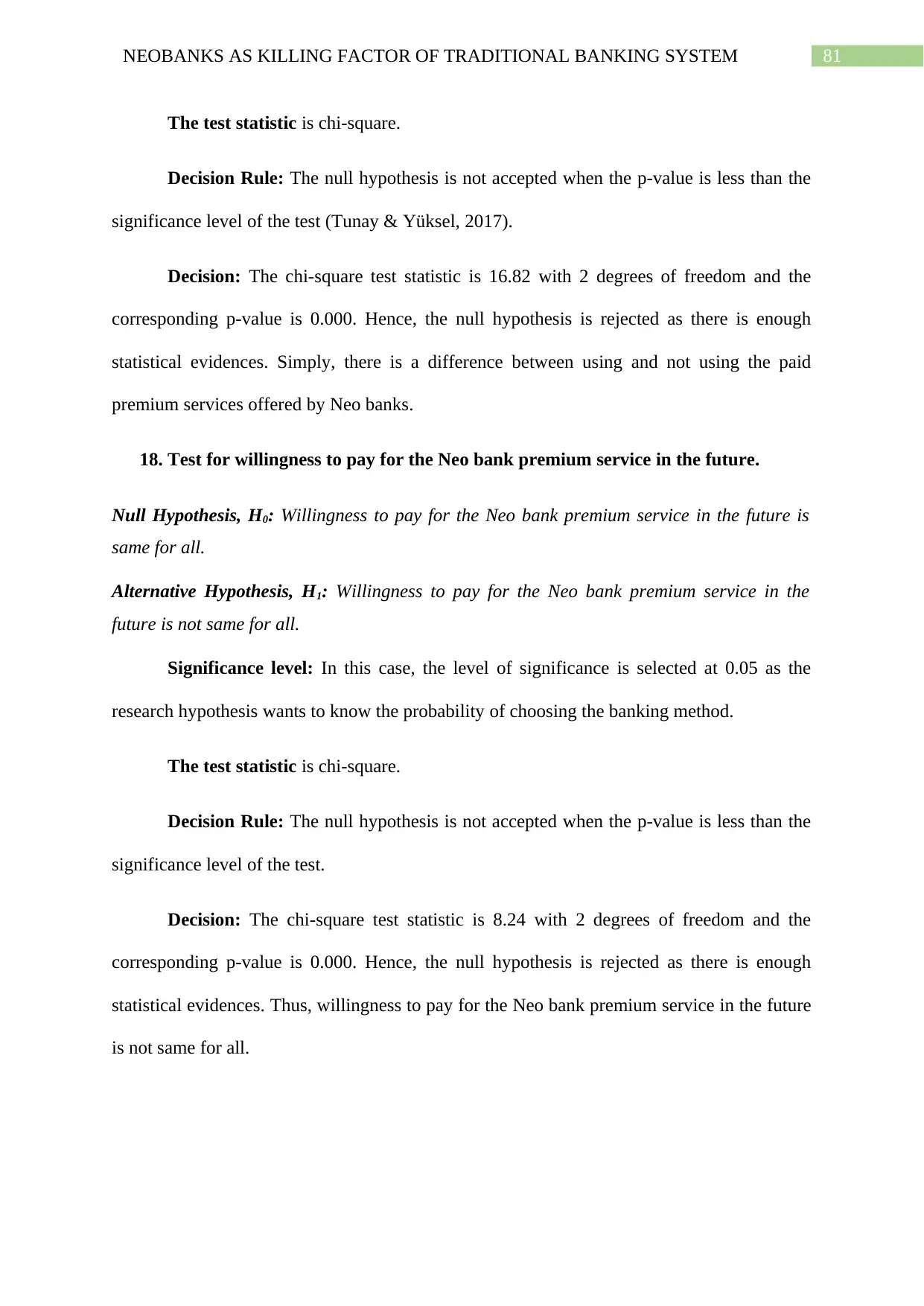
81NEOBANKS AS KILLING FACTOR OF TRADITIONAL BANKING SYSTEM
The test statistic is chi-square.
Decision Rule: The null hypothesis is not accepted when the p-value is less than the
significance level of the test (Tunay & Yüksel, 2017).
Decision: The chi-square test statistic is 16.82 with 2 degrees of freedom and the
corresponding p-value is 0.000. Hence, the null hypothesis is rejected as there is enough
statistical evidences. Simply, there is a difference between using and not using the paid
premium services offered by Neo banks.
18. Test for willingness to pay for the Neo bank premium service in the future.
Null Hypothesis, H0: Willingness to pay for the Neo bank premium service in the future is
same for all.
Alternative Hypothesis, H1: Willingness to pay for the Neo bank premium service in the
future is not same for all.
Significance level: In this case, the level of significance is selected at 0.05 as the
research hypothesis wants to know the probability of choosing the banking method.
The test statistic is chi-square.
Decision Rule: The null hypothesis is not accepted when the p-value is less than the
significance level of the test.
Decision: The chi-square test statistic is 8.24 with 2 degrees of freedom and the
corresponding p-value is 0.000. Hence, the null hypothesis is rejected as there is enough
statistical evidences. Thus, willingness to pay for the Neo bank premium service in the future
is not same for all.
The test statistic is chi-square.
Decision Rule: The null hypothesis is not accepted when the p-value is less than the
significance level of the test (Tunay & Yüksel, 2017).
Decision: The chi-square test statistic is 16.82 with 2 degrees of freedom and the
corresponding p-value is 0.000. Hence, the null hypothesis is rejected as there is enough
statistical evidences. Simply, there is a difference between using and not using the paid
premium services offered by Neo banks.
18. Test for willingness to pay for the Neo bank premium service in the future.
Null Hypothesis, H0: Willingness to pay for the Neo bank premium service in the future is
same for all.
Alternative Hypothesis, H1: Willingness to pay for the Neo bank premium service in the
future is not same for all.
Significance level: In this case, the level of significance is selected at 0.05 as the
research hypothesis wants to know the probability of choosing the banking method.
The test statistic is chi-square.
Decision Rule: The null hypothesis is not accepted when the p-value is less than the
significance level of the test.
Decision: The chi-square test statistic is 8.24 with 2 degrees of freedom and the
corresponding p-value is 0.000. Hence, the null hypothesis is rejected as there is enough
statistical evidences. Thus, willingness to pay for the Neo bank premium service in the future
is not same for all.
Secure Best Marks with AI Grader
Need help grading? Try our AI Grader for instant feedback on your assignments.
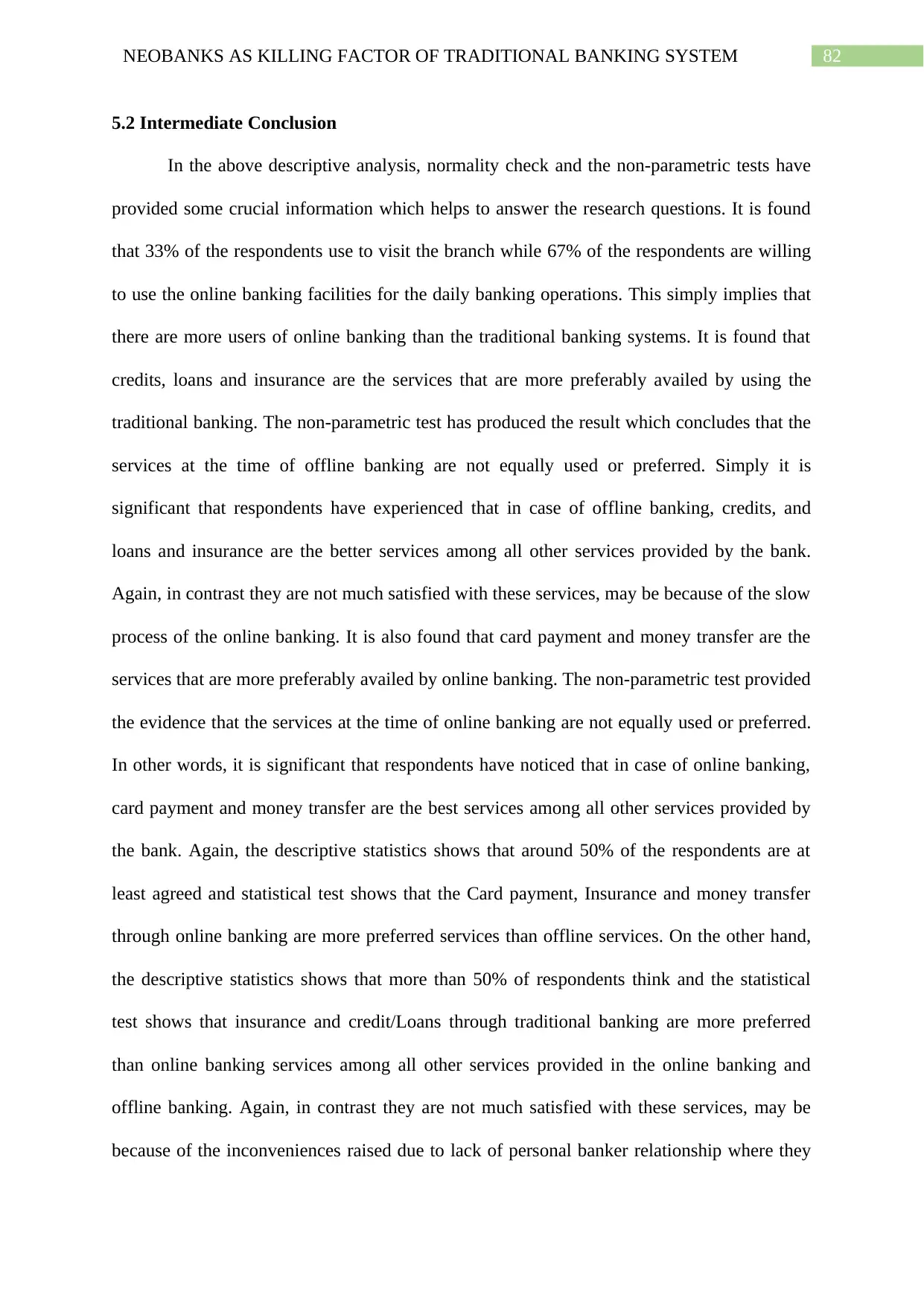
82NEOBANKS AS KILLING FACTOR OF TRADITIONAL BANKING SYSTEM
5.2 Intermediate Conclusion
In the above descriptive analysis, normality check and the non-parametric tests have
provided some crucial information which helps to answer the research questions. It is found
that 33% of the respondents use to visit the branch while 67% of the respondents are willing
to use the online banking facilities for the daily banking operations. This simply implies that
there are more users of online banking than the traditional banking systems. It is found that
credits, loans and insurance are the services that are more preferably availed by using the
traditional banking. The non-parametric test has produced the result which concludes that the
services at the time of offline banking are not equally used or preferred. Simply it is
significant that respondents have experienced that in case of offline banking, credits, and
loans and insurance are the better services among all other services provided by the bank.
Again, in contrast they are not much satisfied with these services, may be because of the slow
process of the online banking. It is also found that card payment and money transfer are the
services that are more preferably availed by online banking. The non-parametric test provided
the evidence that the services at the time of online banking are not equally used or preferred.
In other words, it is significant that respondents have noticed that in case of online banking,
card payment and money transfer are the best services among all other services provided by
the bank. Again, the descriptive statistics shows that around 50% of the respondents are at
least agreed and statistical test shows that the Card payment, Insurance and money transfer
through online banking are more preferred services than offline services. On the other hand,
the descriptive statistics shows that more than 50% of respondents think and the statistical
test shows that insurance and credit/Loans through traditional banking are more preferred
than online banking services among all other services provided in the online banking and
offline banking. Again, in contrast they are not much satisfied with these services, may be
because of the inconveniences raised due to lack of personal banker relationship where they
5.2 Intermediate Conclusion
In the above descriptive analysis, normality check and the non-parametric tests have
provided some crucial information which helps to answer the research questions. It is found
that 33% of the respondents use to visit the branch while 67% of the respondents are willing
to use the online banking facilities for the daily banking operations. This simply implies that
there are more users of online banking than the traditional banking systems. It is found that
credits, loans and insurance are the services that are more preferably availed by using the
traditional banking. The non-parametric test has produced the result which concludes that the
services at the time of offline banking are not equally used or preferred. Simply it is
significant that respondents have experienced that in case of offline banking, credits, and
loans and insurance are the better services among all other services provided by the bank.
Again, in contrast they are not much satisfied with these services, may be because of the slow
process of the online banking. It is also found that card payment and money transfer are the
services that are more preferably availed by online banking. The non-parametric test provided
the evidence that the services at the time of online banking are not equally used or preferred.
In other words, it is significant that respondents have noticed that in case of online banking,
card payment and money transfer are the best services among all other services provided by
the bank. Again, the descriptive statistics shows that around 50% of the respondents are at
least agreed and statistical test shows that the Card payment, Insurance and money transfer
through online banking are more preferred services than offline services. On the other hand,
the descriptive statistics shows that more than 50% of respondents think and the statistical
test shows that insurance and credit/Loans through traditional banking are more preferred
than online banking services among all other services provided in the online banking and
offline banking. Again, in contrast they are not much satisfied with these services, may be
because of the inconveniences raised due to lack of personal banker relationship where they
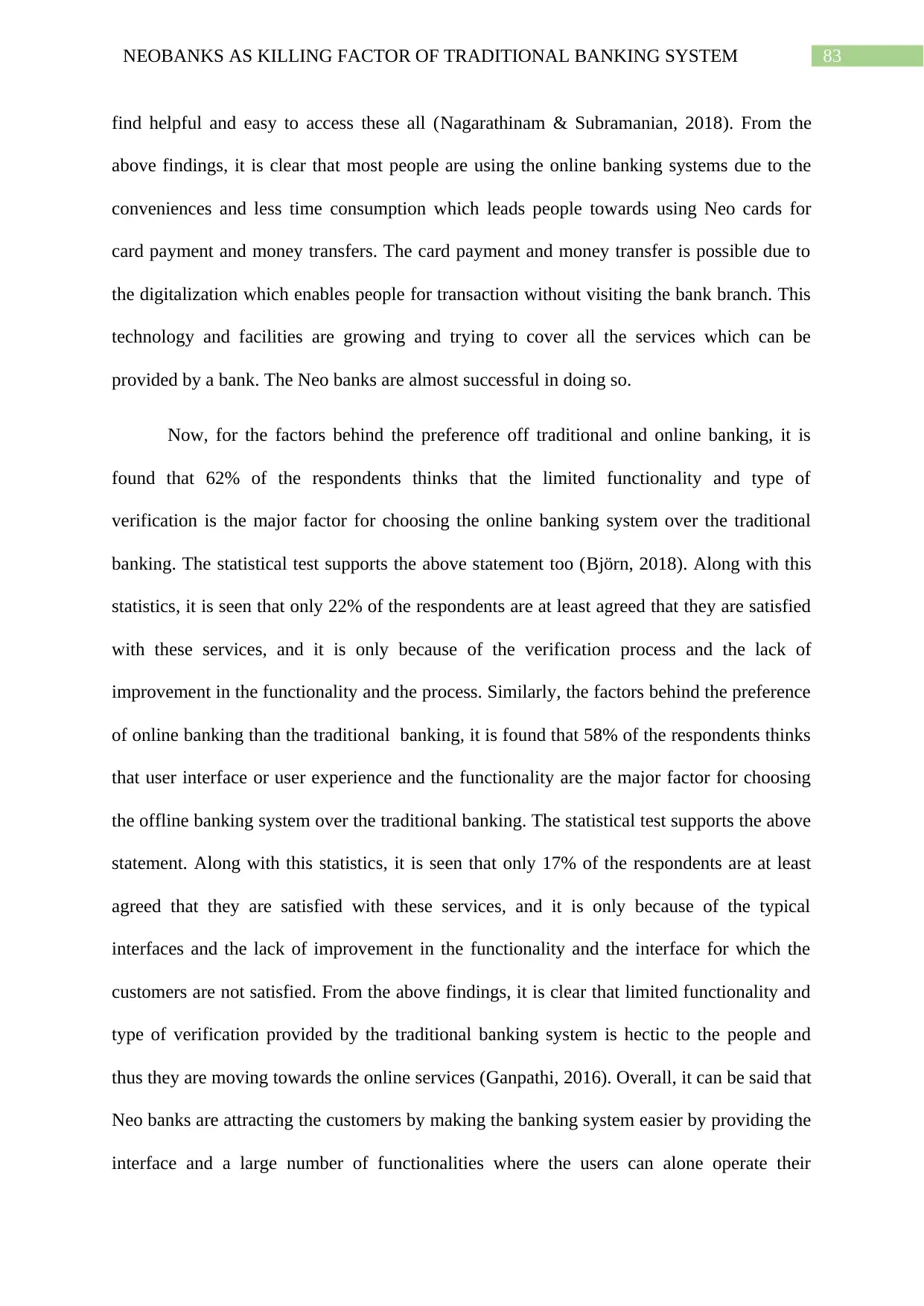
83NEOBANKS AS KILLING FACTOR OF TRADITIONAL BANKING SYSTEM
find helpful and easy to access these all (Nagarathinam & Subramanian, 2018). From the
above findings, it is clear that most people are using the online banking systems due to the
conveniences and less time consumption which leads people towards using Neo cards for
card payment and money transfers. The card payment and money transfer is possible due to
the digitalization which enables people for transaction without visiting the bank branch. This
technology and facilities are growing and trying to cover all the services which can be
provided by a bank. The Neo banks are almost successful in doing so.
Now, for the factors behind the preference off traditional and online banking, it is
found that 62% of the respondents thinks that the limited functionality and type of
verification is the major factor for choosing the online banking system over the traditional
banking. The statistical test supports the above statement too (Björn, 2018). Along with this
statistics, it is seen that only 22% of the respondents are at least agreed that they are satisfied
with these services, and it is only because of the verification process and the lack of
improvement in the functionality and the process. Similarly, the factors behind the preference
of online banking than the traditional banking, it is found that 58% of the respondents thinks
that user interface or user experience and the functionality are the major factor for choosing
the offline banking system over the traditional banking. The statistical test supports the above
statement. Along with this statistics, it is seen that only 17% of the respondents are at least
agreed that they are satisfied with these services, and it is only because of the typical
interfaces and the lack of improvement in the functionality and the interface for which the
customers are not satisfied. From the above findings, it is clear that limited functionality and
type of verification provided by the traditional banking system is hectic to the people and
thus they are moving towards the online services (Ganpathi, 2016). Overall, it can be said that
Neo banks are attracting the customers by making the banking system easier by providing the
interface and a large number of functionalities where the users can alone operate their
find helpful and easy to access these all (Nagarathinam & Subramanian, 2018). From the
above findings, it is clear that most people are using the online banking systems due to the
conveniences and less time consumption which leads people towards using Neo cards for
card payment and money transfers. The card payment and money transfer is possible due to
the digitalization which enables people for transaction without visiting the bank branch. This
technology and facilities are growing and trying to cover all the services which can be
provided by a bank. The Neo banks are almost successful in doing so.
Now, for the factors behind the preference off traditional and online banking, it is
found that 62% of the respondents thinks that the limited functionality and type of
verification is the major factor for choosing the online banking system over the traditional
banking. The statistical test supports the above statement too (Björn, 2018). Along with this
statistics, it is seen that only 22% of the respondents are at least agreed that they are satisfied
with these services, and it is only because of the verification process and the lack of
improvement in the functionality and the process. Similarly, the factors behind the preference
of online banking than the traditional banking, it is found that 58% of the respondents thinks
that user interface or user experience and the functionality are the major factor for choosing
the offline banking system over the traditional banking. The statistical test supports the above
statement. Along with this statistics, it is seen that only 17% of the respondents are at least
agreed that they are satisfied with these services, and it is only because of the typical
interfaces and the lack of improvement in the functionality and the interface for which the
customers are not satisfied. From the above findings, it is clear that limited functionality and
type of verification provided by the traditional banking system is hectic to the people and
thus they are moving towards the online services (Ganpathi, 2016). Overall, it can be said that
Neo banks are attracting the customers by making the banking system easier by providing the
interface and a large number of functionalities where the users can alone operate their
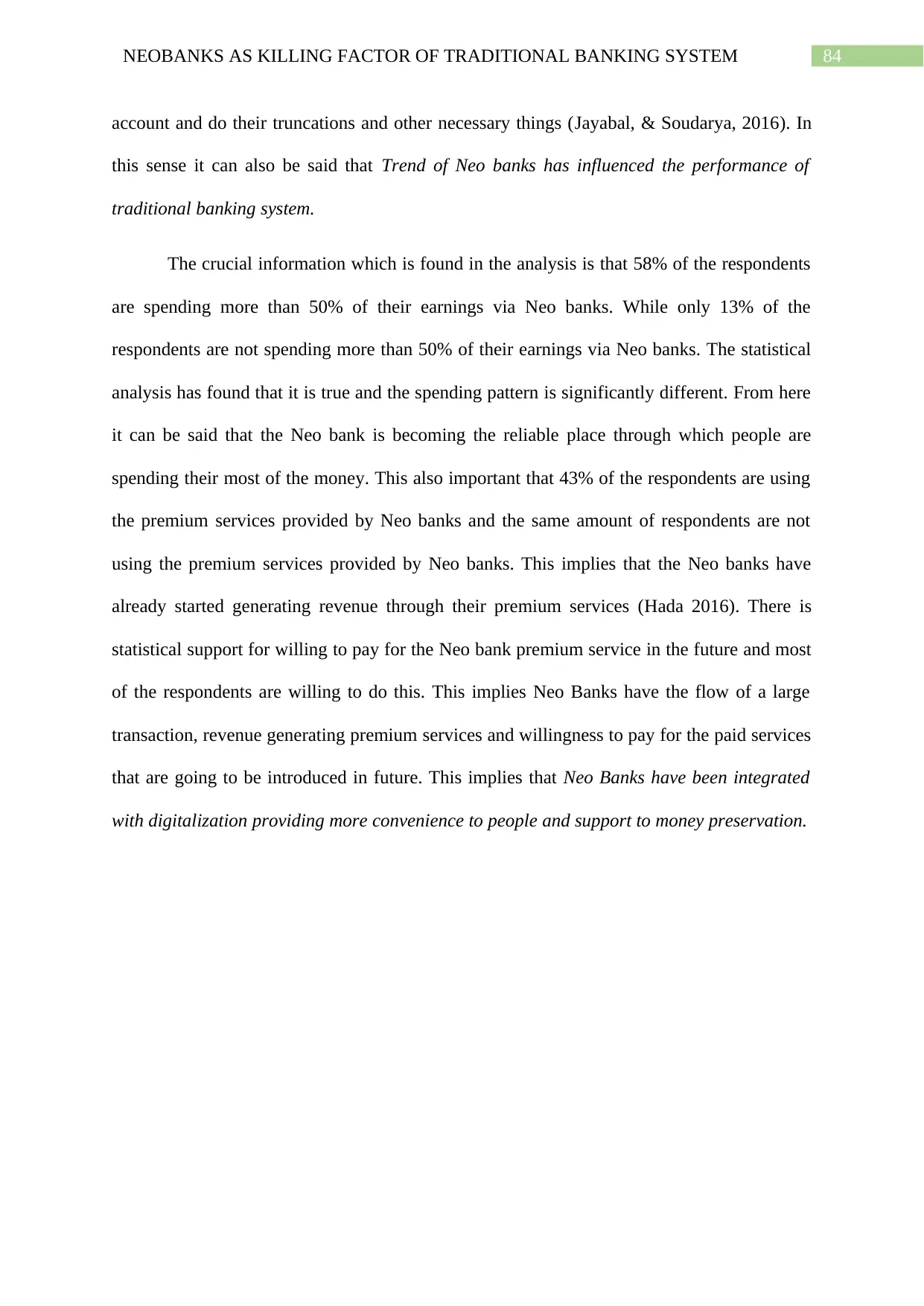
84NEOBANKS AS KILLING FACTOR OF TRADITIONAL BANKING SYSTEM
account and do their truncations and other necessary things (Jayabal, & Soudarya, 2016). In
this sense it can also be said that Trend of Neo banks has influenced the performance of
traditional banking system.
The crucial information which is found in the analysis is that 58% of the respondents
are spending more than 50% of their earnings via Neo banks. While only 13% of the
respondents are not spending more than 50% of their earnings via Neo banks. The statistical
analysis has found that it is true and the spending pattern is significantly different. From here
it can be said that the Neo bank is becoming the reliable place through which people are
spending their most of the money. This also important that 43% of the respondents are using
the premium services provided by Neo banks and the same amount of respondents are not
using the premium services provided by Neo banks. This implies that the Neo banks have
already started generating revenue through their premium services (Hada 2016). There is
statistical support for willing to pay for the Neo bank premium service in the future and most
of the respondents are willing to do this. This implies Neo Banks have the flow of a large
transaction, revenue generating premium services and willingness to pay for the paid services
that are going to be introduced in future. This implies that Neo Banks have been integrated
with digitalization providing more convenience to people and support to money preservation.
account and do their truncations and other necessary things (Jayabal, & Soudarya, 2016). In
this sense it can also be said that Trend of Neo banks has influenced the performance of
traditional banking system.
The crucial information which is found in the analysis is that 58% of the respondents
are spending more than 50% of their earnings via Neo banks. While only 13% of the
respondents are not spending more than 50% of their earnings via Neo banks. The statistical
analysis has found that it is true and the spending pattern is significantly different. From here
it can be said that the Neo bank is becoming the reliable place through which people are
spending their most of the money. This also important that 43% of the respondents are using
the premium services provided by Neo banks and the same amount of respondents are not
using the premium services provided by Neo banks. This implies that the Neo banks have
already started generating revenue through their premium services (Hada 2016). There is
statistical support for willing to pay for the Neo bank premium service in the future and most
of the respondents are willing to do this. This implies Neo Banks have the flow of a large
transaction, revenue generating premium services and willingness to pay for the paid services
that are going to be introduced in future. This implies that Neo Banks have been integrated
with digitalization providing more convenience to people and support to money preservation.
Paraphrase This Document
Need a fresh take? Get an instant paraphrase of this document with our AI Paraphraser
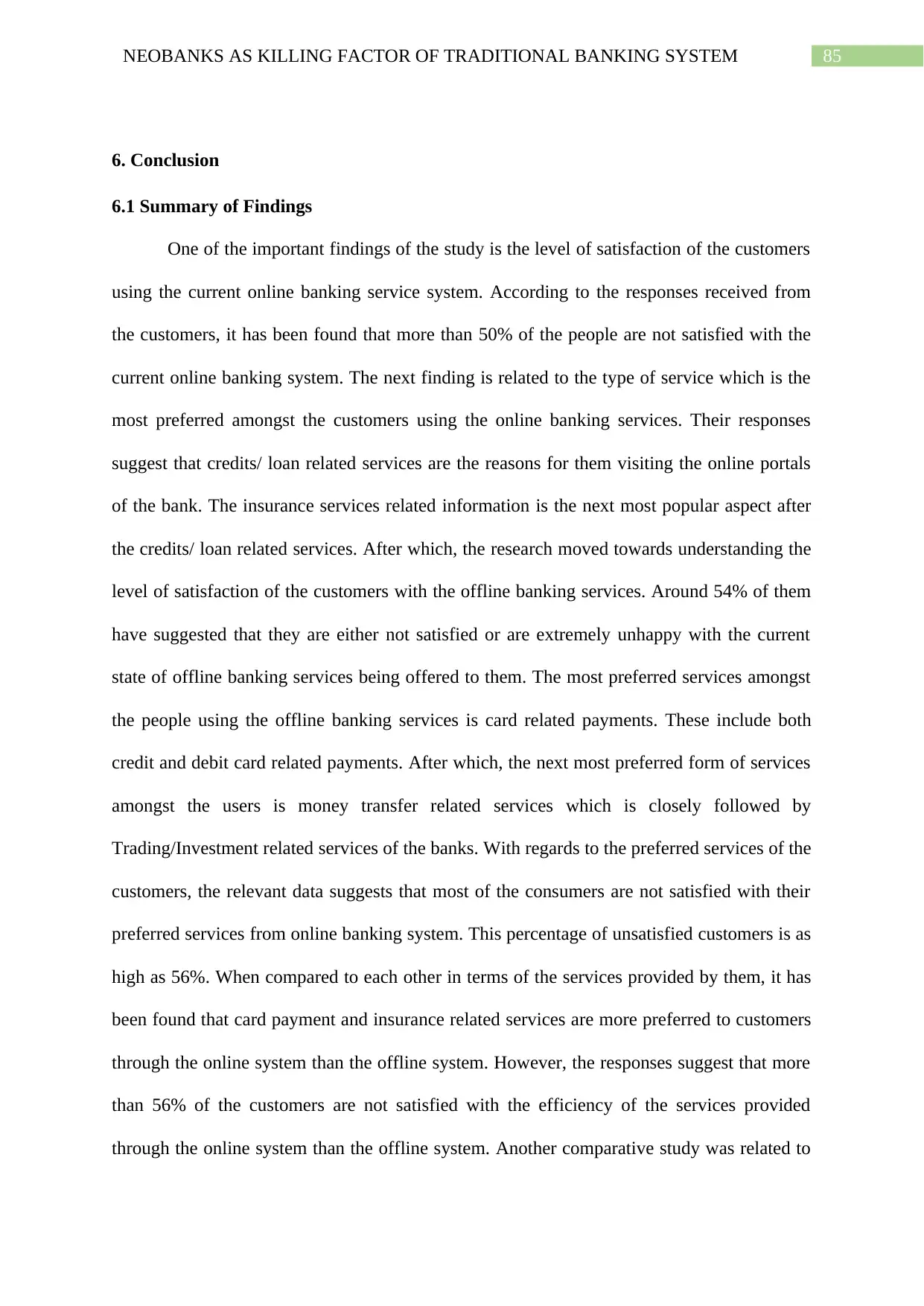
85NEOBANKS AS KILLING FACTOR OF TRADITIONAL BANKING SYSTEM
6. Conclusion
6.1 Summary of Findings
One of the important findings of the study is the level of satisfaction of the customers
using the current online banking service system. According to the responses received from
the customers, it has been found that more than 50% of the people are not satisfied with the
current online banking system. The next finding is related to the type of service which is the
most preferred amongst the customers using the online banking services. Their responses
suggest that credits/ loan related services are the reasons for them visiting the online portals
of the bank. The insurance services related information is the next most popular aspect after
the credits/ loan related services. After which, the research moved towards understanding the
level of satisfaction of the customers with the offline banking services. Around 54% of them
have suggested that they are either not satisfied or are extremely unhappy with the current
state of offline banking services being offered to them. The most preferred services amongst
the people using the offline banking services is card related payments. These include both
credit and debit card related payments. After which, the next most preferred form of services
amongst the users is money transfer related services which is closely followed by
Trading/Investment related services of the banks. With regards to the preferred services of the
customers, the relevant data suggests that most of the consumers are not satisfied with their
preferred services from online banking system. This percentage of unsatisfied customers is as
high as 56%. When compared to each other in terms of the services provided by them, it has
been found that card payment and insurance related services are more preferred to customers
through the online system than the offline system. However, the responses suggest that more
than 56% of the customers are not satisfied with the efficiency of the services provided
through the online system than the offline system. Another comparative study was related to
6. Conclusion
6.1 Summary of Findings
One of the important findings of the study is the level of satisfaction of the customers
using the current online banking service system. According to the responses received from
the customers, it has been found that more than 50% of the people are not satisfied with the
current online banking system. The next finding is related to the type of service which is the
most preferred amongst the customers using the online banking services. Their responses
suggest that credits/ loan related services are the reasons for them visiting the online portals
of the bank. The insurance services related information is the next most popular aspect after
the credits/ loan related services. After which, the research moved towards understanding the
level of satisfaction of the customers with the offline banking services. Around 54% of them
have suggested that they are either not satisfied or are extremely unhappy with the current
state of offline banking services being offered to them. The most preferred services amongst
the people using the offline banking services is card related payments. These include both
credit and debit card related payments. After which, the next most preferred form of services
amongst the users is money transfer related services which is closely followed by
Trading/Investment related services of the banks. With regards to the preferred services of the
customers, the relevant data suggests that most of the consumers are not satisfied with their
preferred services from online banking system. This percentage of unsatisfied customers is as
high as 56%. When compared to each other in terms of the services provided by them, it has
been found that card payment and insurance related services are more preferred to customers
through the online system than the offline system. However, the responses suggest that more
than 56% of the customers are not satisfied with the efficiency of the services provided
through the online system than the offline system. Another comparative study was related to
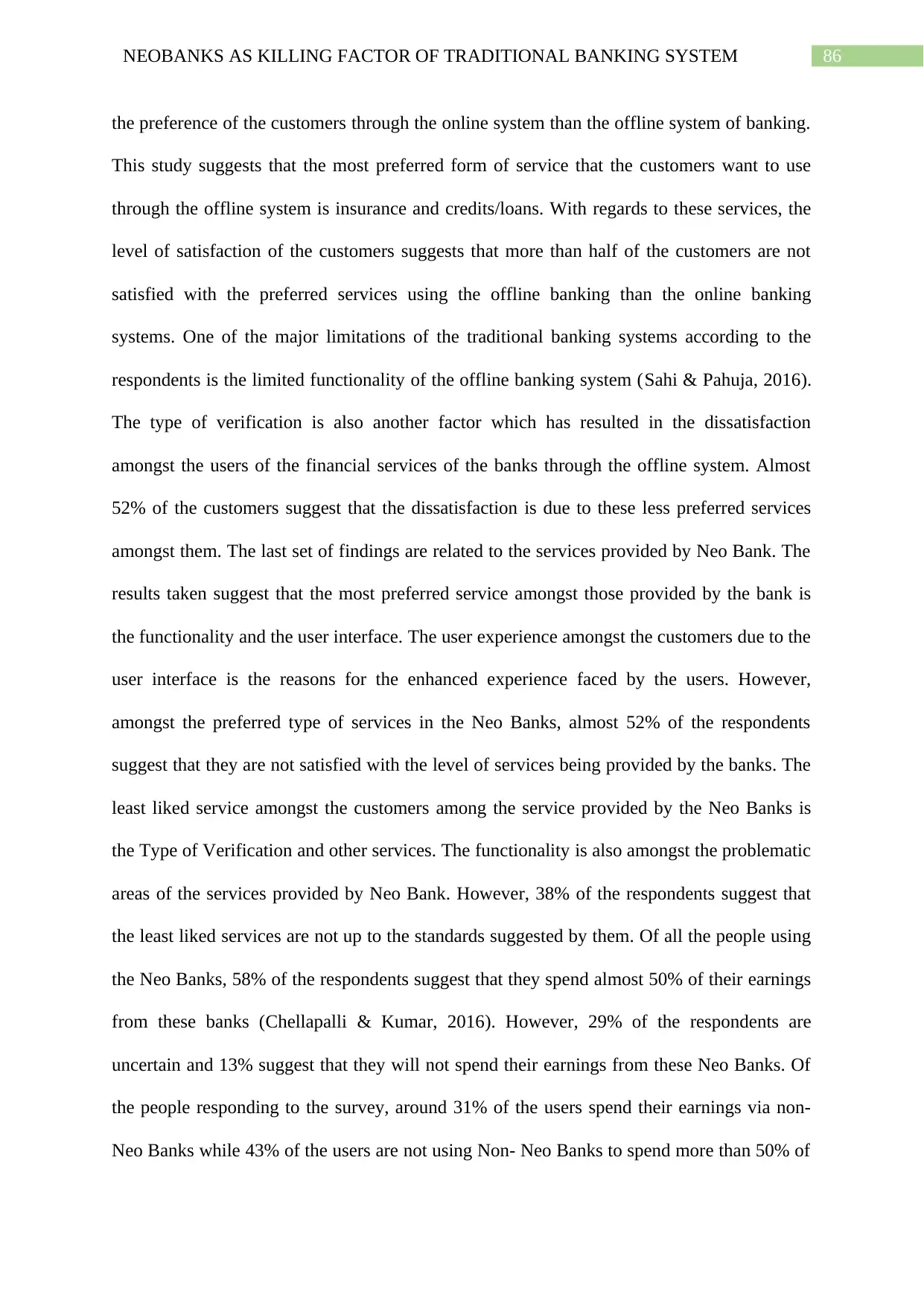
86NEOBANKS AS KILLING FACTOR OF TRADITIONAL BANKING SYSTEM
the preference of the customers through the online system than the offline system of banking.
This study suggests that the most preferred form of service that the customers want to use
through the offline system is insurance and credits/loans. With regards to these services, the
level of satisfaction of the customers suggests that more than half of the customers are not
satisfied with the preferred services using the offline banking than the online banking
systems. One of the major limitations of the traditional banking systems according to the
respondents is the limited functionality of the offline banking system (Sahi & Pahuja, 2016).
The type of verification is also another factor which has resulted in the dissatisfaction
amongst the users of the financial services of the banks through the offline system. Almost
52% of the customers suggest that the dissatisfaction is due to these less preferred services
amongst them. The last set of findings are related to the services provided by Neo Bank. The
results taken suggest that the most preferred service amongst those provided by the bank is
the functionality and the user interface. The user experience amongst the customers due to the
user interface is the reasons for the enhanced experience faced by the users. However,
amongst the preferred type of services in the Neo Banks, almost 52% of the respondents
suggest that they are not satisfied with the level of services being provided by the banks. The
least liked service amongst the customers among the service provided by the Neo Banks is
the Type of Verification and other services. The functionality is also amongst the problematic
areas of the services provided by Neo Bank. However, 38% of the respondents suggest that
the least liked services are not up to the standards suggested by them. Of all the people using
the Neo Banks, 58% of the respondents suggest that they spend almost 50% of their earnings
from these banks (Chellapalli & Kumar, 2016). However, 29% of the respondents are
uncertain and 13% suggest that they will not spend their earnings from these Neo Banks. Of
the people responding to the survey, around 31% of the users spend their earnings via non-
Neo Banks while 43% of the users are not using Non- Neo Banks to spend more than 50% of
the preference of the customers through the online system than the offline system of banking.
This study suggests that the most preferred form of service that the customers want to use
through the offline system is insurance and credits/loans. With regards to these services, the
level of satisfaction of the customers suggests that more than half of the customers are not
satisfied with the preferred services using the offline banking than the online banking
systems. One of the major limitations of the traditional banking systems according to the
respondents is the limited functionality of the offline banking system (Sahi & Pahuja, 2016).
The type of verification is also another factor which has resulted in the dissatisfaction
amongst the users of the financial services of the banks through the offline system. Almost
52% of the customers suggest that the dissatisfaction is due to these less preferred services
amongst them. The last set of findings are related to the services provided by Neo Bank. The
results taken suggest that the most preferred service amongst those provided by the bank is
the functionality and the user interface. The user experience amongst the customers due to the
user interface is the reasons for the enhanced experience faced by the users. However,
amongst the preferred type of services in the Neo Banks, almost 52% of the respondents
suggest that they are not satisfied with the level of services being provided by the banks. The
least liked service amongst the customers among the service provided by the Neo Banks is
the Type of Verification and other services. The functionality is also amongst the problematic
areas of the services provided by Neo Bank. However, 38% of the respondents suggest that
the least liked services are not up to the standards suggested by them. Of all the people using
the Neo Banks, 58% of the respondents suggest that they spend almost 50% of their earnings
from these banks (Chellapalli & Kumar, 2016). However, 29% of the respondents are
uncertain and 13% suggest that they will not spend their earnings from these Neo Banks. Of
the people responding to the survey, around 31% of the users spend their earnings via non-
Neo Banks while 43% of the users are not using Non- Neo Banks to spend more than 50% of

87NEOBANKS AS KILLING FACTOR OF TRADITIONAL BANKING SYSTEM
their earnings. Amongst the users of the Neo Bank services, 43% of the users tend to use the
premium services provided by the Neo Banks but 43% of the respondents also suggest that
they will not use these services provided by the banks. The willingness of the people to
provide for the premium services in the future is also not increasing and the responses have
been similar. These suggest that while the reach of Neo Banks has increased, willingness to
pay for the services provided by them is low and needs to improve in the future.
6.2 Overall Conclusion
After conducting a thorough research on the required topic, there a few broader
conclusions which can be drawn from the same. One of them is that the methods of choosing
a bank for operations varies significantly amongst the different customers. Hence, Neo Banks
should do more to promote themselves and increase their reach in the places where the
traditional banking services still continue to be in use. However, both the traditional banking
services and the Neo Banks suffer from their set of limitations. One of the areas where the
traditional banking services are lacking is the huge amounts of costs involved in maintaining
them. Their functionality, speed and quality of services are also not up to the levels expected
by the customers. Due to these factors combined with the time saving aspect, people have
become more willing to use the online banking services as a part of their business activities
(Mwashiuya & Mbamba, 2019). However, despite their preference to the online banking
system, the customers are quick to note that they are not completely satisfied with the quality
of all of the services provided by these banks. They suggest that they use the online services
for specific purposes like card payments and money transfers. The lack of trust in the online
banking system is reflected in the people’s responses which suggest that most of the
customers still prefer the offline banking system in relation to services like Insurance and
credit loans. The people involved in trading of the securities, however, suggest that these
services are extremely effective in providing instant services to the consumers. There is,
their earnings. Amongst the users of the Neo Bank services, 43% of the users tend to use the
premium services provided by the Neo Banks but 43% of the respondents also suggest that
they will not use these services provided by the banks. The willingness of the people to
provide for the premium services in the future is also not increasing and the responses have
been similar. These suggest that while the reach of Neo Banks has increased, willingness to
pay for the services provided by them is low and needs to improve in the future.
6.2 Overall Conclusion
After conducting a thorough research on the required topic, there a few broader
conclusions which can be drawn from the same. One of them is that the methods of choosing
a bank for operations varies significantly amongst the different customers. Hence, Neo Banks
should do more to promote themselves and increase their reach in the places where the
traditional banking services still continue to be in use. However, both the traditional banking
services and the Neo Banks suffer from their set of limitations. One of the areas where the
traditional banking services are lacking is the huge amounts of costs involved in maintaining
them. Their functionality, speed and quality of services are also not up to the levels expected
by the customers. Due to these factors combined with the time saving aspect, people have
become more willing to use the online banking services as a part of their business activities
(Mwashiuya & Mbamba, 2019). However, despite their preference to the online banking
system, the customers are quick to note that they are not completely satisfied with the quality
of all of the services provided by these banks. They suggest that they use the online services
for specific purposes like card payments and money transfers. The lack of trust in the online
banking system is reflected in the people’s responses which suggest that most of the
customers still prefer the offline banking system in relation to services like Insurance and
credit loans. The people involved in trading of the securities, however, suggest that these
services are extremely effective in providing instant services to the consumers. There is,
Secure Best Marks with AI Grader
Need help grading? Try our AI Grader for instant feedback on your assignments.
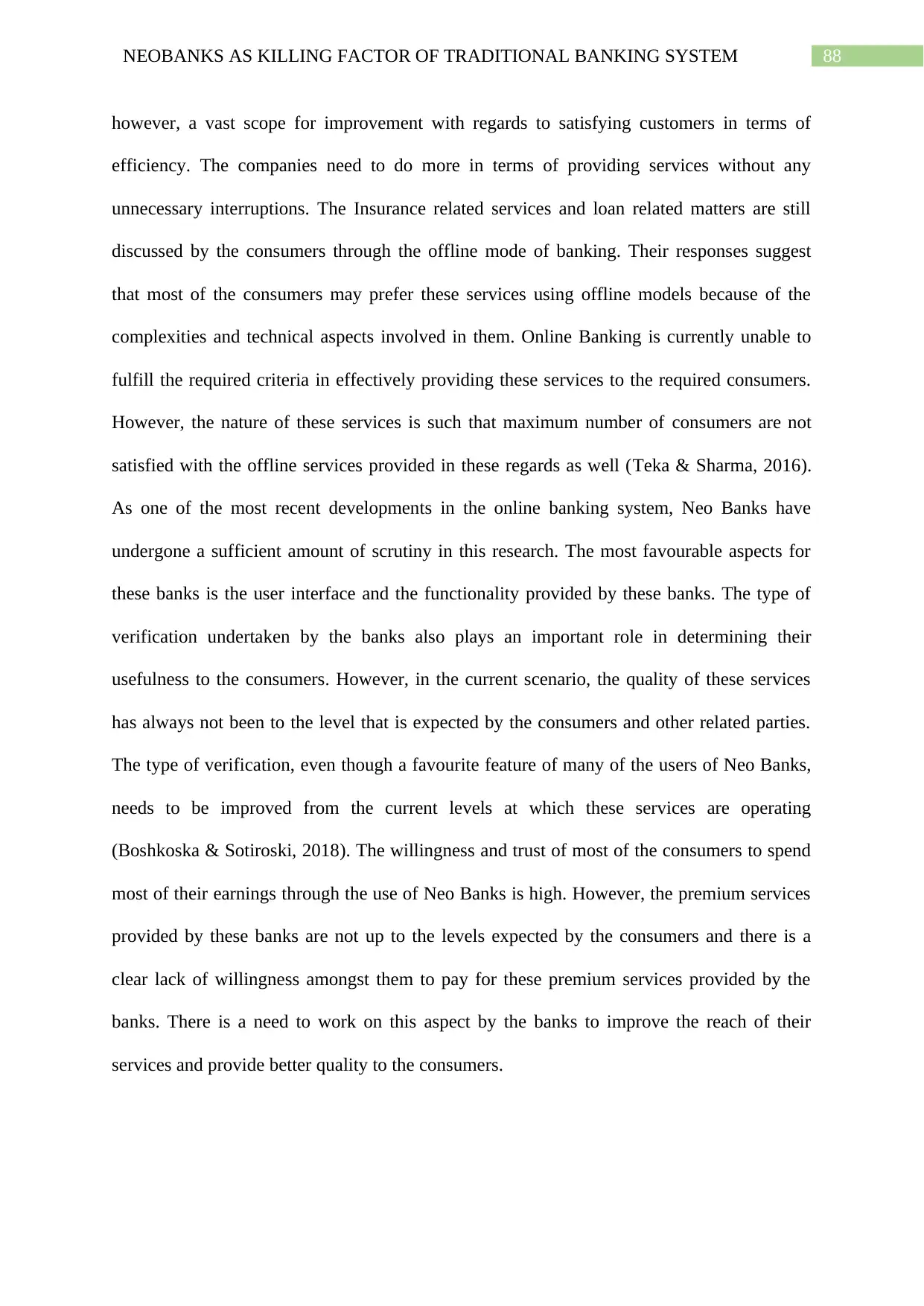
88NEOBANKS AS KILLING FACTOR OF TRADITIONAL BANKING SYSTEM
however, a vast scope for improvement with regards to satisfying customers in terms of
efficiency. The companies need to do more in terms of providing services without any
unnecessary interruptions. The Insurance related services and loan related matters are still
discussed by the consumers through the offline mode of banking. Their responses suggest
that most of the consumers may prefer these services using offline models because of the
complexities and technical aspects involved in them. Online Banking is currently unable to
fulfill the required criteria in effectively providing these services to the required consumers.
However, the nature of these services is such that maximum number of consumers are not
satisfied with the offline services provided in these regards as well (Teka & Sharma, 2016).
As one of the most recent developments in the online banking system, Neo Banks have
undergone a sufficient amount of scrutiny in this research. The most favourable aspects for
these banks is the user interface and the functionality provided by these banks. The type of
verification undertaken by the banks also plays an important role in determining their
usefulness to the consumers. However, in the current scenario, the quality of these services
has always not been to the level that is expected by the consumers and other related parties.
The type of verification, even though a favourite feature of many of the users of Neo Banks,
needs to be improved from the current levels at which these services are operating
(Boshkoska & Sotiroski, 2018). The willingness and trust of most of the consumers to spend
most of their earnings through the use of Neo Banks is high. However, the premium services
provided by these banks are not up to the levels expected by the consumers and there is a
clear lack of willingness amongst them to pay for these premium services provided by the
banks. There is a need to work on this aspect by the banks to improve the reach of their
services and provide better quality to the consumers.
however, a vast scope for improvement with regards to satisfying customers in terms of
efficiency. The companies need to do more in terms of providing services without any
unnecessary interruptions. The Insurance related services and loan related matters are still
discussed by the consumers through the offline mode of banking. Their responses suggest
that most of the consumers may prefer these services using offline models because of the
complexities and technical aspects involved in them. Online Banking is currently unable to
fulfill the required criteria in effectively providing these services to the required consumers.
However, the nature of these services is such that maximum number of consumers are not
satisfied with the offline services provided in these regards as well (Teka & Sharma, 2016).
As one of the most recent developments in the online banking system, Neo Banks have
undergone a sufficient amount of scrutiny in this research. The most favourable aspects for
these banks is the user interface and the functionality provided by these banks. The type of
verification undertaken by the banks also plays an important role in determining their
usefulness to the consumers. However, in the current scenario, the quality of these services
has always not been to the level that is expected by the consumers and other related parties.
The type of verification, even though a favourite feature of many of the users of Neo Banks,
needs to be improved from the current levels at which these services are operating
(Boshkoska & Sotiroski, 2018). The willingness and trust of most of the consumers to spend
most of their earnings through the use of Neo Banks is high. However, the premium services
provided by these banks are not up to the levels expected by the consumers and there is a
clear lack of willingness amongst them to pay for these premium services provided by the
banks. There is a need to work on this aspect by the banks to improve the reach of their
services and provide better quality to the consumers.
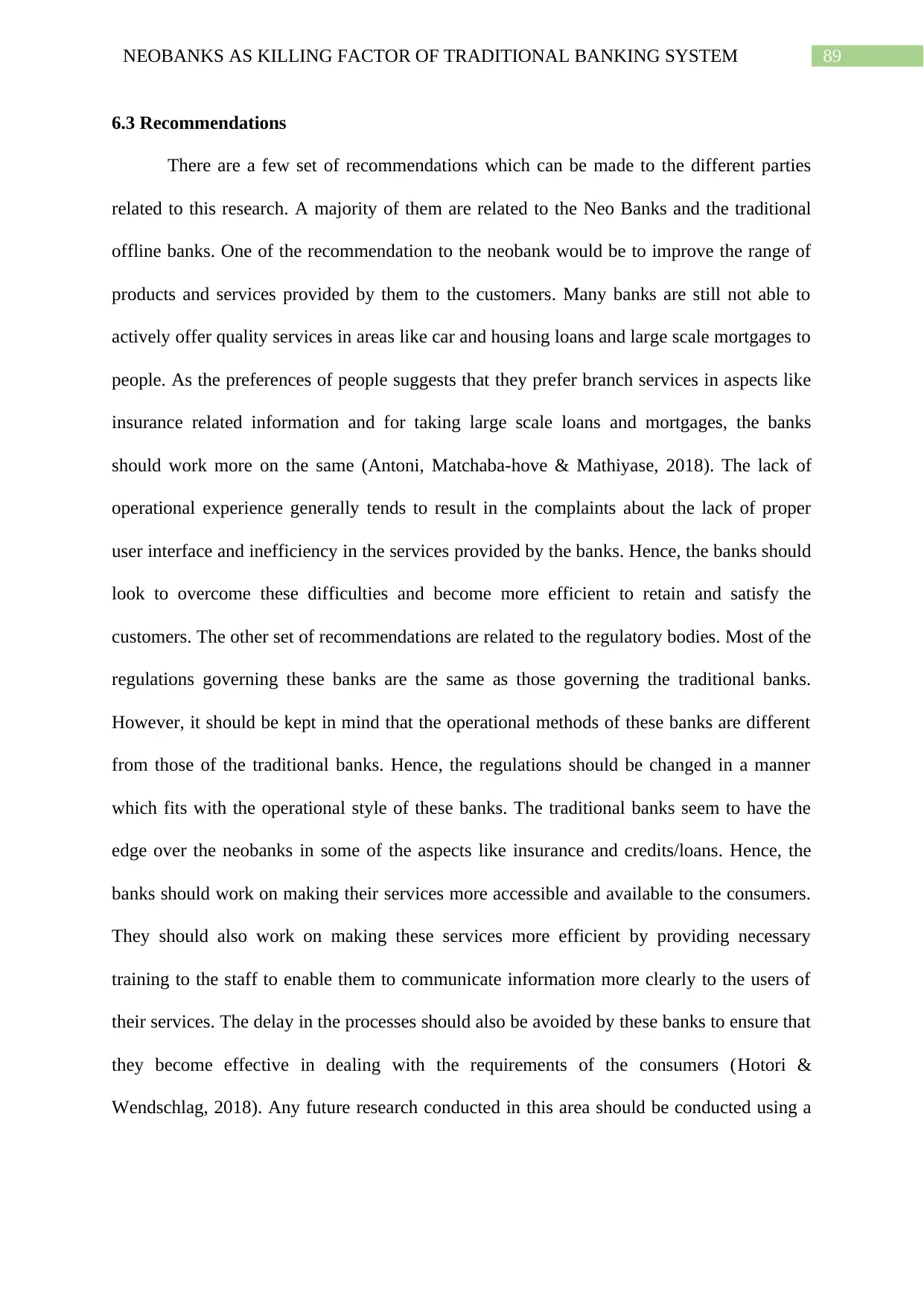
89NEOBANKS AS KILLING FACTOR OF TRADITIONAL BANKING SYSTEM
6.3 Recommendations
There are a few set of recommendations which can be made to the different parties
related to this research. A majority of them are related to the Neo Banks and the traditional
offline banks. One of the recommendation to the neobank would be to improve the range of
products and services provided by them to the customers. Many banks are still not able to
actively offer quality services in areas like car and housing loans and large scale mortgages to
people. As the preferences of people suggests that they prefer branch services in aspects like
insurance related information and for taking large scale loans and mortgages, the banks
should work more on the same (Antoni, Matchaba-hove & Mathiyase, 2018). The lack of
operational experience generally tends to result in the complaints about the lack of proper
user interface and inefficiency in the services provided by the banks. Hence, the banks should
look to overcome these difficulties and become more efficient to retain and satisfy the
customers. The other set of recommendations are related to the regulatory bodies. Most of the
regulations governing these banks are the same as those governing the traditional banks.
However, it should be kept in mind that the operational methods of these banks are different
from those of the traditional banks. Hence, the regulations should be changed in a manner
which fits with the operational style of these banks. The traditional banks seem to have the
edge over the neobanks in some of the aspects like insurance and credits/loans. Hence, the
banks should work on making their services more accessible and available to the consumers.
They should also work on making these services more efficient by providing necessary
training to the staff to enable them to communicate information more clearly to the users of
their services. The delay in the processes should also be avoided by these banks to ensure that
they become effective in dealing with the requirements of the consumers (Hotori &
Wendschlag, 2018). Any future research conducted in this area should be conducted using a
6.3 Recommendations
There are a few set of recommendations which can be made to the different parties
related to this research. A majority of them are related to the Neo Banks and the traditional
offline banks. One of the recommendation to the neobank would be to improve the range of
products and services provided by them to the customers. Many banks are still not able to
actively offer quality services in areas like car and housing loans and large scale mortgages to
people. As the preferences of people suggests that they prefer branch services in aspects like
insurance related information and for taking large scale loans and mortgages, the banks
should work more on the same (Antoni, Matchaba-hove & Mathiyase, 2018). The lack of
operational experience generally tends to result in the complaints about the lack of proper
user interface and inefficiency in the services provided by the banks. Hence, the banks should
look to overcome these difficulties and become more efficient to retain and satisfy the
customers. The other set of recommendations are related to the regulatory bodies. Most of the
regulations governing these banks are the same as those governing the traditional banks.
However, it should be kept in mind that the operational methods of these banks are different
from those of the traditional banks. Hence, the regulations should be changed in a manner
which fits with the operational style of these banks. The traditional banks seem to have the
edge over the neobanks in some of the aspects like insurance and credits/loans. Hence, the
banks should work on making their services more accessible and available to the consumers.
They should also work on making these services more efficient by providing necessary
training to the staff to enable them to communicate information more clearly to the users of
their services. The delay in the processes should also be avoided by these banks to ensure that
they become effective in dealing with the requirements of the consumers (Hotori &
Wendschlag, 2018). Any future research conducted in this area should be conducted using a
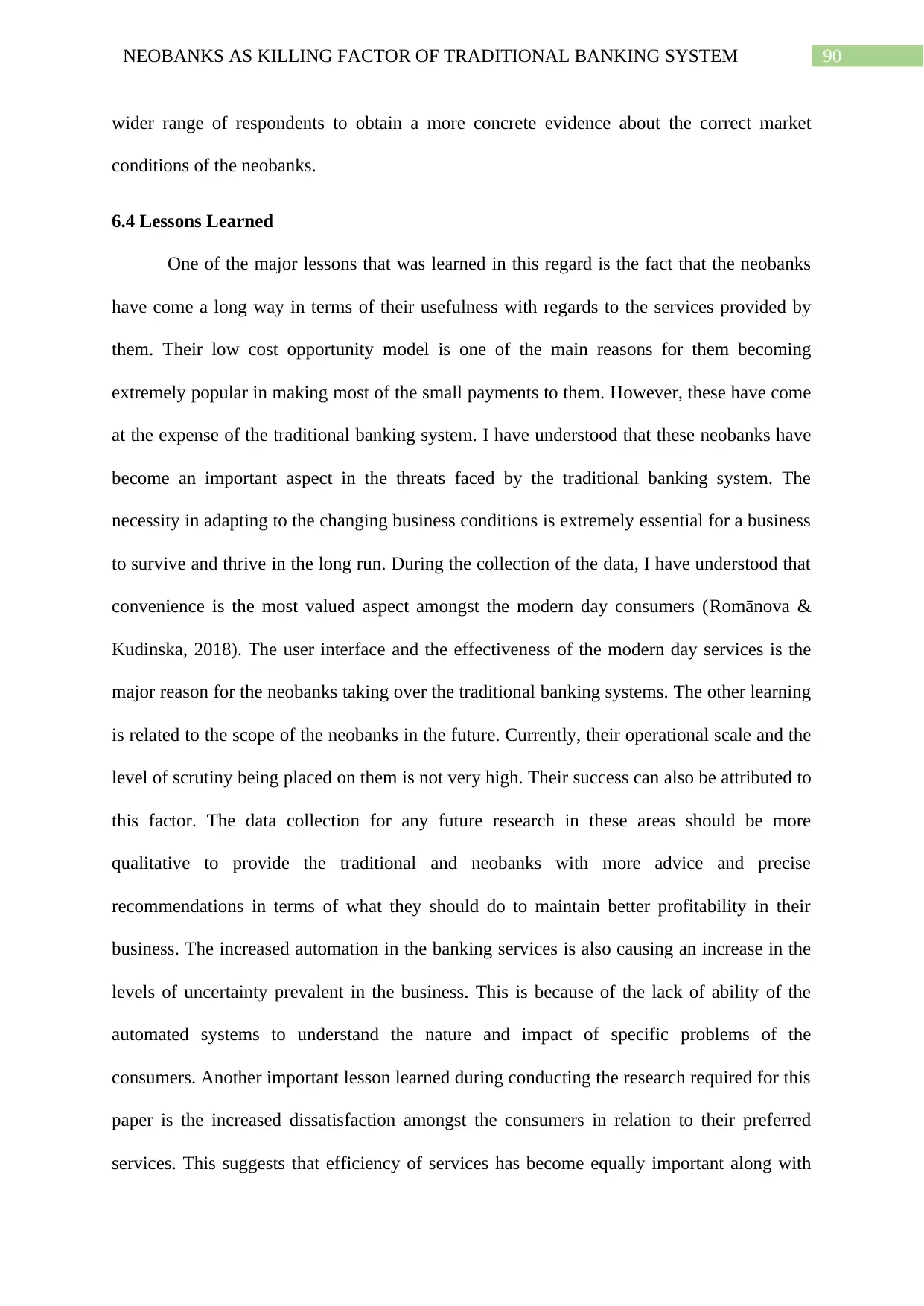
90NEOBANKS AS KILLING FACTOR OF TRADITIONAL BANKING SYSTEM
wider range of respondents to obtain a more concrete evidence about the correct market
conditions of the neobanks.
6.4 Lessons Learned
One of the major lessons that was learned in this regard is the fact that the neobanks
have come a long way in terms of their usefulness with regards to the services provided by
them. Their low cost opportunity model is one of the main reasons for them becoming
extremely popular in making most of the small payments to them. However, these have come
at the expense of the traditional banking system. I have understood that these neobanks have
become an important aspect in the threats faced by the traditional banking system. The
necessity in adapting to the changing business conditions is extremely essential for a business
to survive and thrive in the long run. During the collection of the data, I have understood that
convenience is the most valued aspect amongst the modern day consumers (Romānova &
Kudinska, 2018). The user interface and the effectiveness of the modern day services is the
major reason for the neobanks taking over the traditional banking systems. The other learning
is related to the scope of the neobanks in the future. Currently, their operational scale and the
level of scrutiny being placed on them is not very high. Their success can also be attributed to
this factor. The data collection for any future research in these areas should be more
qualitative to provide the traditional and neobanks with more advice and precise
recommendations in terms of what they should do to maintain better profitability in their
business. The increased automation in the banking services is also causing an increase in the
levels of uncertainty prevalent in the business. This is because of the lack of ability of the
automated systems to understand the nature and impact of specific problems of the
consumers. Another important lesson learned during conducting the research required for this
paper is the increased dissatisfaction amongst the consumers in relation to their preferred
services. This suggests that efficiency of services has become equally important along with
wider range of respondents to obtain a more concrete evidence about the correct market
conditions of the neobanks.
6.4 Lessons Learned
One of the major lessons that was learned in this regard is the fact that the neobanks
have come a long way in terms of their usefulness with regards to the services provided by
them. Their low cost opportunity model is one of the main reasons for them becoming
extremely popular in making most of the small payments to them. However, these have come
at the expense of the traditional banking system. I have understood that these neobanks have
become an important aspect in the threats faced by the traditional banking system. The
necessity in adapting to the changing business conditions is extremely essential for a business
to survive and thrive in the long run. During the collection of the data, I have understood that
convenience is the most valued aspect amongst the modern day consumers (Romānova &
Kudinska, 2018). The user interface and the effectiveness of the modern day services is the
major reason for the neobanks taking over the traditional banking systems. The other learning
is related to the scope of the neobanks in the future. Currently, their operational scale and the
level of scrutiny being placed on them is not very high. Their success can also be attributed to
this factor. The data collection for any future research in these areas should be more
qualitative to provide the traditional and neobanks with more advice and precise
recommendations in terms of what they should do to maintain better profitability in their
business. The increased automation in the banking services is also causing an increase in the
levels of uncertainty prevalent in the business. This is because of the lack of ability of the
automated systems to understand the nature and impact of specific problems of the
consumers. Another important lesson learned during conducting the research required for this
paper is the increased dissatisfaction amongst the consumers in relation to their preferred
services. This suggests that efficiency of services has become equally important along with
Paraphrase This Document
Need a fresh take? Get an instant paraphrase of this document with our AI Paraphraser
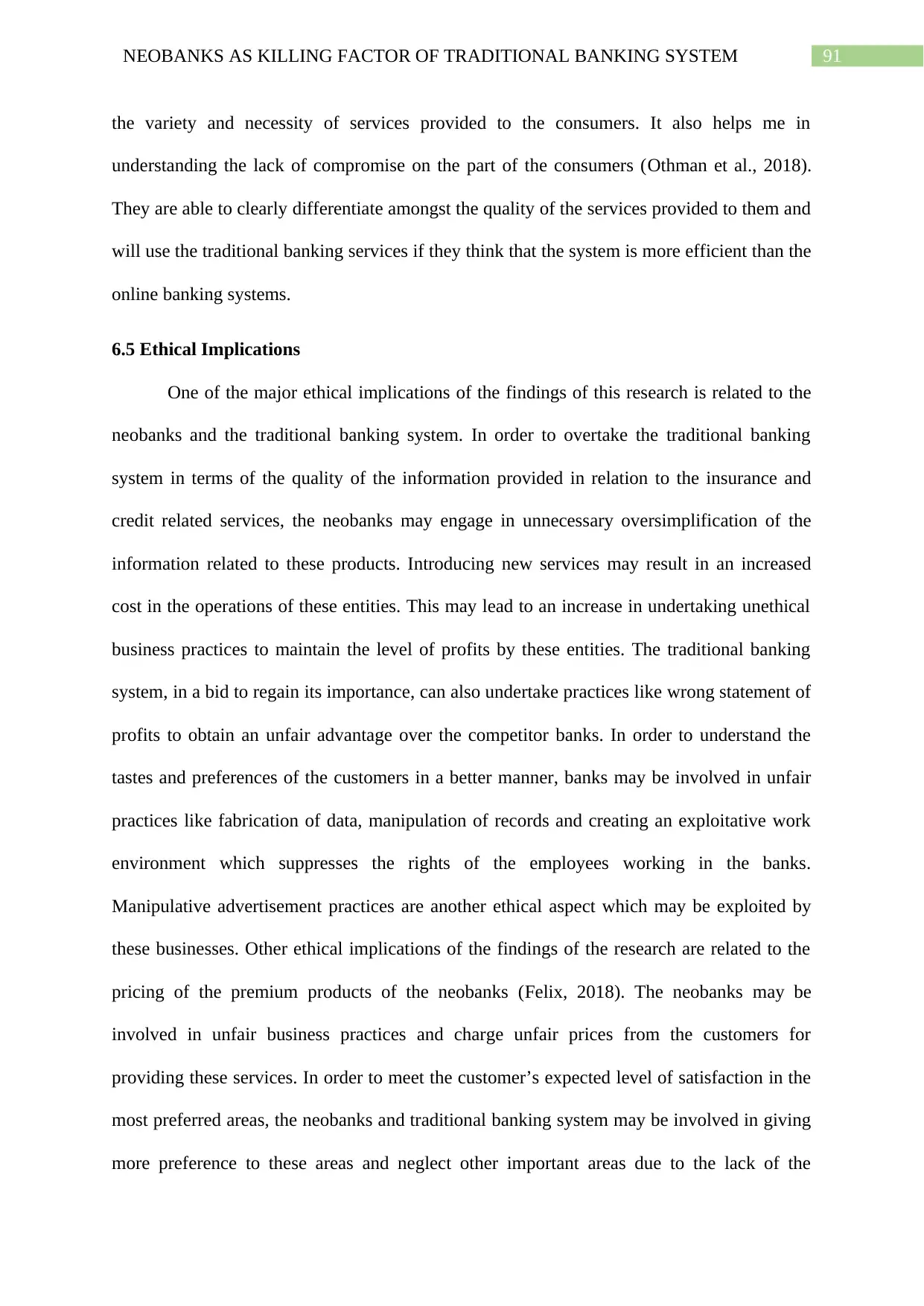
91NEOBANKS AS KILLING FACTOR OF TRADITIONAL BANKING SYSTEM
the variety and necessity of services provided to the consumers. It also helps me in
understanding the lack of compromise on the part of the consumers (Othman et al., 2018).
They are able to clearly differentiate amongst the quality of the services provided to them and
will use the traditional banking services if they think that the system is more efficient than the
online banking systems.
6.5 Ethical Implications
One of the major ethical implications of the findings of this research is related to the
neobanks and the traditional banking system. In order to overtake the traditional banking
system in terms of the quality of the information provided in relation to the insurance and
credit related services, the neobanks may engage in unnecessary oversimplification of the
information related to these products. Introducing new services may result in an increased
cost in the operations of these entities. This may lead to an increase in undertaking unethical
business practices to maintain the level of profits by these entities. The traditional banking
system, in a bid to regain its importance, can also undertake practices like wrong statement of
profits to obtain an unfair advantage over the competitor banks. In order to understand the
tastes and preferences of the customers in a better manner, banks may be involved in unfair
practices like fabrication of data, manipulation of records and creating an exploitative work
environment which suppresses the rights of the employees working in the banks.
Manipulative advertisement practices are another ethical aspect which may be exploited by
these businesses. Other ethical implications of the findings of the research are related to the
pricing of the premium products of the neobanks (Felix, 2018). The neobanks may be
involved in unfair business practices and charge unfair prices from the customers for
providing these services. In order to meet the customer’s expected level of satisfaction in the
most preferred areas, the neobanks and traditional banking system may be involved in giving
more preference to these areas and neglect other important areas due to the lack of the
the variety and necessity of services provided to the consumers. It also helps me in
understanding the lack of compromise on the part of the consumers (Othman et al., 2018).
They are able to clearly differentiate amongst the quality of the services provided to them and
will use the traditional banking services if they think that the system is more efficient than the
online banking systems.
6.5 Ethical Implications
One of the major ethical implications of the findings of this research is related to the
neobanks and the traditional banking system. In order to overtake the traditional banking
system in terms of the quality of the information provided in relation to the insurance and
credit related services, the neobanks may engage in unnecessary oversimplification of the
information related to these products. Introducing new services may result in an increased
cost in the operations of these entities. This may lead to an increase in undertaking unethical
business practices to maintain the level of profits by these entities. The traditional banking
system, in a bid to regain its importance, can also undertake practices like wrong statement of
profits to obtain an unfair advantage over the competitor banks. In order to understand the
tastes and preferences of the customers in a better manner, banks may be involved in unfair
practices like fabrication of data, manipulation of records and creating an exploitative work
environment which suppresses the rights of the employees working in the banks.
Manipulative advertisement practices are another ethical aspect which may be exploited by
these businesses. Other ethical implications of the findings of the research are related to the
pricing of the premium products of the neobanks (Felix, 2018). The neobanks may be
involved in unfair business practices and charge unfair prices from the customers for
providing these services. In order to meet the customer’s expected level of satisfaction in the
most preferred areas, the neobanks and traditional banking system may be involved in giving
more preference to these areas and neglect other important areas due to the lack of the
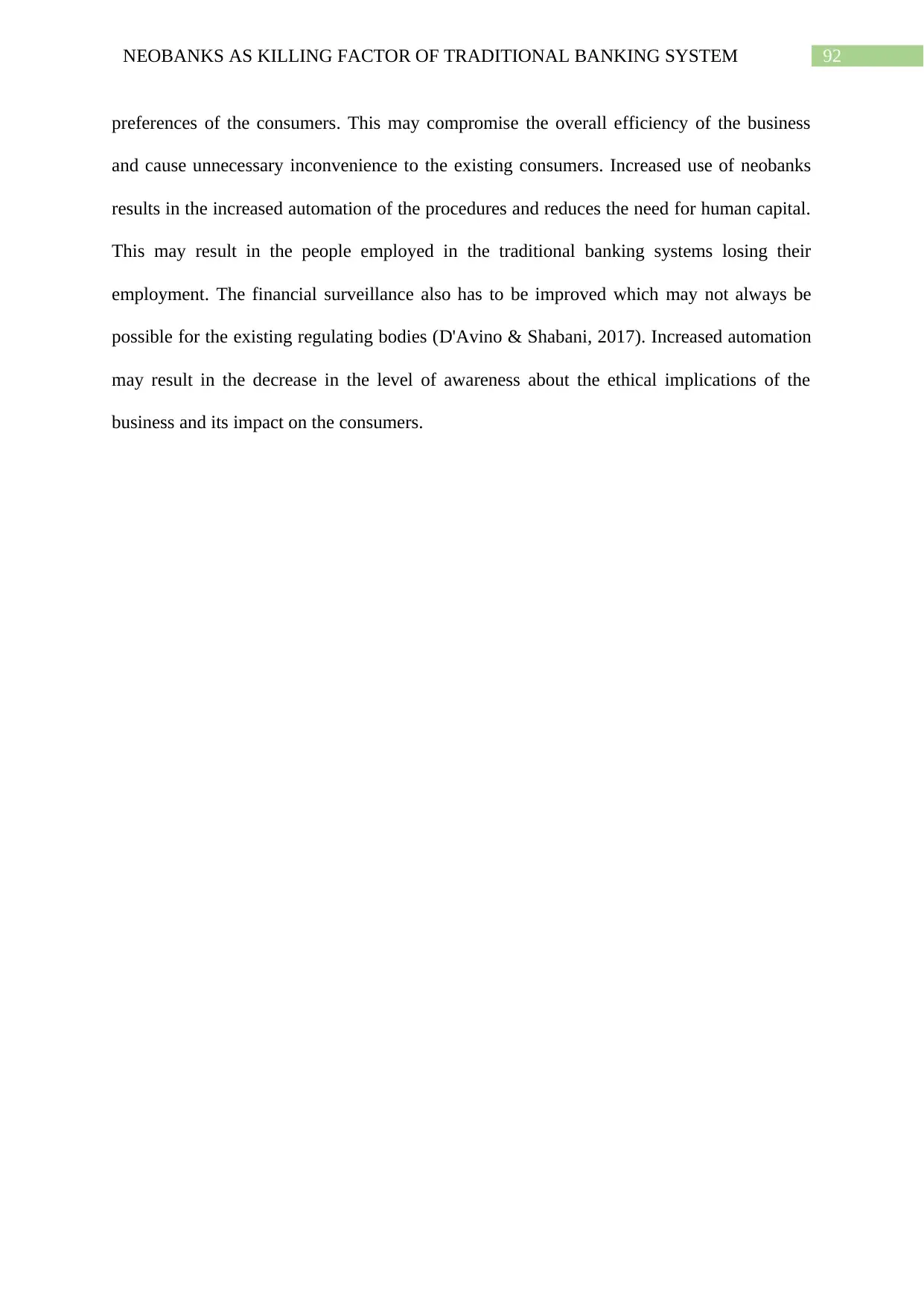
92NEOBANKS AS KILLING FACTOR OF TRADITIONAL BANKING SYSTEM
preferences of the consumers. This may compromise the overall efficiency of the business
and cause unnecessary inconvenience to the existing consumers. Increased use of neobanks
results in the increased automation of the procedures and reduces the need for human capital.
This may result in the people employed in the traditional banking systems losing their
employment. The financial surveillance also has to be improved which may not always be
possible for the existing regulating bodies (D'Avino & Shabani, 2017). Increased automation
may result in the decrease in the level of awareness about the ethical implications of the
business and its impact on the consumers.
preferences of the consumers. This may compromise the overall efficiency of the business
and cause unnecessary inconvenience to the existing consumers. Increased use of neobanks
results in the increased automation of the procedures and reduces the need for human capital.
This may result in the people employed in the traditional banking systems losing their
employment. The financial surveillance also has to be improved which may not always be
possible for the existing regulating bodies (D'Avino & Shabani, 2017). Increased automation
may result in the decrease in the level of awareness about the ethical implications of the
business and its impact on the consumers.
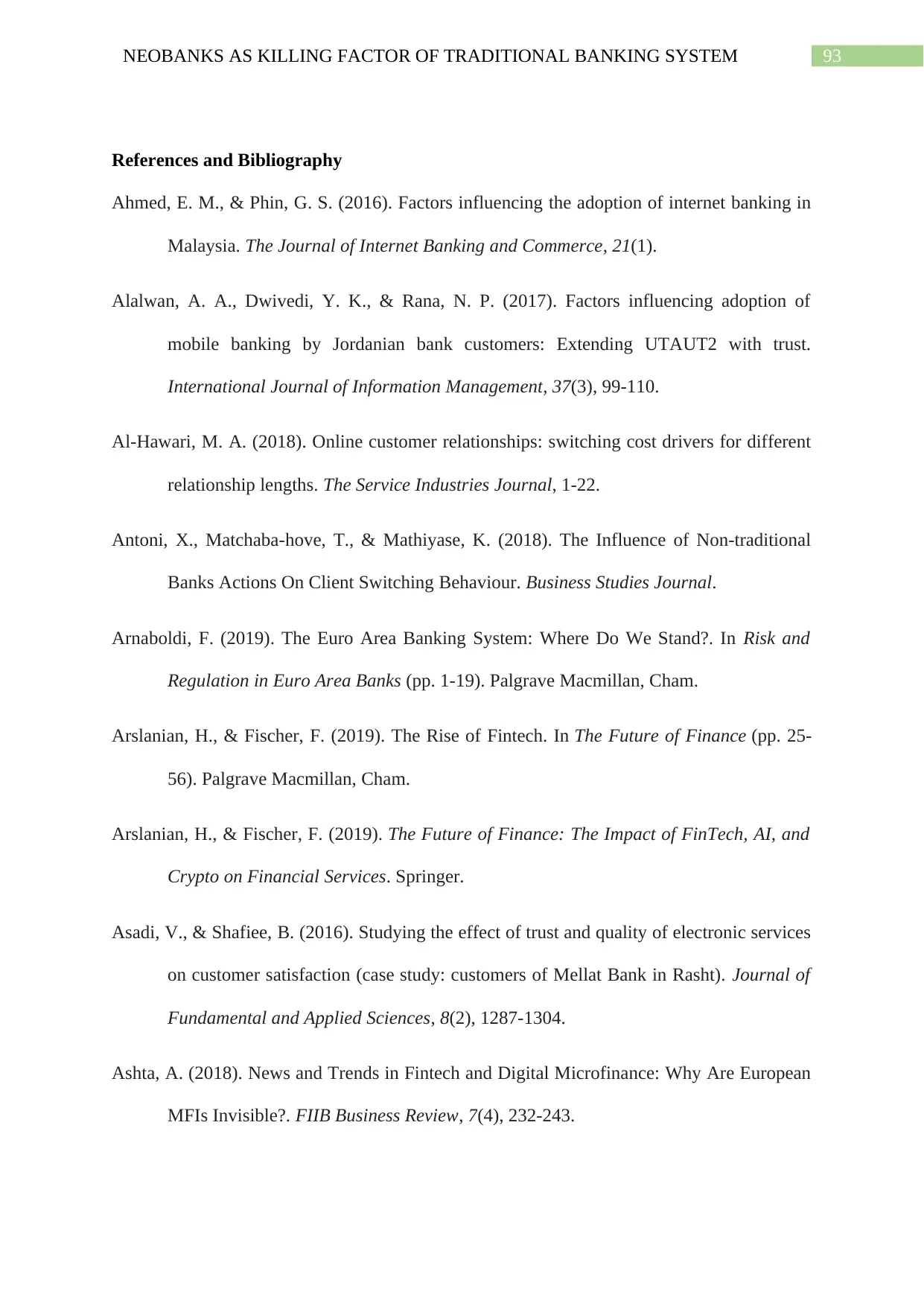
93NEOBANKS AS KILLING FACTOR OF TRADITIONAL BANKING SYSTEM
References and Bibliography
Ahmed, E. M., & Phin, G. S. (2016). Factors influencing the adoption of internet banking in
Malaysia. The Journal of Internet Banking and Commerce, 21(1).
Alalwan, A. A., Dwivedi, Y. K., & Rana, N. P. (2017). Factors influencing adoption of
mobile banking by Jordanian bank customers: Extending UTAUT2 with trust.
International Journal of Information Management, 37(3), 99-110.
Al-Hawari, M. A. (2018). Online customer relationships: switching cost drivers for different
relationship lengths. The Service Industries Journal, 1-22.
Antoni, X., Matchaba-hove, T., & Mathiyase, K. (2018). The Influence of Non-traditional
Banks Actions On Client Switching Behaviour. Business Studies Journal.
Arnaboldi, F. (2019). The Euro Area Banking System: Where Do We Stand?. In Risk and
Regulation in Euro Area Banks (pp. 1-19). Palgrave Macmillan, Cham.
Arslanian, H., & Fischer, F. (2019). The Rise of Fintech. In The Future of Finance (pp. 25-
56). Palgrave Macmillan, Cham.
Arslanian, H., & Fischer, F. (2019). The Future of Finance: The Impact of FinTech, AI, and
Crypto on Financial Services. Springer.
Asadi, V., & Shafiee, B. (2016). Studying the effect of trust and quality of electronic services
on customer satisfaction (case study: customers of Mellat Bank in Rasht). Journal of
Fundamental and Applied Sciences, 8(2), 1287-1304.
Ashta, A. (2018). News and Trends in Fintech and Digital Microfinance: Why Are European
MFIs Invisible?. FIIB Business Review, 7(4), 232-243.
References and Bibliography
Ahmed, E. M., & Phin, G. S. (2016). Factors influencing the adoption of internet banking in
Malaysia. The Journal of Internet Banking and Commerce, 21(1).
Alalwan, A. A., Dwivedi, Y. K., & Rana, N. P. (2017). Factors influencing adoption of
mobile banking by Jordanian bank customers: Extending UTAUT2 with trust.
International Journal of Information Management, 37(3), 99-110.
Al-Hawari, M. A. (2018). Online customer relationships: switching cost drivers for different
relationship lengths. The Service Industries Journal, 1-22.
Antoni, X., Matchaba-hove, T., & Mathiyase, K. (2018). The Influence of Non-traditional
Banks Actions On Client Switching Behaviour. Business Studies Journal.
Arnaboldi, F. (2019). The Euro Area Banking System: Where Do We Stand?. In Risk and
Regulation in Euro Area Banks (pp. 1-19). Palgrave Macmillan, Cham.
Arslanian, H., & Fischer, F. (2019). The Rise of Fintech. In The Future of Finance (pp. 25-
56). Palgrave Macmillan, Cham.
Arslanian, H., & Fischer, F. (2019). The Future of Finance: The Impact of FinTech, AI, and
Crypto on Financial Services. Springer.
Asadi, V., & Shafiee, B. (2016). Studying the effect of trust and quality of electronic services
on customer satisfaction (case study: customers of Mellat Bank in Rasht). Journal of
Fundamental and Applied Sciences, 8(2), 1287-1304.
Ashta, A. (2018). News and Trends in Fintech and Digital Microfinance: Why Are European
MFIs Invisible?. FIIB Business Review, 7(4), 232-243.
Secure Best Marks with AI Grader
Need help grading? Try our AI Grader for instant feedback on your assignments.
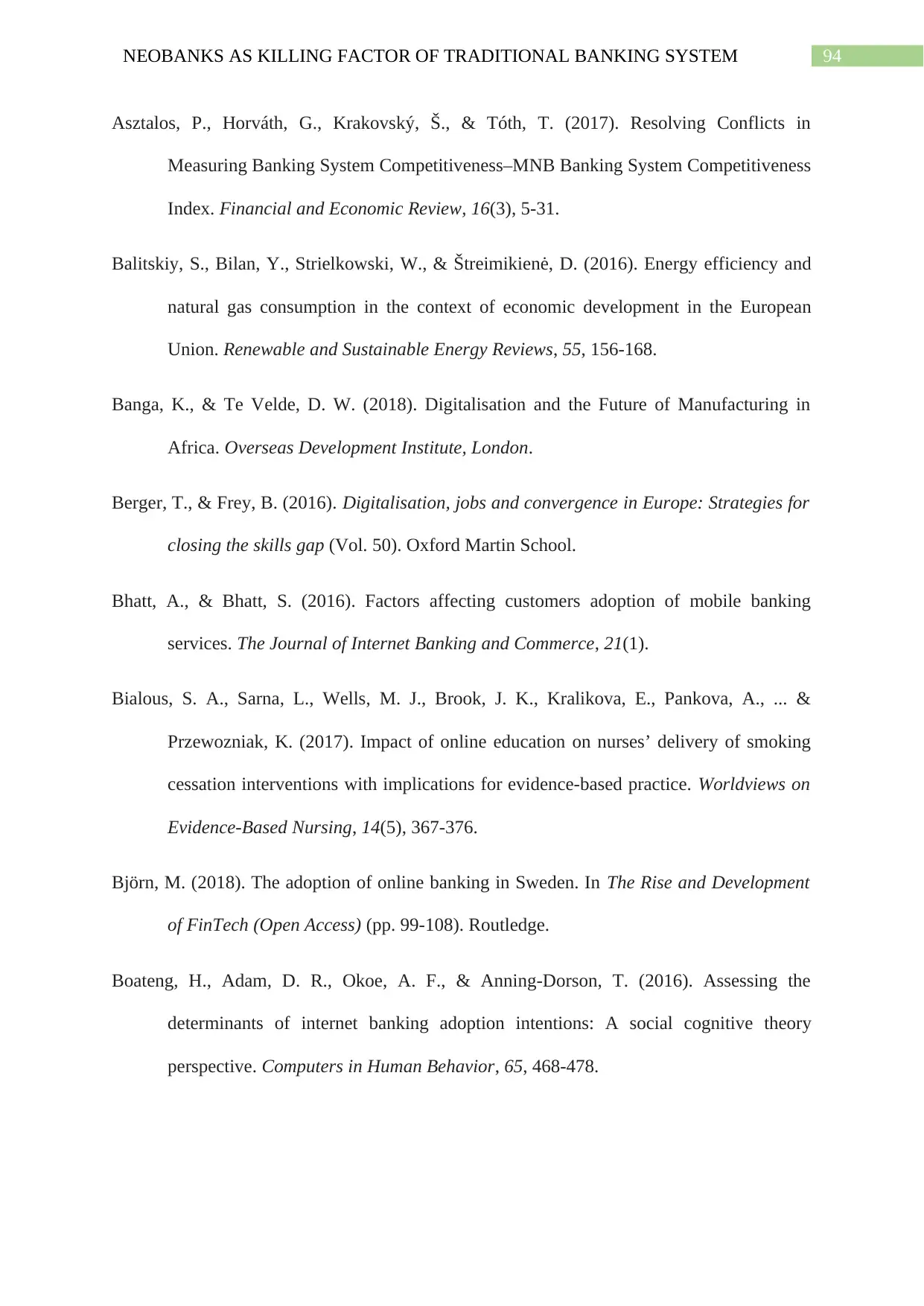
94NEOBANKS AS KILLING FACTOR OF TRADITIONAL BANKING SYSTEM
Asztalos, P., Horváth, G., Krakovský, Š., & Tóth, T. (2017). Resolving Conflicts in
Measuring Banking System Competitiveness–MNB Banking System Competitiveness
Index. Financial and Economic Review, 16(3), 5-31.
Balitskiy, S., Bilan, Y., Strielkowski, W., & Štreimikienė, D. (2016). Energy efficiency and
natural gas consumption in the context of economic development in the European
Union. Renewable and Sustainable Energy Reviews, 55, 156-168.
Banga, K., & Te Velde, D. W. (2018). Digitalisation and the Future of Manufacturing in
Africa. Overseas Development Institute, London.
Berger, T., & Frey, B. (2016). Digitalisation, jobs and convergence in Europe: Strategies for
closing the skills gap (Vol. 50). Oxford Martin School.
Bhatt, A., & Bhatt, S. (2016). Factors affecting customers adoption of mobile banking
services. The Journal of Internet Banking and Commerce, 21(1).
Bialous, S. A., Sarna, L., Wells, M. J., Brook, J. K., Kralikova, E., Pankova, A., ... &
Przewozniak, K. (2017). Impact of online education on nurses’ delivery of smoking
cessation interventions with implications for evidence‐based practice. Worldviews on
Evidence‐Based Nursing, 14(5), 367-376.
Björn, M. (2018). The adoption of online banking in Sweden. In The Rise and Development
of FinTech (Open Access) (pp. 99-108). Routledge.
Boateng, H., Adam, D. R., Okoe, A. F., & Anning-Dorson, T. (2016). Assessing the
determinants of internet banking adoption intentions: A social cognitive theory
perspective. Computers in Human Behavior, 65, 468-478.
Asztalos, P., Horváth, G., Krakovský, Š., & Tóth, T. (2017). Resolving Conflicts in
Measuring Banking System Competitiveness–MNB Banking System Competitiveness
Index. Financial and Economic Review, 16(3), 5-31.
Balitskiy, S., Bilan, Y., Strielkowski, W., & Štreimikienė, D. (2016). Energy efficiency and
natural gas consumption in the context of economic development in the European
Union. Renewable and Sustainable Energy Reviews, 55, 156-168.
Banga, K., & Te Velde, D. W. (2018). Digitalisation and the Future of Manufacturing in
Africa. Overseas Development Institute, London.
Berger, T., & Frey, B. (2016). Digitalisation, jobs and convergence in Europe: Strategies for
closing the skills gap (Vol. 50). Oxford Martin School.
Bhatt, A., & Bhatt, S. (2016). Factors affecting customers adoption of mobile banking
services. The Journal of Internet Banking and Commerce, 21(1).
Bialous, S. A., Sarna, L., Wells, M. J., Brook, J. K., Kralikova, E., Pankova, A., ... &
Przewozniak, K. (2017). Impact of online education on nurses’ delivery of smoking
cessation interventions with implications for evidence‐based practice. Worldviews on
Evidence‐Based Nursing, 14(5), 367-376.
Björn, M. (2018). The adoption of online banking in Sweden. In The Rise and Development
of FinTech (Open Access) (pp. 99-108). Routledge.
Boateng, H., Adam, D. R., Okoe, A. F., & Anning-Dorson, T. (2016). Assessing the
determinants of internet banking adoption intentions: A social cognitive theory
perspective. Computers in Human Behavior, 65, 468-478.
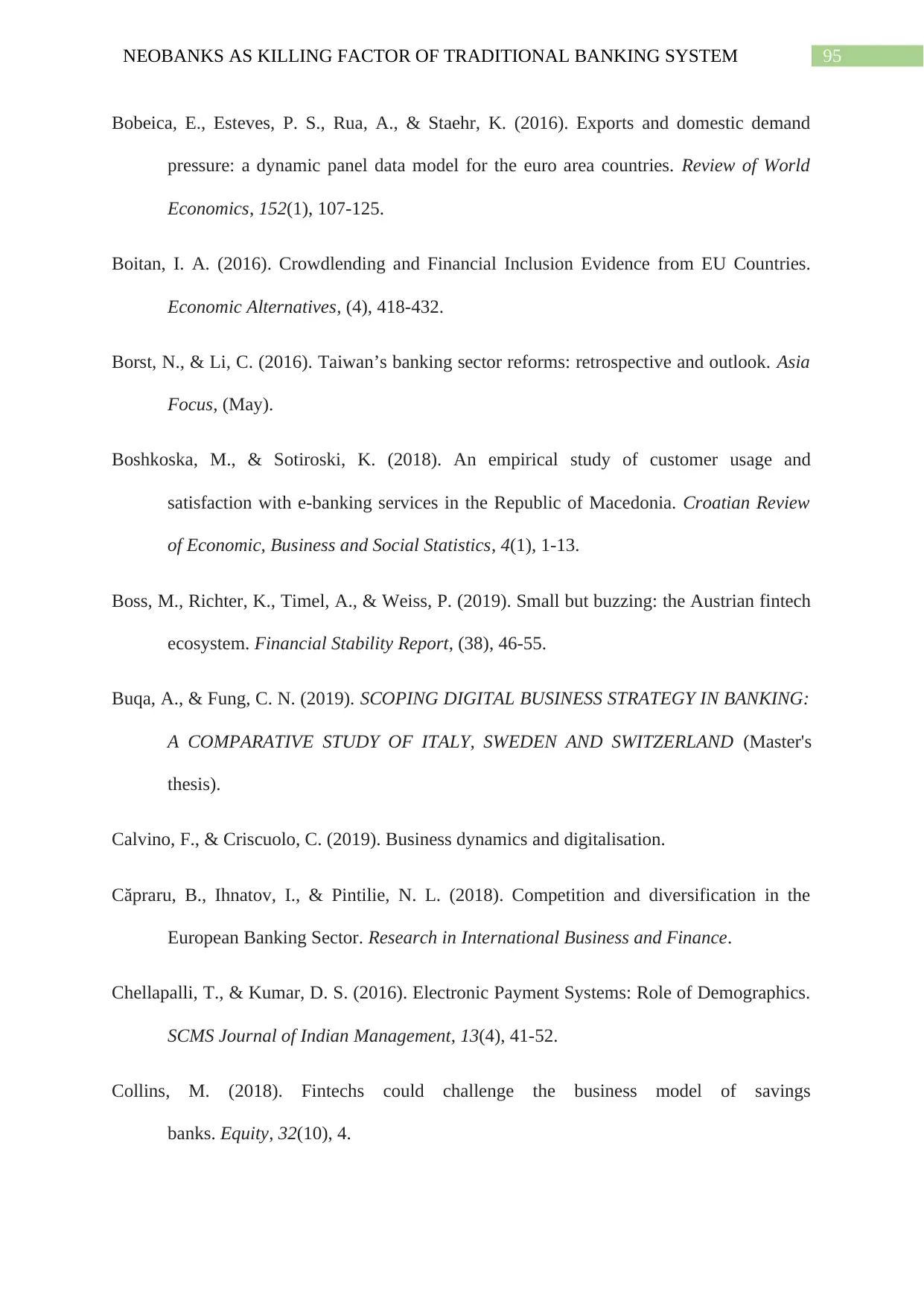
95NEOBANKS AS KILLING FACTOR OF TRADITIONAL BANKING SYSTEM
Bobeica, E., Esteves, P. S., Rua, A., & Staehr, K. (2016). Exports and domestic demand
pressure: a dynamic panel data model for the euro area countries. Review of World
Economics, 152(1), 107-125.
Boitan, I. A. (2016). Crowdlending and Financial Inclusion Evidence from EU Countries.
Economic Alternatives, (4), 418-432.
Borst, N., & Li, C. (2016). Taiwan’s banking sector reforms: retrospective and outlook. Asia
Focus, (May).
Boshkoska, M., & Sotiroski, K. (2018). An empirical study of customer usage and
satisfaction with e-banking services in the Republic of Macedonia. Croatian Review
of Economic, Business and Social Statistics, 4(1), 1-13.
Boss, M., Richter, K., Timel, A., & Weiss, P. (2019). Small but buzzing: the Austrian fintech
ecosystem. Financial Stability Report, (38), 46-55.
Buqa, A., & Fung, C. N. (2019). SCOPING DIGITAL BUSINESS STRATEGY IN BANKING:
A COMPARATIVE STUDY OF ITALY, SWEDEN AND SWITZERLAND (Master's
thesis).
Calvino, F., & Criscuolo, C. (2019). Business dynamics and digitalisation.
Căpraru, B., Ihnatov, I., & Pintilie, N. L. (2018). Competition and diversification in the
European Banking Sector. Research in International Business and Finance.
Chellapalli, T., & Kumar, D. S. (2016). Electronic Payment Systems: Role of Demographics.
SCMS Journal of Indian Management, 13(4), 41-52.
Collins, M. (2018). Fintechs could challenge the business model of savings
banks. Equity, 32(10), 4.
Bobeica, E., Esteves, P. S., Rua, A., & Staehr, K. (2016). Exports and domestic demand
pressure: a dynamic panel data model for the euro area countries. Review of World
Economics, 152(1), 107-125.
Boitan, I. A. (2016). Crowdlending and Financial Inclusion Evidence from EU Countries.
Economic Alternatives, (4), 418-432.
Borst, N., & Li, C. (2016). Taiwan’s banking sector reforms: retrospective and outlook. Asia
Focus, (May).
Boshkoska, M., & Sotiroski, K. (2018). An empirical study of customer usage and
satisfaction with e-banking services in the Republic of Macedonia. Croatian Review
of Economic, Business and Social Statistics, 4(1), 1-13.
Boss, M., Richter, K., Timel, A., & Weiss, P. (2019). Small but buzzing: the Austrian fintech
ecosystem. Financial Stability Report, (38), 46-55.
Buqa, A., & Fung, C. N. (2019). SCOPING DIGITAL BUSINESS STRATEGY IN BANKING:
A COMPARATIVE STUDY OF ITALY, SWEDEN AND SWITZERLAND (Master's
thesis).
Calvino, F., & Criscuolo, C. (2019). Business dynamics and digitalisation.
Căpraru, B., Ihnatov, I., & Pintilie, N. L. (2018). Competition and diversification in the
European Banking Sector. Research in International Business and Finance.
Chellapalli, T., & Kumar, D. S. (2016). Electronic Payment Systems: Role of Demographics.
SCMS Journal of Indian Management, 13(4), 41-52.
Collins, M. (2018). Fintechs could challenge the business model of savings
banks. Equity, 32(10), 4.
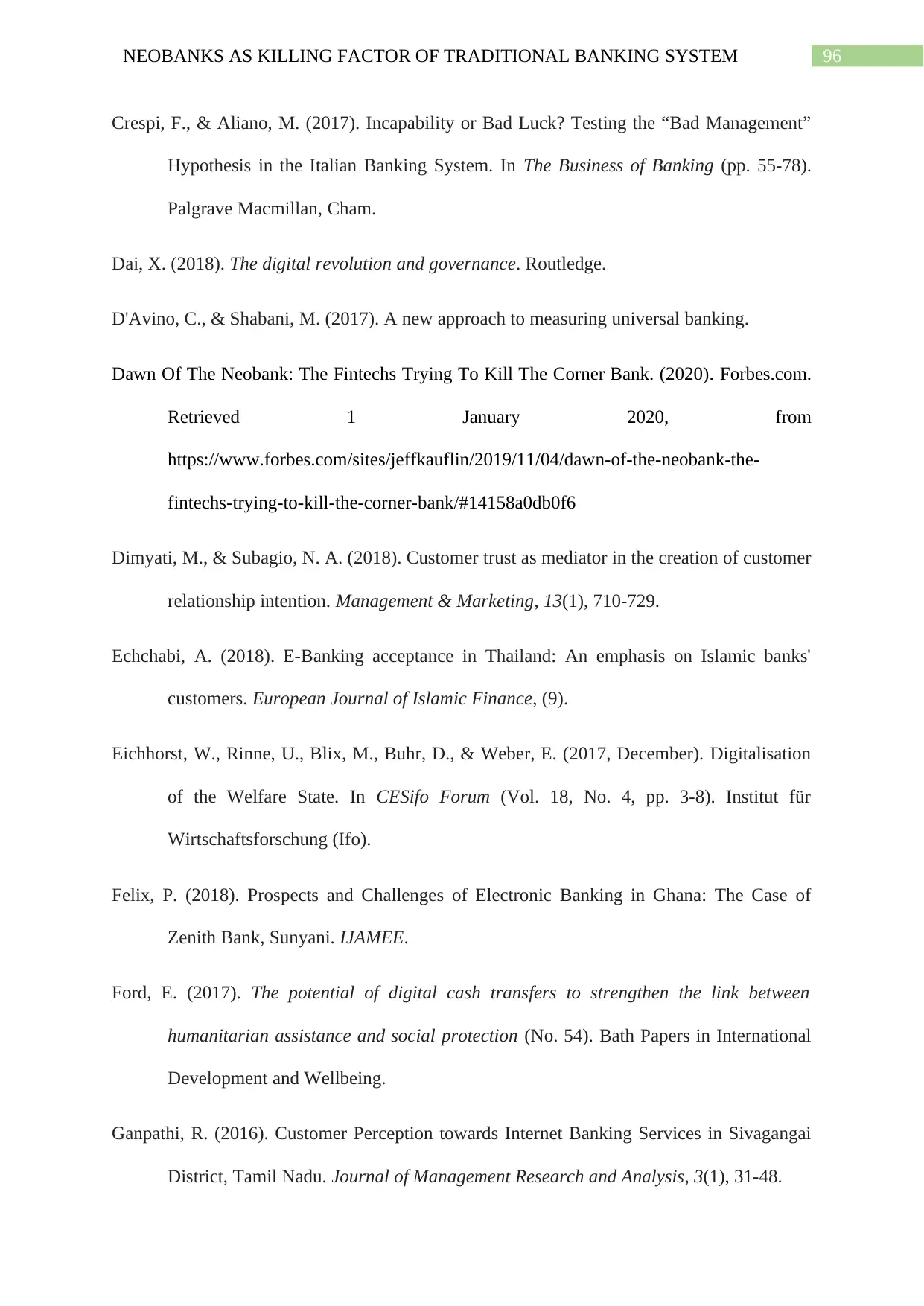
96NEOBANKS AS KILLING FACTOR OF TRADITIONAL BANKING SYSTEM
Crespi, F., & Aliano, M. (2017). Incapability or Bad Luck? Testing the “Bad Management”
Hypothesis in the Italian Banking System. In The Business of Banking (pp. 55-78).
Palgrave Macmillan, Cham.
Dai, X. (2018). The digital revolution and governance. Routledge.
D'Avino, C., & Shabani, M. (2017). A new approach to measuring universal banking.
Dawn Of The Neobank: The Fintechs Trying To Kill The Corner Bank. (2020). Forbes.com.
Retrieved 1 January 2020, from
https://www.forbes.com/sites/jeffkauflin/2019/11/04/dawn-of-the-neobank-the-
fintechs-trying-to-kill-the-corner-bank/#14158a0db0f6
Dimyati, M., & Subagio, N. A. (2018). Customer trust as mediator in the creation of customer
relationship intention. Management & Marketing, 13(1), 710-729.
Echchabi, A. (2018). E-Banking acceptance in Thailand: An emphasis on Islamic banks'
customers. European Journal of Islamic Finance, (9).
Eichhorst, W., Rinne, U., Blix, M., Buhr, D., & Weber, E. (2017, December). Digitalisation
of the Welfare State. In CESifo Forum (Vol. 18, No. 4, pp. 3-8). Institut für
Wirtschaftsforschung (Ifo).
Felix, P. (2018). Prospects and Challenges of Electronic Banking in Ghana: The Case of
Zenith Bank, Sunyani. IJAMEE.
Ford, E. (2017). The potential of digital cash transfers to strengthen the link between
humanitarian assistance and social protection (No. 54). Bath Papers in International
Development and Wellbeing.
Ganpathi, R. (2016). Customer Perception towards Internet Banking Services in Sivagangai
District, Tamil Nadu. Journal of Management Research and Analysis, 3(1), 31-48.
Crespi, F., & Aliano, M. (2017). Incapability or Bad Luck? Testing the “Bad Management”
Hypothesis in the Italian Banking System. In The Business of Banking (pp. 55-78).
Palgrave Macmillan, Cham.
Dai, X. (2018). The digital revolution and governance. Routledge.
D'Avino, C., & Shabani, M. (2017). A new approach to measuring universal banking.
Dawn Of The Neobank: The Fintechs Trying To Kill The Corner Bank. (2020). Forbes.com.
Retrieved 1 January 2020, from
https://www.forbes.com/sites/jeffkauflin/2019/11/04/dawn-of-the-neobank-the-
fintechs-trying-to-kill-the-corner-bank/#14158a0db0f6
Dimyati, M., & Subagio, N. A. (2018). Customer trust as mediator in the creation of customer
relationship intention. Management & Marketing, 13(1), 710-729.
Echchabi, A. (2018). E-Banking acceptance in Thailand: An emphasis on Islamic banks'
customers. European Journal of Islamic Finance, (9).
Eichhorst, W., Rinne, U., Blix, M., Buhr, D., & Weber, E. (2017, December). Digitalisation
of the Welfare State. In CESifo Forum (Vol. 18, No. 4, pp. 3-8). Institut für
Wirtschaftsforschung (Ifo).
Felix, P. (2018). Prospects and Challenges of Electronic Banking in Ghana: The Case of
Zenith Bank, Sunyani. IJAMEE.
Ford, E. (2017). The potential of digital cash transfers to strengthen the link between
humanitarian assistance and social protection (No. 54). Bath Papers in International
Development and Wellbeing.
Ganpathi, R. (2016). Customer Perception towards Internet Banking Services in Sivagangai
District, Tamil Nadu. Journal of Management Research and Analysis, 3(1), 31-48.
Paraphrase This Document
Need a fresh take? Get an instant paraphrase of this document with our AI Paraphraser
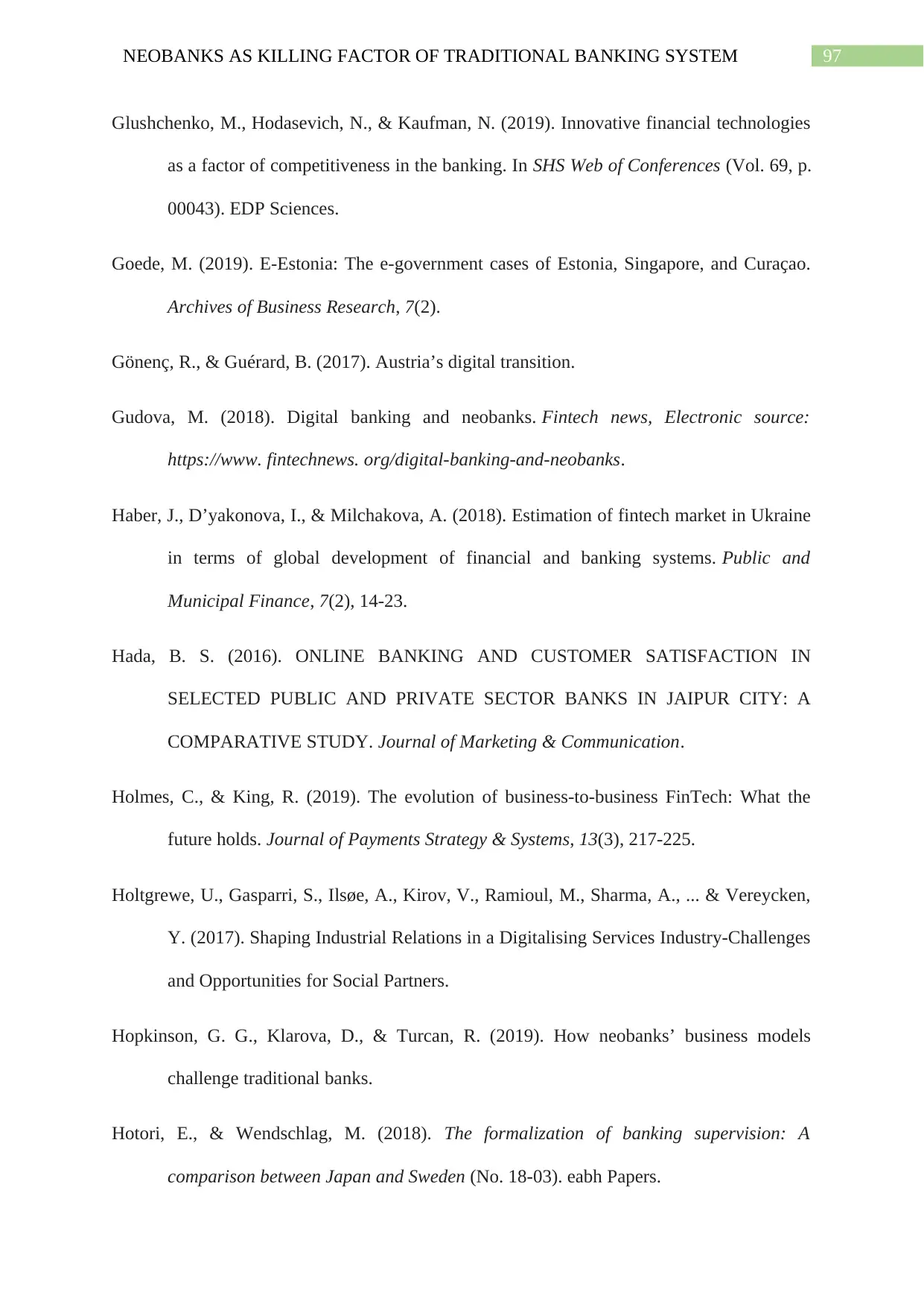
97NEOBANKS AS KILLING FACTOR OF TRADITIONAL BANKING SYSTEM
Glushchenko, M., Hodasevich, N., & Kaufman, N. (2019). Innovative financial technologies
as a factor of competitiveness in the banking. In SHS Web of Conferences (Vol. 69, p.
00043). EDP Sciences.
Goede, M. (2019). E-Estonia: The e-government cases of Estonia, Singapore, and Curaҫao.
Archives of Business Research, 7(2).
Gönenç, R., & Guérard, B. (2017). Austria’s digital transition.
Gudova, M. (2018). Digital banking and neobanks. Fintech news, Electronic source:
https://www. fintechnews. org/digital-banking-and-neobanks.
Haber, J., D’yakonova, I., & Milchakova, A. (2018). Estimation of fintech market in Ukraine
in terms of global development of financial and banking systems. Public and
Municipal Finance, 7(2), 14-23.
Hada, B. S. (2016). ONLINE BANKING AND CUSTOMER SATISFACTION IN
SELECTED PUBLIC AND PRIVATE SECTOR BANKS IN JAIPUR CITY: A
COMPARATIVE STUDY. Journal of Marketing & Communication.
Holmes, C., & King, R. (2019). The evolution of business-to-business FinTech: What the
future holds. Journal of Payments Strategy & Systems, 13(3), 217-225.
Holtgrewe, U., Gasparri, S., Ilsøe, A., Kirov, V., Ramioul, M., Sharma, A., ... & Vereycken,
Y. (2017). Shaping Industrial Relations in a Digitalising Services Industry-Challenges
and Opportunities for Social Partners.
Hopkinson, G. G., Klarova, D., & Turcan, R. (2019). How neobanks’ business models
challenge traditional banks.
Hotori, E., & Wendschlag, M. (2018). The formalization of banking supervision: A
comparison between Japan and Sweden (No. 18-03). eabh Papers.
Glushchenko, M., Hodasevich, N., & Kaufman, N. (2019). Innovative financial technologies
as a factor of competitiveness in the banking. In SHS Web of Conferences (Vol. 69, p.
00043). EDP Sciences.
Goede, M. (2019). E-Estonia: The e-government cases of Estonia, Singapore, and Curaҫao.
Archives of Business Research, 7(2).
Gönenç, R., & Guérard, B. (2017). Austria’s digital transition.
Gudova, M. (2018). Digital banking and neobanks. Fintech news, Electronic source:
https://www. fintechnews. org/digital-banking-and-neobanks.
Haber, J., D’yakonova, I., & Milchakova, A. (2018). Estimation of fintech market in Ukraine
in terms of global development of financial and banking systems. Public and
Municipal Finance, 7(2), 14-23.
Hada, B. S. (2016). ONLINE BANKING AND CUSTOMER SATISFACTION IN
SELECTED PUBLIC AND PRIVATE SECTOR BANKS IN JAIPUR CITY: A
COMPARATIVE STUDY. Journal of Marketing & Communication.
Holmes, C., & King, R. (2019). The evolution of business-to-business FinTech: What the
future holds. Journal of Payments Strategy & Systems, 13(3), 217-225.
Holtgrewe, U., Gasparri, S., Ilsøe, A., Kirov, V., Ramioul, M., Sharma, A., ... & Vereycken,
Y. (2017). Shaping Industrial Relations in a Digitalising Services Industry-Challenges
and Opportunities for Social Partners.
Hopkinson, G. G., Klarova, D., & Turcan, R. (2019). How neobanks’ business models
challenge traditional banks.
Hotori, E., & Wendschlag, M. (2018). The formalization of banking supervision: A
comparison between Japan and Sweden (No. 18-03). eabh Papers.
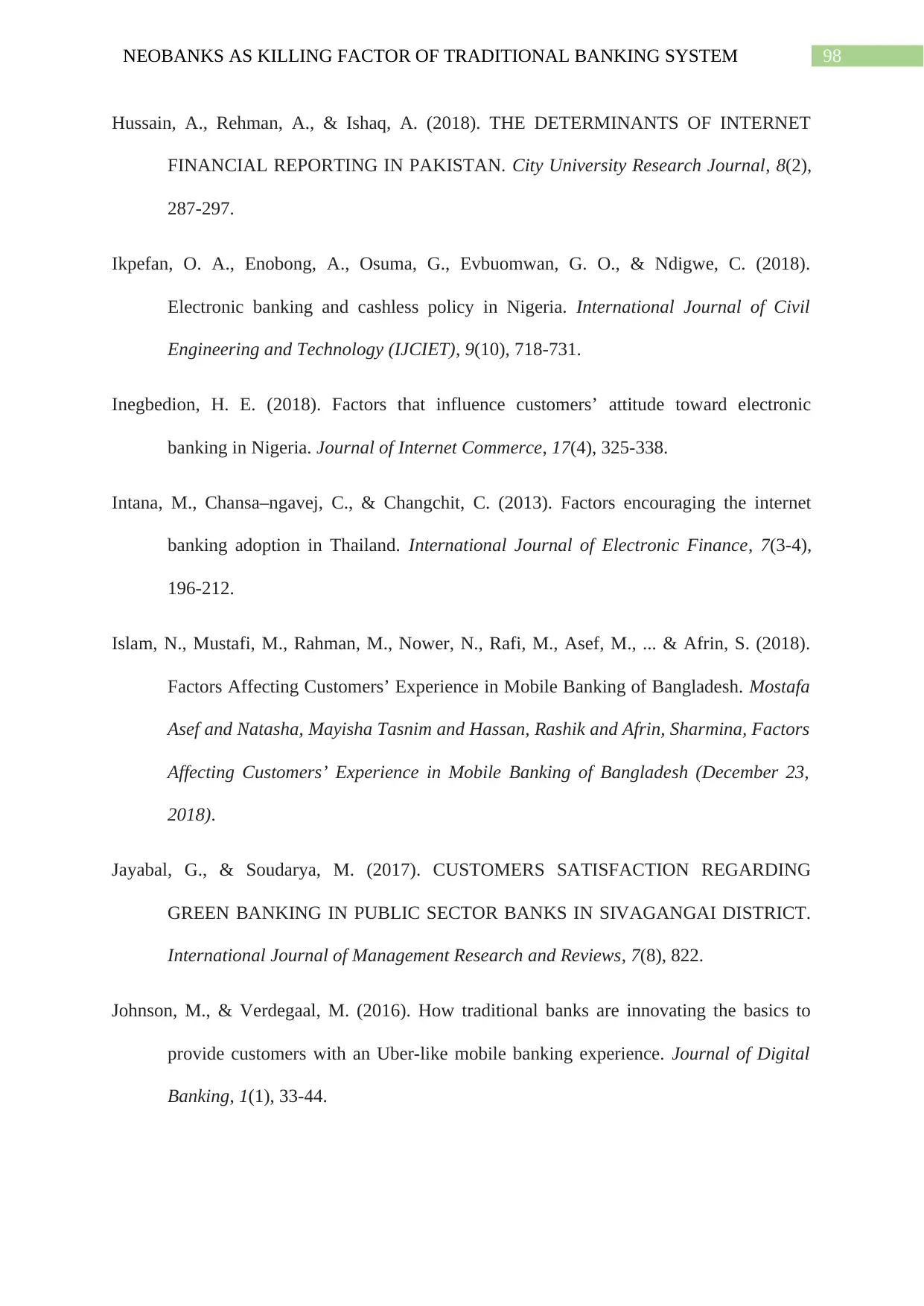
98NEOBANKS AS KILLING FACTOR OF TRADITIONAL BANKING SYSTEM
Hussain, A., Rehman, A., & Ishaq, A. (2018). THE DETERMINANTS OF INTERNET
FINANCIAL REPORTING IN PAKISTAN. City University Research Journal, 8(2),
287-297.
Ikpefan, O. A., Enobong, A., Osuma, G., Evbuomwan, G. O., & Ndigwe, C. (2018).
Electronic banking and cashless policy in Nigeria. International Journal of Civil
Engineering and Technology (IJCIET), 9(10), 718-731.
Inegbedion, H. E. (2018). Factors that influence customers’ attitude toward electronic
banking in Nigeria. Journal of Internet Commerce, 17(4), 325-338.
Intana, M., Chansa–ngavej, C., & Changchit, C. (2013). Factors encouraging the internet
banking adoption in Thailand. International Journal of Electronic Finance, 7(3-4),
196-212.
Islam, N., Mustafi, M., Rahman, M., Nower, N., Rafi, M., Asef, M., ... & Afrin, S. (2018).
Factors Affecting Customers’ Experience in Mobile Banking of Bangladesh. Mostafa
Asef and Natasha, Mayisha Tasnim and Hassan, Rashik and Afrin, Sharmina, Factors
Affecting Customers’ Experience in Mobile Banking of Bangladesh (December 23,
2018).
Jayabal, G., & Soudarya, M. (2017). CUSTOMERS SATISFACTION REGARDING
GREEN BANKING IN PUBLIC SECTOR BANKS IN SIVAGANGAI DISTRICT.
International Journal of Management Research and Reviews, 7(8), 822.
Johnson, M., & Verdegaal, M. (2016). How traditional banks are innovating the basics to
provide customers with an Uber-like mobile banking experience. Journal of Digital
Banking, 1(1), 33-44.
Hussain, A., Rehman, A., & Ishaq, A. (2018). THE DETERMINANTS OF INTERNET
FINANCIAL REPORTING IN PAKISTAN. City University Research Journal, 8(2),
287-297.
Ikpefan, O. A., Enobong, A., Osuma, G., Evbuomwan, G. O., & Ndigwe, C. (2018).
Electronic banking and cashless policy in Nigeria. International Journal of Civil
Engineering and Technology (IJCIET), 9(10), 718-731.
Inegbedion, H. E. (2018). Factors that influence customers’ attitude toward electronic
banking in Nigeria. Journal of Internet Commerce, 17(4), 325-338.
Intana, M., Chansa–ngavej, C., & Changchit, C. (2013). Factors encouraging the internet
banking adoption in Thailand. International Journal of Electronic Finance, 7(3-4),
196-212.
Islam, N., Mustafi, M., Rahman, M., Nower, N., Rafi, M., Asef, M., ... & Afrin, S. (2018).
Factors Affecting Customers’ Experience in Mobile Banking of Bangladesh. Mostafa
Asef and Natasha, Mayisha Tasnim and Hassan, Rashik and Afrin, Sharmina, Factors
Affecting Customers’ Experience in Mobile Banking of Bangladesh (December 23,
2018).
Jayabal, G., & Soudarya, M. (2017). CUSTOMERS SATISFACTION REGARDING
GREEN BANKING IN PUBLIC SECTOR BANKS IN SIVAGANGAI DISTRICT.
International Journal of Management Research and Reviews, 7(8), 822.
Johnson, M., & Verdegaal, M. (2016). How traditional banks are innovating the basics to
provide customers with an Uber-like mobile banking experience. Journal of Digital
Banking, 1(1), 33-44.
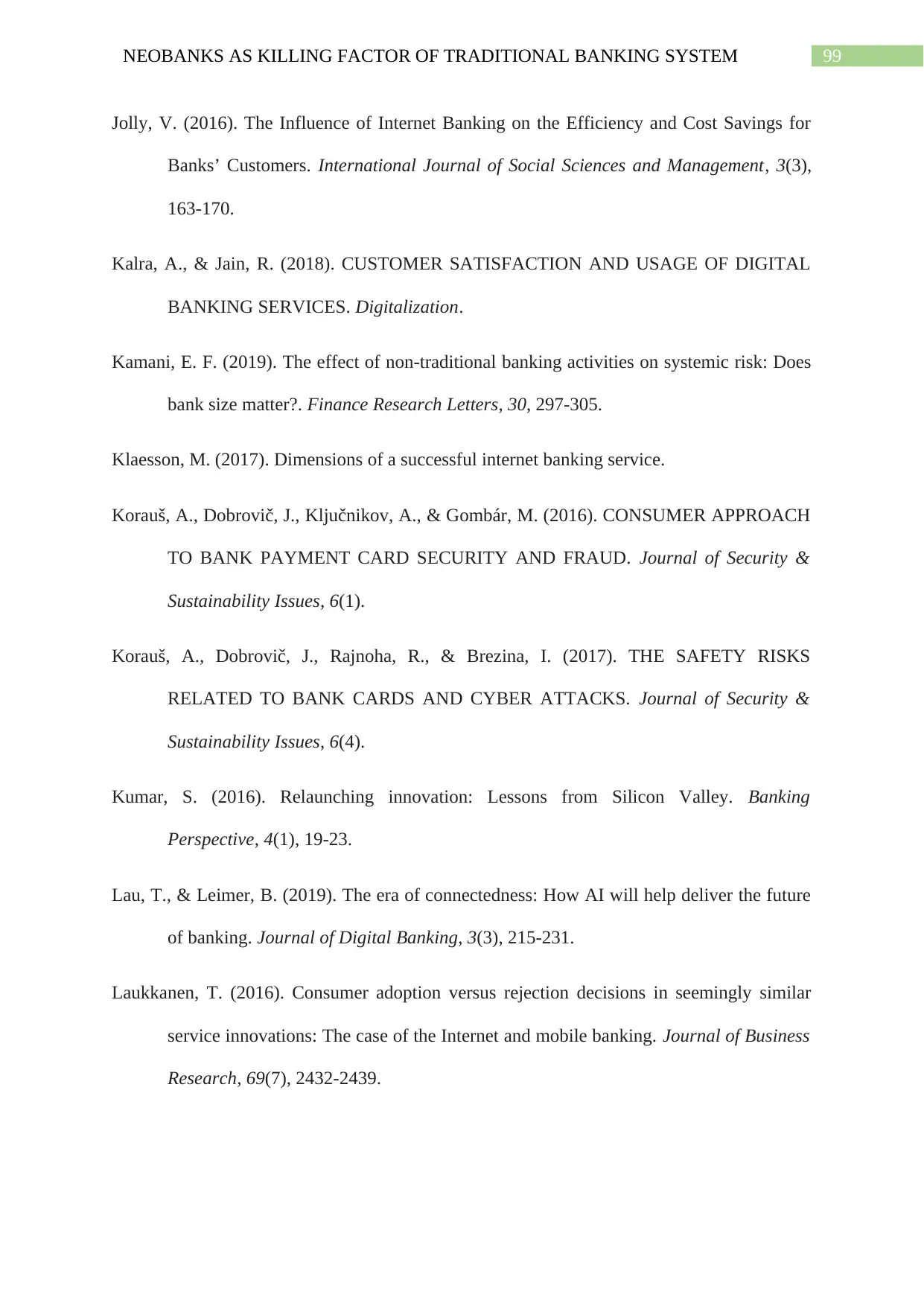
99NEOBANKS AS KILLING FACTOR OF TRADITIONAL BANKING SYSTEM
Jolly, V. (2016). The Influence of Internet Banking on the Efficiency and Cost Savings for
Banks’ Customers. International Journal of Social Sciences and Management, 3(3),
163-170.
Kalra, A., & Jain, R. (2018). CUSTOMER SATISFACTION AND USAGE OF DIGITAL
BANKING SERVICES. Digitalization.
Kamani, E. F. (2019). The effect of non-traditional banking activities on systemic risk: Does
bank size matter?. Finance Research Letters, 30, 297-305.
Klaesson, M. (2017). Dimensions of a successful internet banking service.
Korauš, A., Dobrovič, J., Ključnikov, A., & Gombár, M. (2016). CONSUMER APPROACH
TO BANK PAYMENT CARD SECURITY AND FRAUD. Journal of Security &
Sustainability Issues, 6(1).
Korauš, A., Dobrovič, J., Rajnoha, R., & Brezina, I. (2017). THE SAFETY RISKS
RELATED TO BANK CARDS AND CYBER ATTACKS. Journal of Security &
Sustainability Issues, 6(4).
Kumar, S. (2016). Relaunching innovation: Lessons from Silicon Valley. Banking
Perspective, 4(1), 19-23.
Lau, T., & Leimer, B. (2019). The era of connectedness: How AI will help deliver the future
of banking. Journal of Digital Banking, 3(3), 215-231.
Laukkanen, T. (2016). Consumer adoption versus rejection decisions in seemingly similar
service innovations: The case of the Internet and mobile banking. Journal of Business
Research, 69(7), 2432-2439.
Jolly, V. (2016). The Influence of Internet Banking on the Efficiency and Cost Savings for
Banks’ Customers. International Journal of Social Sciences and Management, 3(3),
163-170.
Kalra, A., & Jain, R. (2018). CUSTOMER SATISFACTION AND USAGE OF DIGITAL
BANKING SERVICES. Digitalization.
Kamani, E. F. (2019). The effect of non-traditional banking activities on systemic risk: Does
bank size matter?. Finance Research Letters, 30, 297-305.
Klaesson, M. (2017). Dimensions of a successful internet banking service.
Korauš, A., Dobrovič, J., Ključnikov, A., & Gombár, M. (2016). CONSUMER APPROACH
TO BANK PAYMENT CARD SECURITY AND FRAUD. Journal of Security &
Sustainability Issues, 6(1).
Korauš, A., Dobrovič, J., Rajnoha, R., & Brezina, I. (2017). THE SAFETY RISKS
RELATED TO BANK CARDS AND CYBER ATTACKS. Journal of Security &
Sustainability Issues, 6(4).
Kumar, S. (2016). Relaunching innovation: Lessons from Silicon Valley. Banking
Perspective, 4(1), 19-23.
Lau, T., & Leimer, B. (2019). The era of connectedness: How AI will help deliver the future
of banking. Journal of Digital Banking, 3(3), 215-231.
Laukkanen, T. (2016). Consumer adoption versus rejection decisions in seemingly similar
service innovations: The case of the Internet and mobile banking. Journal of Business
Research, 69(7), 2432-2439.
Secure Best Marks with AI Grader
Need help grading? Try our AI Grader for instant feedback on your assignments.

100NEOBANKS AS KILLING FACTOR OF TRADITIONAL BANKING SYSTEM
Letts, A. (2017). What do consumers want from next generation banking, and how will
challenger and established banks provide it?. Journal of Digital Banking, 1(4), 329-
337.
Li, S., Records, H., & Behling, R. (2018). A COMPARISON OF INFORMATION
TECHNOLOGY MEDIATED CUSTOMER SERVICES BETWEEN THE US AND
CHINA. Issues in Information Systems, 19(1).
Malaquias, F. F., & Hwang, Y. (2016). Trust in mobile banking under conditions of
information asymmetry: Empirical evidence from Brazil. Information Development,
32(5), 1600-1612.
Menon, A. D. (2018). Future of Banking.
Molnár, J. (2018). What does financial intermediation theory tell us about
fintechs?. VEZETÉSTUDOMÁNY, 49(5), 38-46.
Moyo, C., & Khobai, H. (2018). Trade openness and economic growth in SADC countries.
Moysan, Y., & Rudnicki, M. (2019). Open banking: Towards platform and modular
banking. Journal of Digital Banking, 4(2), 131-143.
Mutahar, A. M., Daud, N. M., Ramayah, T., Isaac, O., & Aldholay, A. H. (2018). The effect
of awareness and perceived risk on the technology acceptance model (TAM): mobile
banking in Yemen. International Journal of Services and Standards, 12(2), 180-204.
Mutesi, J. K., Mutingi, M., & Chakraborty, A. (2016). Service Quality Assessment of Internet
Banking: Empirical Evidences from Namibia. e-Service Journal, 10(1), 42-65.
Mwashiuya, H. T., & Mbamba, U. O. (2019). RELATIONSHIP BETWEEN
INFORMATION COMMUNICATION TECHNOLOGY ADOPTION IN
MICROFINANCE INSTITUTIONS AND ACCESS TO FINANCIAL SERVICES
Letts, A. (2017). What do consumers want from next generation banking, and how will
challenger and established banks provide it?. Journal of Digital Banking, 1(4), 329-
337.
Li, S., Records, H., & Behling, R. (2018). A COMPARISON OF INFORMATION
TECHNOLOGY MEDIATED CUSTOMER SERVICES BETWEEN THE US AND
CHINA. Issues in Information Systems, 19(1).
Malaquias, F. F., & Hwang, Y. (2016). Trust in mobile banking under conditions of
information asymmetry: Empirical evidence from Brazil. Information Development,
32(5), 1600-1612.
Menon, A. D. (2018). Future of Banking.
Molnár, J. (2018). What does financial intermediation theory tell us about
fintechs?. VEZETÉSTUDOMÁNY, 49(5), 38-46.
Moyo, C., & Khobai, H. (2018). Trade openness and economic growth in SADC countries.
Moysan, Y., & Rudnicki, M. (2019). Open banking: Towards platform and modular
banking. Journal of Digital Banking, 4(2), 131-143.
Mutahar, A. M., Daud, N. M., Ramayah, T., Isaac, O., & Aldholay, A. H. (2018). The effect
of awareness and perceived risk on the technology acceptance model (TAM): mobile
banking in Yemen. International Journal of Services and Standards, 12(2), 180-204.
Mutesi, J. K., Mutingi, M., & Chakraborty, A. (2016). Service Quality Assessment of Internet
Banking: Empirical Evidences from Namibia. e-Service Journal, 10(1), 42-65.
Mwashiuya, H. T., & Mbamba, U. O. (2019). RELATIONSHIP BETWEEN
INFORMATION COMMUNICATION TECHNOLOGY ADOPTION IN
MICROFINANCE INSTITUTIONS AND ACCESS TO FINANCIAL SERVICES

101NEOBANKS AS KILLING FACTOR OF TRADITIONAL BANKING SYSTEM
IN TANZANIA. International Journal of Information, Business and Management,
11(3), 264-280.
Nagamani, M., & Asha, S. (2016). Customer Adoption and Satisfaction on Internet Banking
Services-An Analytical Study of Banks in Coimbatore City. International Journal of
Multidisciplinary and Current Research, 4(4), 93-98.
Nagarathinam, N., & Subramanian, C. (2018). “Customers’ perception on internet banking”
in Tamilnadu with reference to Pudukkottai district–an empirical study. research
journal of social sciences, 9(4).
Nițescu, D. C. (2016). New pillars of the banking business model or a new model of doing
banking?. Theoretical & Applied Economics, 23(4).
Novokmet, A. K., & Tokić, I. (2016). Adoption of Internet Banking Service within the
Corporate Sector: Evidence from Newly Acceded EU Country. In The EU Economic
Environment Post-Crisis: Policies, Institutions and Mechanisms. Juraj Dobrila
University of Pula.
Okunevych, I. L., & Hlivecka, M. O. (2018). Neobank: bubble or paradigm shift?. Economic
Bulletin of the National Mining University scientific journal, 61(61), 129-137.
Osman, J. (2016). An empirical study on the satisfaction level of customer’s regarding Bank
Alfalah’s digital products & service.
Othman, A. H. A., Alhabshi, S. M., Haron, R., & Noor, A. B. M. (2019). The Future of the
Banking System under the Dominance and Development of the Cryptocurrency
Industry: Empirical Evidence from Cointegration Analysis. The Journal of Wealth
Management, jwm-2019.
IN TANZANIA. International Journal of Information, Business and Management,
11(3), 264-280.
Nagamani, M., & Asha, S. (2016). Customer Adoption and Satisfaction on Internet Banking
Services-An Analytical Study of Banks in Coimbatore City. International Journal of
Multidisciplinary and Current Research, 4(4), 93-98.
Nagarathinam, N., & Subramanian, C. (2018). “Customers’ perception on internet banking”
in Tamilnadu with reference to Pudukkottai district–an empirical study. research
journal of social sciences, 9(4).
Nițescu, D. C. (2016). New pillars of the banking business model or a new model of doing
banking?. Theoretical & Applied Economics, 23(4).
Novokmet, A. K., & Tokić, I. (2016). Adoption of Internet Banking Service within the
Corporate Sector: Evidence from Newly Acceded EU Country. In The EU Economic
Environment Post-Crisis: Policies, Institutions and Mechanisms. Juraj Dobrila
University of Pula.
Okunevych, I. L., & Hlivecka, M. O. (2018). Neobank: bubble or paradigm shift?. Economic
Bulletin of the National Mining University scientific journal, 61(61), 129-137.
Osman, J. (2016). An empirical study on the satisfaction level of customer’s regarding Bank
Alfalah’s digital products & service.
Othman, A. H. A., Alhabshi, S. M., Haron, R., & Noor, A. B. M. (2019). The Future of the
Banking System under the Dominance and Development of the Cryptocurrency
Industry: Empirical Evidence from Cointegration Analysis. The Journal of Wealth
Management, jwm-2019.
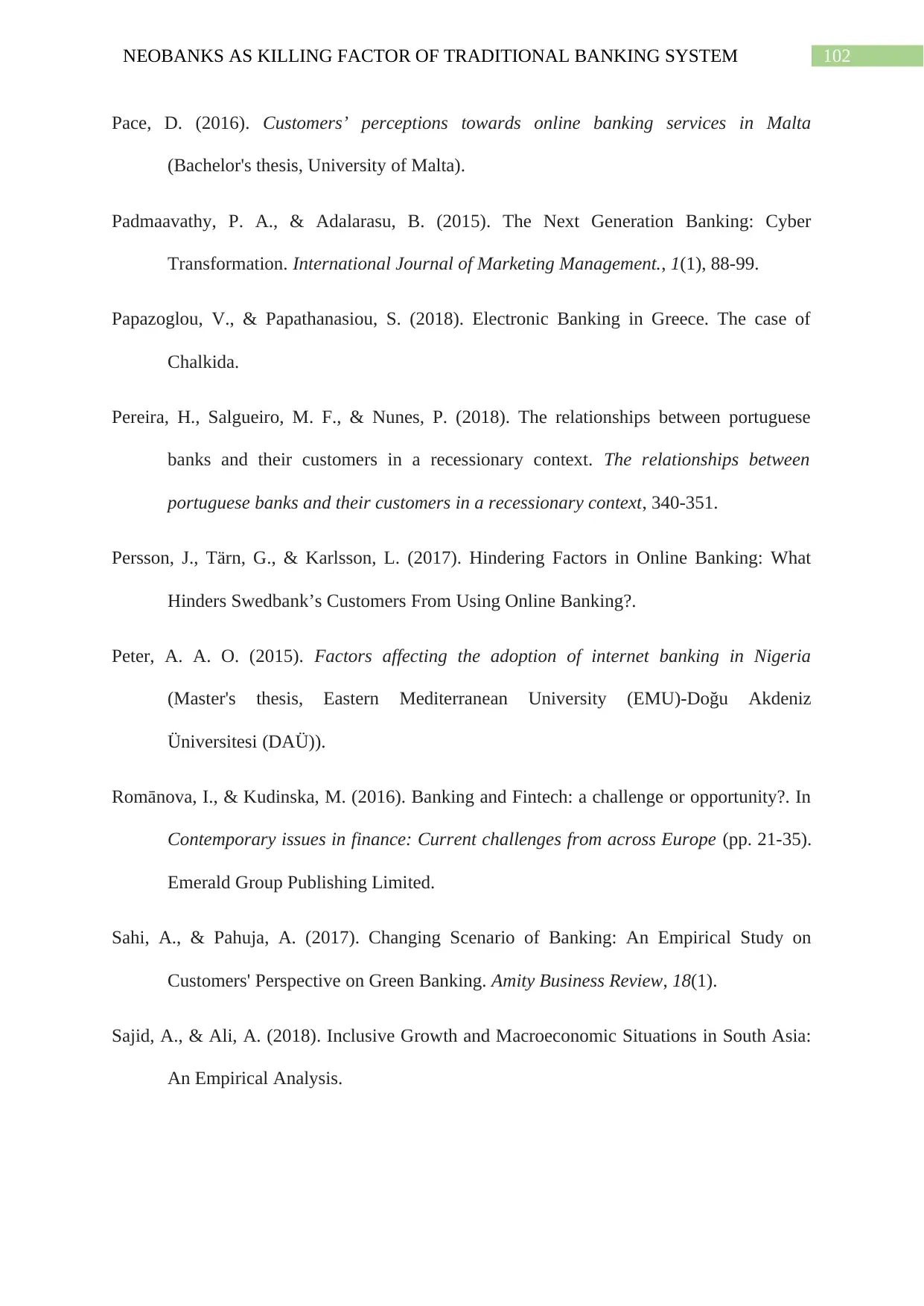
102NEOBANKS AS KILLING FACTOR OF TRADITIONAL BANKING SYSTEM
Pace, D. (2016). Customers’ perceptions towards online banking services in Malta
(Bachelor's thesis, University of Malta).
Padmaavathy, P. A., & Adalarasu, B. (2015). The Next Generation Banking: Cyber
Transformation. International Journal of Marketing Management., 1(1), 88-99.
Papazoglou, V., & Papathanasiou, S. (2018). Electronic Banking in Greece. The case of
Chalkida.
Pereira, H., Salgueiro, M. F., & Nunes, P. (2018). The relationships between portuguese
banks and their customers in a recessionary context. The relationships between
portuguese banks and their customers in a recessionary context, 340-351.
Persson, J., Tärn, G., & Karlsson, L. (2017). Hindering Factors in Online Banking: What
Hinders Swedbank’s Customers From Using Online Banking?.
Peter, A. A. O. (2015). Factors affecting the adoption of internet banking in Nigeria
(Master's thesis, Eastern Mediterranean University (EMU)-Doğu Akdeniz
Üniversitesi (DAÜ)).
Romānova, I., & Kudinska, M. (2016). Banking and Fintech: a challenge or opportunity?. In
Contemporary issues in finance: Current challenges from across Europe (pp. 21-35).
Emerald Group Publishing Limited.
Sahi, A., & Pahuja, A. (2017). Changing Scenario of Banking: An Empirical Study on
Customers' Perspective on Green Banking. Amity Business Review, 18(1).
Sajid, A., & Ali, A. (2018). Inclusive Growth and Macroeconomic Situations in South Asia:
An Empirical Analysis.
Pace, D. (2016). Customers’ perceptions towards online banking services in Malta
(Bachelor's thesis, University of Malta).
Padmaavathy, P. A., & Adalarasu, B. (2015). The Next Generation Banking: Cyber
Transformation. International Journal of Marketing Management., 1(1), 88-99.
Papazoglou, V., & Papathanasiou, S. (2018). Electronic Banking in Greece. The case of
Chalkida.
Pereira, H., Salgueiro, M. F., & Nunes, P. (2018). The relationships between portuguese
banks and their customers in a recessionary context. The relationships between
portuguese banks and their customers in a recessionary context, 340-351.
Persson, J., Tärn, G., & Karlsson, L. (2017). Hindering Factors in Online Banking: What
Hinders Swedbank’s Customers From Using Online Banking?.
Peter, A. A. O. (2015). Factors affecting the adoption of internet banking in Nigeria
(Master's thesis, Eastern Mediterranean University (EMU)-Doğu Akdeniz
Üniversitesi (DAÜ)).
Romānova, I., & Kudinska, M. (2016). Banking and Fintech: a challenge or opportunity?. In
Contemporary issues in finance: Current challenges from across Europe (pp. 21-35).
Emerald Group Publishing Limited.
Sahi, A., & Pahuja, A. (2017). Changing Scenario of Banking: An Empirical Study on
Customers' Perspective on Green Banking. Amity Business Review, 18(1).
Sajid, A., & Ali, A. (2018). Inclusive Growth and Macroeconomic Situations in South Asia:
An Empirical Analysis.
Paraphrase This Document
Need a fresh take? Get an instant paraphrase of this document with our AI Paraphraser
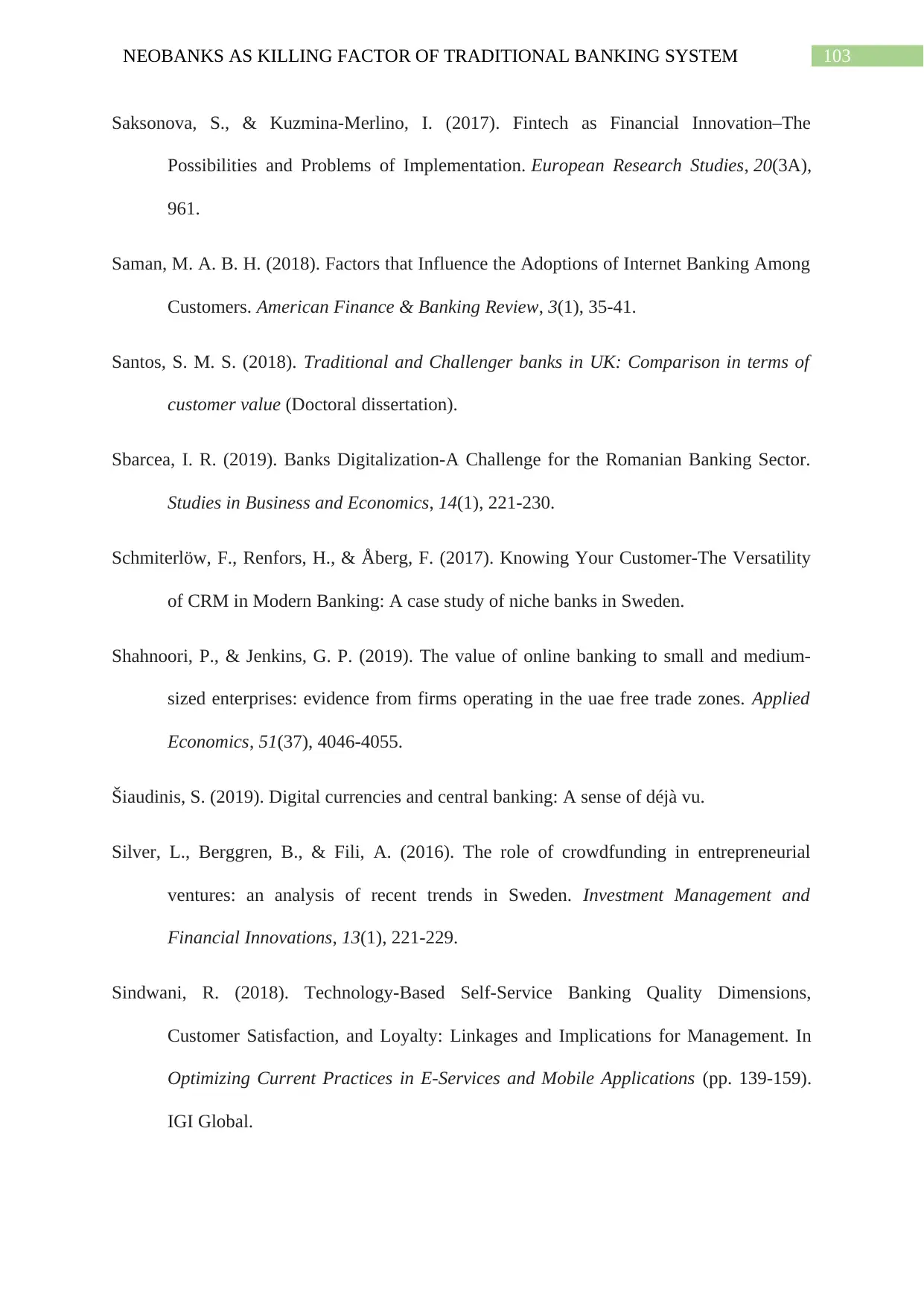
103NEOBANKS AS KILLING FACTOR OF TRADITIONAL BANKING SYSTEM
Saksonova, S., & Kuzmina-Merlino, I. (2017). Fintech as Financial Innovation–The
Possibilities and Problems of Implementation. European Research Studies, 20(3A),
961.
Saman, M. A. B. H. (2018). Factors that Influence the Adoptions of Internet Banking Among
Customers. American Finance & Banking Review, 3(1), 35-41.
Santos, S. M. S. (2018). Traditional and Challenger banks in UK: Comparison in terms of
customer value (Doctoral dissertation).
Sbarcea, I. R. (2019). Banks Digitalization-A Challenge for the Romanian Banking Sector.
Studies in Business and Economics, 14(1), 221-230.
Schmiterlöw, F., Renfors, H., & Åberg, F. (2017). Knowing Your Customer-The Versatility
of CRM in Modern Banking: A case study of niche banks in Sweden.
Shahnoori, P., & Jenkins, G. P. (2019). The value of online banking to small and medium-
sized enterprises: evidence from firms operating in the uae free trade zones. Applied
Economics, 51(37), 4046-4055.
Šiaudinis, S. (2019). Digital currencies and central banking: A sense of déjà vu.
Silver, L., Berggren, B., & Fili, A. (2016). The role of crowdfunding in entrepreneurial
ventures: an analysis of recent trends in Sweden. Investment Management and
Financial Innovations, 13(1), 221-229.
Sindwani, R. (2018). Technology-Based Self-Service Banking Quality Dimensions,
Customer Satisfaction, and Loyalty: Linkages and Implications for Management. In
Optimizing Current Practices in E-Services and Mobile Applications (pp. 139-159).
IGI Global.
Saksonova, S., & Kuzmina-Merlino, I. (2017). Fintech as Financial Innovation–The
Possibilities and Problems of Implementation. European Research Studies, 20(3A),
961.
Saman, M. A. B. H. (2018). Factors that Influence the Adoptions of Internet Banking Among
Customers. American Finance & Banking Review, 3(1), 35-41.
Santos, S. M. S. (2018). Traditional and Challenger banks in UK: Comparison in terms of
customer value (Doctoral dissertation).
Sbarcea, I. R. (2019). Banks Digitalization-A Challenge for the Romanian Banking Sector.
Studies in Business and Economics, 14(1), 221-230.
Schmiterlöw, F., Renfors, H., & Åberg, F. (2017). Knowing Your Customer-The Versatility
of CRM in Modern Banking: A case study of niche banks in Sweden.
Shahnoori, P., & Jenkins, G. P. (2019). The value of online banking to small and medium-
sized enterprises: evidence from firms operating in the uae free trade zones. Applied
Economics, 51(37), 4046-4055.
Šiaudinis, S. (2019). Digital currencies and central banking: A sense of déjà vu.
Silver, L., Berggren, B., & Fili, A. (2016). The role of crowdfunding in entrepreneurial
ventures: an analysis of recent trends in Sweden. Investment Management and
Financial Innovations, 13(1), 221-229.
Sindwani, R. (2018). Technology-Based Self-Service Banking Quality Dimensions,
Customer Satisfaction, and Loyalty: Linkages and Implications for Management. In
Optimizing Current Practices in E-Services and Mobile Applications (pp. 139-159).
IGI Global.
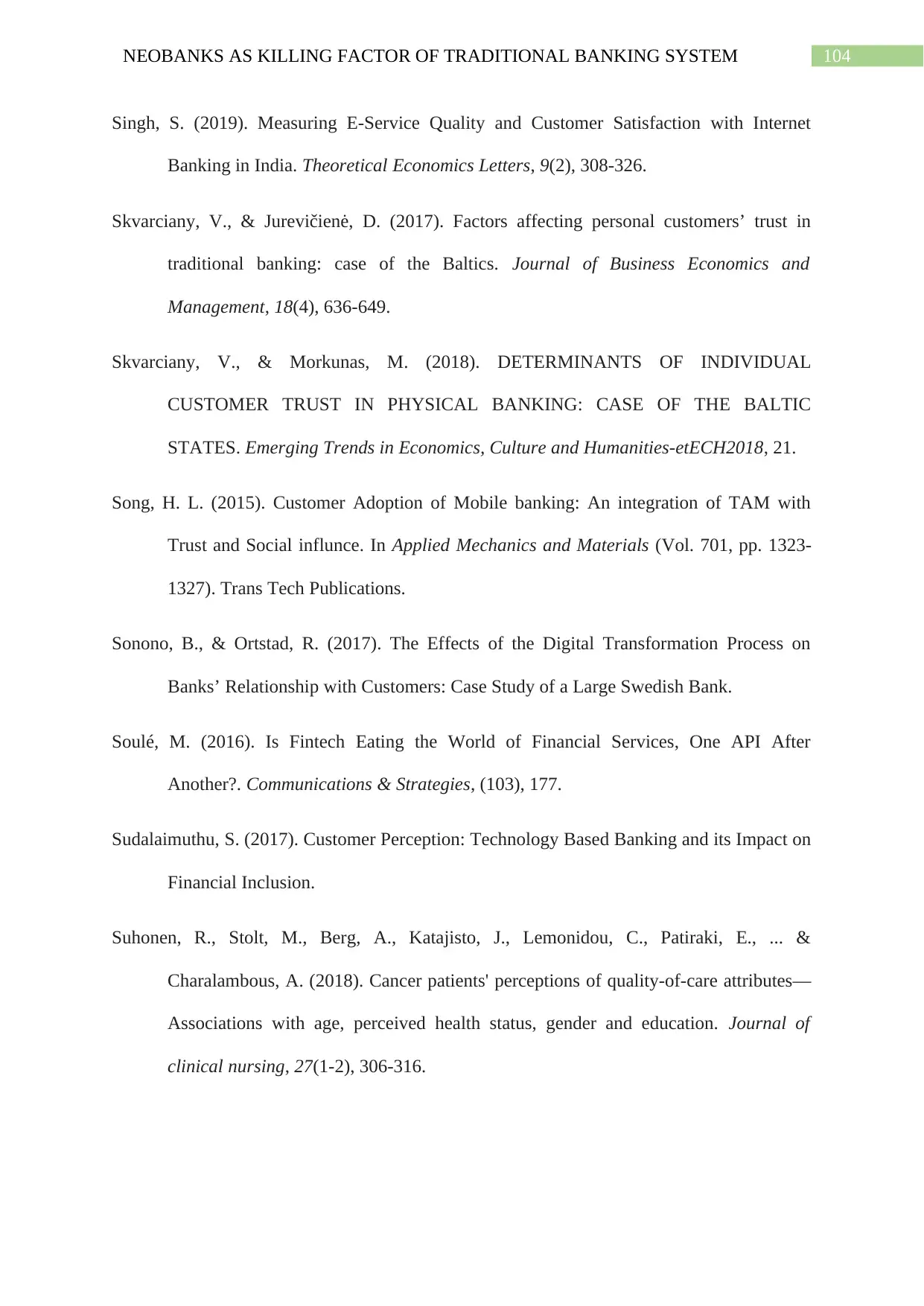
104NEOBANKS AS KILLING FACTOR OF TRADITIONAL BANKING SYSTEM
Singh, S. (2019). Measuring E-Service Quality and Customer Satisfaction with Internet
Banking in India. Theoretical Economics Letters, 9(2), 308-326.
Skvarciany, V., & Jurevičienė, D. (2017). Factors affecting personal customers’ trust in
traditional banking: case of the Baltics. Journal of Business Economics and
Management, 18(4), 636-649.
Skvarciany, V., & Morkunas, M. (2018). DETERMINANTS OF INDIVIDUAL
CUSTOMER TRUST IN PHYSICAL BANKING: CASE OF THE BALTIC
STATES. Emerging Trends in Economics, Culture and Humanities-etECH2018, 21.
Song, H. L. (2015). Customer Adoption of Mobile banking: An integration of TAM with
Trust and Social influnce. In Applied Mechanics and Materials (Vol. 701, pp. 1323-
1327). Trans Tech Publications.
Sonono, B., & Ortstad, R. (2017). The Effects of the Digital Transformation Process on
Banks’ Relationship with Customers: Case Study of a Large Swedish Bank.
Soulé, M. (2016). Is Fintech Eating the World of Financial Services, One API After
Another?. Communications & Strategies, (103), 177.
Sudalaimuthu, S. (2017). Customer Perception: Technology Based Banking and its Impact on
Financial Inclusion.
Suhonen, R., Stolt, M., Berg, A., Katajisto, J., Lemonidou, C., Patiraki, E., ... &
Charalambous, A. (2018). Cancer patients' perceptions of quality‐of‐care attributes—
Associations with age, perceived health status, gender and education. Journal of
clinical nursing, 27(1-2), 306-316.
Singh, S. (2019). Measuring E-Service Quality and Customer Satisfaction with Internet
Banking in India. Theoretical Economics Letters, 9(2), 308-326.
Skvarciany, V., & Jurevičienė, D. (2017). Factors affecting personal customers’ trust in
traditional banking: case of the Baltics. Journal of Business Economics and
Management, 18(4), 636-649.
Skvarciany, V., & Morkunas, M. (2018). DETERMINANTS OF INDIVIDUAL
CUSTOMER TRUST IN PHYSICAL BANKING: CASE OF THE BALTIC
STATES. Emerging Trends in Economics, Culture and Humanities-etECH2018, 21.
Song, H. L. (2015). Customer Adoption of Mobile banking: An integration of TAM with
Trust and Social influnce. In Applied Mechanics and Materials (Vol. 701, pp. 1323-
1327). Trans Tech Publications.
Sonono, B., & Ortstad, R. (2017). The Effects of the Digital Transformation Process on
Banks’ Relationship with Customers: Case Study of a Large Swedish Bank.
Soulé, M. (2016). Is Fintech Eating the World of Financial Services, One API After
Another?. Communications & Strategies, (103), 177.
Sudalaimuthu, S. (2017). Customer Perception: Technology Based Banking and its Impact on
Financial Inclusion.
Suhonen, R., Stolt, M., Berg, A., Katajisto, J., Lemonidou, C., Patiraki, E., ... &
Charalambous, A. (2018). Cancer patients' perceptions of quality‐of‐care attributes—
Associations with age, perceived health status, gender and education. Journal of
clinical nursing, 27(1-2), 306-316.
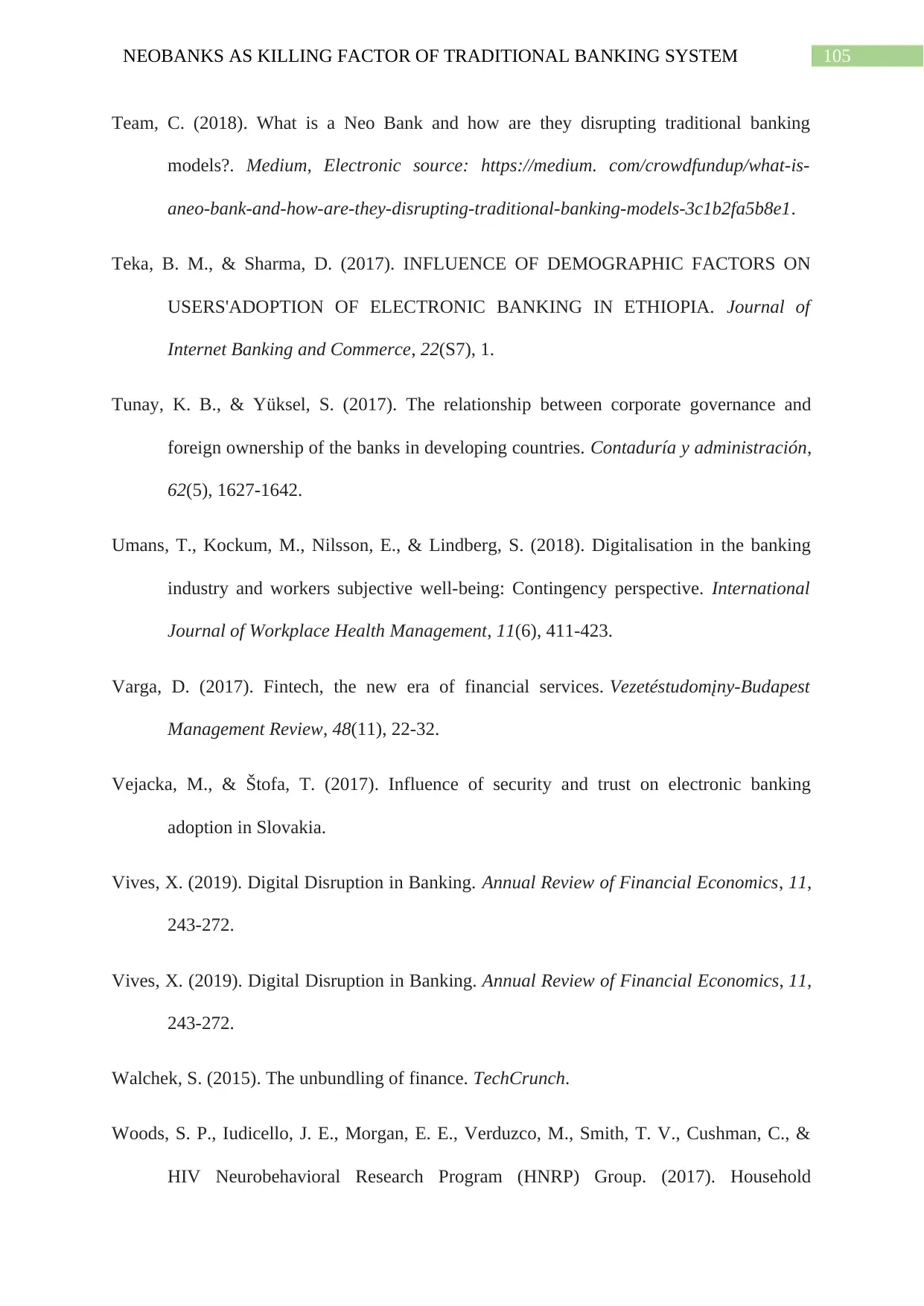
105NEOBANKS AS KILLING FACTOR OF TRADITIONAL BANKING SYSTEM
Team, C. (2018). What is a Neo Bank and how are they disrupting traditional banking
models?. Medium, Electronic source: https://medium. com/crowdfundup/what-is-
aneo-bank-and-how-are-they-disrupting-traditional-banking-models-3c1b2fa5b8e1.
Teka, B. M., & Sharma, D. (2017). INFLUENCE OF DEMOGRAPHIC FACTORS ON
USERS'ADOPTION OF ELECTRONIC BANKING IN ETHIOPIA. Journal of
Internet Banking and Commerce, 22(S7), 1.
Tunay, K. B., & Yüksel, S. (2017). The relationship between corporate governance and
foreign ownership of the banks in developing countries. Contaduría y administración,
62(5), 1627-1642.
Umans, T., Kockum, M., Nilsson, E., & Lindberg, S. (2018). Digitalisation in the banking
industry and workers subjective well-being: Contingency perspective. International
Journal of Workplace Health Management, 11(6), 411-423.
Varga, D. (2017). Fintech, the new era of financial services. Vezetéstudomįny-Budapest
Management Review, 48(11), 22-32.
Vejacka, M., & Štofa, T. (2017). Influence of security and trust on electronic banking
adoption in Slovakia.
Vives, X. (2019). Digital Disruption in Banking. Annual Review of Financial Economics, 11,
243-272.
Vives, X. (2019). Digital Disruption in Banking. Annual Review of Financial Economics, 11,
243-272.
Walchek, S. (2015). The unbundling of finance. TechCrunch.
Woods, S. P., Iudicello, J. E., Morgan, E. E., Verduzco, M., Smith, T. V., Cushman, C., &
HIV Neurobehavioral Research Program (HNRP) Group. (2017). Household
Team, C. (2018). What is a Neo Bank and how are they disrupting traditional banking
models?. Medium, Electronic source: https://medium. com/crowdfundup/what-is-
aneo-bank-and-how-are-they-disrupting-traditional-banking-models-3c1b2fa5b8e1.
Teka, B. M., & Sharma, D. (2017). INFLUENCE OF DEMOGRAPHIC FACTORS ON
USERS'ADOPTION OF ELECTRONIC BANKING IN ETHIOPIA. Journal of
Internet Banking and Commerce, 22(S7), 1.
Tunay, K. B., & Yüksel, S. (2017). The relationship between corporate governance and
foreign ownership of the banks in developing countries. Contaduría y administración,
62(5), 1627-1642.
Umans, T., Kockum, M., Nilsson, E., & Lindberg, S. (2018). Digitalisation in the banking
industry and workers subjective well-being: Contingency perspective. International
Journal of Workplace Health Management, 11(6), 411-423.
Varga, D. (2017). Fintech, the new era of financial services. Vezetéstudomįny-Budapest
Management Review, 48(11), 22-32.
Vejacka, M., & Štofa, T. (2017). Influence of security and trust on electronic banking
adoption in Slovakia.
Vives, X. (2019). Digital Disruption in Banking. Annual Review of Financial Economics, 11,
243-272.
Vives, X. (2019). Digital Disruption in Banking. Annual Review of Financial Economics, 11,
243-272.
Walchek, S. (2015). The unbundling of finance. TechCrunch.
Woods, S. P., Iudicello, J. E., Morgan, E. E., Verduzco, M., Smith, T. V., Cushman, C., &
HIV Neurobehavioral Research Program (HNRP) Group. (2017). Household
Secure Best Marks with AI Grader
Need help grading? Try our AI Grader for instant feedback on your assignments.
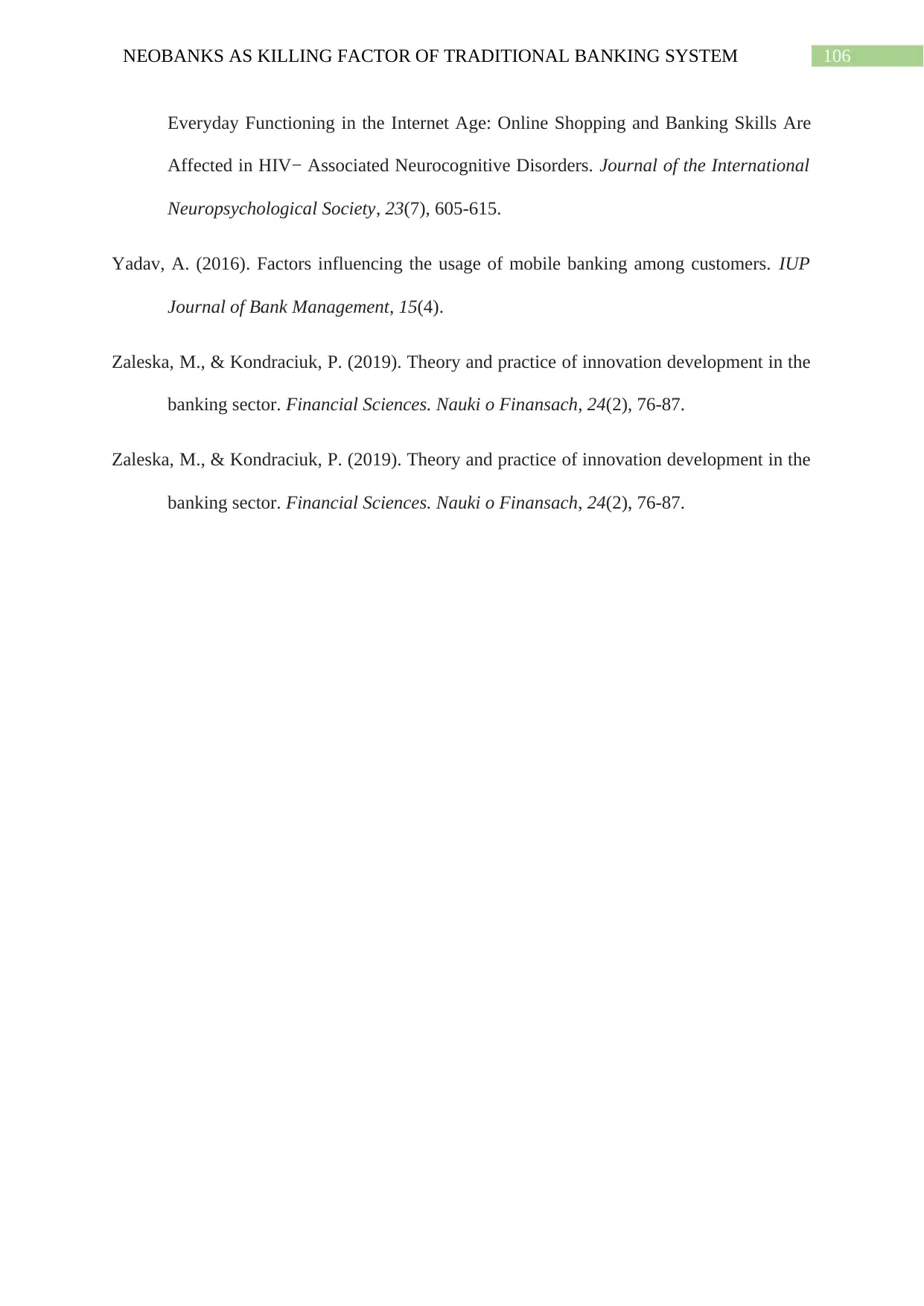
106NEOBANKS AS KILLING FACTOR OF TRADITIONAL BANKING SYSTEM
Everyday Functioning in the Internet Age: Online Shopping and Banking Skills Are
Affected in HIV− Associated Neurocognitive Disorders. Journal of the International
Neuropsychological Society, 23(7), 605-615.
Yadav, A. (2016). Factors influencing the usage of mobile banking among customers. IUP
Journal of Bank Management, 15(4).
Zaleska, M., & Kondraciuk, P. (2019). Theory and practice of innovation development in the
banking sector. Financial Sciences. Nauki o Finansach, 24(2), 76-87.
Zaleska, M., & Kondraciuk, P. (2019). Theory and practice of innovation development in the
banking sector. Financial Sciences. Nauki o Finansach, 24(2), 76-87.
Everyday Functioning in the Internet Age: Online Shopping and Banking Skills Are
Affected in HIV− Associated Neurocognitive Disorders. Journal of the International
Neuropsychological Society, 23(7), 605-615.
Yadav, A. (2016). Factors influencing the usage of mobile banking among customers. IUP
Journal of Bank Management, 15(4).
Zaleska, M., & Kondraciuk, P. (2019). Theory and practice of innovation development in the
banking sector. Financial Sciences. Nauki o Finansach, 24(2), 76-87.
Zaleska, M., & Kondraciuk, P. (2019). Theory and practice of innovation development in the
banking sector. Financial Sciences. Nauki o Finansach, 24(2), 76-87.
1 out of 107
Related Documents
Your All-in-One AI-Powered Toolkit for Academic Success.
+13062052269
info@desklib.com
Available 24*7 on WhatsApp / Email
![[object Object]](/_next/static/media/star-bottom.7253800d.svg)
Unlock your academic potential
© 2024 | Zucol Services PVT LTD | All rights reserved.





